Brooks Automation LF80BC1 LF80 Low Frequency RFID reader User Manual ZenID HSMS
Brooks Automation Inc. LF80 Low Frequency RFID reader ZenID HSMS
User manual
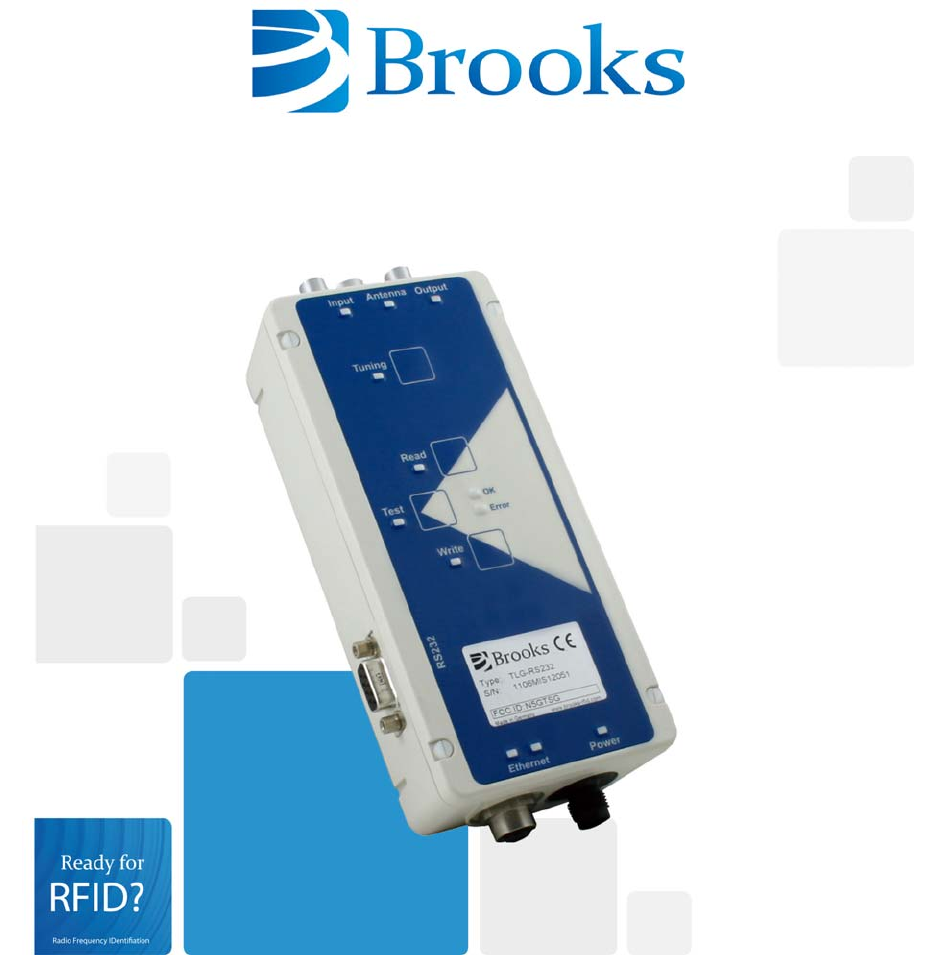
LF80C ZeniD RFID Reader
Product Manual
278580 Revision A

Brooks Automation
ii 278580 Revision A
LF80C ZeniD RFID Reader
Product Manual
This page intentionally left blank

Brooks Automation
278580 Revision A iii
LF80C ZeniD RFID Reader
Product Manual
Brooks Automation
Information provided within this document is subject to change without notice, and although believed to be
accurate, Brooks Automation assumes no responsibility for any errors, omissions, or inaccuracies.
ABF™, AcuLigner™, Advan Tag™, Align™, AquaTran™, AutoTeach™, ATR™, AXM™, Basic Blue™,
BioStore™, BiSymmetrik™, CenterSmart™, Cool Solutions™, Crate to Operate™, CrossingConnect™,
DARTS™, Enerta™, e-RMA™, e-Spares™, e-Volution™, Falcon™, FastRegen™, FIXLOAD™,
FrogLeg™, InLigner™, InCooler™, Interface™, Isoport™, Jet™, Jet Engine™, LowProfile™, M2 Nano™,
Mini-Ion™, PASIV™, PerformanceBlue™, Plate Auditor™, PowerPak™, PowerTools™, QuadraFly™,
Radius™, Radient™, Radient Express™, RapidThaw™, Reliance™, Reliance ATR™, RetroEase™,
SCARA™, SmartPM™, SPOTLevel™, Sprint™, Synetics™, The New Pathway to Productivity™, Time
Optimized Trajectory™, Time Optimal Trajectory™, Time Optimized Path™, TopCooler™, TopLigner™,
Tube Auditor™, Ultimate Blue™, VAC-407™, VacuTran™, VersaPort™, WaferEngine™ and the Brooks
logo are trademarks of Brooks Automation, Inc.
AcuTran®, AquaTrap®, Asyst®, Celigo®, Conductron®, Convectron®, the Cool Solutions logo, Crossing
Automation®, Cryodyne®, Cryotiger®, Cryo-Torr®, Fusion®, GOLDLink®, Guardian®, GUTS®, Helix®,
Leapfrog®,MagnaTran®, MapTrak®, Marathon®, Marathon 2®, Marathon Express®, Micro-Ion®,
MiniConvectron®, On-Board®, Polycold®, Razor®, REMP®, Spartan™, TrueBlue®, TurboPlus®, Vision®,
Xpeel®, XTape®, Zaris®, and the Brooks Automation logo are registered U.S. trademarks of Brooks
Automation, Inc.
All other trademarks are properties of their respective owners.
© 2017 Brooks Automation, Inc. All Rights Reserved. The information included in this manual is
Proprietary Information of Brooks Automation and is provided for the use of Brooks Automation customers
only and cannot be used for distribution, reproduction, or sale without the express written permission of
Brooks Automation. This information may be incorporated into the user’s documentation, however any
changes made by the user to this information is the responsibility of the user.

Brooks Automation
iv 278580 Revision A
LF80C ZeniD RFID Reader
Product Manual
For Technical Support:
Location GUTS® Contact Number Website
North America +1-800-FOR-GUTS (1-800-367-4887) http://www.brooks.com/
+1-978-262-2900
Europe +49-1804-CALL-GUTS (+49-1804-2255-4887) http://www.brooks.com/
Japan +81-45-477-5980 http://jp.brooks.com/
China +86-21-5131-7066 http://cn.brooks.com/
Taiwan +886-3-5525225 http://tw.brooks.com/
Korea +82-31-288-2500 http://kr.brooks.com/
Singapore +65-6464-1481 http://www.brooks.com/
Contact Technical Publications directly: Technical.Publications@brooks.com
This technology is subject to United States export Administration Regulations and authorized to the
destination only; diversion contrary to U.S. law is prohibited.
Original manual printed in English. Printed in the U.S.A.
Accelerating Innovation
Corporate Headquarters
15 Elizabeth Drive
Chelmsford, MA 01824 U.S.A.

Brooks Automation
278580 Revision A v
LF80C ZeniD RFID Reader
Product Manual
Brooks Automation, Inc.
15 Elizabeth Drive
Chelmsford, MA
01824-2400
Tel: +1 978-262-2400
Fax: +1 978-262-2500
www.brooks.com
Brooks Locations Worldwide:
Brooks Automation Inc.
46702 Bayside Parkway
Fremont,CA 94538
Tel: +1-510-661-5000
Fax: +1-510-661-5166
Brooks Life Science Systems
Northbank, Irlam
United Kingdom
Tel: +44 (0) 161 777 2000
Fax: +44 (0) 161 777 2002
Brooks Life Science Systems
1003 E Trent Street. Suite 110
Spokane, WA 99202
Tel: +1 234-567-8910
Fax: +1 234-567-8910
Brooks Automation, Inc.
Polycold Systems
3800 Lakeville Highway
Petaluma, CA 94954
Tel: +1 707-769-7000
Fax: +1 707-769-1380
Brooks Automation, Inc.
MicroTool Products
824 South Tejon Street
Colorado Springs, CO 80903
Tel: +1 719-471-9888
Fax: +1 719-471-9977
Brooks Automation, Inc.
9601 Dessau Road, Suite 301
Austin, TX 78754
Tel: +1 512-912-2800
Fax: +1 512-912-2888
Brooks Automation Korea, Inc.
400-2 Gomae-Dong,
Giheung-Gu, Yongin-City
Gyeonggi-Do, 446-901
Korea
Tel : +82-31-288-2500
Fax: +82-31-287-2111
Brooks Automation France
SAS Les Jardins de Maupertuis
7 Chemin de la Dhuy
Batiment Le Juparana
Meylan, France 38240
Tel: +33 (0)4.76.18.92.00
Fax: +33 (0)4.76.18.91.98
Brooks Japan K.K.
HEADQUARTERS
Nisso Bldg. No 16, 10F
3-8-8 ShinYokohama, Kohoku-ku
Yokohama, Kanagawa 222-0033
Tel: +81-45-477-5570
Fax: +81-45-477-5571
Brooks Automation, Inc.
AIM Servicios Administrativos S de RL de
CV
Carretera Huinalá km 2.8
Parque Industrial Las Américas
66640 Apodaca, NL Mexico
Tel: +52 81 8863-6363
Brooks Automation Ltd.
TAIWAN HEADQUARTERS
5F-5, No.32, Tai-Yuen Street
Chu-Pei City
Hsinchu County 302, Taiwan, R.O.C.
Tel: +886-3-552 5258
Fax (G&A): +886-3-552 5255
Fax (Sales): +886-3-552 5200
Brooks Automation (Germany) GmbH
Ernst-Ruska-Ring 11
07745 Jena, Germany
Tel: +49 3641 4821 100
Fax: +49 3641 4821 4100
Brooks Automation (Israel) Ltd.
Mevo Yerach 5
Kiryat-Gat 82000
Israel
Tel: +972 8672 2988
Fax: +972 8672 2966
Brooks Automation (Germany)
GmbH
Karl-Marx-Strasse 23
D-01109 Dresden, Germany
Tel: +49 351 885 930
Fax: +49 351 885 9322
Brooks Technology (Shanghai) Lim-
ited
2nd Floor, No. 72, 887 Zuchongzhi
Road
Zhangjiang Hi-Tech Park
Pudong, Shanghai
China 201203
Tel: +86-21-5131-7070
Fax: +86-21-5131-7068
Brooks Life Science Systems
Weststrasse 12
CH-3672 Oberdiessbach
Switzerland
Tel: +41 (0) 31 770 70 70
Fax: +41 (0) 31 770 72 66
Life Science Systems
Northbank, Irlam
Manchester M44 5AY
United Kingdom
Tel: +44 (0) 161 777 2000
Fax: +44 (0) 161 777 2002
Brooks Automation (Singapore) Pte
Ltd
1200 Depot Road
#07-01 to #07-06
Singapore 109675
Tel: +65-6836-3168
Fax: +65-6836-3177

Brooks Automation
vi 278580 Revision A
LF80C ZeniD RFID Reader
Product Manual
This page intentionally left blank
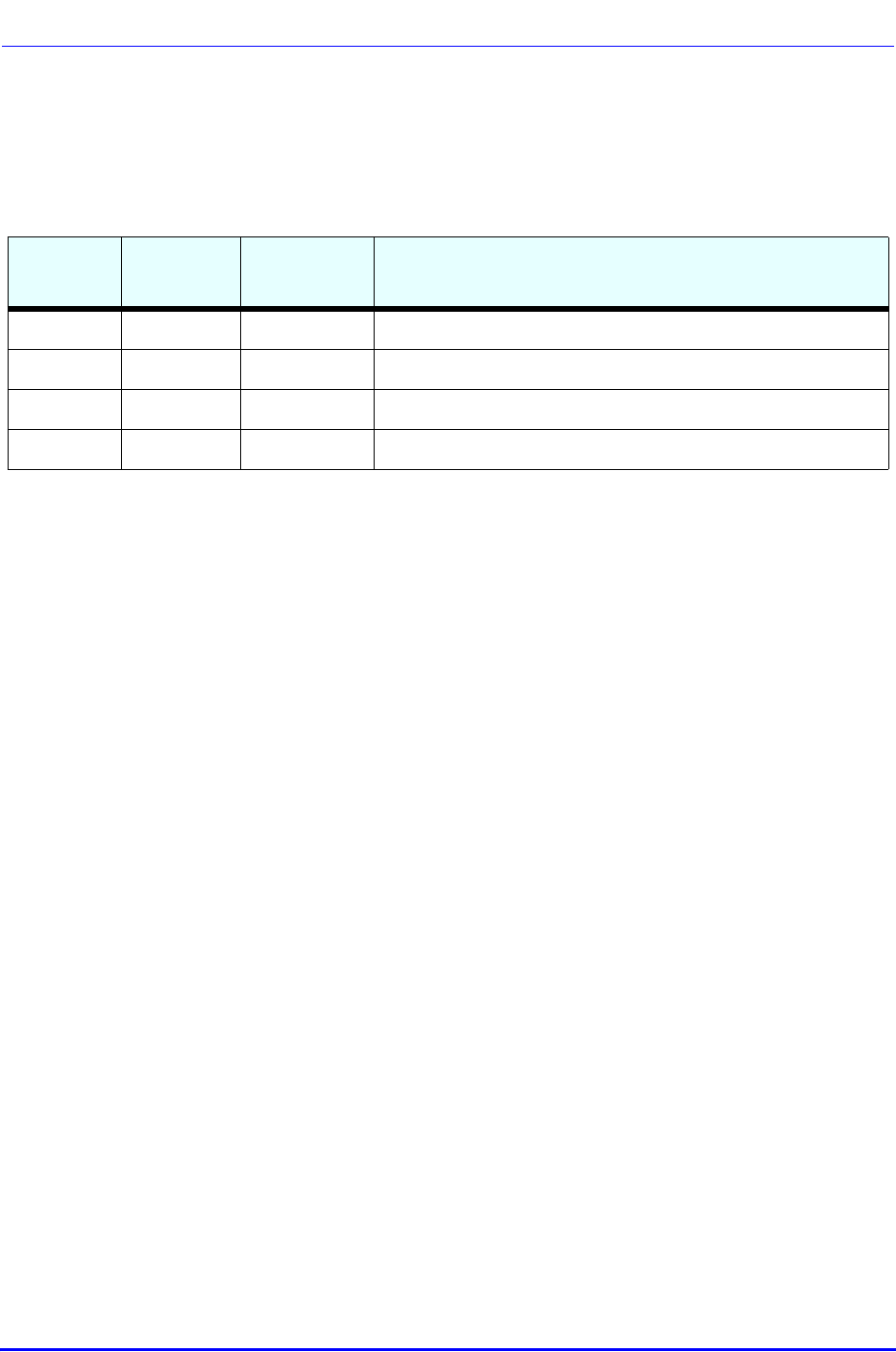
Brooks Automation
278580 Revision A vii
LF80C ZeniD RFID Reader
Product Manual
Revision History
Part Number. 278580
Product Name: LF80C ZeniD RFID Reader Product Manual
Revision ECO
Number Date Explanation of Changes
A 94411 3/24/2017 Initial Release

Brooks Automation
viii 278580 Revision A
LF80C ZeniD RFID Reader
Product Manual
This page intentionally left blank

Brooks Automation
278580 Revision A ix
LF80C ZeniD RFID Reader
Product Manual
Table of Contents
Revision History . . . . . . . . . . . . . . . . . vii
1 Identification . . . . . . . . . . . . . . . . . . . . 1
1.1 Model 1
1.2 Designated Use 2
1.3 Incorrect Use 2
2 Declaration of Conformity. . . . . . . . . . . 3
2.1 USA - Federal Communications
Commission (FCC) 3
2.2 Europe - CE Conformity 4
3 General Instructions . . . . . . . . . . . . . . 5
3.1 Liability and Warranty 5
3.2 Objectives of the Operating Instructions 5
3.2.1 Target Group 6
4 Safety Instructions. . . . . . . . . . . . . . . . 7
4.1 Archiving 7
4.2 Symbols and Signal Words 7
4.3 Area of Application and Symbols 8
4.3.1 Safety Symbols – in compliance with 4844-2 8
4.3.2 Warning Symbols 9
4.3.3 Prohibition Symbols 9
4.3.4 Other Symbols 9
4.4 Obligations 10
4.4.1 Operating Company’s Obligations 10
4.4.2 Operating Personnel’s Obligations 10
4.5 ESD Instructions 11
4.6 Residual Risks 11
4.7 Additional Information 12
5 Product Specifications . . . . . . . . . . . . 15
5.1 Function 15
5.2 Indicating and Operating Elements 16
5.3 Inside View 17
5.4 Description of the Components 18
5.5 Technical Data 20
5.5.1 Device Label 21
5.5.2 Power Supply and Current Input 21

Brooks Automation
x278580 Revision A
LF80C ZeniD RFID Reader
Product Manual
5.6 Antenna Cable 22
5.6.1 Cable for Rod Antenna and Frame Antenna 22
5.6.2 Cable for Mini Antenna and Micro Antenna 22
5.7 Contents of Delivery 23
6 Installation . . . . . . . . . . . . . . . . . . . . 25
6.1 Safety Instructions 25
6.2 Qualified Installation Personnel 27
6.3 Unpacking 27
6.4 Assembly of the Device 28
6.4.1 Standard Housing for Enclosed Assembly
Material (Recommended) 29
6.4.2 Housing Without Mounts 30
6.5 Antenna Installation 32
6.5.1 Positioning the Antenna 32
6.5.2 Available Antenna Types 33
6.5.3 Dimensions for Planning 34
6.6 Power Supply 36
6.7 Terminal Connection 36
6.8 Ethernet Connection 38
6.9 External Input and Output 39
6.10 Commissioning 40
6.10.1 Required Operating Conditions 40
6.10.2 Tuning 40
7 Operation . . . . . . . . . . . . . . . . . . . . . . 41
7.1 Operating Personnel 41
7.2 Operation of the ASC-I1 Protocol 41
7.2.1 Structure of the Communication Protocol 41
7.2.2 Package Contents 41
7.2.3 Commands of Protocol 44
7.2.4 Parameter 60
7.2.5 Message Examples 62
7.3 Operation of SECS Protocol 63
7.3.1 Introduction 63
7.3.2 SECS-I Implementation 64
7.3.3 HSMS Option 68
7.3.4 HSMS Implementation 68
7.3.5 SECS-II Implementation 74
7.3.6 Parameters 92
7.3.7 SEMI E99 104

Brooks Automation
278580 Revision A xi
LF80C ZeniD RFID Reader
Product Manual
7.3.8 Message Details 109
7.3.9 HSMS Message Examples 121
7.3.10 SECS-I Message Examples 122
8 Service and Troubleshooting . . . . . . 141
8.1 General 141
8.2 Qualified Troubleshooting Personnel 142
8.3 Safety Instructions 142
8.4 Error Codes 143
8.4.1 Error ID and Alarm ID 143
8.4.2 SSACK 145
8.4.3 Stream Function 146
8.5 Error Display with LED 147
8.5.1 Power LED Does Not Light Up 147
8.5.2 Error LED Lights Up (in Test Mode) 147
8.6 Reader Does Not Respond 148
8.7 Reset 148
8.8 Power Cut 148
8.9 Protocol Switching 149
8.10 Software Releases 149
8.11 Customer Service 149
9 Dismantling and Storage . . . . . . . . . 151
9.1 Dismantling 151
9.2 Storage 151
10 Transport and Disposal. . . . . . . . . . . 153
10.1 Transport 153
10.2 Disposal 153
11 Accessories . . . . . . . . . . . . . . . . . . . 155
11.1 Antennas 155
11.1.1 Available Types 155
11.1.2 Reading and Writing Ranges 156
11.2 Plugs 164
11.3 Cables 164
11.4 Mounting Brackets 165
Index . . . . . . . . . . . . . . . . . . . . . . . . . . I

Brooks Automation
xii 278580 Revision A
LF80C ZeniD RFID Reader
Product Manual
This page intentionally left blank

Brooks Automation
278580 Revision A 1
LF80C ZeniD RFID Reader 1 Identification
Product Manual 1.1 Model
1 Identification
This chapter gives you an overview of the following topics:
Î
Model
Î
Designated Use
Î
Incorrect Use
1.1 Model
LF80C ZeniD Serial number e.g. 1106MIS12051
Part number TLG-E2B-1O00-S0-00EB
Manufacturer Brooks Automation Inc.
46702 Bayside Parkway
Fremont, CA 94538
Tel: +1 510-661-5000
Fax: +1 510-661-5166
Website www.brooks.com
For information on the label, see
Î
Device Label.
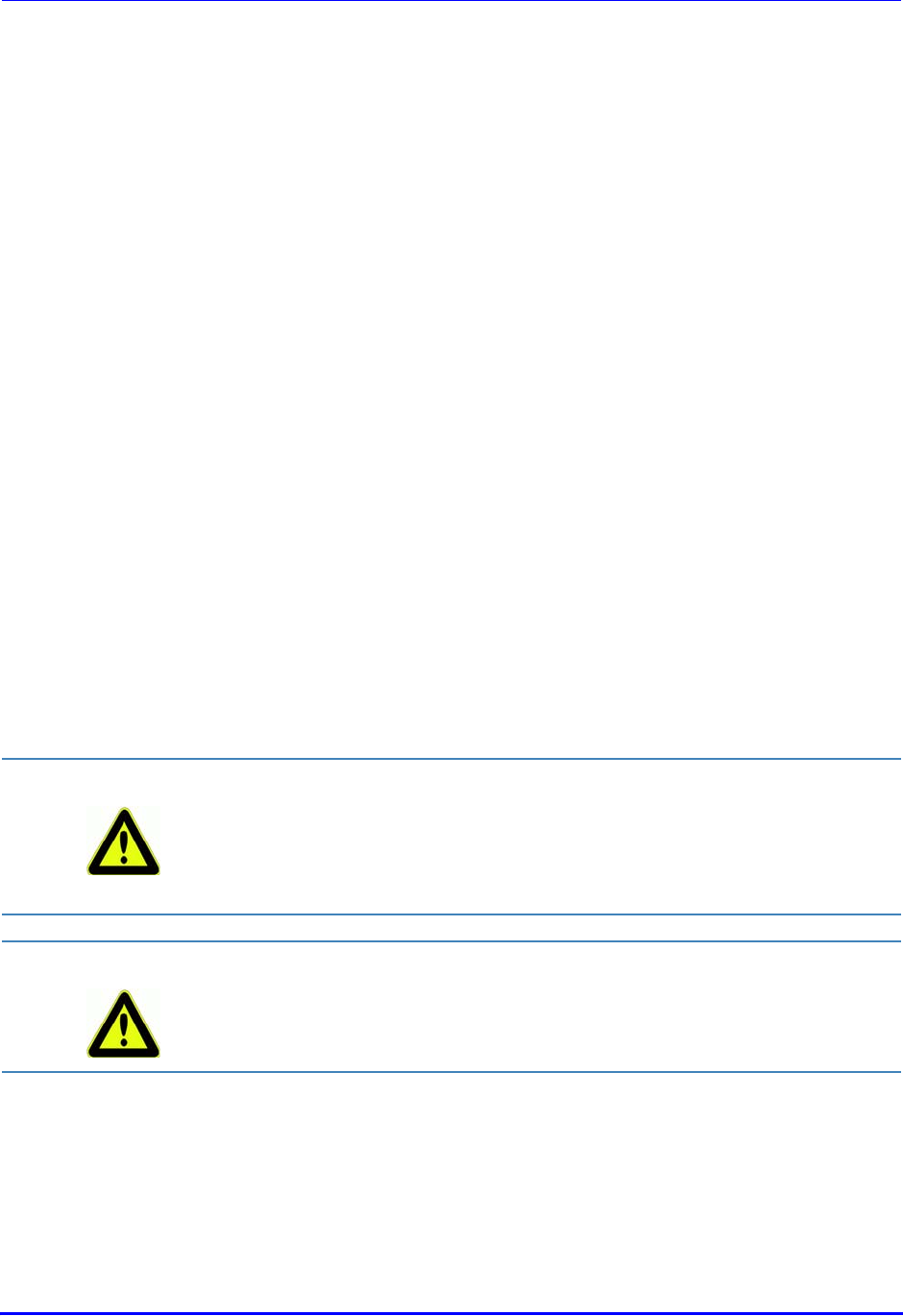
Brooks Automation
2278580 Revision A
1 Identification LF80C ZeniD RFID Reader
1.2 Designated Use Product Manual
1.2 Designated Use
This product was developed for reading and writing transponders only. Any
other use of this device constitutes misuse and renders the user's authority
to install and operate the device invalid.
This product is designed to be mounted and operated in an industrial
setting as a built-in-device only. It is not designed to be used as a stand-
alone or portable device or in a non-industrial setting, such as a household,
vehicle or in the open-air.
Intended use also includes the following:
following all instructions in the product manual
observing all safety information
Before using the device, the user should ensure that the national approval
requirements for use are met.
1.3 Incorrect Use
Incorrect use, which can endanger the device, the user and third parties,
includes:
the use of the device contrary to its intended use (
Î
Designated
Use)
modifying, extending or reconstructing the device without first
consulting Brooks Automation
operating the device when there are obvious problems
WARNING Risk of injury through incorrect modifications
There are risks from unauthorized modifications to the machine.
Only use original spare parts from the manufacturer. Do not make any
changes, attachments or modifications to the device without the
approval of Brooks Automation.
WARNING Risk of injury and malfunction of machine operation through
incorrect use
There are risks attached to using the device incorrectly.
Use the device exclusively according to its intended use.

Brooks Automation
278580 Revision A 3
LF80C ZeniD RFID Reader 2 Declaration of Conformity
Product Manual 2.1 USA - Federal Communications Commission (FCC)
2 Declaration of Conformity
This chapter gives you an overview of the following topics:
Î
USA - Federal Communications Commission (FCC)
Î
Europe - CE Conformity
2.1 USA - Federal Communications
Commission (FCC)
This device complies with Part 15 of the FCC Rules. Operation is subject to
the following two conditions:
This device may not cause harmful interference and followed, read
and understood by all persons working with the device (especially
the safety information)
This device must accept any interference received, including
interference that may cause undesired operation.
This equipment has been tested and found to comply with the limits for a
Class B digital device, in accordance with part 15 of the FCC Rules. These
limits are designed to provide reasonable protection against harmful
interference in a residential installation.
This equipment generates, uses, and can radiate radio frequency energy
and, if not installed and used in accordance with the instruction manual,
may cause harmful interference to radio communications. However, there is
no guarantee that interference will not occur in a particular installation. If
this equipment does cause harmful interference to radio or television
reception - this can be determined by turning the equipment off and on -
the user is encouraged to try to correct the interference using one or more
of the following measures:
Reposition or relocate the receiving antenna.
Increase the distance between the equipment and the receiver.
Connect the equipment to an outlet to a circuit other than the one
to which the receiver is connected.
Consult the dealer or an experienced radio/TV technician for
assistance.
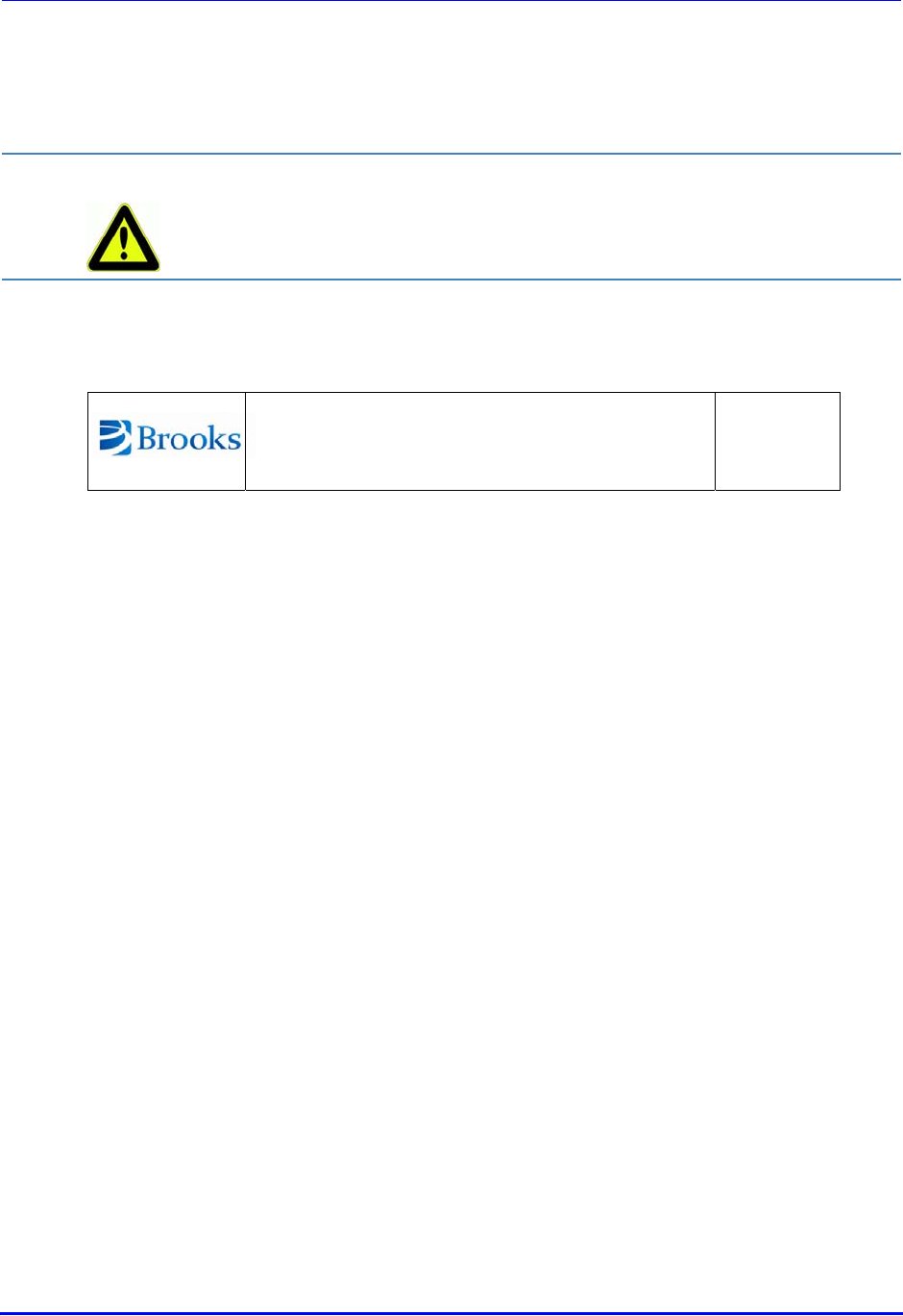
Brooks Automation
4278580 Revision A
2 Declaration of Conformity LF80C ZeniD RFID Reader
2.2 Europe - CE Conformity Product Manual
FCC ID N5GTSG
Compliance with:
FCC Code of Federal Regulations, Part 15 Subpart C, Section §15.205
FCC Code of Federal Regulations, Part 15 Subpart C, Section §15.209
2.2 Europe - CE Conformity
WARNING Changes or modifications not expressly approved by the party
responsible for compliance may void the user's authority to operate the
equipment.
Declaration of Conformity
For the European Union
Document #:
Rev.: A
Description ATR60LF CAN Reader
Function: RFID Reader
Part Number: TLS-33C-XXXX-XX-XXXX
Business name and full address of the manufacturer of the machinery:
Brooks Automation Inc., 15 Elizabeth Drive, Chelmsford, MA, USA 01824
Name and address of the person, established in the Community, authorized to compile the relevant technical documentation:
Brooks Automation (Germany) GmbH, Ernst-Ruska-Ring 11, 07745 Jena, Germany
The manufacturer declares:
x That this product fulfills all the relevant provisions of Directive 1999/5/EC (R&TTE
Directive) on Radio Equipment and Telecommunication Terminal Equipment.
x The product is in conformity with the following standards and/or other normative
documents:
o HEALTH & SAFETY (Article 3(1)(a)):
IEC 60905-1 : 2013/05/28
o EMC (Article 3(1)(b)):
EN 300 330-1 V1.7.1
EN 300 330-2 V1.5.1
o SPECTRUM (Article 3(2)):
EN 301 489-1 V1.9.2
EN 301 489-3 V1.6.1
EN 55032: 2012/AC: 2013
o OTHER:
Directive 2011/65/EU of the European Parliament and of the Council of 8
June 2011 on the restriction of the use of certain hazardous substances in
electrical and electronic equipment.
Signature
Date: 18-Oct-2016
Location: Fremont CA, USA
RFID Reader
LF80C ZeniD RFID Reader
TLG-E2B-1O00-S0-00EB
N5GLF80BC1

Brooks Automation
278580 Revision A 5
LF80C ZeniD RFID Reader 3 General Instructions
Product Manual 3.1 Liability and Warranty
3 General Instructions
This chapter gives you an overview of the following topics:
Î
Liability and Warranty
Î
Objectives of the Operating Instructions
3.1 Liability and Warranty
The "General sales and delivery conditions" of Brooks Automation always
apply.
The warranty period is 12 months beginning with the delivery of the device,
which is verified by the invoice or other documents.
The warranty includes repairs of all damages to the device that occur
during the warranty period and were clearly caused by material or
manufacturing defects.
Liability and warranty claims in cases of damage to persons or property are
excluded if they can be attributed to one or more of the following causes:
incorrect use of the device
disregard of the information in the product manual
unauthorized structural modifications of the device
insufficient maintenance and repairs
disasters due to foreign objects or force majeure
3.2 Objectives of the Operating
Instructions
These product manual serves as support and contain all the necessary
safety information that must be followed for general safety, transport,
installation and operation.
This product manual including all safety information (as well as all
additional documents) must be:
followed, read and understood by all persons working with the
device (especially the safety information)
easily available to all persons at all times
immediately consulted in case of doubt (safety)
Objectives:
to avoid accidents
to increase the service life and reliability of the device
to reduce costs due to production downtimes

Brooks Automation
6278580 Revision A
3 General Instructions LF80C ZeniD RFID Reader
3.2 Objectives of the Operating Instructions Product Manual
3.2.1 Target Group
This product manual is addressed to personnel with the following areas of
responsibility:
Definition according to DIN EN 60204-1:
Instructed Personnel
Persons who have been instructed and, if required, trained by a specialist
as to the tasks assigned to them, the possible risks of incorrect behavior
and the required safety equipment and safety measures.
Specialized Personnel
Persons who can evaluate the work assigned to them and recognize
possible risks based on their specialized training, knowledge, experience
and familiarity with the relevant standards.
Area of responsibility Competence
Installation Specialized personnel
Commissioning, operation and
decommissioning
Instructed personnel
Troubleshooting Specialized personnel
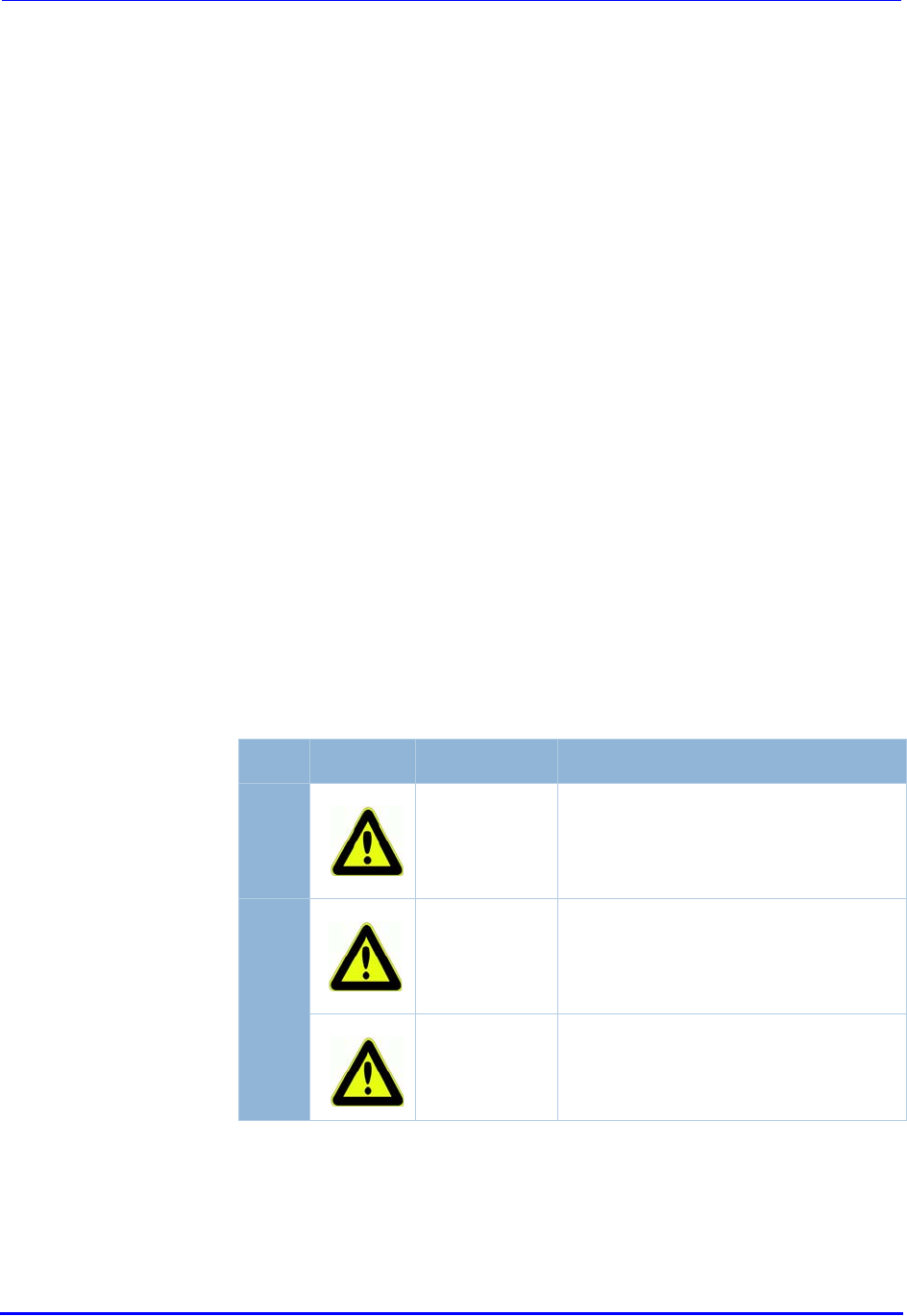
Brooks Automation
278580 Revision A 7
LF80C ZeniD RFID Reader 4 Safety Instructions
Product Manual 4.1 Archiving
4 Safety Instructions
This chapter gives you an overview of the following topics:
Î
Archiving
Î
Symbols and Signal Words
Î
Area of Application and Symbols
Î
Obligations
Î
ESD Instructions
Î
Residual Risks
Î
Additional Information
4.1 Archiving
Store the product manual in the vicinity of the device!
Always keep the product manual handy!
4.2 Symbols and Signal Words
The following symbols and signal words are used in this documentation.
The combination of a pictograph and a signal word classifies the respective
safety information. The symbol can vary depending on the type of danger.
Symbol Signal word Description
Death
DANGER This signal word must be used if
death or irreversible damage to
health can occur if the hazard
information is not followed.
Risk of injury and
property damage
WARNING This signal word indicates bodily
injuries and property damage
including injuries, accidents, and
health risks.
CAUTION This signal word indicates a risk of
property damage. In addition, there is
a slight risk of injuries.
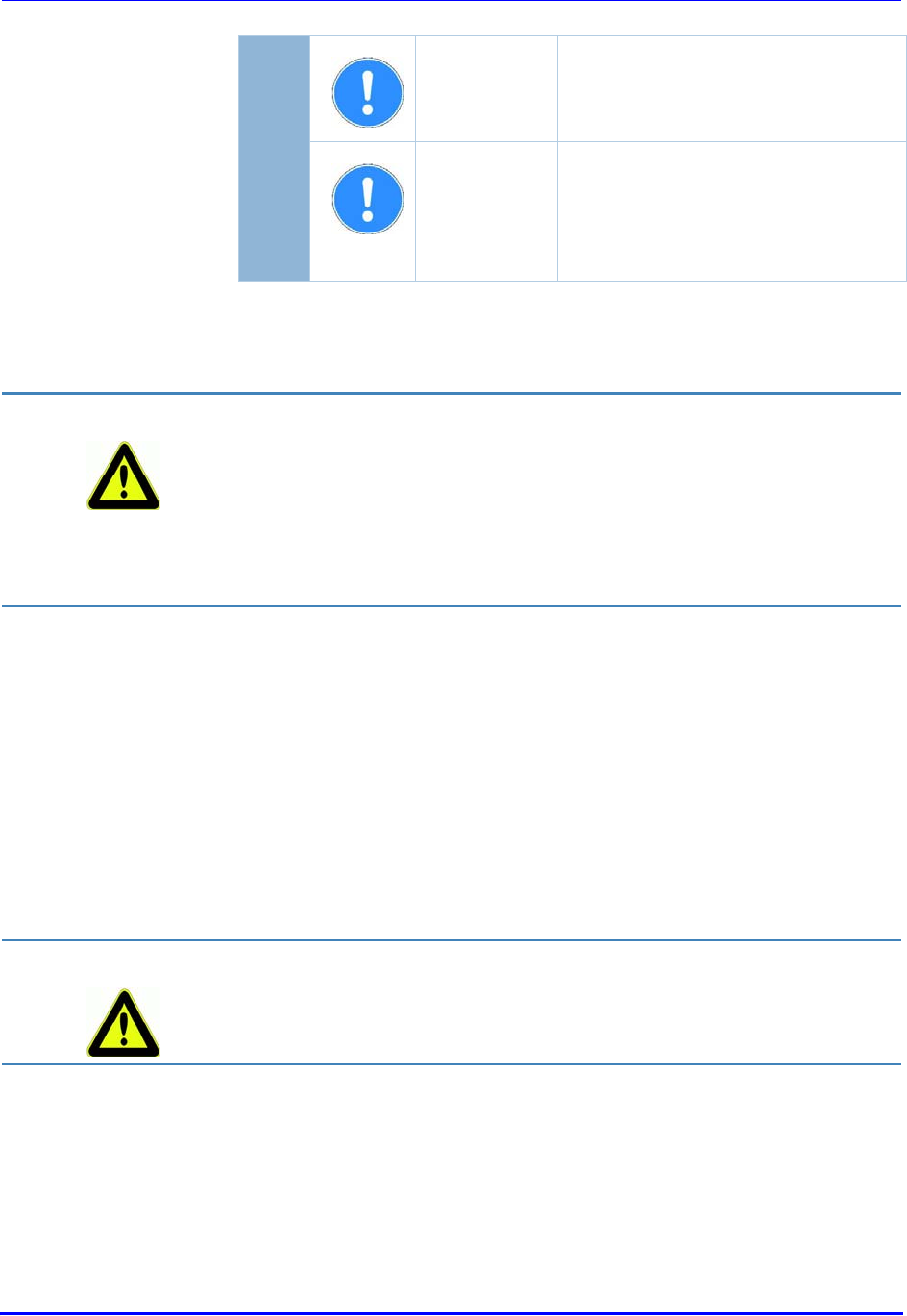
Brooks Automation
8278580 Revision A
4 Safety Instructions LF80C ZeniD RFID Reader
4.3 Area of Application and Symbols Product Manual
4.3 Area of Application and Symbols
The device was constructed according to state-of-the-art technology and
recognized safety regulations. In order to prevent any risks to life and limb
of the user, third parties or damage to the device, only use the device for its
intended purpose and in perfect condition with regard to safety.
Bodily injuries and/or property damage resulting from non-compliance with
the instructions given in the product manual are the responsibility of the
company operating the device or of the assigned personnel. Malfunctions
that could compromise safety must be eliminated immediately.
4.3.1 Safety Symbols – in compliance with 4844-2
Special safety symbols in accordance with DIN 4844-2 are used in the
corresponding passages in the text of this product manual and require
special attention depending on the combination of signal word and symbol.
No damage
ATTENTION This signal word warns of
malfunctions and may only be used if
no damage to health can occur.
IMPORTANT This signal word indicates cross-
references and ways in which
operations are facilitated. It excludes
all risks of property damage and
injury risks.
DANGER Danger to life, risk of injuries or damage to property
Risks exist when disregarding the product manual and the safety
instructions therein.
Carefully read the product manual before initial commissioning. Perform
the required safety measures before initial commissioning.
Follow the general safety information as well as the special safety
information given in other chapters.
WARNING Risk of injuries when disregarding safety symbols
Risks exist when disregarding warnings in the product manual.
Please heed the warnings.
nbb
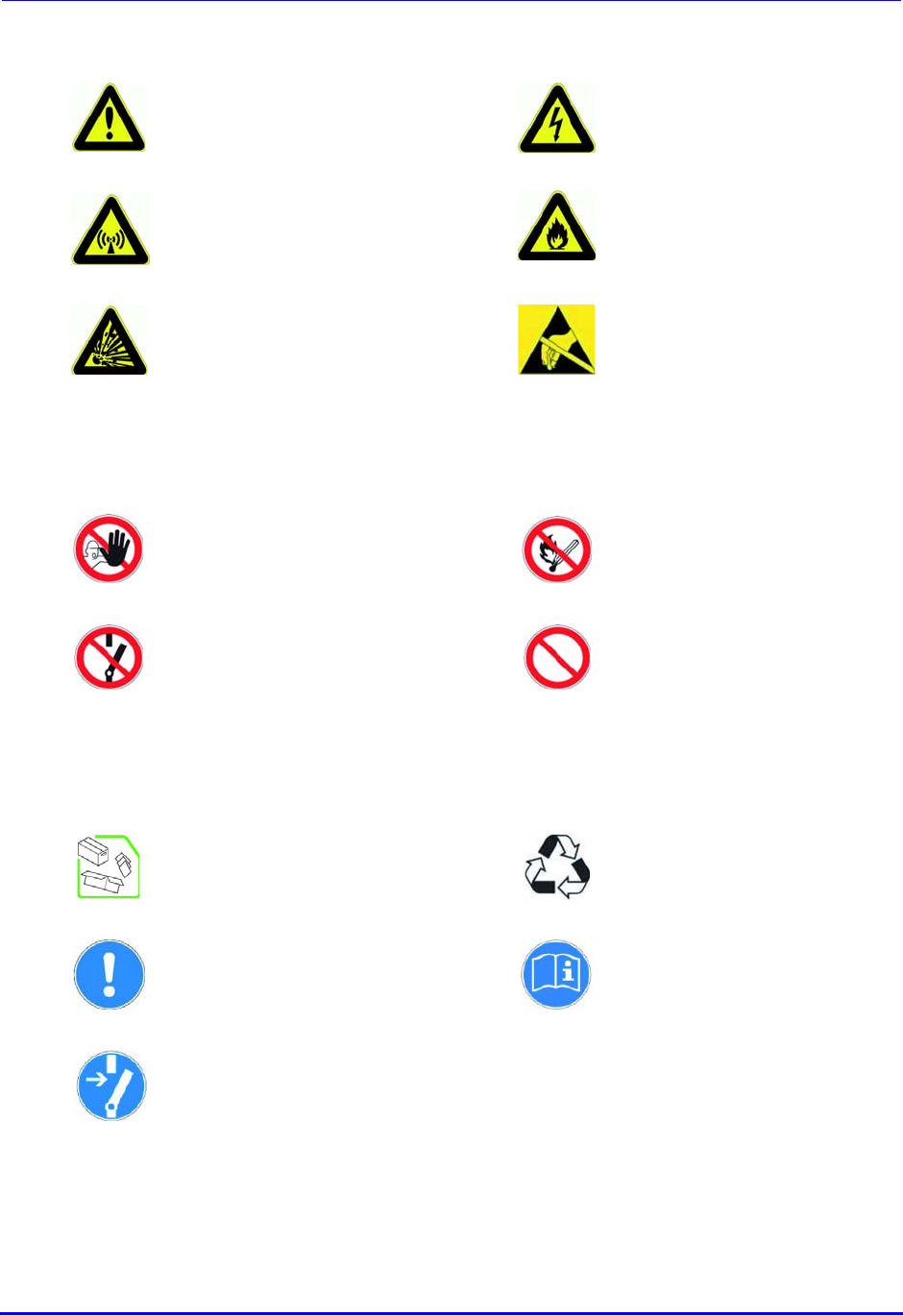
Brooks Automation
278580 Revision A 9
LF80C ZeniD RFID Reader 4 Safety Instructions
Product Manual 4.3 Area of Application and Symbols
4.3.2 Warning Symbols
4.3.3 Prohibition Symbols
4.3.4 Other Symbols
Warning against
hazardous area
Warning against
hazardous electrical
voltage
Warning against
electromagnetic
radiation
Warning against
flammable materials
Warning against
potentially explosive
atmosphere
Warning against
electrostatically
sensitive
components
Unauthorized access
is prohibited
Fire, open flame and
smoking is
prohibited
Switching is
prohibited
Prohibition
Dispose of packing
material according to
regulations
Recycling
Important
information
Refer to manual
Disconnect from
power supply
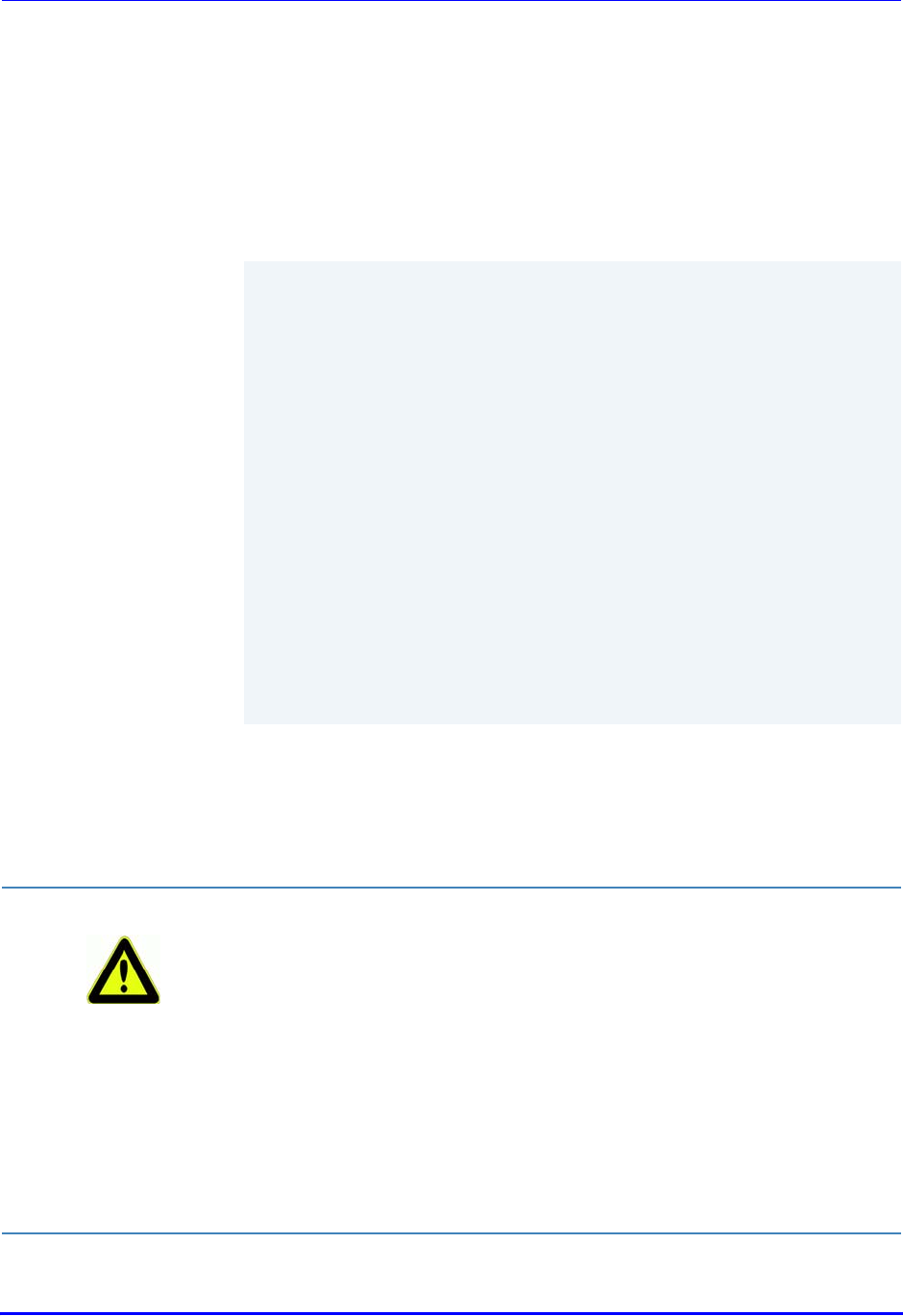
Brooks Automation
10 278580 Revision A
4 Safety Instructions LF80C ZeniD RFID Reader
4.4 Obligations Product Manual
4.4 Obligations
4.4.1 Operating Company’s Obligations
The safe condition and use of the device is a requirement for the safe
operation of the device. The company operating the device therefore has
the obligation to ensure that the following points are adhered to:
4.4.2 Operating Personnel’s Obligations
Operators are obligated to contribute to the prevention of work accidents
and the consequences of them by their personal conduct.
ÂThe device may only be operated by trained and authorized
personnel!
ÂAvoid unsafe and/or dangerous work procedures! If
necessary, check employees' actions!
ÂOnly permit personnel to be trained or instructed within the
scope of a general training work on the device under the
supervision of an experienced person!
ÂPersonnel must have understood the product manual. Have
this confirmed by signature!
ÂPrecisely establish responsibilities according to the various
task areas (operation, installation)!
ÂOperating personnel must be committed to immediately
reporting to their superior any identifiable safety deficiencies
which occur!
WARNING Risk of injuries due to insufficient personnel qualifications
A risk exists for personnel and the proper operation due to insufficiently
qualified personnel.
Only trained personnel may operate the device. New operators must be
instructed by the current operating personnel. The operating company
must precisely regulate and monitor the personnel's areas of
responsibility and competence.
Personnel for the areas of responsibility mentioned above must have the
corresponding qualification for this work (training, instructions). If
necessary, this can be done by the manufacturer on behalf of the
operating company.
All warranty claims are void when disregarded.
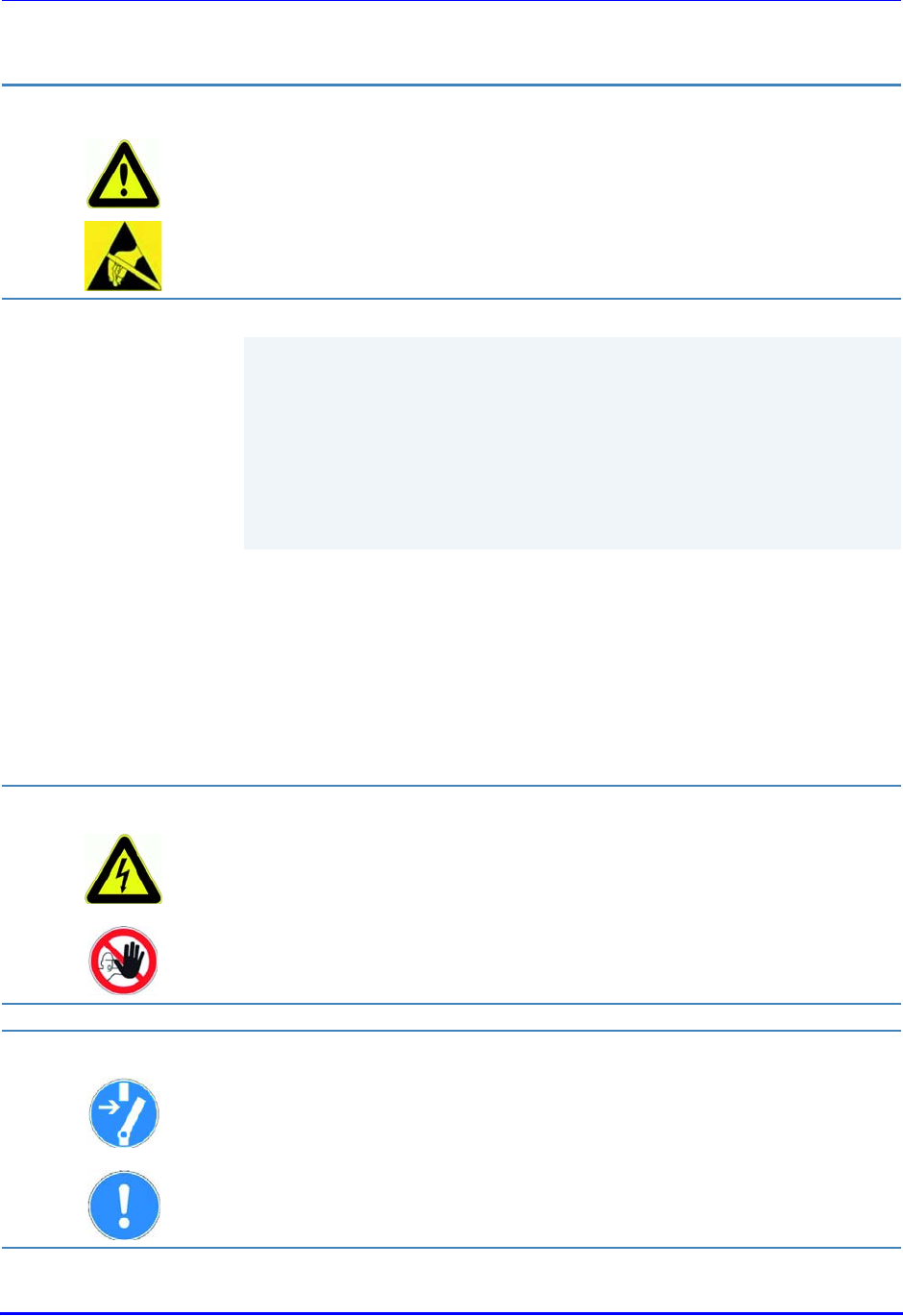
Brooks Automation
278580 Revision A 11
LF80C ZeniD RFID Reader 4 Safety Instructions
Product Manual 4.5 ESD Instructions
4.5 ESD Instructions
4.6 Residual Risks
Even if all precautions have been taken, there may be unapparent residual
risks!
Adhering to the safety instructions, the intended use, and the product
manual as a whole can reduce residual risks!
CAUTION Static electricity can damage electronic components in the device. All
persons installing or maintaining the device must be trained in ESD
protection.
ESD protective measures must be applied when opening the device.
ÂDisconnect the power supply prior to removing or adding
components.
ÂDischarge your body and all tools used prior to contacting
any components on the interior of the device!
ÂTouch electronically sensitive parts carefully and at the
corners!
DANGER Risks from electric current
Electrical energy remains in lines, equipment and devices even when the
device is switched off.
Only allow qualified electricians to perform work on the electrical supply
system.
ATTENTION Disconnect the device from the power supply system if active parts of
the device can be accessed by using tools. Access is only permitted for
authorized personnel.
Regularly check the electrical equipment of the device. Regularly check
all moving cables for damage within the scope of maintenance and
repairs.
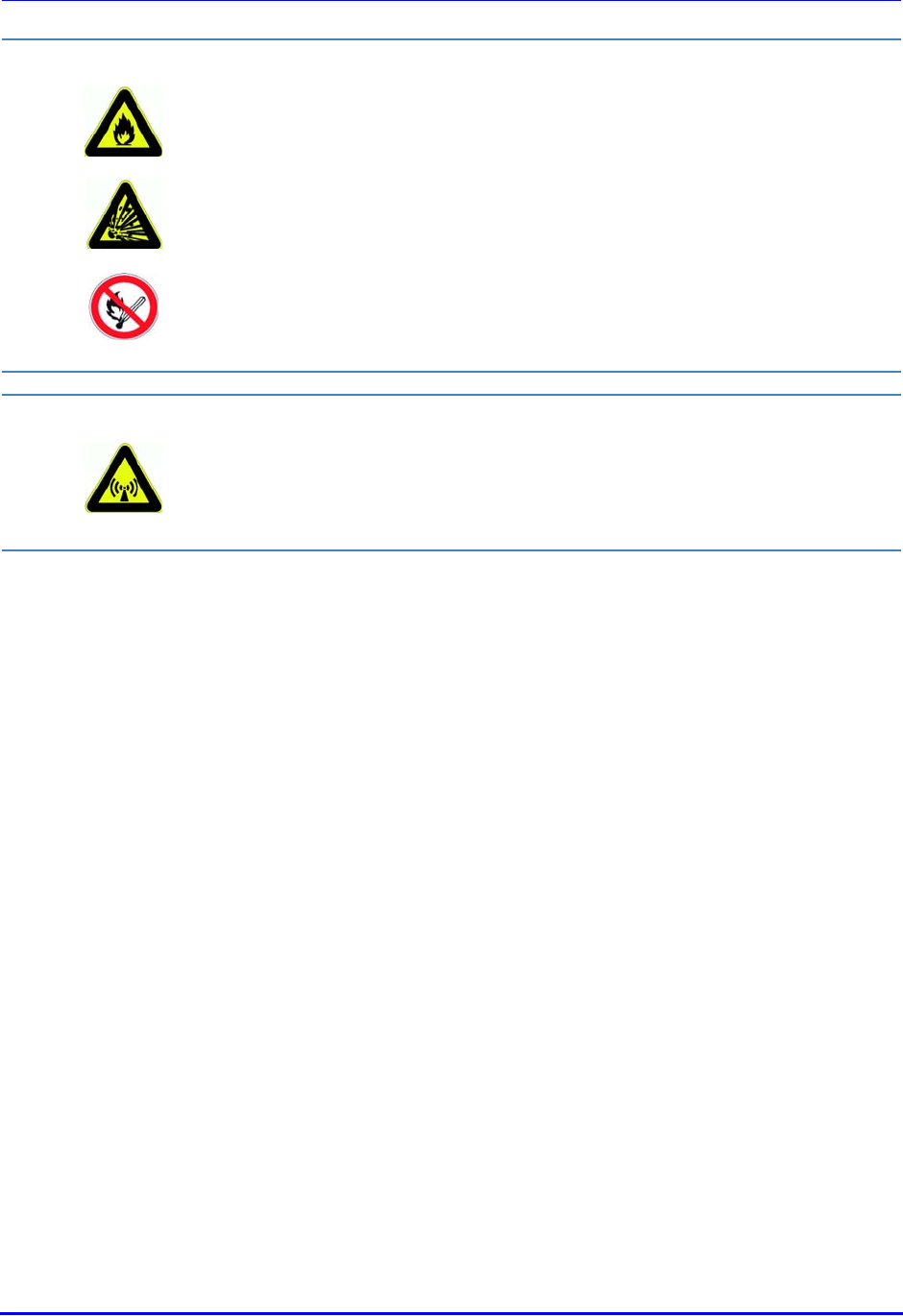
Brooks Automation
12 278580 Revision A
4 Safety Instructions LF80C ZeniD RFID Reader
4.7 Additional Information Product Manual
4.7 Additional Information
Read and understand all safety and product manuals prior to
installing and operating the device.
This documentation was written for specifically trained personnel.
Installation, operation and troubleshooting may only be carried out
by specifically trained personnel.
Retain this product manual. Keep this documentation in a location
that is accessible to all personnel involved with the installation, use
and troubleshooting of the device.
Follow all warnings. Follow all warnings on and in the device and in
the documentation.
Install the device only in accordance with the manufacturer's
instructions.
Use only the accessories and cables from the manufacturer.
Troubleshooting that is not described in Chapter
Î
Service and
Troubleshooting may only be performed by the manufacturer.
People with hearing aids should be aware that the radio signals
emitted by the device can cause annoying noises in the hearing
aid.
Do not connect the device to power supplies such as normal
household electrical outlets. The device should only be connected
to power supplies as specified in this document.
DANGER Risk of fire and explosions
Fire and explosions may occur within the vicinity of the device.
Smoking, open flames and fire are strictly prohibited in the vicinity of the
device. Do not store any flammable liquids within the hazardous area.
Keep a fire extinguisher in the vicinity of the device.
WARNING Warning against electromagnetic radiation
Electromagnetic radiation develops when transmitting and receiving
data.
All Brooks RFID devices of the LF family comply with the standard EN
50357:2001.

Brooks Automation
278580 Revision A 13
LF80C ZeniD RFID Reader 4 Safety Instructions
Product Manual 4.7 Additional Information
When removing a cable, only pull on the plug and not on the cable.
Connect cable connectors straight and carefully to avoid damaging
the contacts.
Never overbend the antenna cables or subject these to mechanical
forces.
When replacement parts are required, use only the replacement
parts that were specified by the manufacturer. Unauthorized spare
parts can result in fire, electric shock or other hazards.
Rules and
regulations
The provisions of the accident prevention regulations of the government
safety organizations always apply to all work on the device.
The following must also be observed:
applicable legally binding accident-prevention regulations
applicable binding regulations at the place of use
the recognized technical rules for safe and professional work
existing environmental protection regulations
other applicable regulations

Brooks Automation
14 278580 Revision A
4 Safety Instructions LF80C ZeniD RFID Reader
4.7 Additional Information Product Manual
This page intentionally left blank

Brooks Automation
278580 Revision A 15
LF80C ZeniD RFID Reader 5 Product Specifications
Product Manual 5.1 Function
5 Product Specifications
This chapter gives you an overview of the following topics:
Î
Function
Î
Indicating and Operating Elements
Î
Inside View
Î
Description of the Components
Î
Technical Data
Î
Antenna Cable
Î
Contents of Delivery
5.1 Function
The BROOKS RFID Reader LF80C ZeniD is a high-frequency identification
system that uses FM transmissions.
The basic item is a transponder that works as a forgery-proof electronic
identity disk.
The reading unit of the system sends an energy impulse via the antenna.
The capacitor of the passive, battery-free transponder is charged by this
impulse. After that, the transponder returns a signal with the stored data.
The total reading cycle takes less than 100 ms.
Since a sight connection between the transponder and the reader is not
absolutely necessary, the transponder can also be identified through non-
metallic material.
The data received by the RFID reader is transmitted to the host computer
via a serial interface.
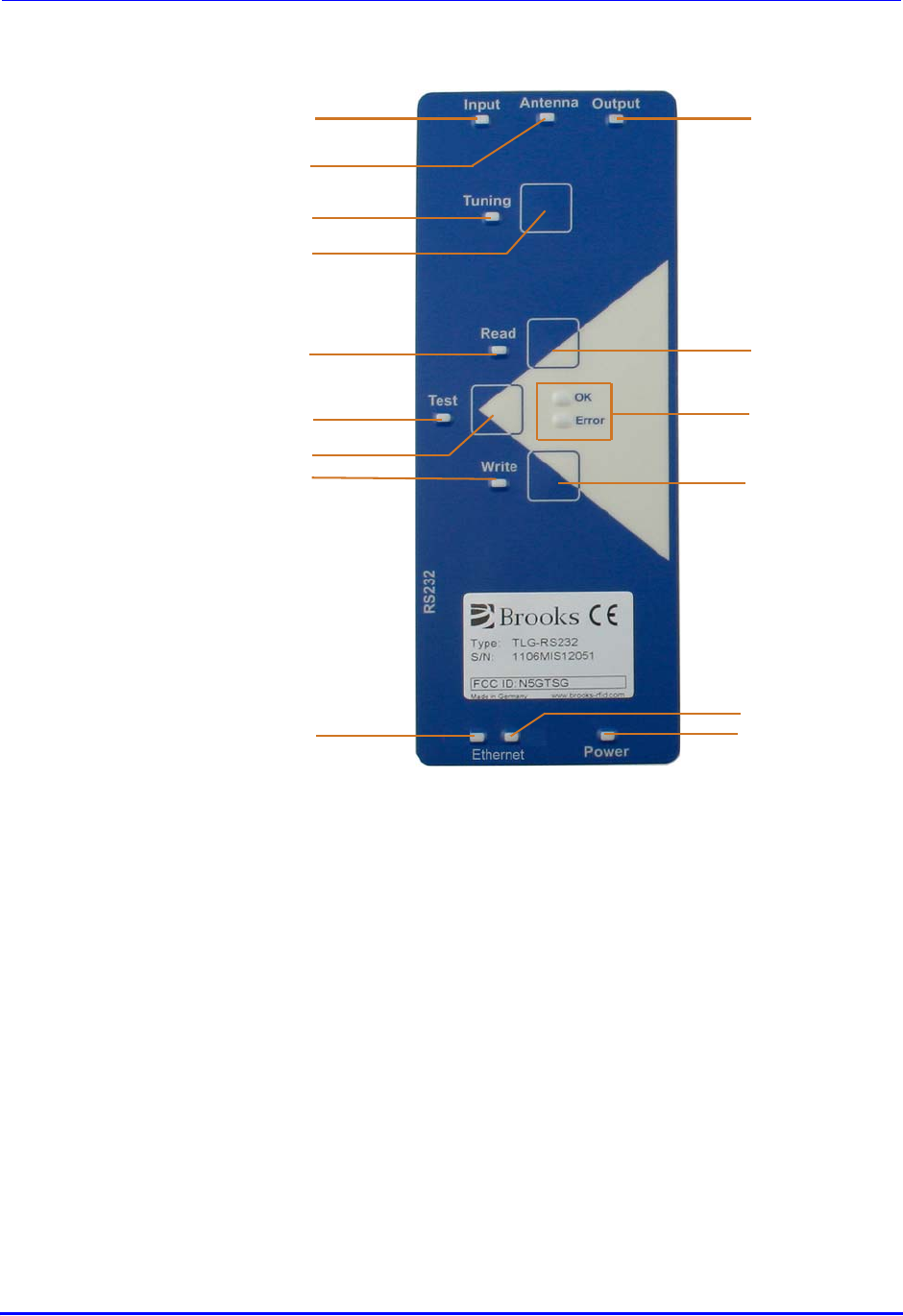
Brooks Automation
16 278580 Revision A
5 Product Specifications LF80C ZeniD RFID Reader
5.2 Indicating and Operating Elements Product Manual
5.2 Indicating and Operating Elements
1
2
3
4
5
6
7
9
10
11
12
13
14
15
8
1External Output LED 9Test mode button
2Read button 10 Test LED
3Status LEDs 11 Read LED
4Write button 12 Tuning button
5Traffic LED 13 Tuning LED
6Power LED 14 Antenna LED
7Link LED 15 Input LED
8Write LED
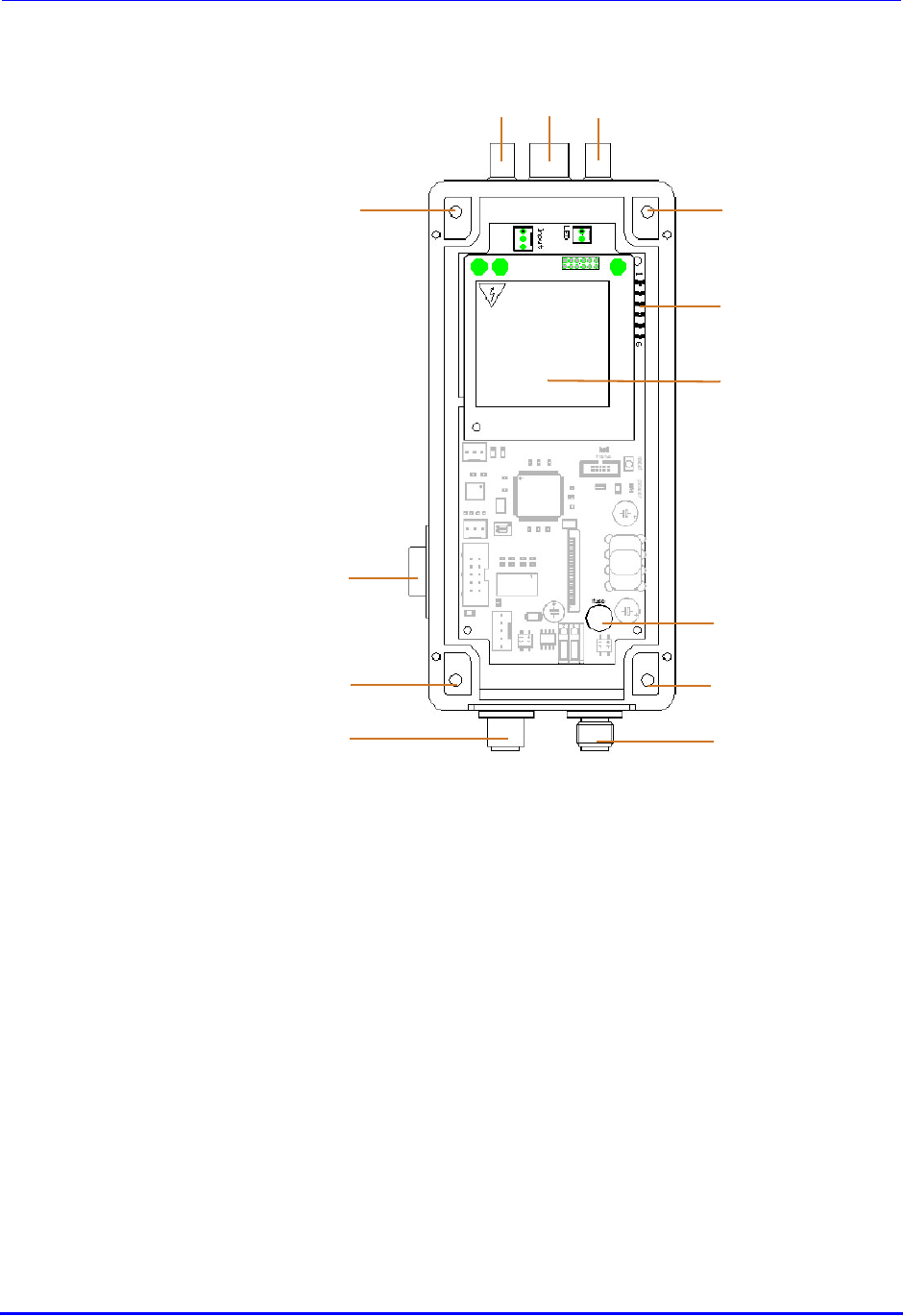
Brooks Automation
278580 Revision A 17
LF80C ZeniD RFID Reader 5 Product Specifications
Product Manual 5.3 Inside View
5.3 Inside View
123
4
5
6
7
8
9
10
11
12
13
1External input 8Assembly hole
2Port for antenna 9Power supply port
3External output 10 Ethernet interface with
PoE
4Assembly hole 11 Assembly hole
5Tuning LED 12 RS232 interface 9-pin
Sub-D female plug
6LF module 13 Assembly hole
7Fuse

Brooks Automation
18 278580 Revision A
5 Product Specifications LF80C ZeniD RFID Reader
5.4 Description of the Components Product Manual
5.4 Description of the Components
Component Description
LF module Via the antenna the LF module supplies the
transponder with energy and it transmits the
received data to the controller.
Tuning LEDs The six Tuning LEDs show the switch status of
the adjustment relays.
RS232 interface The data are passed down serially to one of the
two RS232 interfaces (9-pin Sub-D female
plug) with the different protocols. Baud rates of
300 Bd up to 115.2 kBd are possible.
Ethernet interface Communication with the device can be carried
out via the 10/100 BaseT Ethernet interface
(IEEE 802.3) with PoE.
External output The external output (usually a LED) shows the
status of the reader. The behavior of the
external output is depending on the sensor
triggered automatic reading.
The LED remains on until the read operation is
complete. The LED goes off if the reader
receives confirmation that the page was read, or
if an error message occurs.
If the host does not return confirmation after the
page was read, the LED remains on until either a
new read process is started and successfully
completed, or until the device is reset.
External input A sensor (such as an optical sensor) can be
connected to the external input.
Fuse TR5 housing, 400 mA T (low-breaking).
Tuning LED The antenna's efficiency is optimized by pushing
the automatic calibration button. The LED lights
up during the calibration process and
subsequently goes off when tuning is successful.
If a fault occurs, the LED flashes until the next
calibration process is successful.
Possible faults could be caused by a defective
antenna or a strong metallic environment near
the antenna.
Antenna LED If the antenna sends LF signals (to load a
transponder or send data, for example), the LED
is activated for this period.

Brooks Automation
278580 Revision A 19
LF80C ZeniD RFID Reader 5 Product Specifications
Product Manual 5.4 Description of the Components
Input LED The Input LED indicates that the external sensor
was initiated, or that an external potential-free
contact was actuated.
Output LED If the external output is set, the LED is on; if
not, the LED does not light up.
Link and Traffic LED Link LED: LED is on → Link OK.
Traffic LED: LED is flashing → Rx or Tx activity
Test LED The test mode is used to check the most
important reader features (reading or writing),
which are operated by pressing the
corresponding button in test mode.
To switch the reader to test mode, press the Test
mode button and keep it pressed for at least five
seconds. The Test LED flashes when the reader
is in test mode.
Press the Test mode button again to leave test
mode.
Component Description
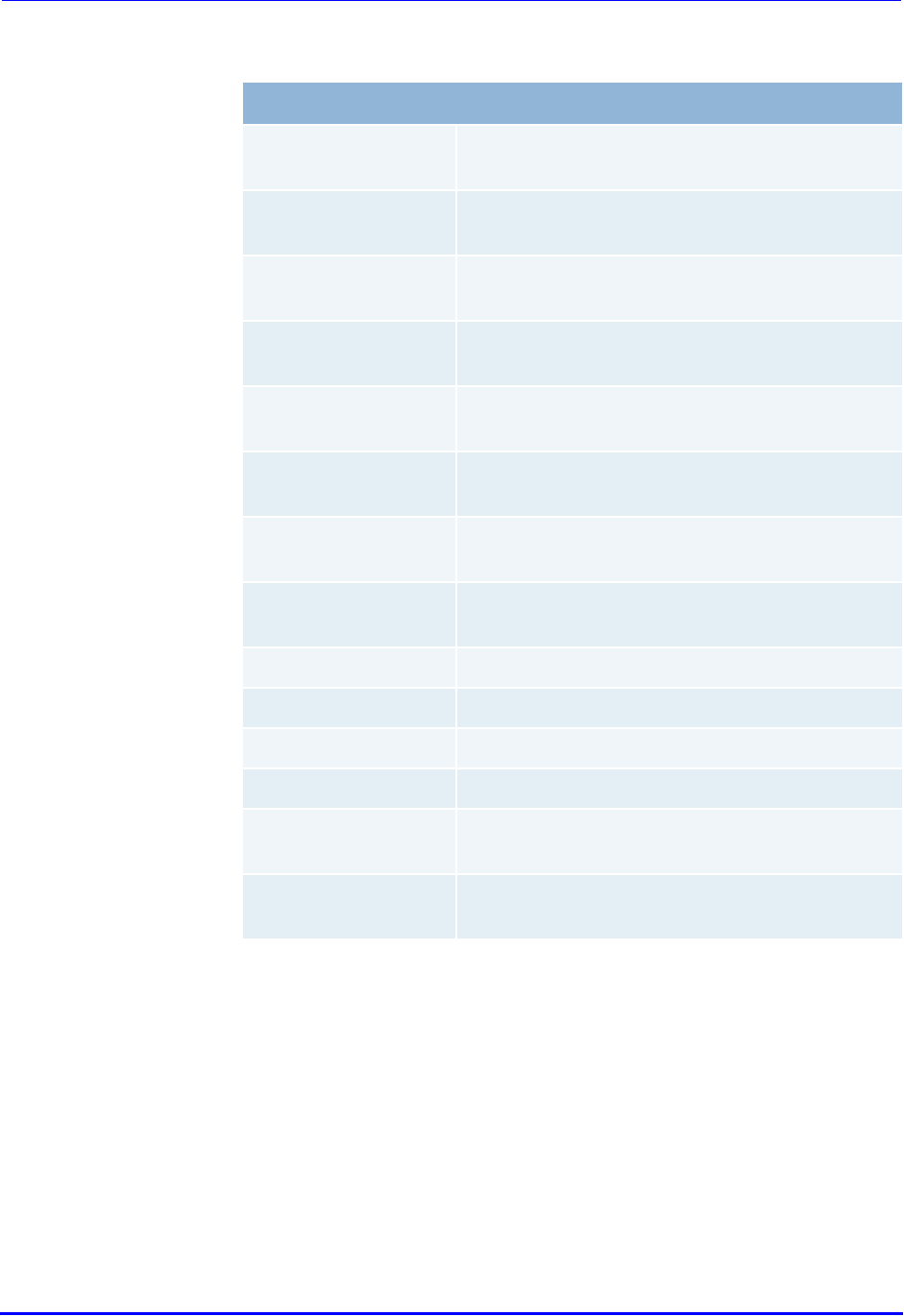
Brooks Automation
20 278580 Revision A
5 Product Specifications LF80C ZeniD RFID Reader
5.5 Technical Data Product Manual
5.5 Technical Data
Technical data - device
Operating
temperature
0 °C to +50 °C
32 °F to 122 °F
Storage temperature -25 °C to +70 °C
-13 °F to +158 °F
Permissible humidity
at 50 °C / 122 °F
25 - 80 %
Transmitting
frequency
134.2 kHz
Max. field strength in
3 m distance
110 dB μV/m
Typ. period of
charging impulse
50 ms
Max. repeat of
reading
4/s
Max. repeat of
programming
1/s
Protection class IP 40
Housing material ABS
Weight about 440 g
Fuse 400 mA (T)
Serial interface
RS232
300 Bd - 115.2 kBd
Ethernet interface 10/100 BaseT (IEEE 802.3) with PoE (endspan
only)
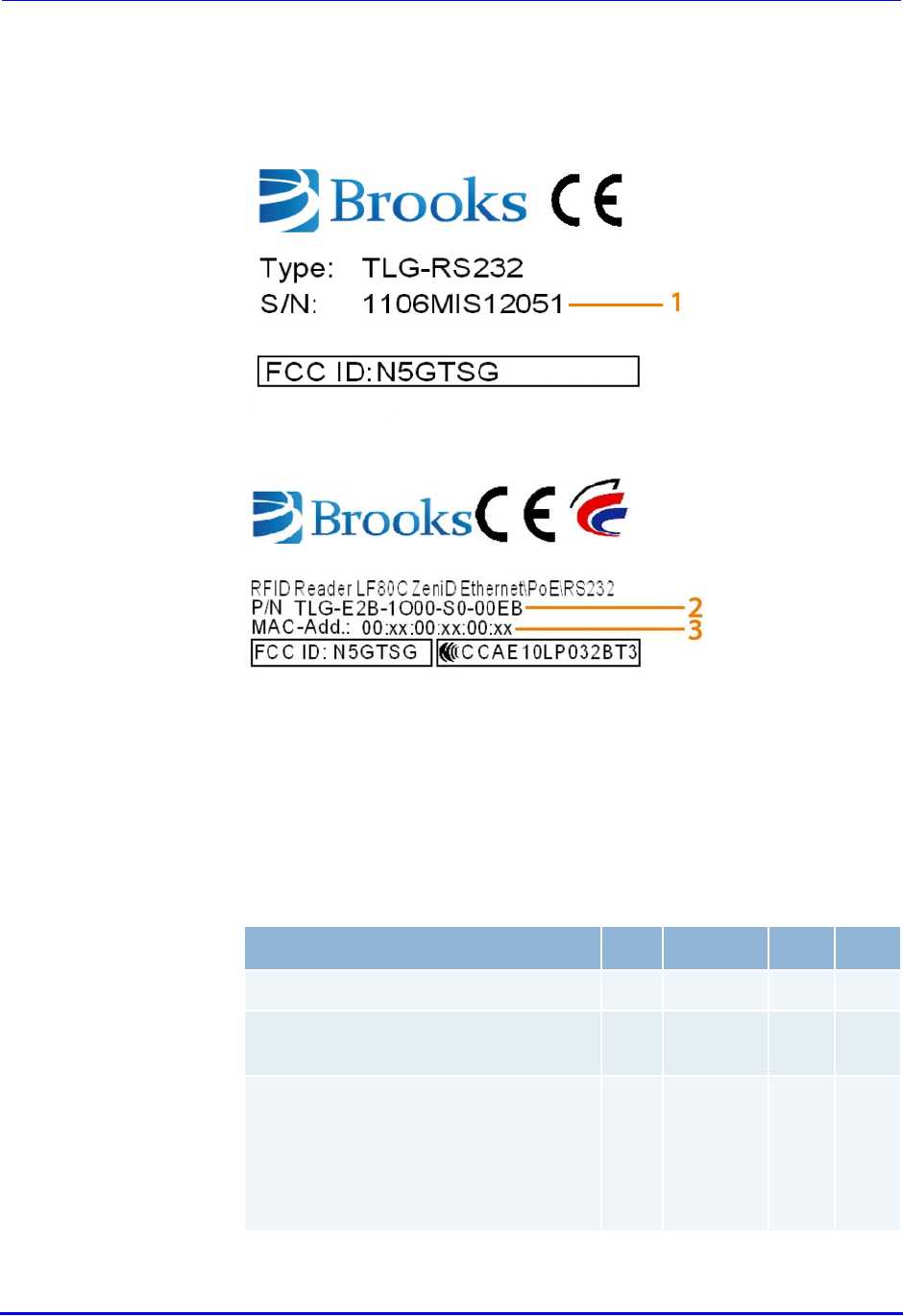
Brooks Automation
278580 Revision A 21
LF80C ZeniD RFID Reader 5 Product Specifications
Product Manual 5.5 Technical Data
5.5.1 Device Label
The device labels with the CE mark, serial and part number and MAC
address are on the device housing.
Label on top
Label at the side
5.5.2 Power Supply and Current Input
www.brooks.com Made in XXXX
1Serial number (example)
2Part number
3MAC address
Description Min Type Max Unit
Voltage (reverse polarity protected) 18 24 30 V DC
Current with/without presence sensor
(power-up process excluded)
70/95 mA
Reading/writing impulse
Rod antenna without/with presence
sensor
Micro antenna without/with presence
sensor
160/185
140/165
mA
www.brooks.com Made in XXXX

Brooks Automation
22 278580 Revision A
5 Product Specifications LF80C ZeniD RFID Reader
5.6 Antenna Cable Product Manual
5.6 Antenna Cable
5.6.1 Cable for Rod Antenna and Frame Antenna
5.6.2 Cable for Mini Antenna and Micro Antenna
Standard cable
Diameter 5.6 mm
Bending radius 84 mm
If the device is installed immediately and the
cable is therefore only bent one single time, a
bending radius of 33 mm is permitted.
Material PVC
Approvals VDE, IEC, UL
Highly flexible cable (suitable for energy chains)
Diameter 6 mm
Bending radius 60 mm
Material PVC
Approvals VDE, IEC, UL
Standard cable
Diameter 4.1 mm
Bending radius 41 mm
If the device is installed immediately and the
cable is therefore only bent one single time, a
bending radius of 20.5 mm is permitted.
Material PVC
Approvals VDE, IEC, UL
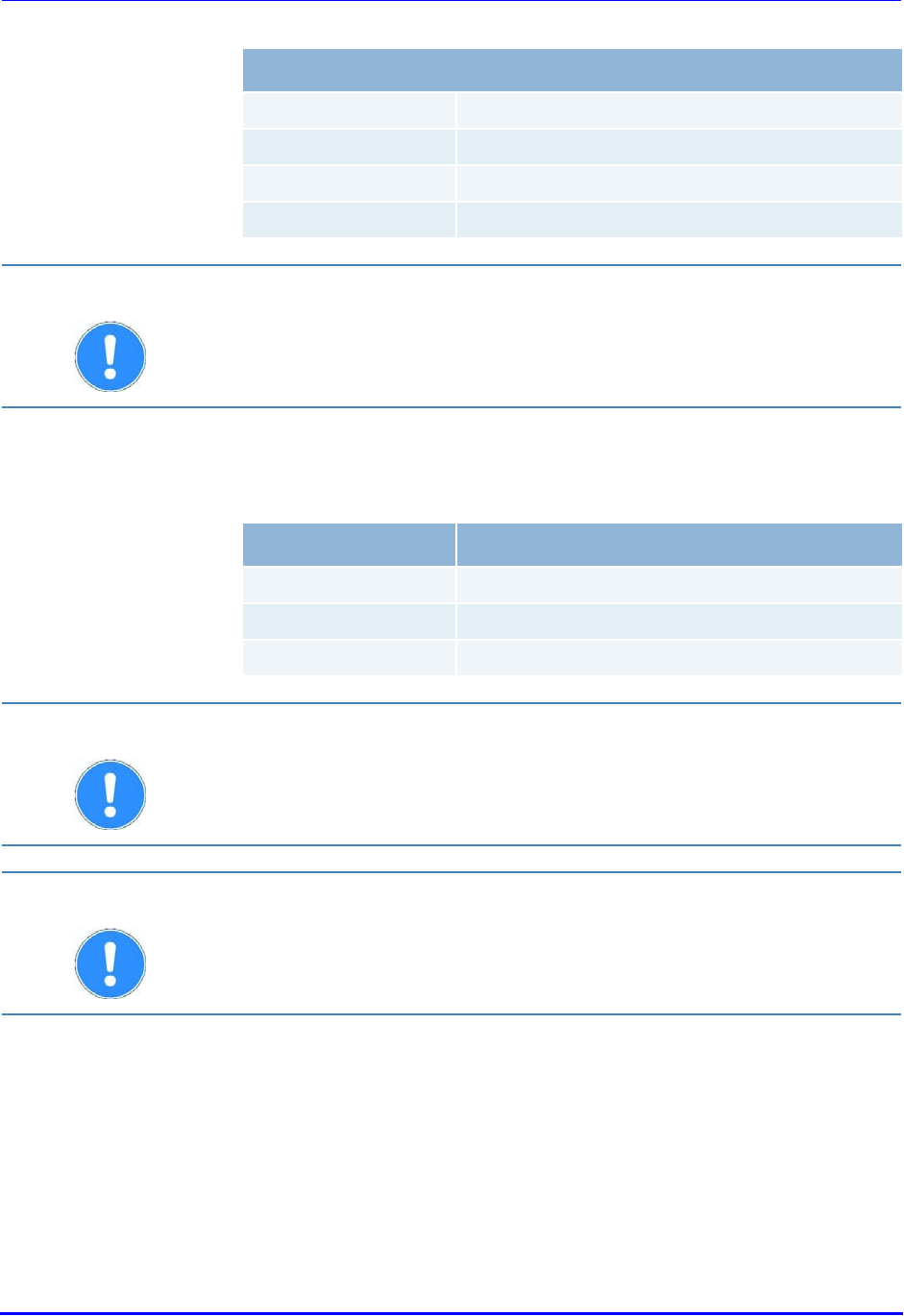
Brooks Automation
278580 Revision A 23
LF80C ZeniD RFID Reader 5 Product Specifications
Product Manual 5.7 Contents of Delivery
5.7 Contents of Delivery
Highly flexible cable (suitable for energy chains)
Diameter 5 mm
Bending radius 50 mm
Material PVC
Approvals VDE, IEC, UL
IMPORTANT Special antennas with other highly flexible cables are available upon
request.
Quantity Description
1RS232 RFID reader
1Mounting set
1Accompanying letter
IMPORTANT For available or required accessories, e.g. antennas, adapters and
cables, see
Î
Accessories.
IMPORTANT For additional information, software, drivers, etc., our extensive
download area is available to you at www.brooks.com -> Service ->
Download.

Brooks Automation
24 278580 Revision A
5 Product Specifications LF80C ZeniD RFID Reader
5.7 Contents of Delivery Product Manual
This page intentionally left blank
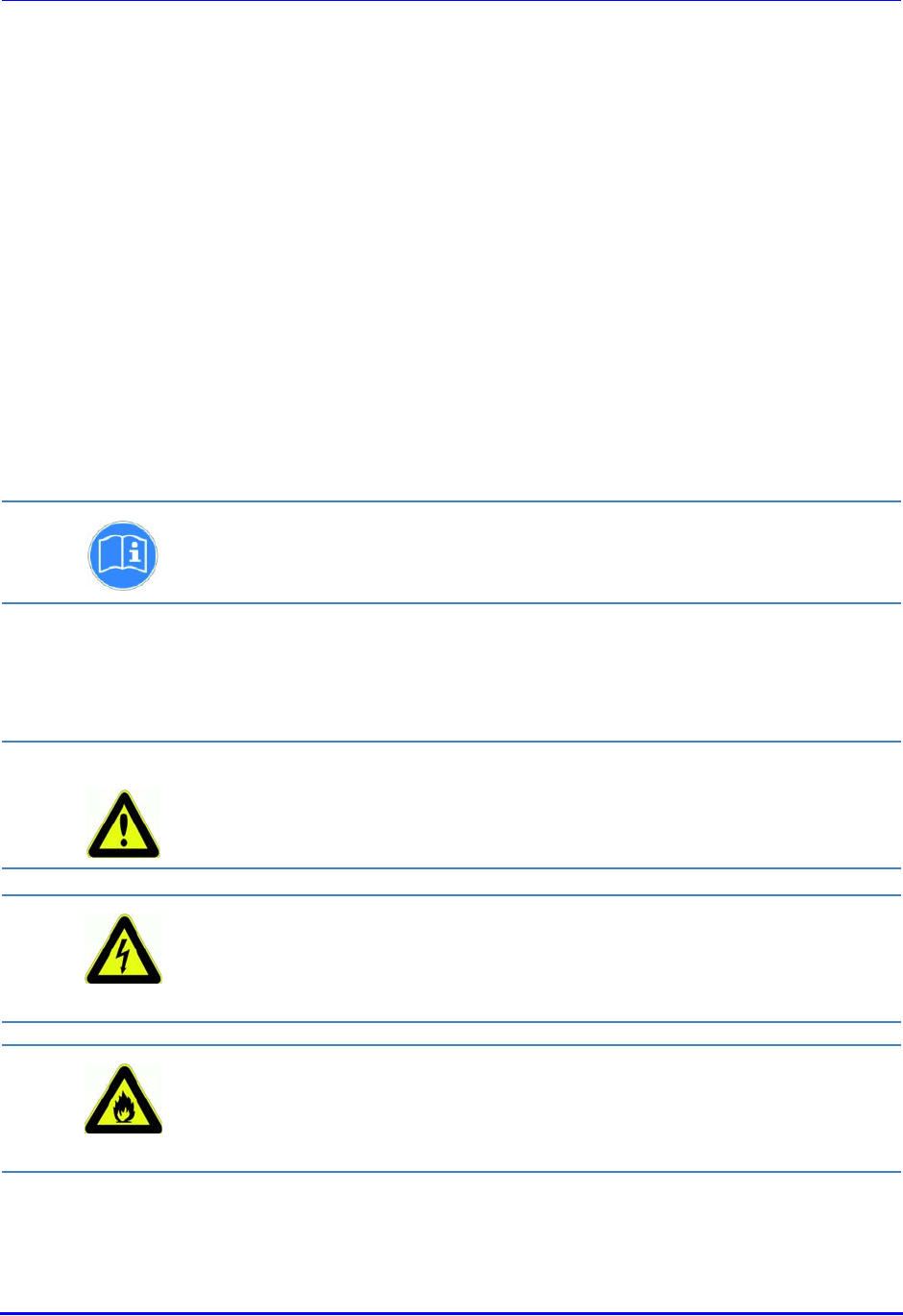
Brooks Automation
278580 Revision A 25
LF80C ZeniD RFID Reader 6 Installation
Product Manual 6.1 Safety Instructions
6 Installation
This chapter gives you an overview of the following topics:
Î
Safety Instructions
Î
Qualified Installation Personnel
Î
Unpacking
Î
Assembly of the Device
Î
Antenna Installation
Î
Power Supply
Î
Terminal Conne ction
Î
Ethernet Connection
Î
External Input and Output
Î
Commissioning
6.1 Safety Instructions
Follow the instructions in the safety chapter
Follow the general safety instructions in the chapter
Î
Safety
Instructions.
CAUTION The device is designed for indoor use in an industrial setting only.
Installation is only allowed in an interior room at a constant temperature
between 0° C / 32 °F and +50 °C / 122 °F, and a relative humidity
between 25 % and 80 %.
Never use the device near or in water.
Never pour liquids of any type over the device. If the device should
accidentally come in contact with liquid, disconnect it and have it
checked by a technician.
Do not install the device near heat sources such as radiators, heat
registers, stoves or other devices (including amplifiers) that generate
heat.
Do not install the device in a flammable environment.
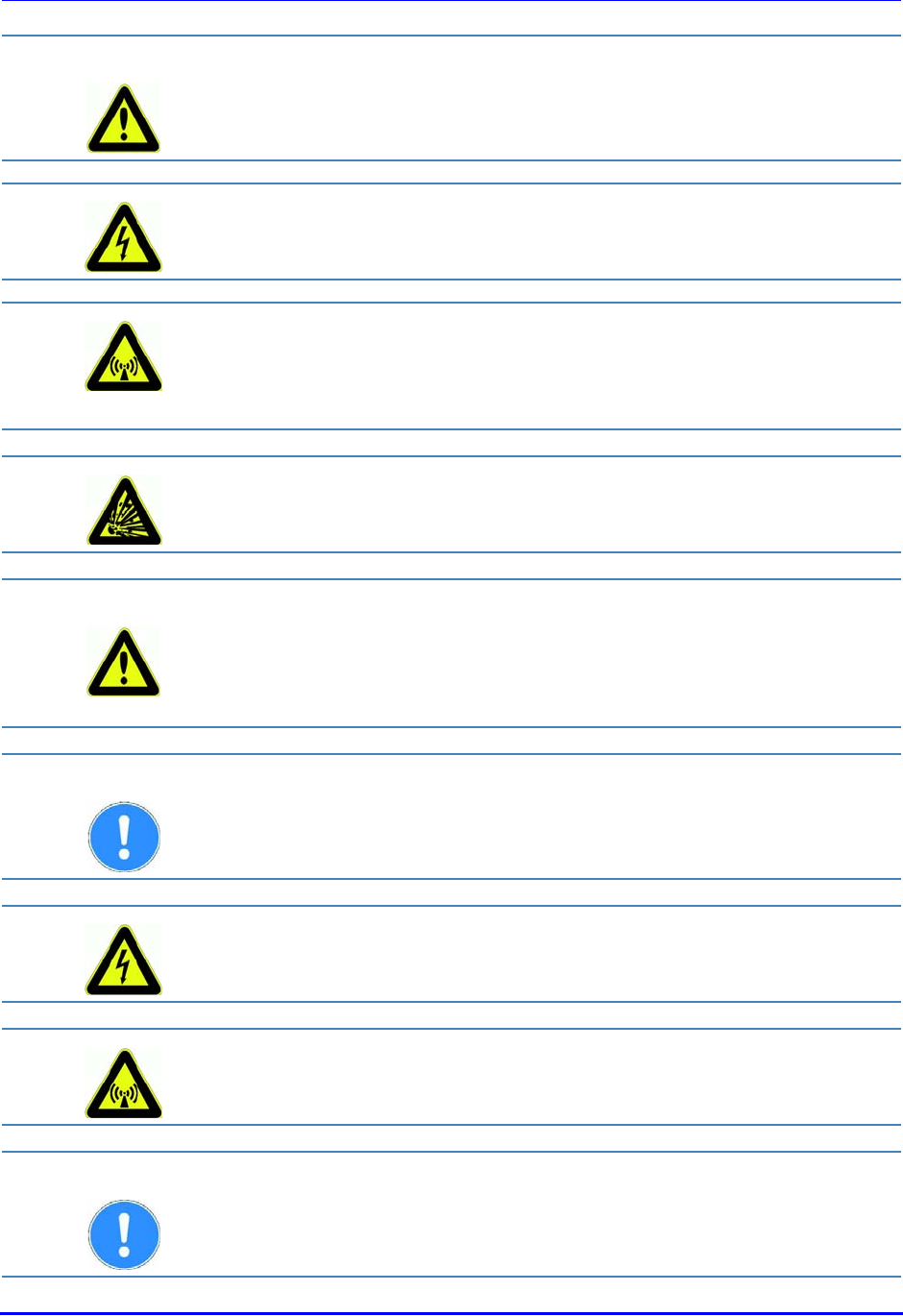
Brooks Automation
26 278580 Revision A
6 Installation LF80C ZeniD RFID Reader
6.1 Safety Instructions Product Manual
CAUTION Never expose the device to extreme temperature fluctuations, since
otherwise condensation develops in the device and causes damage.
Do not install the device in the vicinity of voltage lines or other power
lines with which they could collide (for example, when drilling), which
could result in serious injuries or even death.
The device (especially the antenna) should not be installed in the
immediate vicinity of electrical equipment such as medical devices,
monitors, telephones, TV sets, magnetic disks and metal objects.
This could result in reduced read and write ranges.
Never use the device in explosive areas (such as paint warehouses).
CAUTION Do not use the device in areas where it is exposed to vibrations or
shocks.
ATTENTION The installation location must be adequately illuminated during the
installation.
Never install the device during a lightning storm.
Verify that the installation meets the requirements of the (country
specific) FCC for human exposure to radio frequencies.
ATTENTION When determining the installation site, keep in mind the length of the
antenna wire and the read/write range of the antenna used.
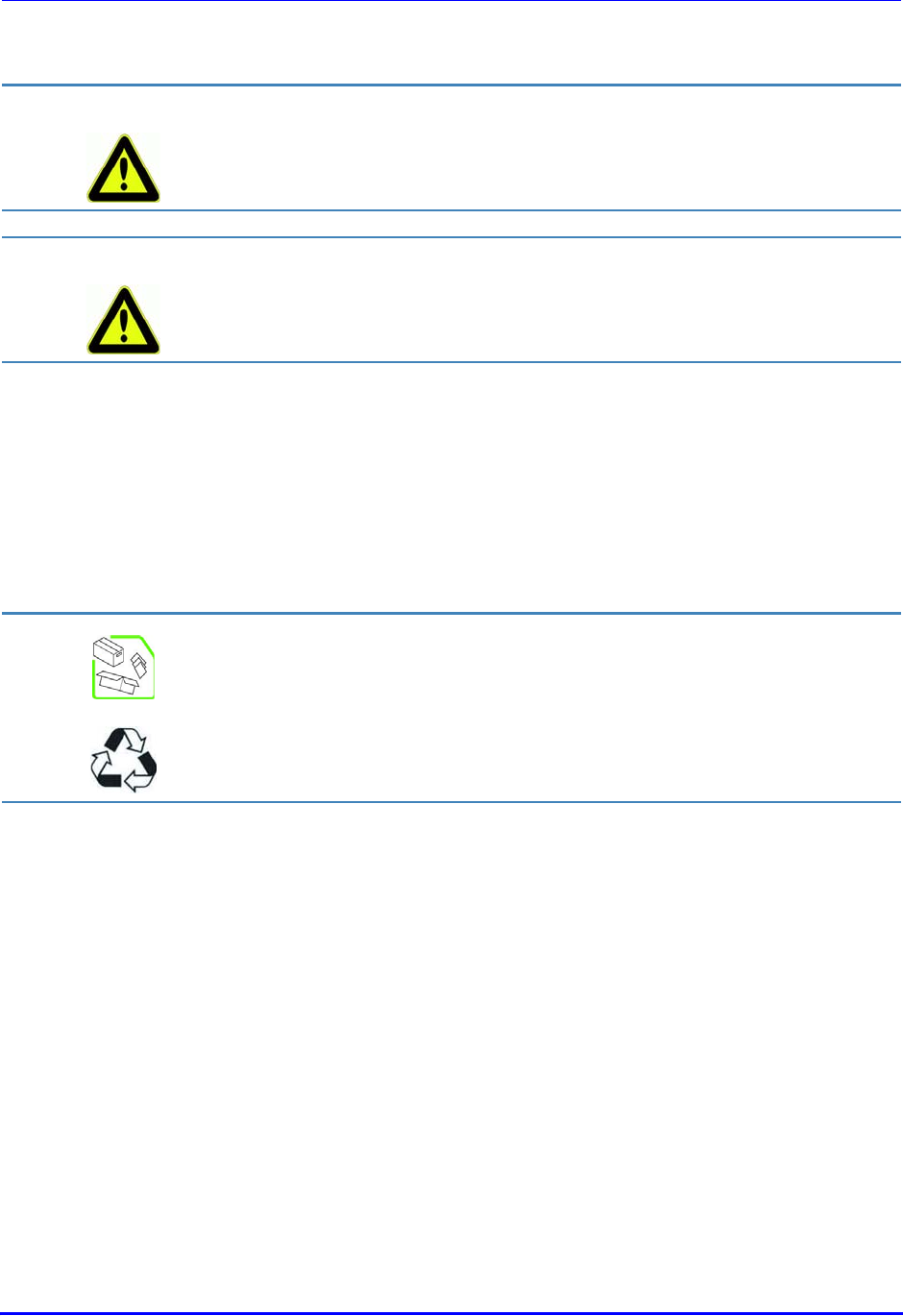
Brooks Automation
278580 Revision A 27
LF80C ZeniD RFID Reader 6 Installation
Product Manual 6.2 Qualified Installation Personnel
6.2 Qualified Installation Personnel
6.3 Unpacking
The device and the accessories are packed under clean-room conditions. In
order to maintain this condition, the device must also be unpacked in clean-
room conditions.
Disposing of the
packaging material
CAUTION Installation is to be carried out by specially trained personnel only. If
you are uncertain about their qualification, contact the manufacturer.
CAUTION Operating the device without special training can result in damage to the
reader and/or connected devices.
The packaging material consists of cardboard and foil. Dispose of these
materials separately and observing the respective regulations of your
country.
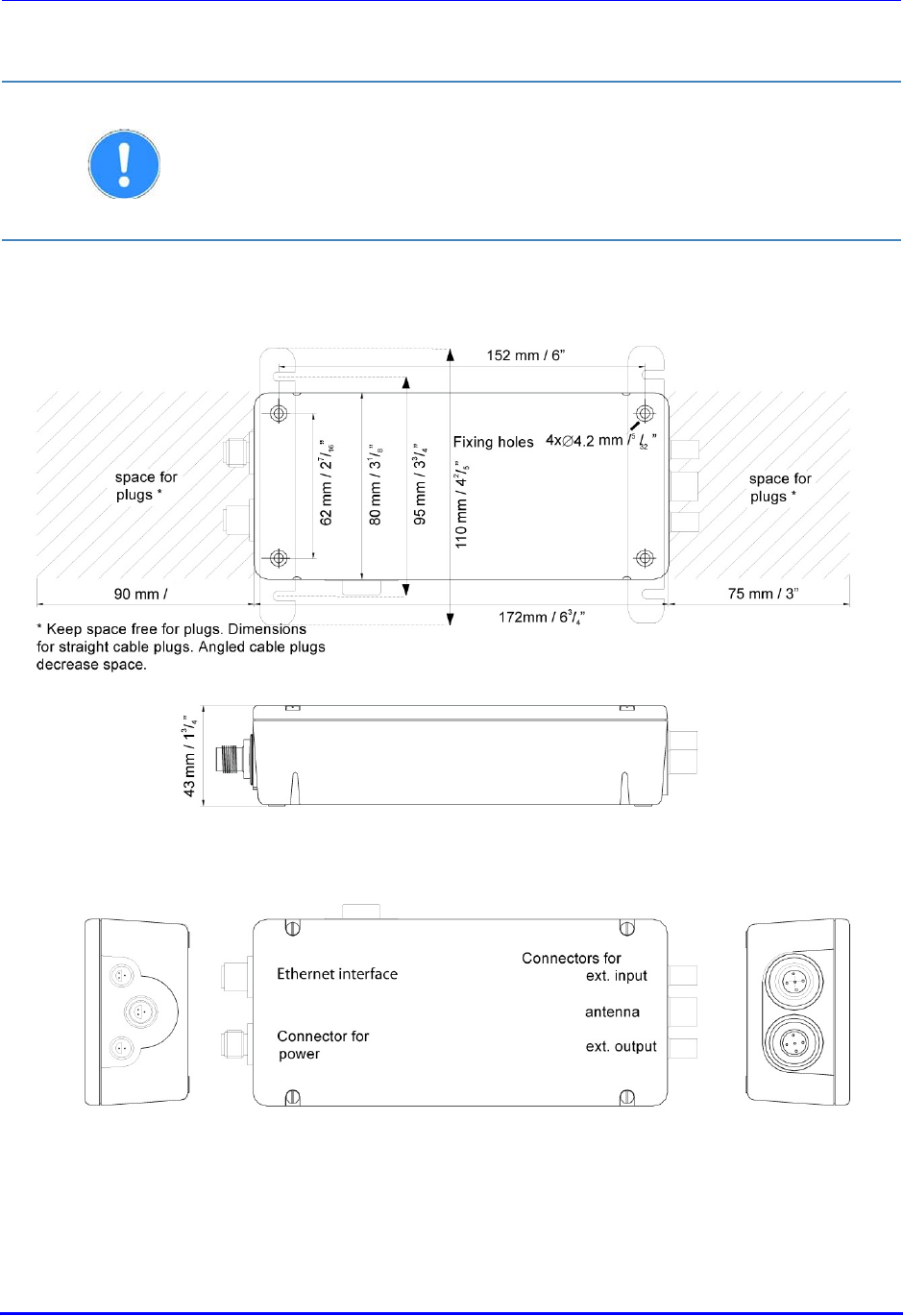
Brooks Automation
28 278580 Revision A
6 Installation LF80C ZeniD RFID Reader
6.4 Assembly of the Device Product Manual
6.4 Assembly of the Device
Installation
dimensions
ATTENTION The mounting surface must be stable, non-flammable, dry and clean.
If necessary, clean it before installing the device.
The device must be installed so that air can freely circulate vertically
through the heat sink, and the operating and environmental conditions
specified under
Î
Technical Data are met at all times.
3.54”
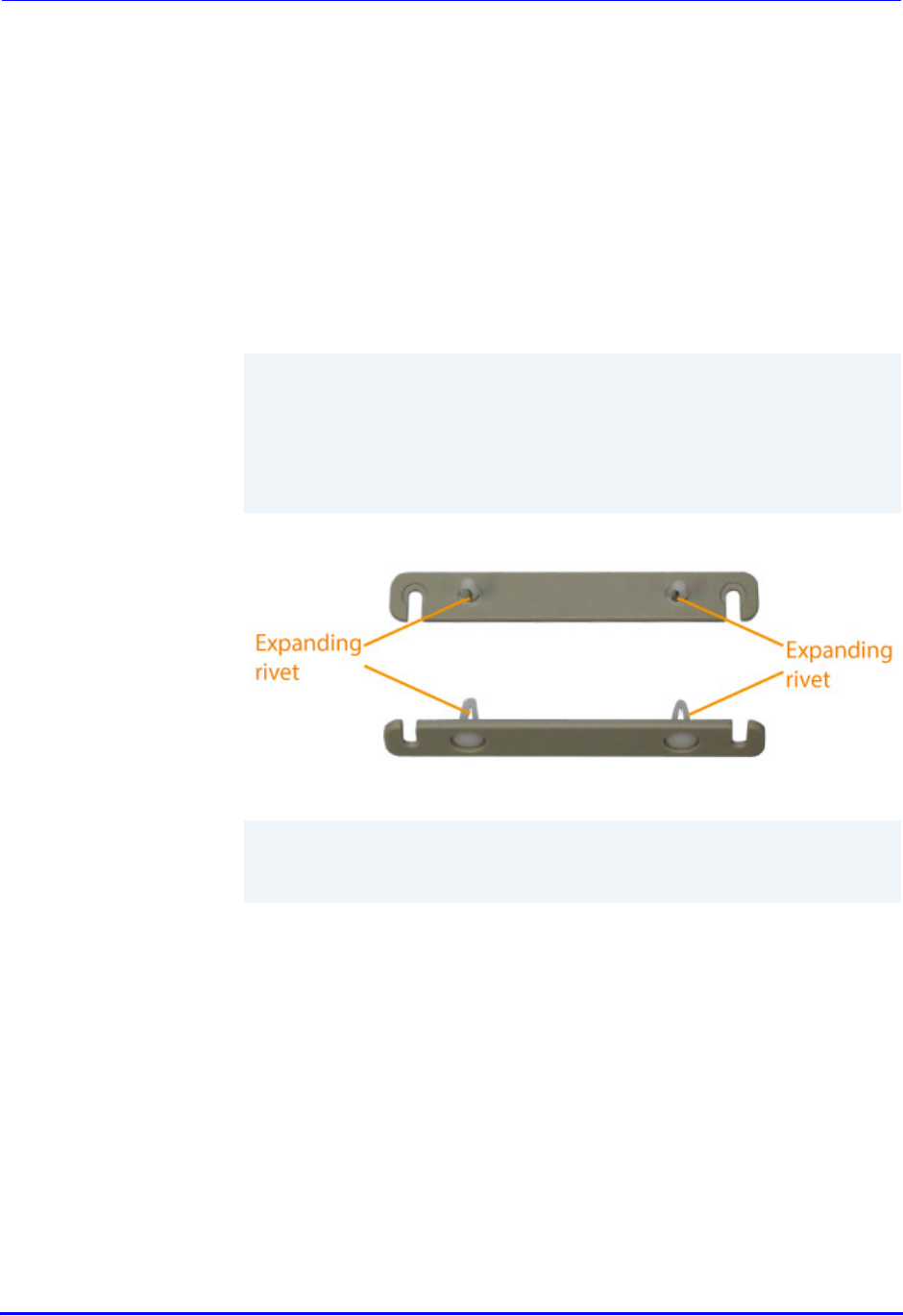
Brooks Automation
278580 Revision A 29
LF80C ZeniD RFID Reader 6 Installation
Product Manual 6.4 Assembly of the Device
6.4.1 Standard Housing for Enclosed Assembly Material
(Recommended)
Required materials
and tools
Enclosed mounting set, containing two mounts, four expanding
rivets and a drilling template
Four cylinder head screws: M4 (EU), UNC 8/32 (USA)
Four dowels (in case of wall mounting)
Appropriate screwdriver
Drilling machine with fitting drill
Assembly
ÂDrill four holes using the enclosed drilling template.
ÂWhen mounting the device on a wall, insert four dowels.
ÂInsert four expanding rivets into the two mounts as shown in
the image.
ÂPlug the mounts into the four mounting holes of the device as
shown in the image.
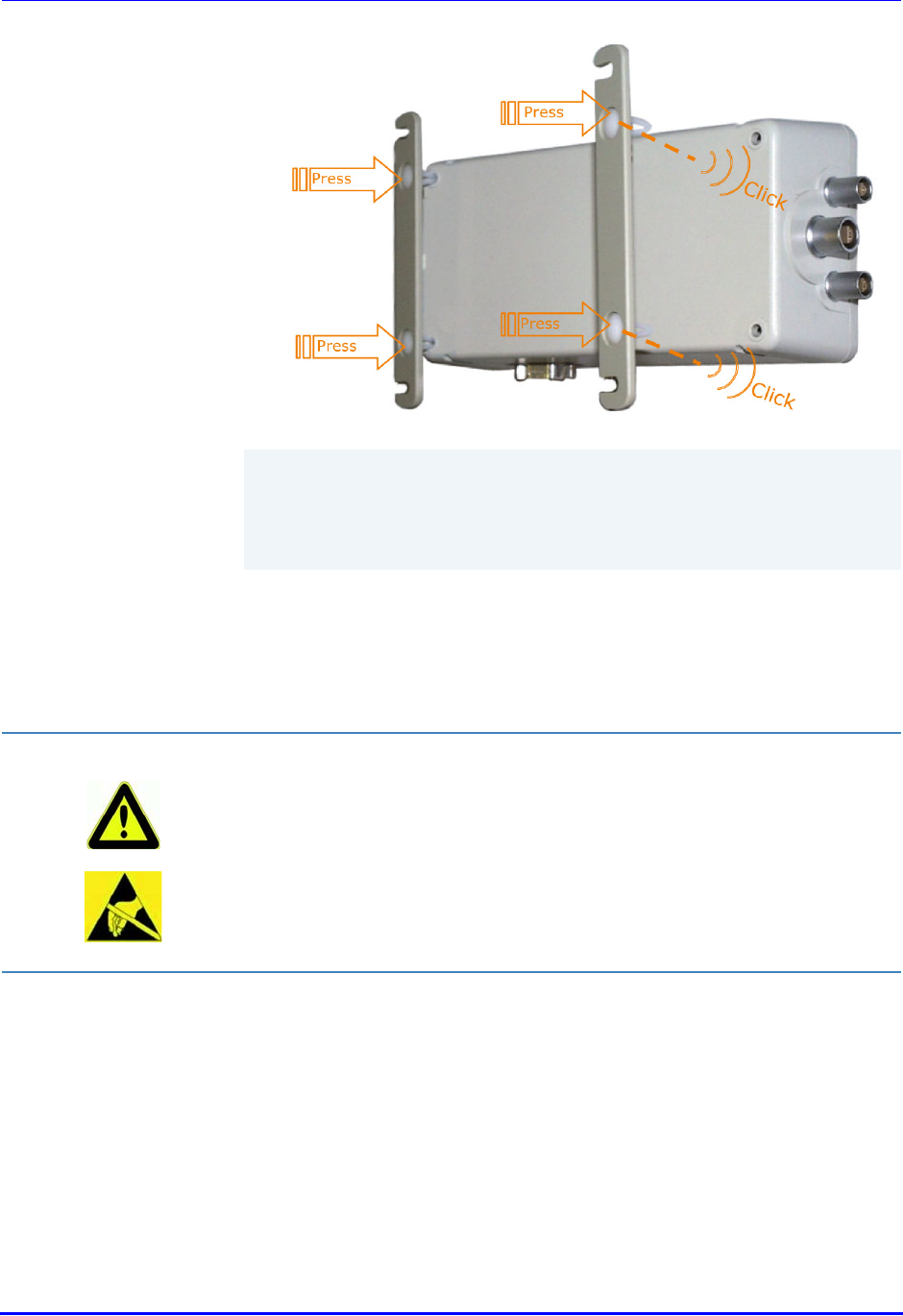
Brooks Automation
30 278580 Revision A
6 Installation LF80C ZeniD RFID Reader
6.4 Assembly of the Device Product Manual
6.4.2 Housing Without Mounts
If you intend to install the device without mounts, you will have to remove
the housing lid.
ÂScrew the device onto the assembly surface.
ÂConnect the device as described in the section
Î
Indicating
and Operating Elements.
CAUTION Static electricity can damage electronic components in the device. All
persons installing or maintaining the device must be trained in ESD
protection.
When removing the housing lid, note that the housing lid may be
connected to the case with a cable. Remove the lid carefully to prevent
damage - do not pull on it.
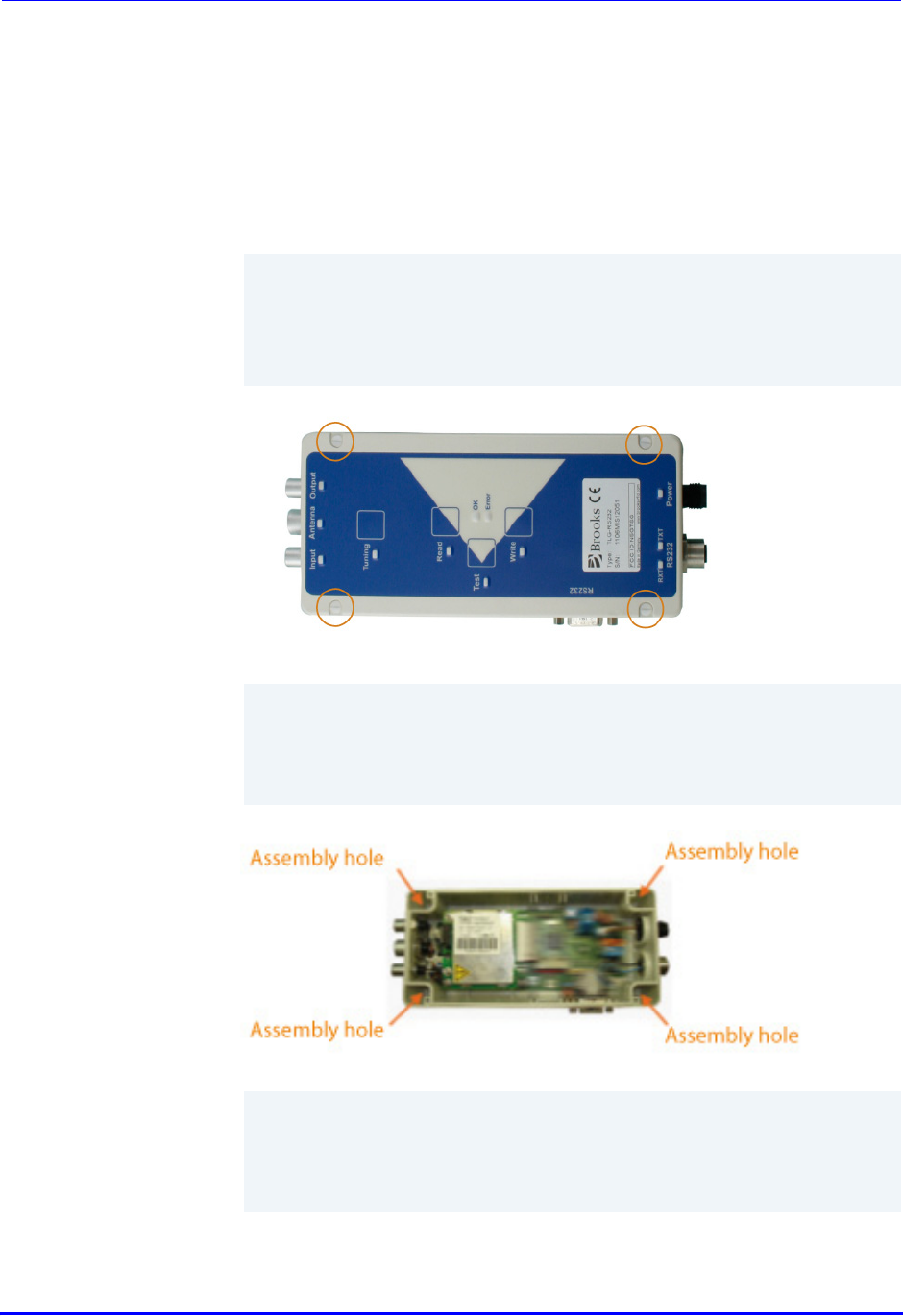
Brooks Automation
278580 Revision A 31
LF80C ZeniD RFID Reader 6 Installation
Product Manual 6.4 Assembly of the Device
Required materials
and tools
Four cylinder head screws: M4 (EU), UNC 8/32 (USA)
Four dowels (in case of wall mounting)
Appropriate screwdriver
Drilling template (enclosed)
Drilling machine with fitting drill
Assembly
ÂDrill four holes using the enclosed drilling template.
ÂWhen mounting the device on a wall, insert four dowels.
ÂUnscrew the four housing lid screws.
ÂCarefully remove the lid.
ÂScrew the device onto the assembly surface using the four
assembly holes inside the case.
ÂScrew the housing lid back onto the device.
ÂConnect the device as described in the section
Î
Indicating
and Operating Elements.
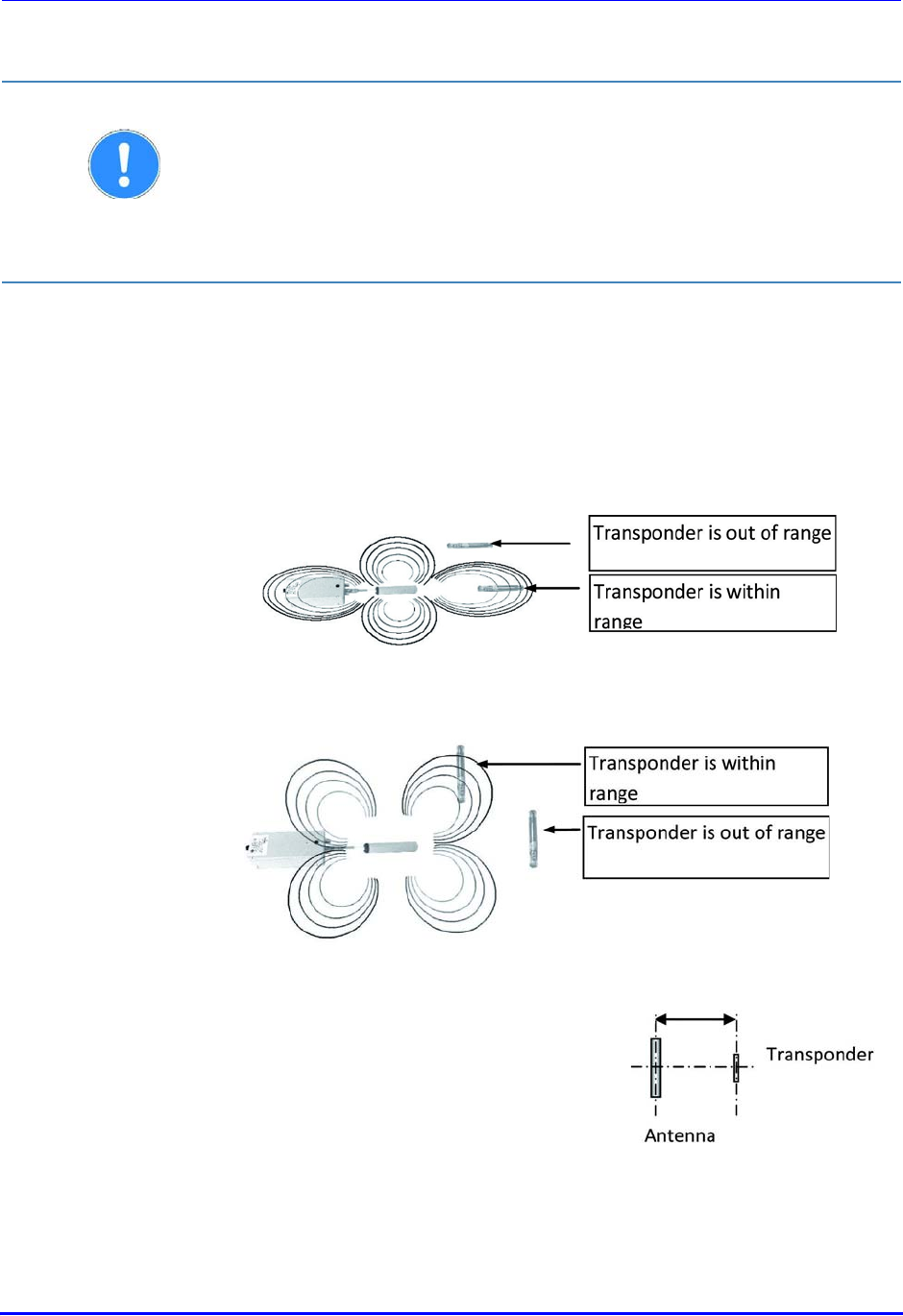
Brooks Automation
32 278580 Revision A
6 Installation LF80C ZeniD RFID Reader
6.5 Antenna Installation Product Manual
6.5 Antenna Installation
6.5.1 Positioning the Antenna
Reliable reading and writing depends on the distance from and orientation
of the transponder to the antenna.
ATTENTION When installing the antenna, consider the required reading and writing
ranges. The reader can only be used properly if the transponder is
located within the individual reading/writing range of the antenna.
If the transponder is very close to the antenna, the transponder may be
detuned by the metal of the antenna and a reading/writing is not
possible. We recommend keeping a minimum distance between
transponder and antenna of about 10 mm.
Transponder parallel to the axis of the antenna:
Transponder perpendicular to the axis of the antenna:
Parallel The illustration shows
the optimal position of
the transponder if it is
positioned parallel to
the axis of the
antenna.
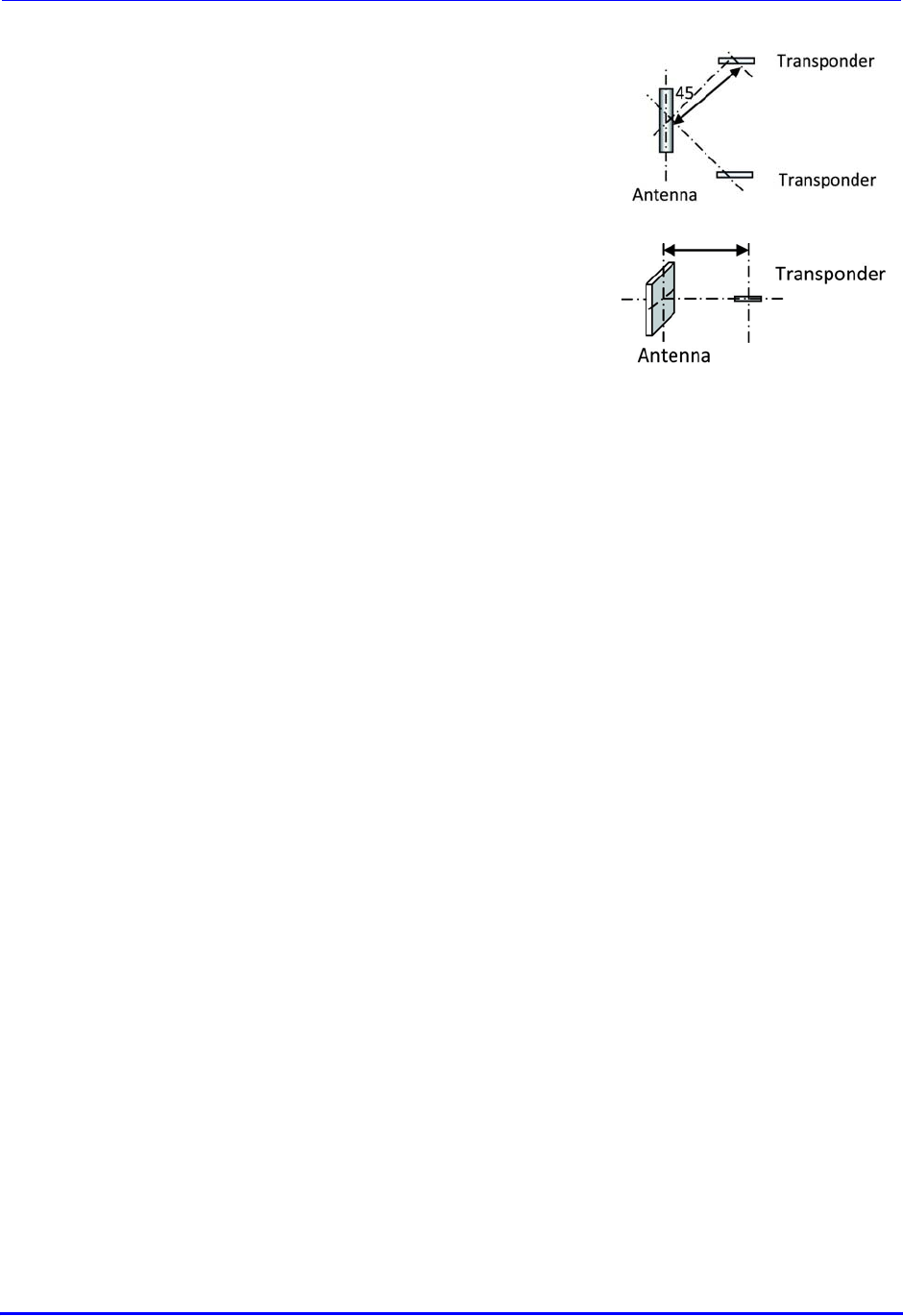
Brooks Automation
278580 Revision A 33
LF80C ZeniD RFID Reader 6 Installation
Product Manual 6.5 Antenna Installation
6.5.2 Available Antenna Types
Different types of antennas are available on request.
Perpendicular The illustration shows
the optimal position of
the transponder if it is
perpendicular to the
axis of the antenna.
Perpendicular
(frame
antenna)
The illustration shows
the optimal position of
the transponder if it is
perpendicular to the
axis of a frame
antenna.
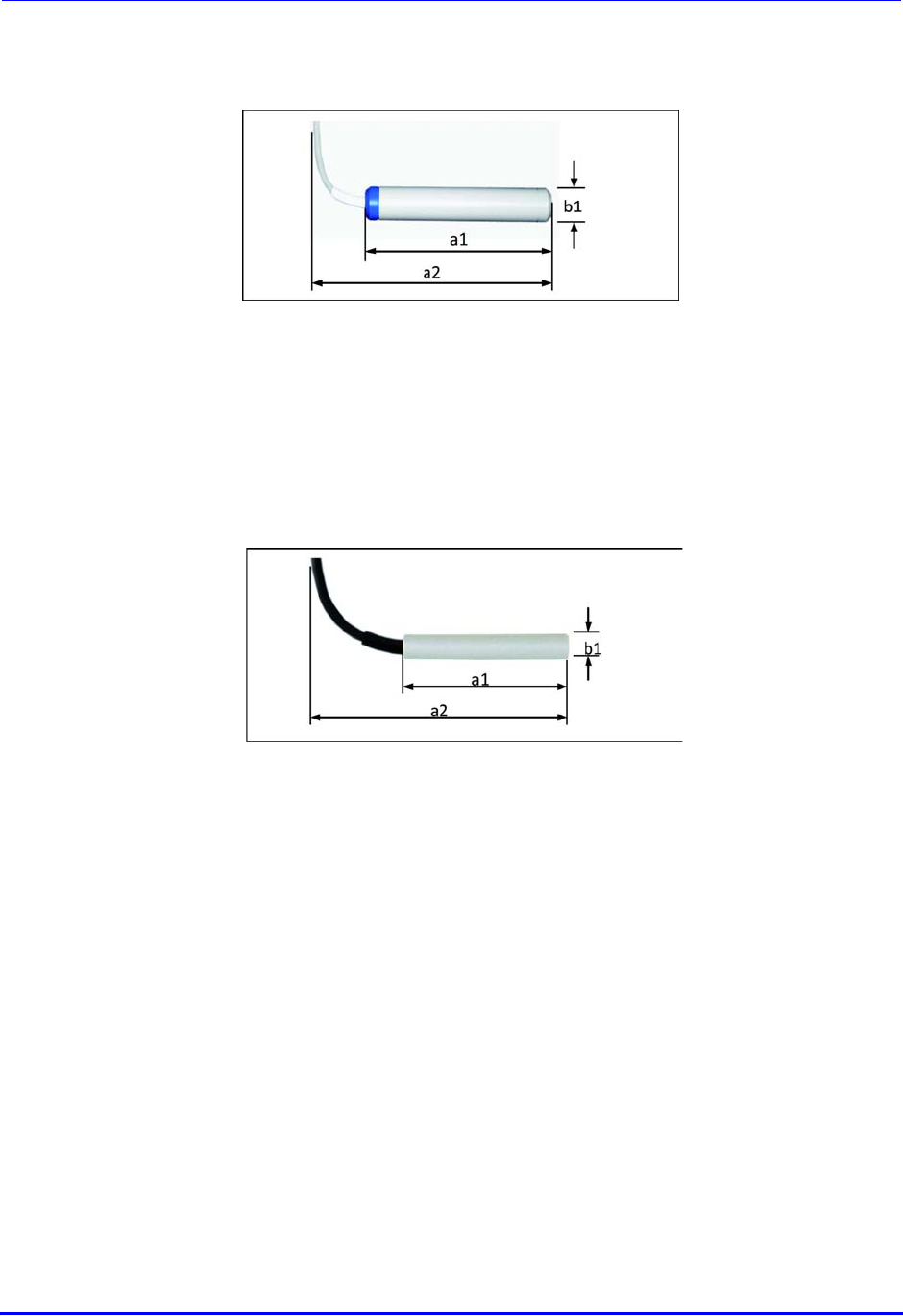
Brooks Automation
34 278580 Revision A
6 Installation LF80C ZeniD RFID Reader
6.5 Antenna Installation Product Manual
6.5.3 Dimensions for Planning
Rod antenna
Mini antenna
a1 Length of antenna cylinder 125 mm
a2 Complete mounting dimensions (cable with 90°
angle)
150 mm
b1 Diameter of antenna cylinder 23.0 mm
a1 Length of antenna cylinder 68 mm
a2 Complete mounting dimensions (cable with 90°
angle)
85 mm
b1 Diameter of antenna cylinder 10.0 mm
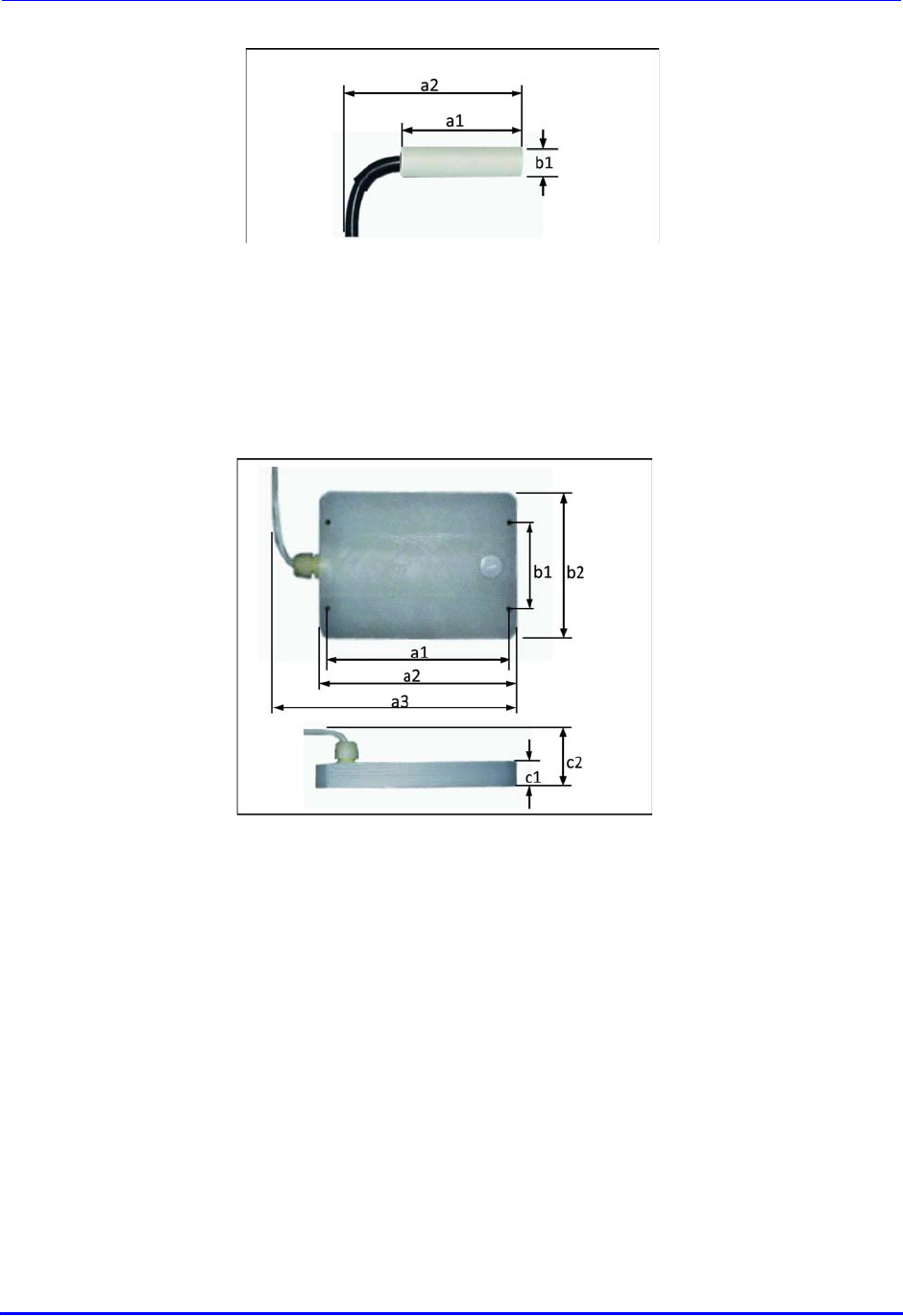
Brooks Automation
278580 Revision A 35
LF80C ZeniD RFID Reader 6 Installation
Product Manual 6.5 Antenna Installation
Micro antenna
Frame antenna
a1 Length of antenna cylinder 40 mm
a2 Complete mounting dimensions (cable with 90°
angle)
60 mm
b1 Diameter of antenna cylinder 10.0 mm
a1 Distance between mounting holes (length) 148 mm
a2 Length of frame antenna 161 mm
a3 Complete mounting dimensions length (cable
screwing at the side)
210 mm
b1 Distance between the mounting holes (width) 70 mm
b2 Width of frame antenna 120 mm
c1 Height of frame antenna 19 mm
c2 Complete mounting dimensions height (cable
screwing at the top)
70 mm
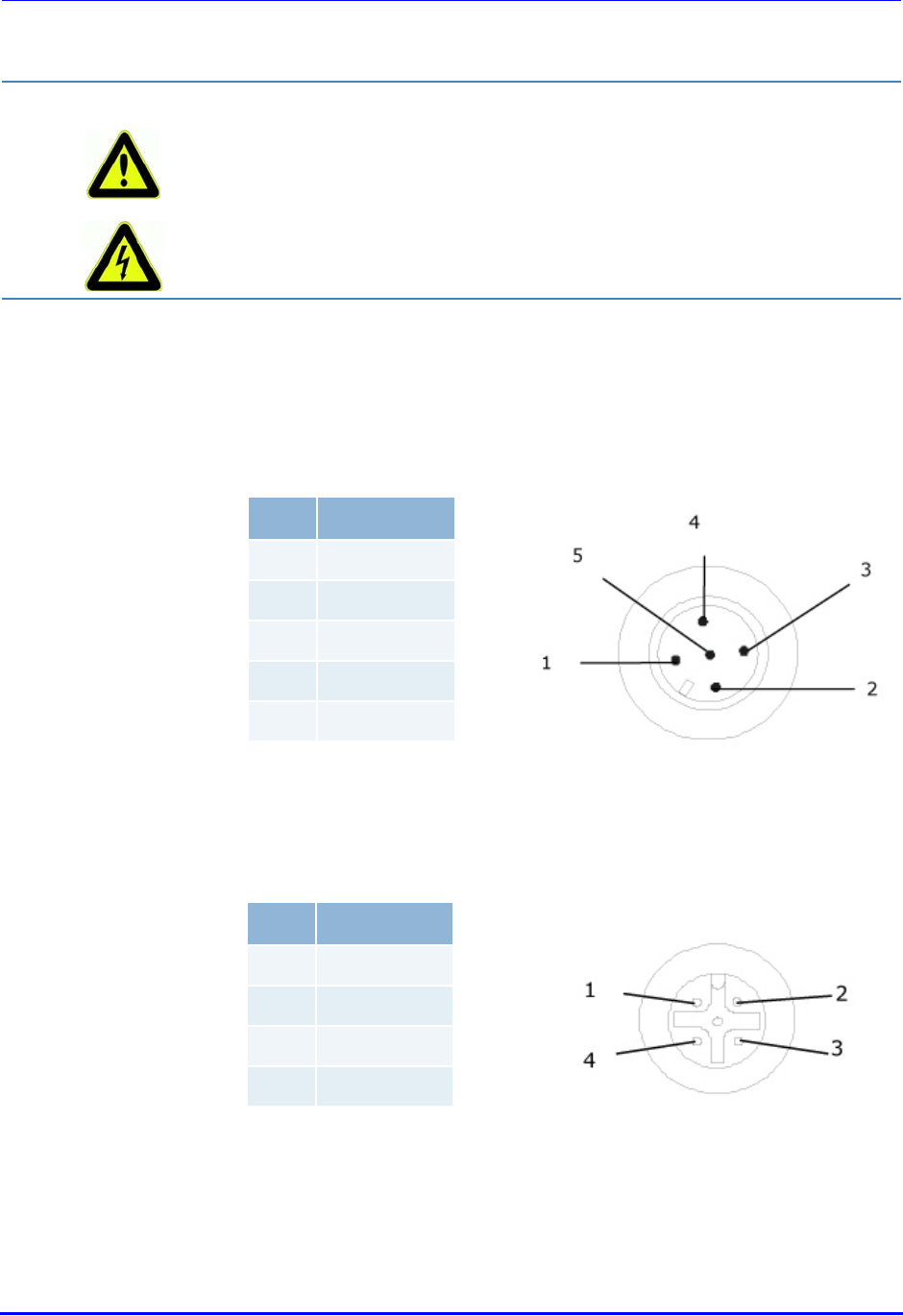
Brooks Automation
36 278580 Revision A
6 Installation LF80C ZeniD RFID Reader
6.6 Power Supply Product Manual
6.6 Power Supply
The device can be connected to an interior DC power circuit of the
equipment or to a DC adapter.
Once the device is connected to the power supply, the power LED lights up.
If the LED does not light up, please refer to chapter
Î
Visit us online:
www.brooks.com.
6.7 Terminal Connection
Ethernet interface (M12 d-coded)
DANGER Risk of death due to dangerous voltage
Risks exist when supplying the device with the incorrect voltage.
Only use cables, plugs and adapters supplied by the manufacturer.
Observe power ratings of the technical data (
Î
Technical Data).
Pin Signal
1+24 V
20 V
3NC
4NC
5NC
PIN DB9
1Tx +
2Rx +
3Tx -
4Rx #
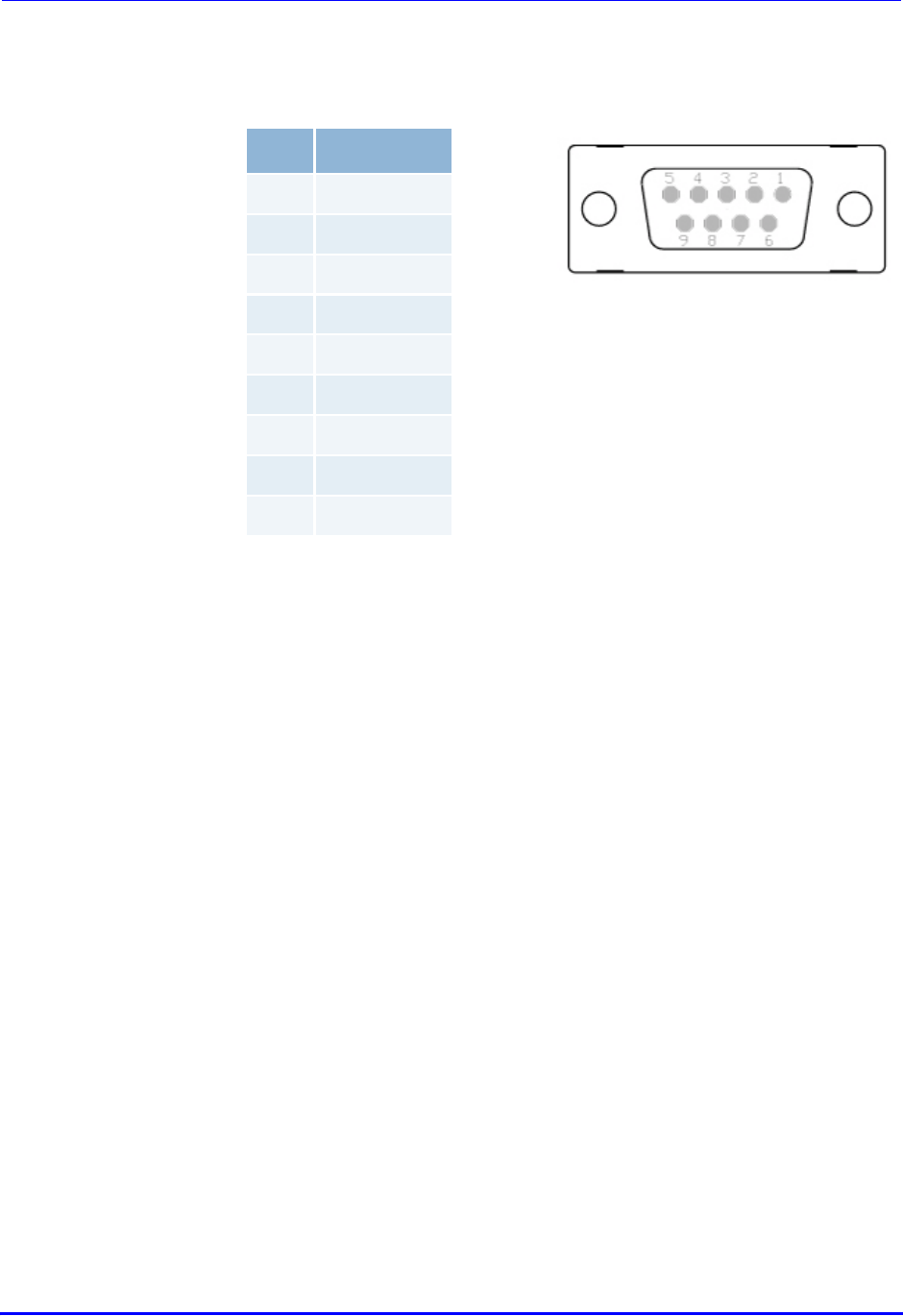
Brooks Automation
278580 Revision A 37
LF80C ZeniD RFID Reader 6 Installation
Product Manual 6.7 Terminal Connection
Sub-D female plug (RS232 interface #2)
The serial interface is a Sub-D female plug (9-pin); a serial connection line
(switched 1:1) can be used.
Parameters of the
serial interface
PIN DB9
1NC
2TxD
3RxD
4NC
5GND
6NC
7NC
8NC
9NC
Baud rate 19,200
Data bits 8
Stopp bit 1
Parity EVEN (ASCII)
NONE (SECS)
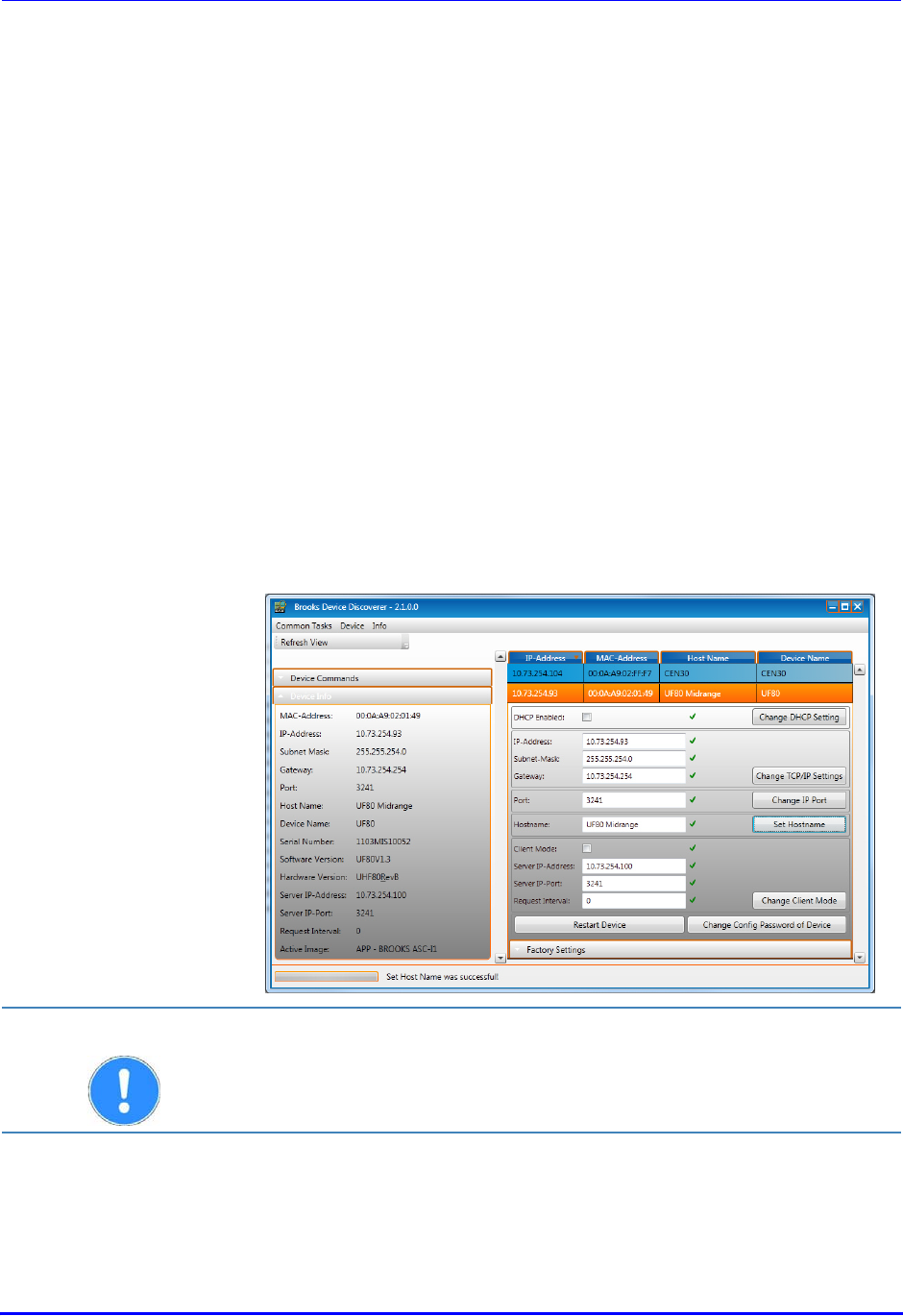
Brooks Automation
38 278580 Revision A
6 Installation LF80C ZeniD RFID Reader
6.8 Ethernet Connection Product Manual
6.8 Ethernet Connection
The 10/100 BaseT Ethernet interface has the following default settings:
DHCP mode OFF
IP address 10.73.254.211
Gateway address 10.73.254.254
Subnet mask 255.255.254.0
If DHCP is enabled and the DHCP Server is not available, the device
initializes the Ethernet connection with the following values:
IP address 169.254.MAC5.MAC6
Gateway 169.254.MAC5.254
Subnet mask 255.255.255.0
Primary DNS Server IP 0.0.0.0
Secondary DNS Server I 0.0.0.0
(MAC address MAC1:MAC2:MAC3:MAC4:MAC5:MAC6)
The Brooks Device Discoverer Tool can be used to find a device in the
network and to change the network settings easily. After sending a
configuration message, the tool requests the device configuration
password. Please enter the default password for Brooks RFID devices:
BROOKS.
The tool can also be used to perform a firmware update!
ATTENTION For more information our extensive download area is available to you at
www.brooks.com -> Service -> Download.
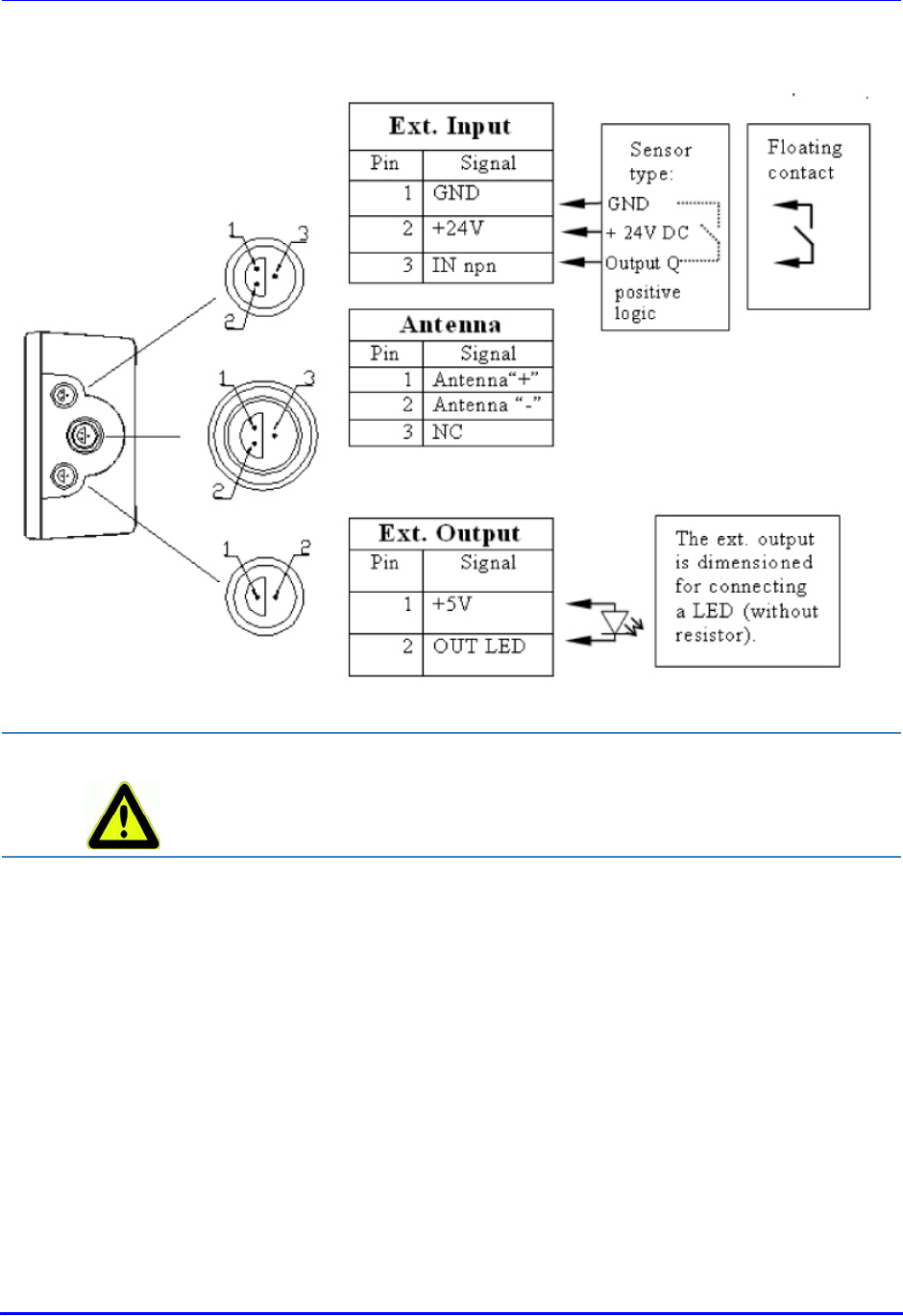
Brooks Automation
278580 Revision A 39
LF80C ZeniD RFID Reader 6 Installation
Product Manual 6.9 External Input and Output
6.9 External Input and Output
ATTENTION External input must be a floating contact. The current consumption of
the sensor must not exceed 200 mA. The LED output current is approx.
10 mA.

Brooks Automation
40 278580 Revision A
6 Installation LF80C ZeniD RFID Reader
6.10 Commissioning Product Manual
6.10 Commissioning
6.10.1 Required Operating Conditions
To operate the reader, the following requirements must be met:
6.10.2 Tuning
Before the reader can be operated, it must be calibrated so that it can
communicate with the transponder.
ÂAn antenna must be connected correctly to the reader.
ÂThe power supply must be connected.
ÂThe transponder must be located within the individual
reading/writing range of the antenna.
ÂA host must be connected to the reader.
ÂPress the Tuning button (see
Î
Indicating and Operating
Elements). The Tuning LED lights up and goes off again. A
flashing LED indicates a malfunction (see
Î
Service and
Troubleshooting).
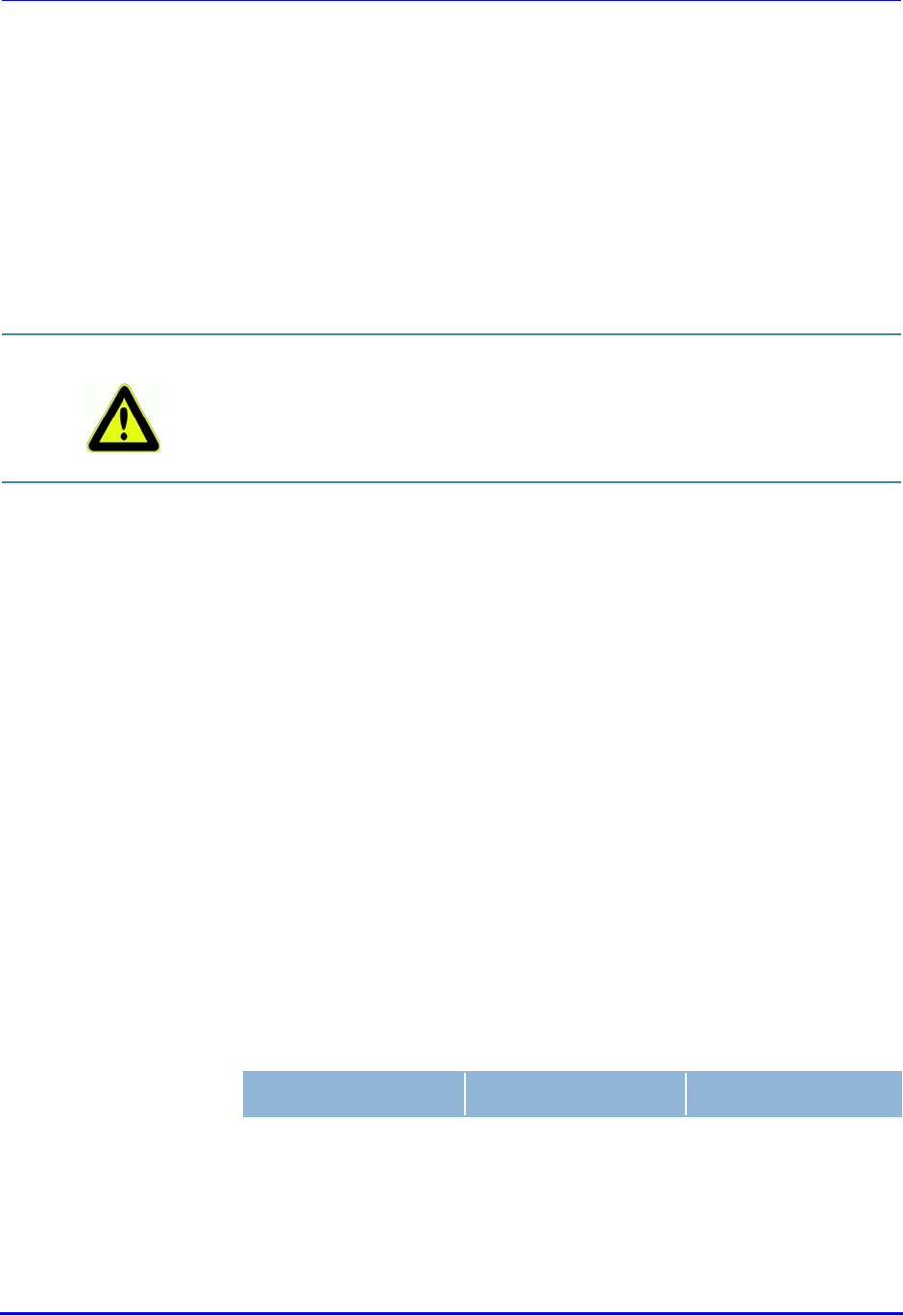
Brooks Automation
278580 Revision A 41
LF80C ZeniD RFID Reader 7 Operation
Product Manual 7.1 Operating Personnel
7Operation
This chapter gives you an overview of the following topics:
Î
Operating Personnel
Î
Operation of the ASC-I1 Protocol
Î
Operation of SECS Protocol
7.1 Operating Personnel
7.2 Operation of the ASC-I1 Protocol
7.2.1 Structure of the Communication Protocol
General remarks:
The communication is done with ASCII packages.
Each reader represents a RFID reader with an RS232 interface to
which an address from 0 to E can be assigned. When the reader is
delivered, the address is 0.
After each command to the reader, a defined response is sent. We
recommend waiting for this response before sending a new
command.
7.2.2 Package Contents
General remarks:
Each package includes a package header (three characters), a message
(two or more characters) and the end of the package (five characters).
CAUTION The RFID Reader LF80C ZeniD is designed to be operated by specially
trained personnel only. If you have doubts about the required
qualifications, contact the manufacturer.
Operating the device without special training can result in damage to the
reader and/or connected devices.
Package header Message End of package
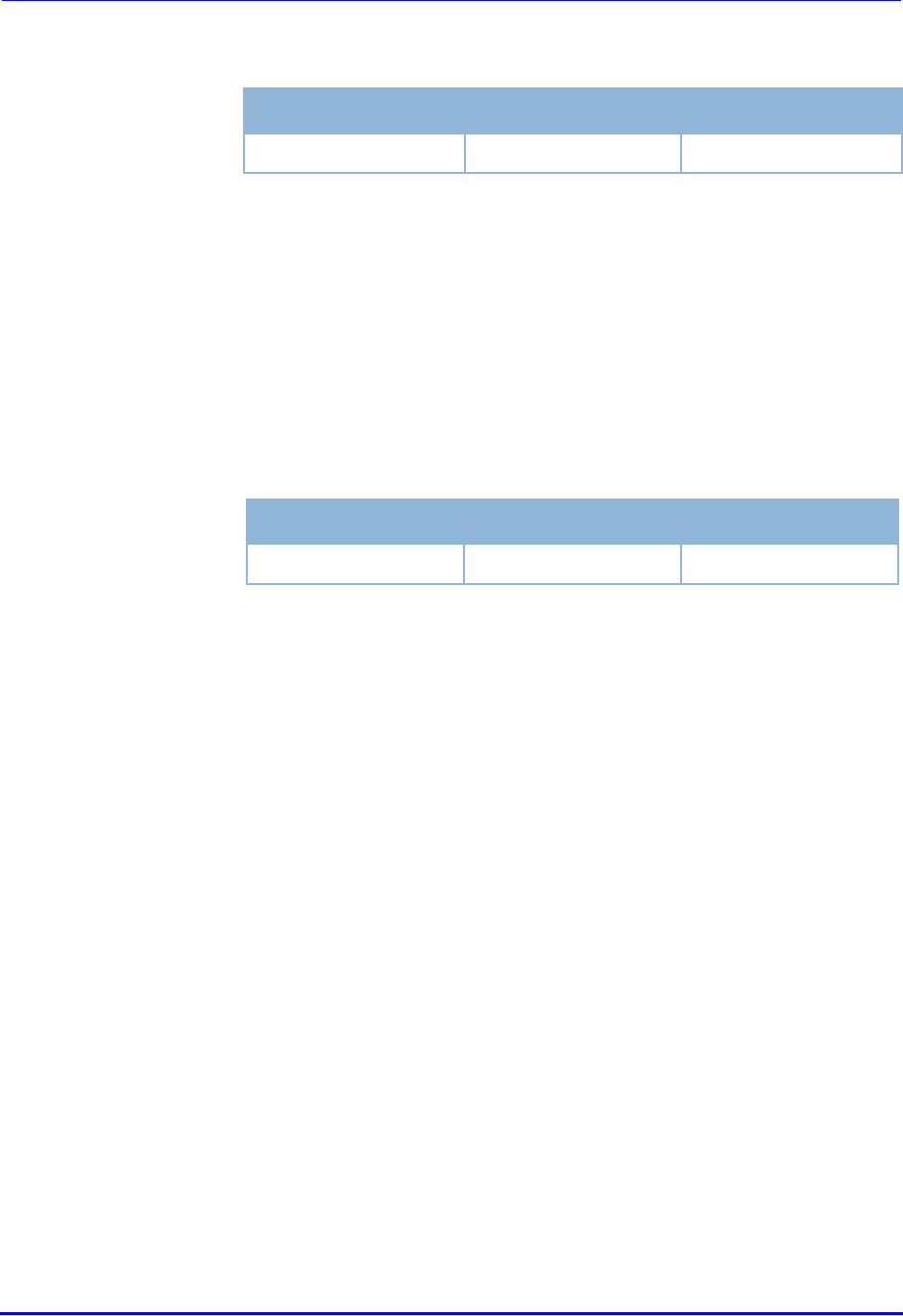
Brooks Automation
42 278580 Revision A
7 Operation LF80C ZeniD RFID Reader
7.2 Operation of the ASC-I1 Protocol Product Manual
Package header The header includes the start character (one character) and the package
length (two characters).
The message length describes the number of characters of a message.
Message structure The message includes a command, a target address and a source address
as well as information.
The message length describes the number of characters of a message.
* The reader is preset with 0 when delivered.
Package header
Start Length 1 Length 2
Start Start character (ASCII character ´S´)
Length 1 High byte package length (hexadecimal)
ASCII character ´0´..´F´
Length 2 Low byte package length (hexadecimal)
ASCII character ´0´..´F´
Message
Command Address Information
Command ASCII character (
Î
Message items)
Address Target/source address;
ASCII character '0'...'E' for the reader *
Information Depends on the command (includes
none, one or more ASCII characters '0'...'F')
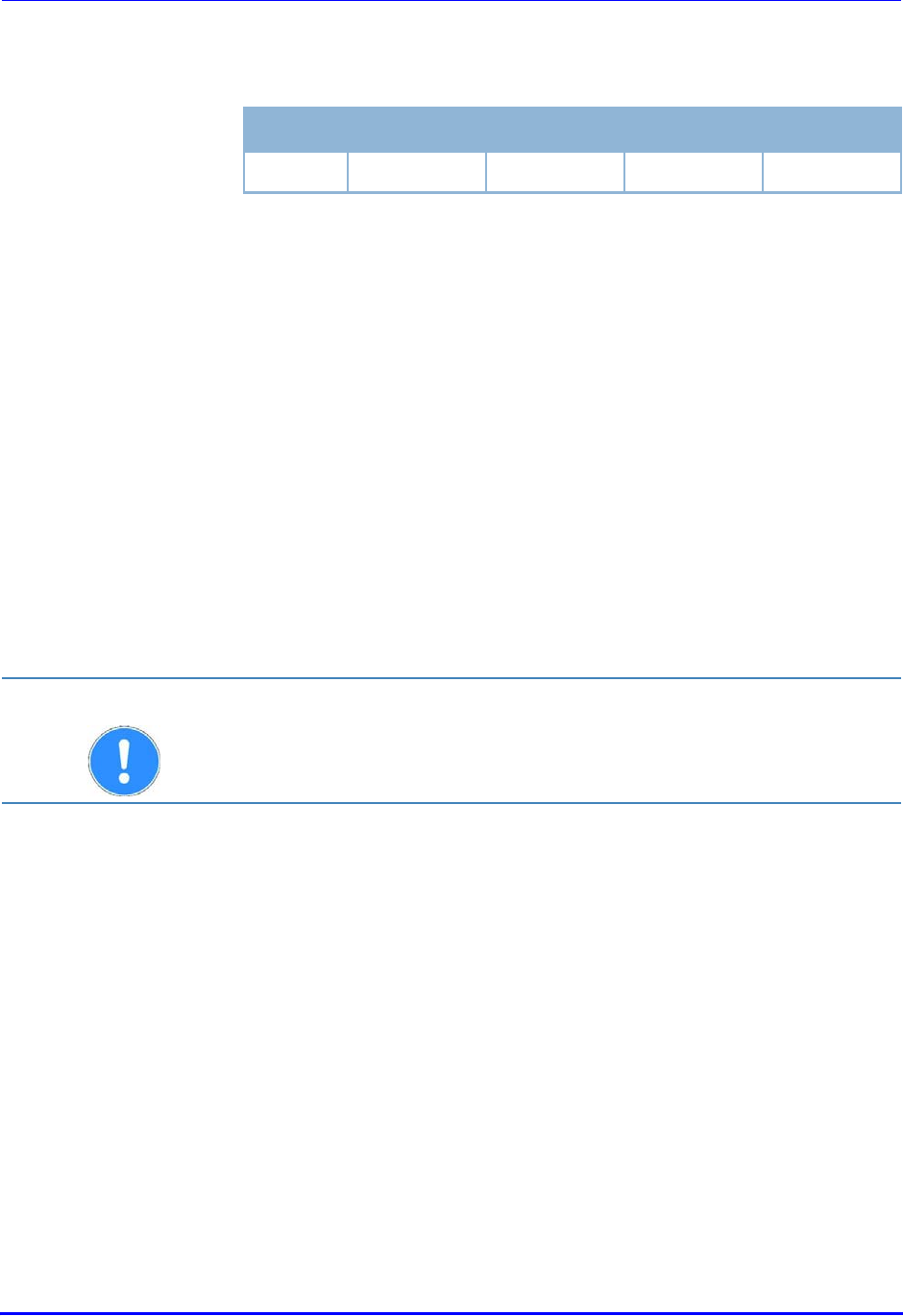
Brooks Automation
278580 Revision A 43
LF80C ZeniD RFID Reader 7 Operation
Product Manual 7.2 Operation of the ASC-I1 Protocol
End of package The end of the package includes an end character (one character) and a
checksum (four characters).
End of package
End Checksum 1 Checksum 2 Checksum 3 Checksum 4
End End character ASCII character no. 13
(hexadecimal 0D)
Checksum 1 High byte - XOR logic of all data (package header,
message and end character);
ASCII '0'..'F'
Checksum 2 Low byte - XOR logic of all data (package header,
message and end character);
ASCII '0'..'F'
Checksum 3 High byte - addition of all data (package header,
message and end character);
ASCII '0'..'F'
Checksum 4 Low byte - addition of all data (package header, message
and end character);
ASCII '0'..'F'
ATTENTION When using the TCP/IP interface option, the checksum is not used (is
not transmitted).

Brooks Automation
44 278580 Revision A
7 Operation LF80C ZeniD RFID Reader
7.2 Operation of the ASC-I1 Protocol Product Manual
7.2.3 Commands of Protocol
Commands
Command Description
X
Î
X - Read data
W
Î
W - Write data
R
Î
R - Automatic read
G
Î
G - Request parameter value
P
Î
P - Set parameter
E
Î
E - Error message
H
Î
H - Heartbeat
V
Î
V - Query software version
L
Î
L - Lock a page of the transponder
I
Î
I - Set tuning of the RF module
J
Î
J - Request tuning settings of RF module
A
Î
A - Sensor event
N
Î
N - Reset
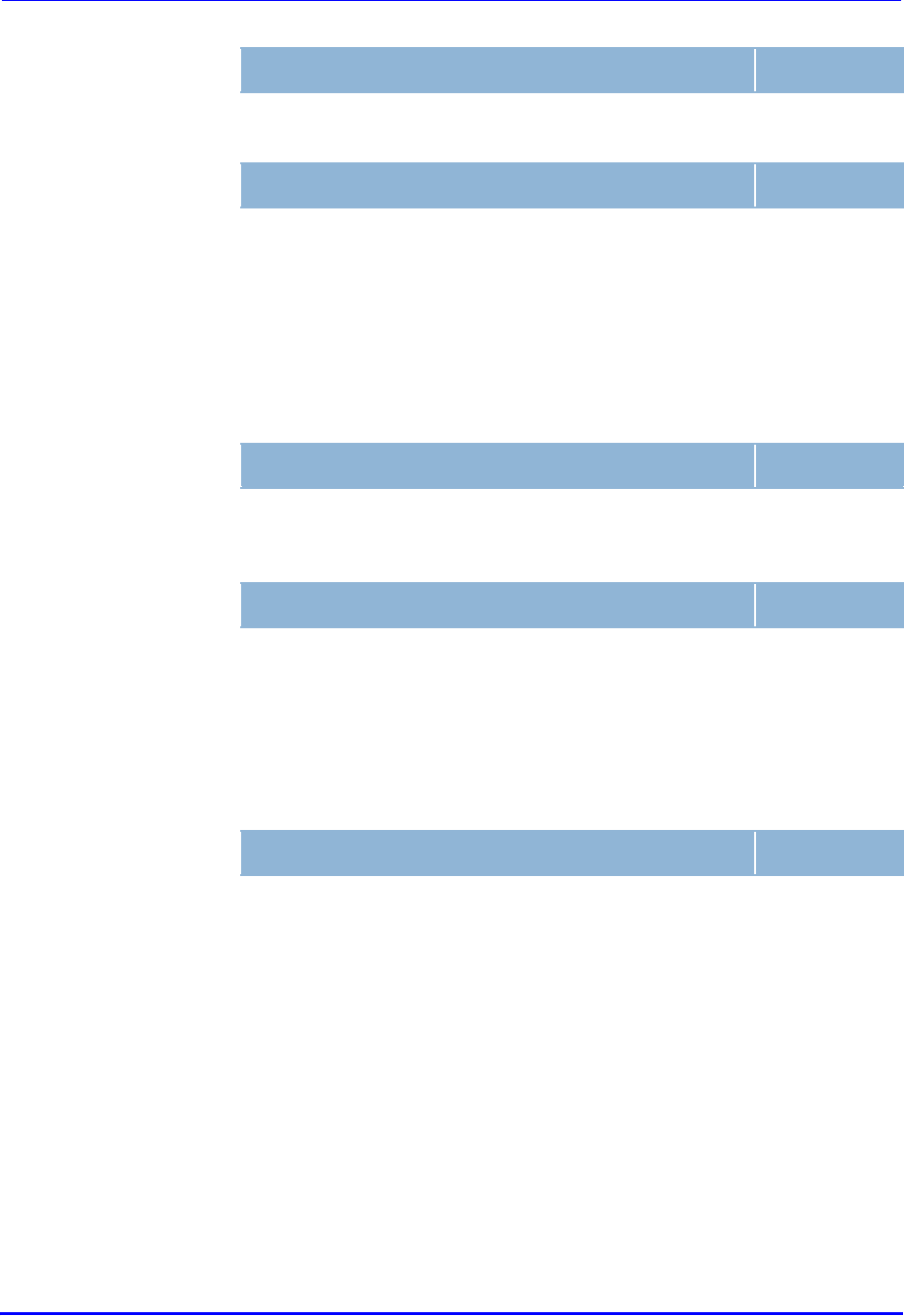
Brooks Automation
278580 Revision A 45
LF80C ZeniD RFID Reader 7 Operation
Product Manual 7.2 Operation of the ASC-I1 Protocol
Message items
Command of the message. See table in chapter
Î
Message items
The data are interpreted in HEX format. That means that 2 ASCII
characters define one byte tag data in HEX format. The data always
contains all 8 bytes of the specified page of the transponder.
Example:
Tag data in ASCII "12345678" (8 bytes)
Tag data in HEX 0x31 0x32 0x33 0x34 0x35 0x36 0x37 0x38
Data in message "3132333435363738" (16 ASCII characters)
For more information on error codes and the corresponding correcting
actions please refer to
Î
Error Codes.
Defines the page of the transponder for a read or write action. The two
ASCII characters (2 bytes) define the page number of the tag in decimal
format.
Example: page 1 → "01"
page 10 →"10"
page 17 →"17"
Number of the parameter. One ASCII character (1 byte) display the
parameter number in hex format.
Example: parameter 1 "1"
CMD 1 byte
Data 16 bytes
Error ID 1 Byte
Page 2 bytes
Parameter No. 1 byte
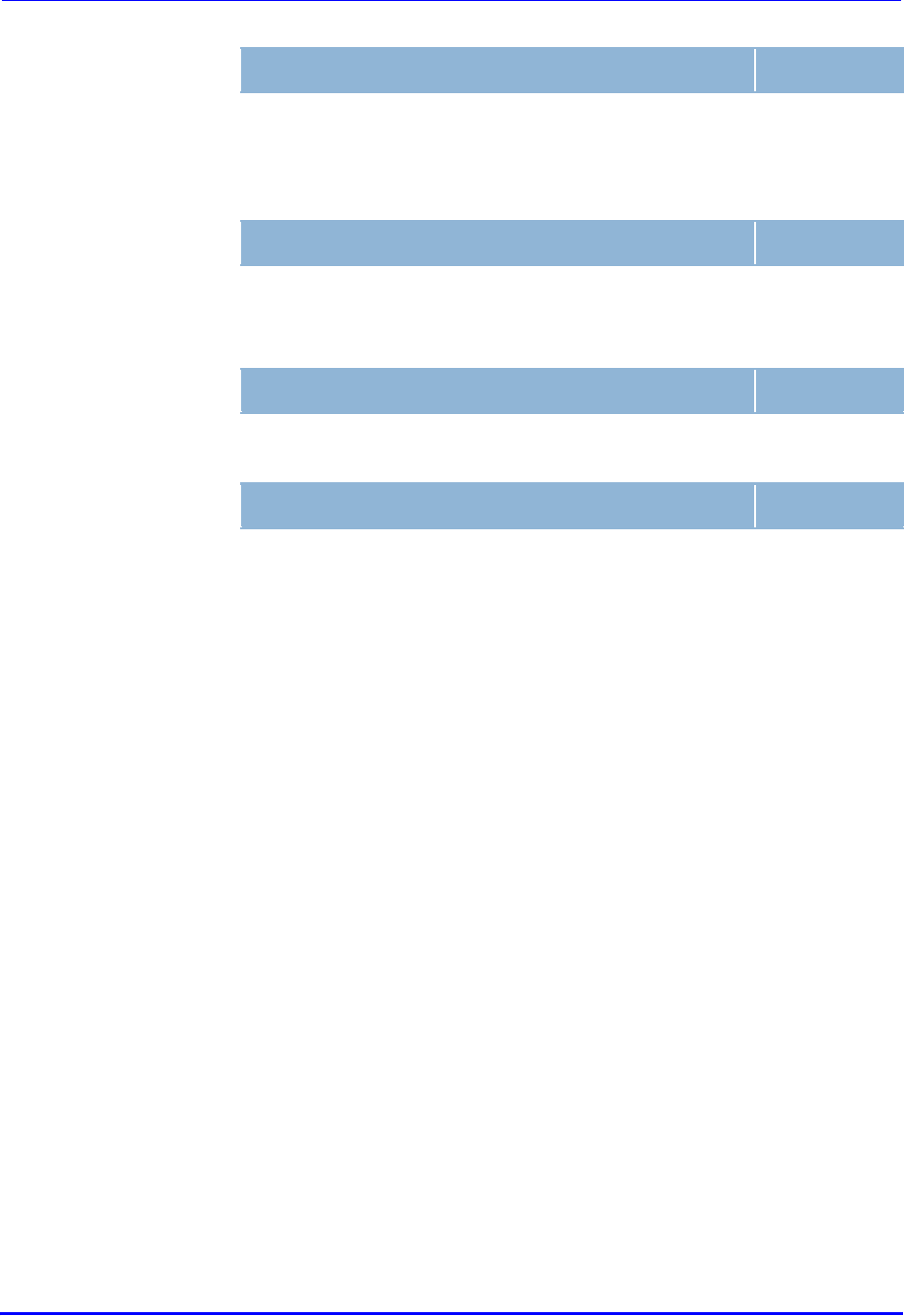
Brooks Automation
46 278580 Revision A
7 Operation LF80C ZeniD RFID Reader
7.2 Operation of the ASC-I1 Protocol Product Manual
Value of a parameter. Two ASCII characters (2 bytes) display the value of
the parameter in decimal format.
Example: value 45 "45"
Address of the device („0“ .. „E)“.
One ASCII character (1 byte) shows the address in HEX format.
This feature is not used for the single reader. This code is always "0000".
Contains the hexadecimal serial number of the reader. This number has 4
ASCII characters. The serial number is also shown on the label of the
reader.
Example: “1234”
The last 5 characters of the complete serial number of the device are
interpreted as decimal number. Converted to hexadecimal, this is the 2 byte
serial number, which is transmitted as 4 ASCII characters.
Example:
The decimal number „1234“ is „3039“ when converted to hexadecimal
format. This number is transmitted as 4 ASCII characters.
Parameter value 2 bytes
Reader ID 1 byte
Response code 4 bytes
Serial No. 4 bytes
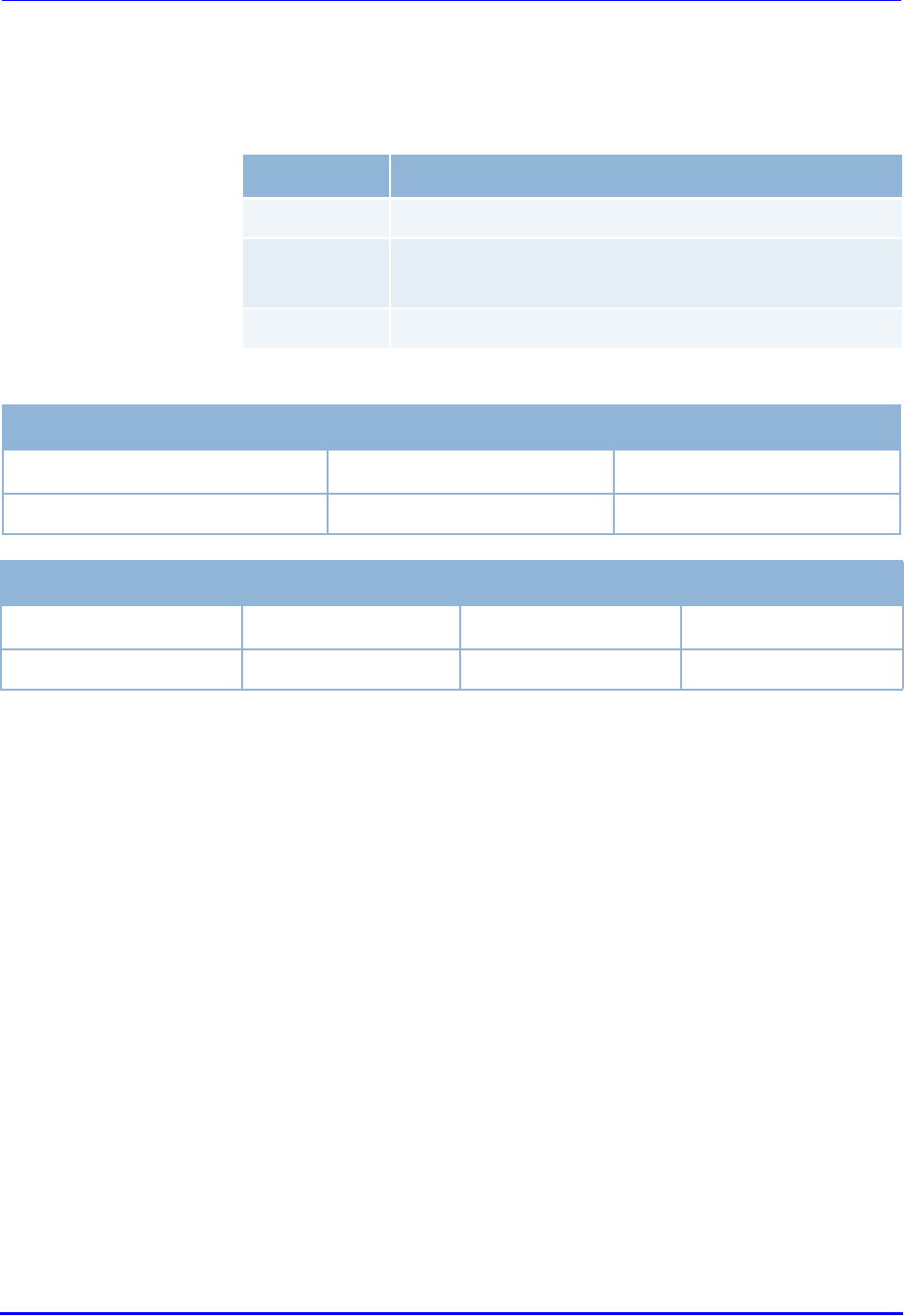
Brooks Automation
278580 Revision A 47
LF80C ZeniD RFID Reader 7 Operation
Product Manual 7.2 Operation of the ASC-I1 Protocol
X - Read data Command X starts the reading of a transponder.
If there is no tag in the reading range of the antenna, the reader returns an
error message (error 4 - no tag).
Data item "Page" can have the following values.
1) 'E' respectively 'F' in ID Bit 0...3 of the reading ID
If there is no tag in the reading range of the antenna, the reader repeats
the reading before an error message is sent out. The number of repeats is
defined in
Î
Parameter 4 (0x04).
No acknowledgment is expected from the host.
In case of a read request for more than one page (value 98 or 99), the
protocol is repeated. For the end of reading the reader sends an additional
package. The message includes the command 'x' and the source address
'0'...'E'.
If the reading fails, the reading is repeated in the defined time frame (
Î
Parameter 3 (0x03);
Î
Parameter 4 (0x04)). If it fails again, the reader
sends an error message 'no tag(4)' to the host.
If the sensor check is activated, the status of a floating contact connected
to the external input is checked before a reading process (writing process)
is triggered. If it is not connected, the error message "NOTAG" is sent;
otherwise the read process is started.
Value Description
'01' to '17’ read page#
’98’ read more pages until end character or empty
character1)
’99’ read entire tag data
Host → Reader
CMD Reader ID Page
X 1 byte 2 bytes
Reader → Host
CMD Reader ID Page Data
x 1 byte 2 bytes 16 bytes

Brooks Automation
48 278580 Revision A
7 Operation LF80C ZeniD RFID Reader
7.2 Operation of the ASC-I1 Protocol Product Manual
W - Write data The command W starts the writing to a transponder.
If there is no tag in the writing range of the antenna, the reader returns an
error message (error 4 - no tag).
If 'write tag' fails, writing is repeated in the defined time frame (
Î
Parameter 3 (0x03);
Î
Parameter 4 (0x04). If it fails again, the reader
sends an error message 'no tag(4)' to the terminal.
If the sensor check is activated, the status of a floating contact connected
to the external input is checked before a reading process (writing process)
is triggered. If it is not connected, the error message "NOTAG" is sent;
otherwise the write process is started.
Host → Reader
CMD Reader ID Page Data
W 1 byte 2 bytes 16 bytes
Reader → Host
CMD Reader ID
w1 byte
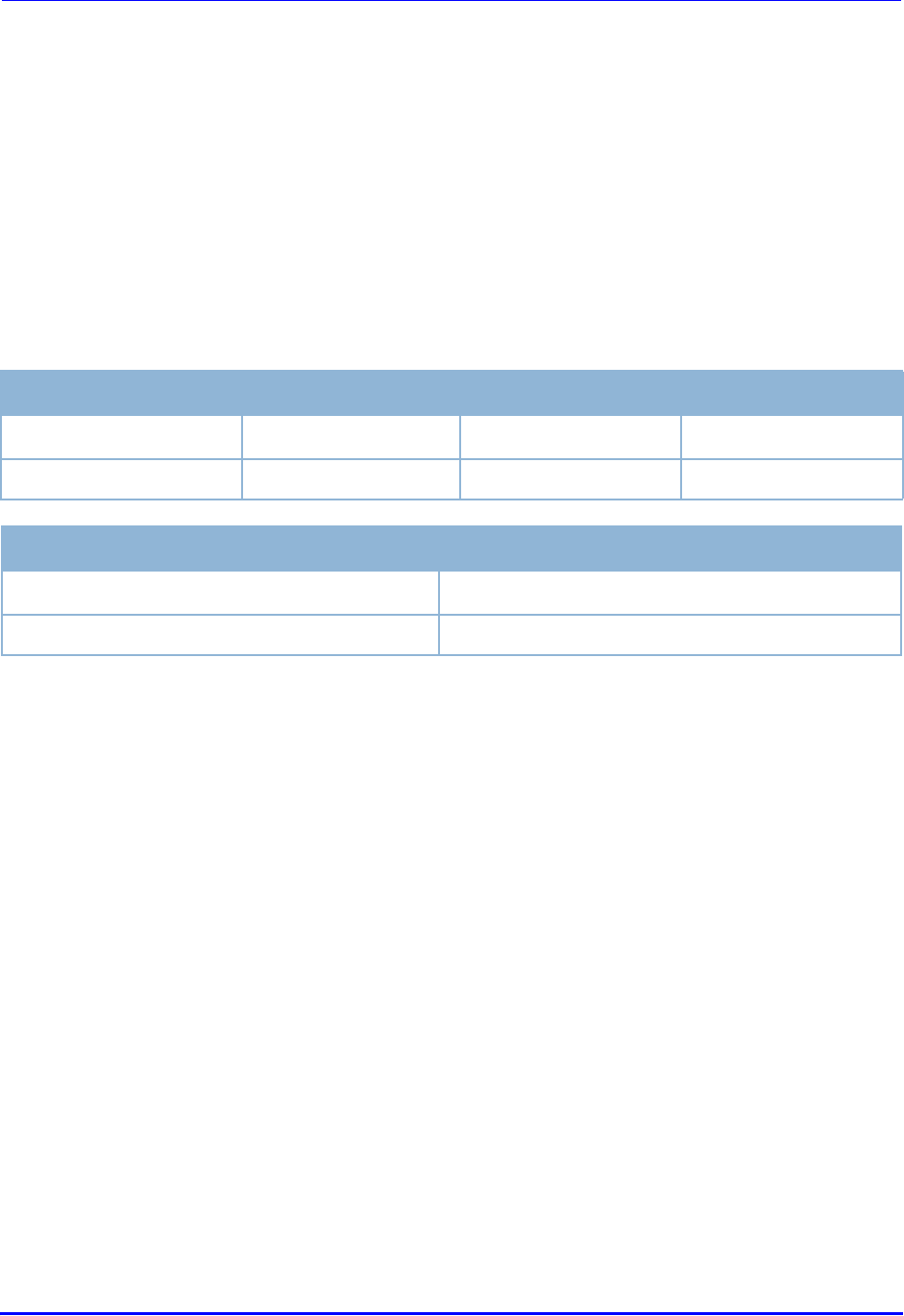
Brooks Automation
278580 Revision A 49
LF80C ZeniD RFID Reader 7 Operation
Product Manual 7.2 Operation of the ASC-I1 Protocol
R - Automatic read The external input is used to trigger an automatic read action. The R
command sends the read data to the host. The host then has to confirm the
message.
Depending on the readmode configuration (parameter 1: readmode), the
reader reads the following pages:
Reading more pages (readmode "tag" or "whole"): protocol is repeated.
The end package includes the command 'R' and the source address '0'...'E'
No acknowledgment from the host: information is repeated with the
following parameters (
Î
Parameter 5 (0x05);
Î
Parameter 6 (0x06))
Reading not possible: repeated read time frame (
Î
Parameter 3 (0x03);
Î
Parameter 4 (0x04)).
Reading again not possible: tag sends error message no tag (4) to the host.
The delay time for the presence sensor is configurable (
Î
Parameter 0
(0x00)).
An automatic reading is only possible if all messages that have to be
confirmed have been confirmed by the previous read, or if the waiting
period (
Î
Parameter 5 (0x05)) has expired after the last sending (
Î
Parameter 6 (0x06)).
If the sensor check is activated, the status of a floating contact connected
to the external input is checked before a reading process (writing process)
is triggered. If it is not connected, the error message “NOTAG” is sent,
otherwise the read-process is started.
readmode =
page (0)
sequential read for different pages (parameter 2:
readpage)
readmode =
tag (1)
read a tag until the end character ('E' - end
character or 'F' empty) in ID bit 0…3
readmode =
whole (2)
read the whole tag (all pages)
Reader → Host
CMD Reader ID Page Data
R 1 byte 2 bytes 16 bytes
Host → Reader
CMD Reader ID
r1 byte

Brooks Automation
50 278580 Revision A
7 Operation LF80C ZeniD RFID Reader
7.2 Operation of the ASC-I1 Protocol Product Manual
G - Request
parameter value
The command G is used to request the value of all public parameters of the
device.
The reader sends an individual protocol package for each available public
parameter. After the last parameter the reader finally sends an additional
package. The message includes the command 'g' and the source address
'0'..'E'.
Host → Reader
CMD Reader ID
G1 byte
Reader → Host
CMD Reader ID Parameter No. Parameter value
g 1 byte 1 byte 2 bytes

Brooks Automation
278580 Revision A 51
LF80C ZeniD RFID Reader 7 Operation
Product Manual 7.2 Operation of the ASC-I1 Protocol
P - Set parameter Command P can be used to change the value of individual parameters.
After successfully changing a parameter, the device sends a confirmation
message.
Host → Reader
CMD Reader ID Parameter No. Parameter value
P 1 byte 1 byte 2 bytes
Reader → Host
CMD Reader ID
p1 byte

Brooks Automation
52 278580 Revision A
7 Operation LF80C ZeniD RFID Reader
7.2 Operation of the ASC-I1 Protocol Product Manual
E - Error message If an error occurs, the device sends an error message with the
corresponding error code to the host.
For more information on error codes and the corresponding correcting
actions please refer to
Î
Error Codes.
Reader → Host
CMD Reader ID Error ID
e 1 byte 1 byte

Brooks Automation
278580 Revision A 53
LF80C ZeniD RFID Reader 7 Operation
Product Manual 7.2 Operation of the ASC-I1 Protocol
H - Heartbeat The command H sends a heartbeat request to the reader. The reader
responds with his serial number and a response code.
The response code is part of the protocol but is not used for this device. The
response code is always '0000'.
Because of compatibility with other systems, the heartbeat is also allowed
with the address 'F'.
Host → Reader
CMD Reader ID
H1 byte
Reader → Host
CMD Reader ID Serial No. Response code
h 1 byte 4 bytes 4 bytes

Brooks Automation
54 278580 Revision A
7 Operation LF80C ZeniD RFID Reader
7.2 Operation of the ASC-I1 Protocol Product Manual
V - Query software
version
The command V is used to request the installed software version of the
RFID reader.
The 8 characters of the software version are described by 16 ASCII
characters. Each character is described in HEX format represented by 2
ASCII characters (see section
Î
Message Examples).
Host → Reader
CMD Reader ID
V1 byte
Reader → Host
CMD Reader ID Software version
v 1 byte 16 bytes
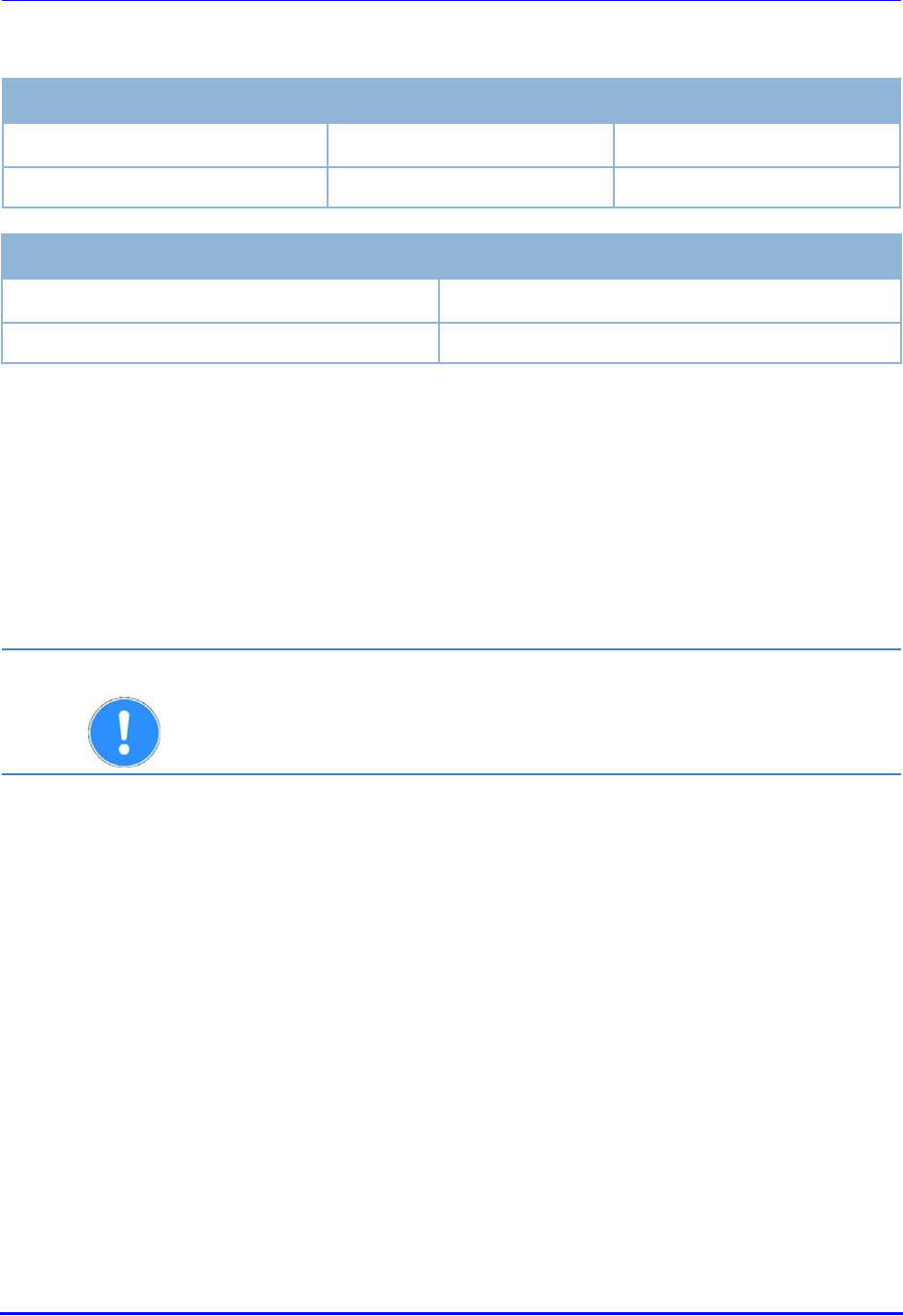
Brooks Automation
278580 Revision A 55
LF80C ZeniD RFID Reader 7 Operation
Product Manual 7.2 Operation of the ASC-I1 Protocol
L - Lock a page of the
transponder
An individual page of a multipage transponder can be locked (read only).
If the page of the transponder could not be locked, the writing action is
repeated automatically (
Î
Parameter 3 (0x03) and
Î
Parameter 4 (0x04)).
If the page still could not be locked, an error message NoTag (4) is sent to
the host. If the page was already locked, the successful feedback follows
just as at the first locking.
If the sensor check is activated, the status of a floating contact connected
to the external input is checked before a reading process (writing process)
is triggered. If the sensor is not triggered, the error message "NOTAG" is
sent; otherwise the lock process is started.
Host → Reader
CMD Reader ID Page
L 1 byte 2 bytes
Reader → Host
CMD Reader ID
l1 byte
ATTENTION A locked page cannot be unlocked. This page is locked permanently.
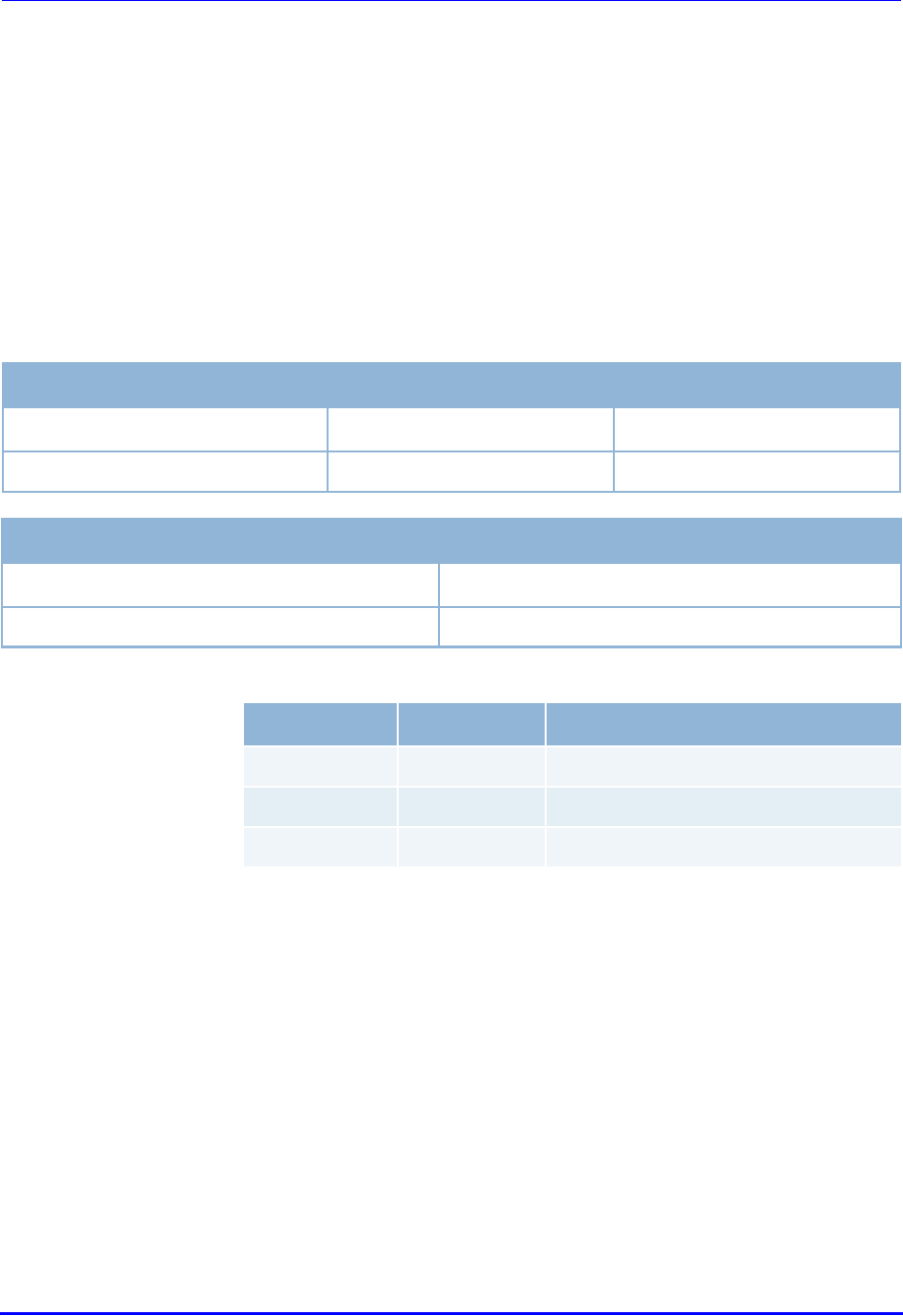
Brooks Automation
56 278580 Revision A
7 Operation LF80C ZeniD RFID Reader
7.2 Operation of the ASC-I1 Protocol Product Manual
I - Set tuning of the
RF module
Depending on the surroundings of the antenna it might be necessary to
tune the RF module to get the optimal reading/writing range for this special
installation environment. The RF module has 6 capacitors C0 - C5 which can
be switched ON or OFF.
Each capacitor can be addressed by one bit. This bit is used to activate (1)
or disable (2) a capacitor.
The tuning can be set manually (not recommended) or automatic tuning
can be performed (recommended).
0 - OFF
1 - ON
Bit 20 corresponds to capacitor C0.
Parameter structure from C0 to C5:
For the calibration of the antenna exclusively the automatic calibration
(calibration value 0x04) should be used as in this case the antenna sends
and receives optimally, that means with maximal range.
For special cases (for example reading and writing range shall be reduced)
it can be necessary that the efficiency of the antenna has to be reduced by
connecting or disconnecting single capacitors. But this should be carried out
only by qualified staff.
If no reasonable calibration was found, the error "5 - Invalid" is sent instead
of the confirmation, and all capacitors are switched ON.
Host → Reader
CMD Reader ID Tuning
I 1 byte 2 bytes
Reader → Host
CMD Reader ID
i1 byte
Hex. value Bin. value Meaning
00 0000 0000 no capacitor is set
3F 0011 1111 all 6 capacitors are set
40 0100 0000 starts the automatic tuning
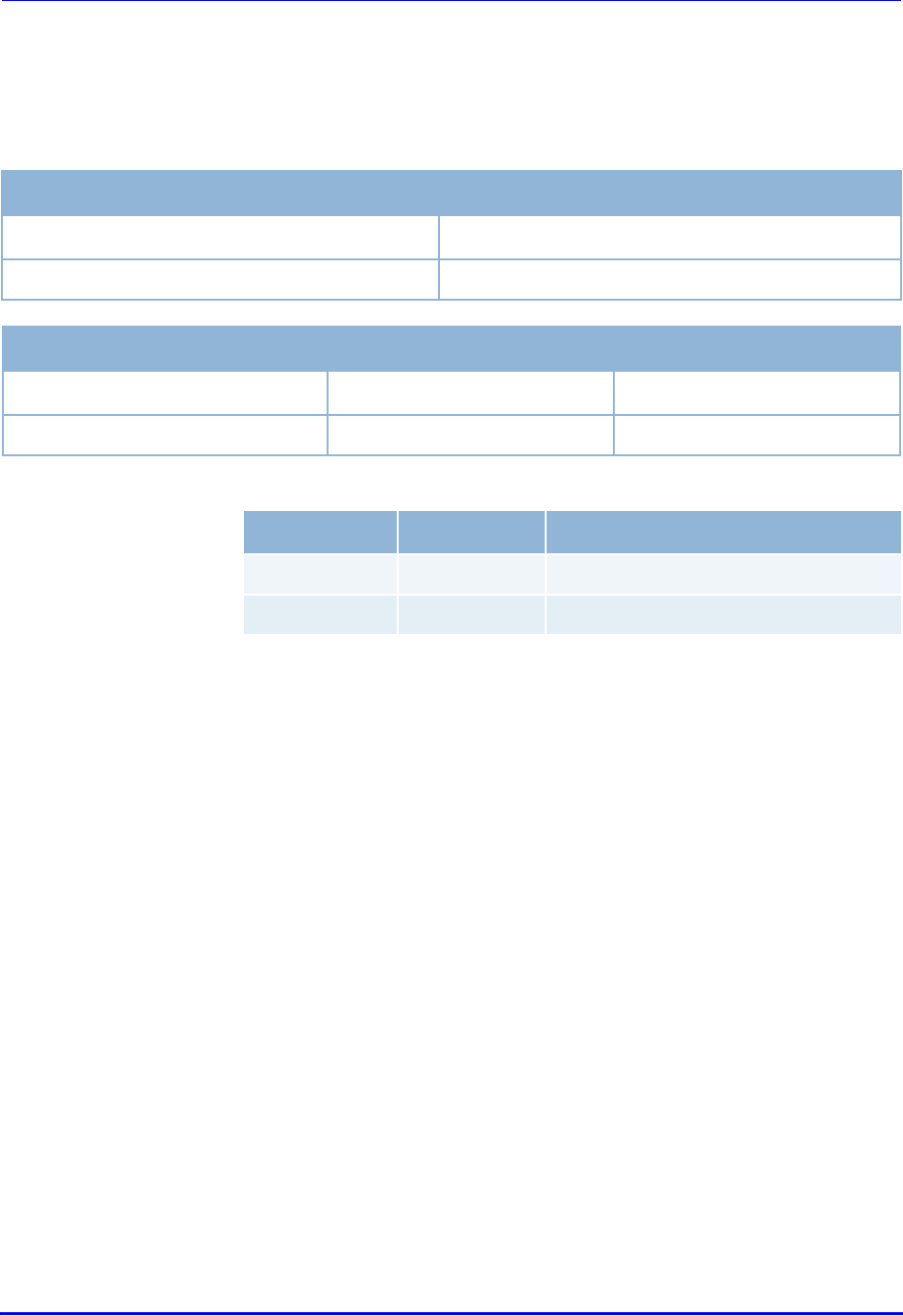
Brooks Automation
278580 Revision A 57
LF80C ZeniD RFID Reader 7 Operation
Product Manual 7.2 Operation of the ASC-I1 Protocol
J - Request tuning
settings of RF
module
Command J requests the current setting of the tuning capacitors. The
response message contains the current status of the capacitors in
hexadecimal format.
Each capacitor can be addressed by one bit. This bit is used to activate (1)
or disable (2) a capacitor.
Parameter structure from C0 to C5:
Host → Reader
CMD Reader ID
J1 byte
Reader → Host
CMD Reader ID Tuning
j 1 byte 2 bytes
Hex. value Bin. value Meaning
00 0000 0000 no capacitor is set
3F 0011 1111 all capacitors are set

Brooks Automation
58 278580 Revision A
7 Operation LF80C ZeniD RFID Reader
7.2 Operation of the ASC-I1 Protocol Product Manual
A - Sensor event If
Î
Parameter 7 (0x07) is activated ('01'), the reader reports the release
event of the external sensor. The event message must be confirmed by the
host.
If the host does not send an acknowledge message, the message is
repeated (
Î
Parameter 6 (0x06)) in the defined time frame (
Î
Parameter 5
(0x05)).
Reader → Host
CMD Reader ID
A1 byte
Host → Reader
CMD Reader ID
a1 byte

Brooks Automation
278580 Revision A 59
LF80C ZeniD RFID Reader 7 Operation
Product Manual 7.2 Operation of the ASC-I1 Protocol
N - Reset The command N performs a reset of the reader hardware and software.
After the reset the device sends a confirmation message.
If the power to the device has been turned on (hardware reset), the host is
informed about it (RS232 interface only).
Host → Reader
CMD Reader ID
N1 byte
Reader → Host
CMD Reader ID
n1 byte

Brooks Automation
60 278580 Revision A
7 Operation LF80C ZeniD RFID Reader
7.2 Operation of the ASC-I1 Protocol Product Manual
7.2.4 Parameter
Parameter 0 (0x00) Sensor delay
Operation delay for the presence sensor.
01 .. 99 (0.1 seconds)
Default: 10 (1s)
Parameter 1 (0x01) Read mode
Readmode for automatic read triggered by external input.
00 - read only one page
01 - read until end character or empty character2)
02 - read all pages
10 - read only one page with sensor check first1)
11 - read until end/empty character with sensor check first1) 2)
12 - read all pages with sensor check first1)
99 - deactivate sensor
1) If the sensor check is activated, the status of a floating contact
connected to the external input is checked before a reading process
(writing process) is triggered. If it is not connected, the error message
"NOTAG" is sent, otherwise the read respectively write process is started.
2) 'E' respectively 'F' in ID Bit 0...3 of the reading ID
Default: 00 (read only one page)
Parameter 2 (0x02) Read page
Page for readmode "00".
01 .. 17 - Page of multipage transponder
Default: 01 (page 1 of multipage transponder)
Parameter 3 (0x03) r/w repeat time
No. (dec.) No. (hex) Parameter name
00x00
Î
Sensor delay
10x01
Î
Read mode
20x02
Î
Read page
30x03
Î
r/w repeat time
40x04
Î
r/w max repeat
50x05
Î
RS232 repeat time
60x06
Î
RS232 max repeat
70x07
Î
Watch port
F
Î
Reader address

Brooks Automation
278580 Revision A 61
LF80C ZeniD RFID Reader 7 Operation
Product Manual 7.2 Operation of the ASC-I1 Protocol
Time between two read or write attempts.
01 .. 99 (0.1 s)
Default: 05 (0.5 s)
Parameter 4 (0x04) r/w max repeat
Maximum number of read/write attempts.
01 .. 99
Default: 05
Parameter 5 (0x05) RS232 repeat time
In case no confirmation message from the host was received, the device
waits this time before sending again the message to be confirmed. The
number of repeats is defined in
Î
Parameter 6 (0x06).
01.. 99 (0.1 s)
Default: 45 (4.5 s)
Parameter 6 (0x06) RS232 max repeat
If the host does not send the expected confirmation message, the device
repeats the message according the value of this parameter. After that, an
error message is sent.
00 - never ending
01 .. 99 - number of attempts
Default: 3
Parameter 7 (0x07) Watch port
Enables/disables the event message to the host that the floating contact
(external input) was opened.
00 - not activated (no event message)
01 - activated
Default: 1
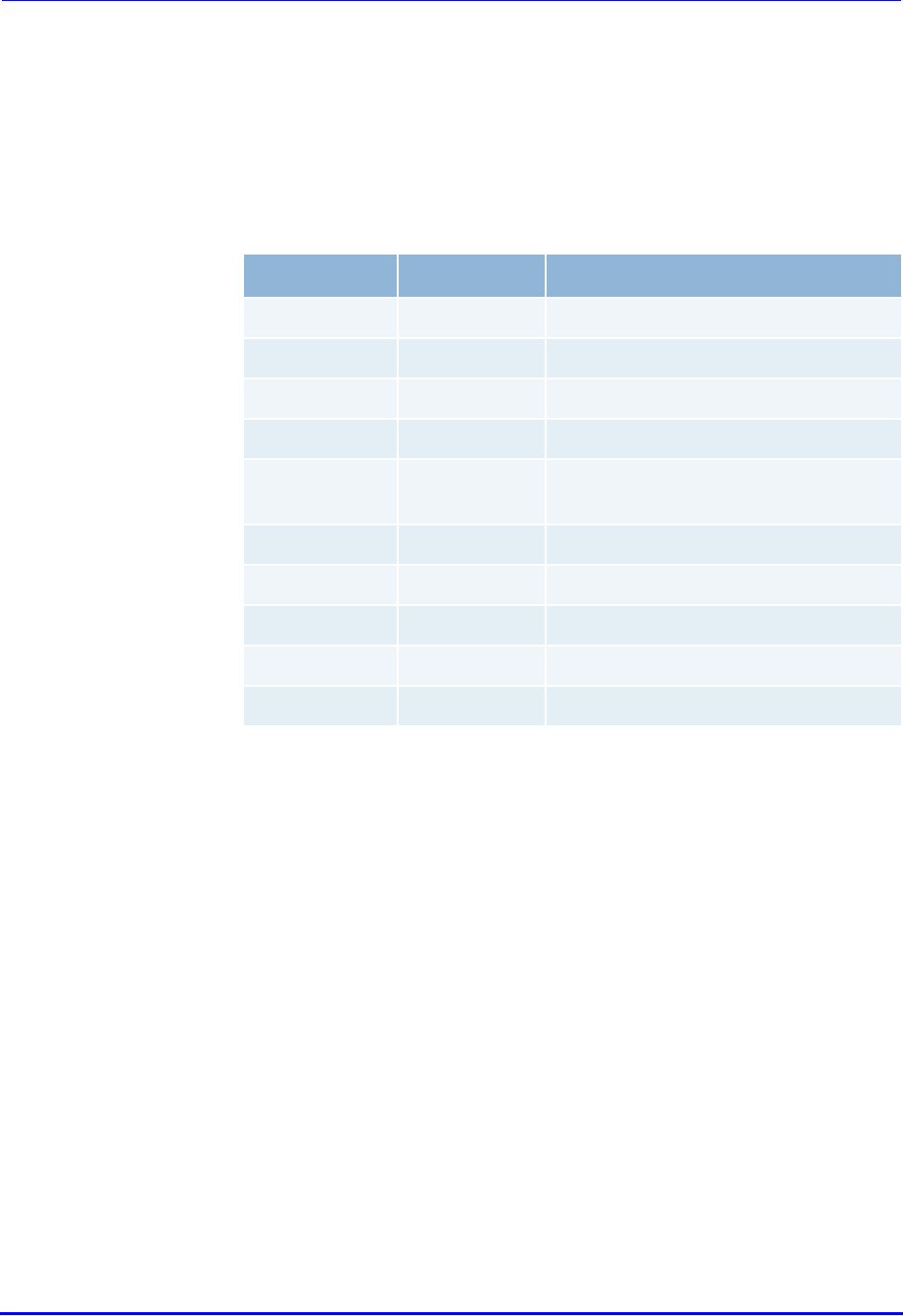
Brooks Automation
62 278580 Revision A
7 Operation LF80C ZeniD RFID Reader
7.2 Operation of the ASC-I1 Protocol Product Manual
Parameter F Reader address
ReaderID or address of the device.
0 .. E
Default: 0
7.2.5 Message Examples
Calculation for the XOR checksum:
53 XOR 30 XOR 32 XOR 48 XOR 30 XOR 0D = 24 → '2' '4'
Calculation for the addition checksum:
53 + 30 + 32 + 48 + 30 + 0D = 13A
Only low significant bytes are used: → 3A → '3' 'A'
X - Read data (read page 1 of multipage transponder)
>> X001
<< x0013232323232323232
Command X
Reader ID 0
Page 01
Data '3232323232323232' → ASCII "22222222"
ASCII HEX Description
’S’ 53 start character
’0’ 30 high byte message length
’2’ 32 low byte message length
’H’ 48 first character message: value
’0’ 30 second character message: target
address
CR 0D end character
’2’ 32 high byte checksum XOR
’4’ 34 low byte checksum XOR
’3’ 33 high byte checksum addition
’A’ 41 low byte checksum addition

Brooks Automation
278580 Revision A 63
LF80C ZeniD RFID Reader 7 Operation
Product Manual 7.3 Operation of SECS Protocol
W - Write data (write to page 1 of multipage transponder)
>> W0013132333435363738
<< w0
Command W
Reader ID 0
Page 01
Data '3132333435363738' → ASCII "12345678"
R - Automatic reading
<< R0013132333435363738
>> r0
Command R
Reader ID 0
Page 01
Data '3132333435363738' → ASCII "12345678"
V - Request software version
>> V0
<< v0524956352E302E30
Command V
Reader ID 0
Software Version '524956352E302E30' → ASCII "RIV5.0.0"
7.3 Operation of SECS Protocol
7.3.1 Introduction
The SECS-I standard defines a communication interface that is suitable for
exchanging messages between semiconductor processing equipment and a
host. A host is a computer or network of computers that exchanges
information with the equipment to perform/execute the production.
The standard does not define the data contained within a message. The
meaning of messages must be determined through a message contents
standard such as SEMI Equipment Communication Standard E5 (SECS-II).
This standard provides the means for independent manufacturers to
produce equipment and hosts that can be connected without requiring
specific knowledge of each other.
The SECS-I protocol can be seen as a layered protocol used for point-to-
point communication. The layers within SECS-I are the physical link, the
block transfer protocol and the message protocol.
The standard is not intended to meet the communication needs of all
possible applications. For example, the speed of RS232 may be insufficient
to meet the needs of transferring mass amounts of data or programs in a

Brooks Automation
64 278580 Revision A
7 Operation LF80C ZeniD RFID Reader
7.3 Operation of SECS Protocol Product Manual
short period, such as may be required for high-speed functional test
applications.
In a network, the roles of host and equipment may be assumed by any
party of the network. In this situation, one end of the communications link
must assume the role of the equipment and the other the role of the host.
Electronic Industries Association Standards:
EIA RS-232-C Interface between Data Terminal Equipment and Data
Communication Equipment Employing Serial Binary Data Interchange.
7.3.2 SECS-I Implementation
This message set describes the communication between a SECS-I reader
and a host. The host and the RFID reader communicate via an RS232
interface (SECS-I).
Character structure Data is transmitted or received in a serial bit stream of 10 bits per
character at one of the specified data rates. The standard character has one
start bit (0), 8 data bits and one stop bit (1). All bit transmissions are of the
same duration.
SECS-I performs no parity or other verification of the individual bytes.
Block transfer
protocol
The gateway uses an interpretation of SECS-I by a serial transport layer.
The following are some points to note about this implementation.
Master-Slave The host connects to the reader. If there is a conflict, the host "gives in"
(i.e. receives before sending).
In the course of communication, the reader takes on the role of the master
and the host takes on the role of the slave.
Control characters The four standard handshake codes used in the block transfer protocol are
displayed in the table below.
<ENQ> 0x05 Request to send
<EOT> 0x04 Ready to receive
<ACK> 0x06 Correct reception
<NAK> 0x15 Incorrect reception

Brooks Automation
278580 Revision A 65
LF80C ZeniD RFID Reader 7 Operation
Product Manual 7.3 Operation of SECS Protocol
Message block
structure
SECS message blocks have the following form:
The operation of all communication functions above the block transfer
protocol is linked in information contained in a 10-byte data element, called
the header.
The header is always the first 10 bytes of every block sent by the block
transfer protocol.
The length includes all bytes sent after the length byte, excluding the two
checksum bytes. The maximum block length allowed by SECS-I is 254
bytes and the minimum is 10 bytes.
The reverse bit (R bit) signifies the direction of a message. The R-bit
(msb) is set to 0 for messages to the equipment and to 1 for messages to
the host.
The device ID is a definite number to contact the reader.
The device ID consists of the 8-bit gateway ID (bit 0 - bit 7), which is
identical with the last two characters of the reader's serial number, and a 5-
bit fixed reader number
(bit 8 - bit 14 = 0x01).
Of course, the ID can be changed within the valid scope.
Byte msb Description
Length 0 Length without checksum, 10 - 254
Header
1 R Upper device ID (Reader ID)
2 Lower device ID (Gateway ID)
3 W Upper message ID (Stream)
4 Lower message ID (Function)
5 E Upper block number
6 Lower block number
System
bytes
7 System byte 1
8 System byte 2
9 System byte 3
10 System byte 4
Text 11 - 254 Message text, user data
Checksum 255, 256 16-bit unsigned checksum

Brooks Automation
66 278580 Revision A
7 Operation LF80C ZeniD RFID Reader
7.3 Operation of SECS Protocol Product Manual
Direction reader to host 0x81xx *
Direction Host to equipment (reader) 0x01xx *
* The serial number is located on a label on the reader.
The W bit indicates that the sender of a primary message expects a reply. A
value of 1 in the W bit means that a reply is expected.
The message ID identifies the format and content of the message being
sent.
A primary message is defined as any odd-numbered message.
A secondary message is defined as any even-numbered message.
The end bit determines whether a block is the last block of the message. A
value of 1 means that the block is the last block.
A message sent as more than one block is called a multi-block message.
A block number of 1 is given to the first block, and the block number is
incremented by one for each subsequent block until the entire message is
sent.
As all messages can be sent in one block, the block number always has the
value 1.
The system bytes in the header of each message for a given device ID
must meet the following requirements:
The system bytes of a primary message must be distinct from the
bytes of all currently open transactions initiated from the same
end of the communications link.
The system bytes of the reply message are required to be the
same as the system bytes of the corresponding primary message.
The system bytes are incremented for each primary message.
The checksum is calculated as the numeric sum of the unsigned binary
values of all the bytes, after the length byte and before the checksum and
in a single block.
Block transfer
protocol
The drawing below illustrates some simple message interactions between
the host and the equipment. The figure shows the possible handshake
sequence to acquire the status of the equipment.
When the host wants to send, it first sends an <ENQ> and then tries to
read.
If it receives an <EOT>, it sends its message and then expects an <ACK>.
Upper device ID R-bit 0 0 0 0 0 0 1
Lower device ID Last two digits of the serial
number
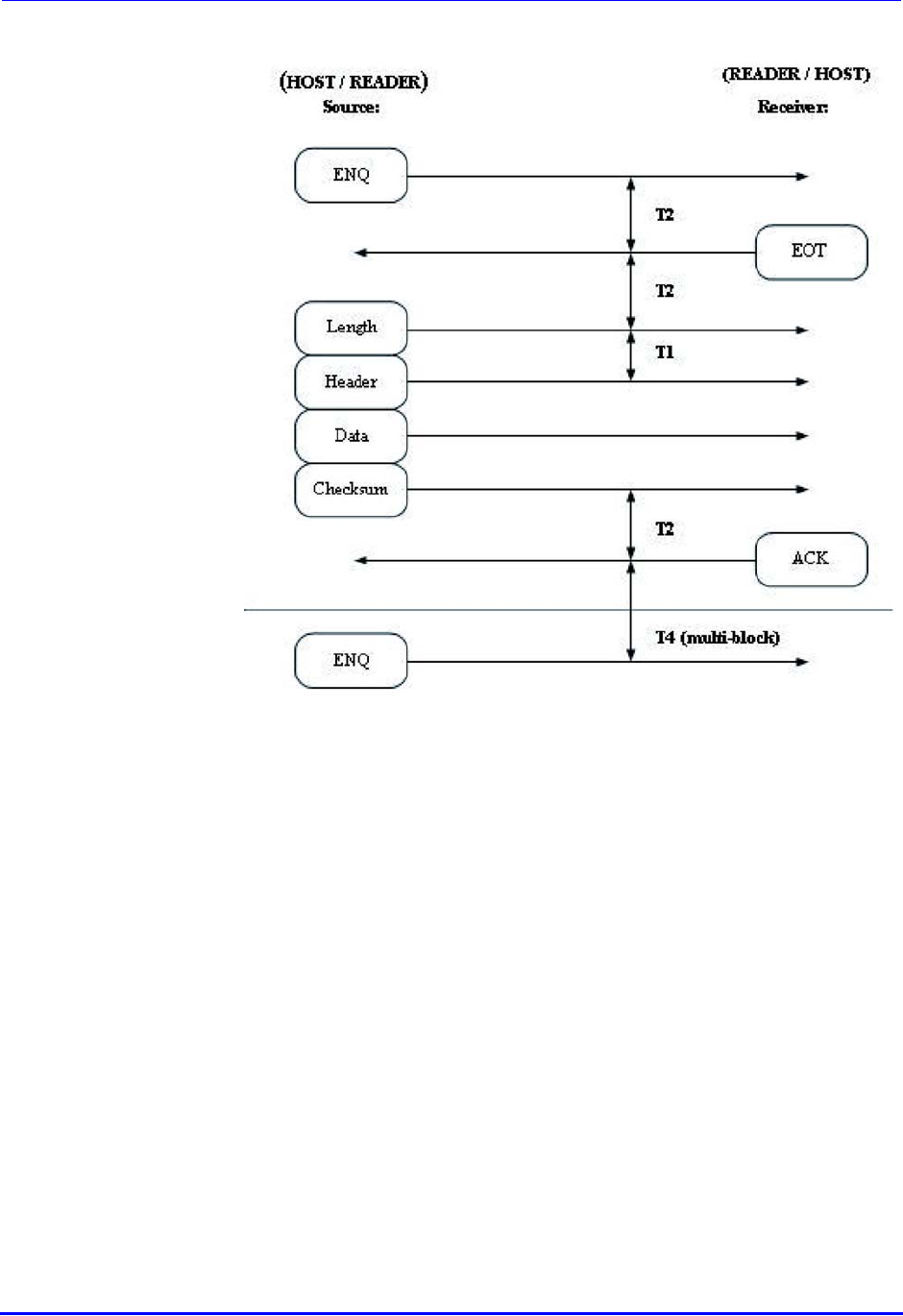
Brooks Automation
278580 Revision A 67
LF80C ZeniD RFID Reader 7 Operation
Product Manual 7.3 Operation of SECS Protocol
If it receives an <ENQ>, it puts off sending its message, sends an <EOT>
and then reads the other message.
When both the host and the equipment try to send at the same time, the
host must cancel its inquiry because the host is working in slave mode. It
must first receive the equipment message because the reader is the
master. Only then can the host send its message.
For more detailed information about all possible cases, see SEMI E4.
(SEMI Equipment Communication Standard 1 Message Transfer SECS-I)
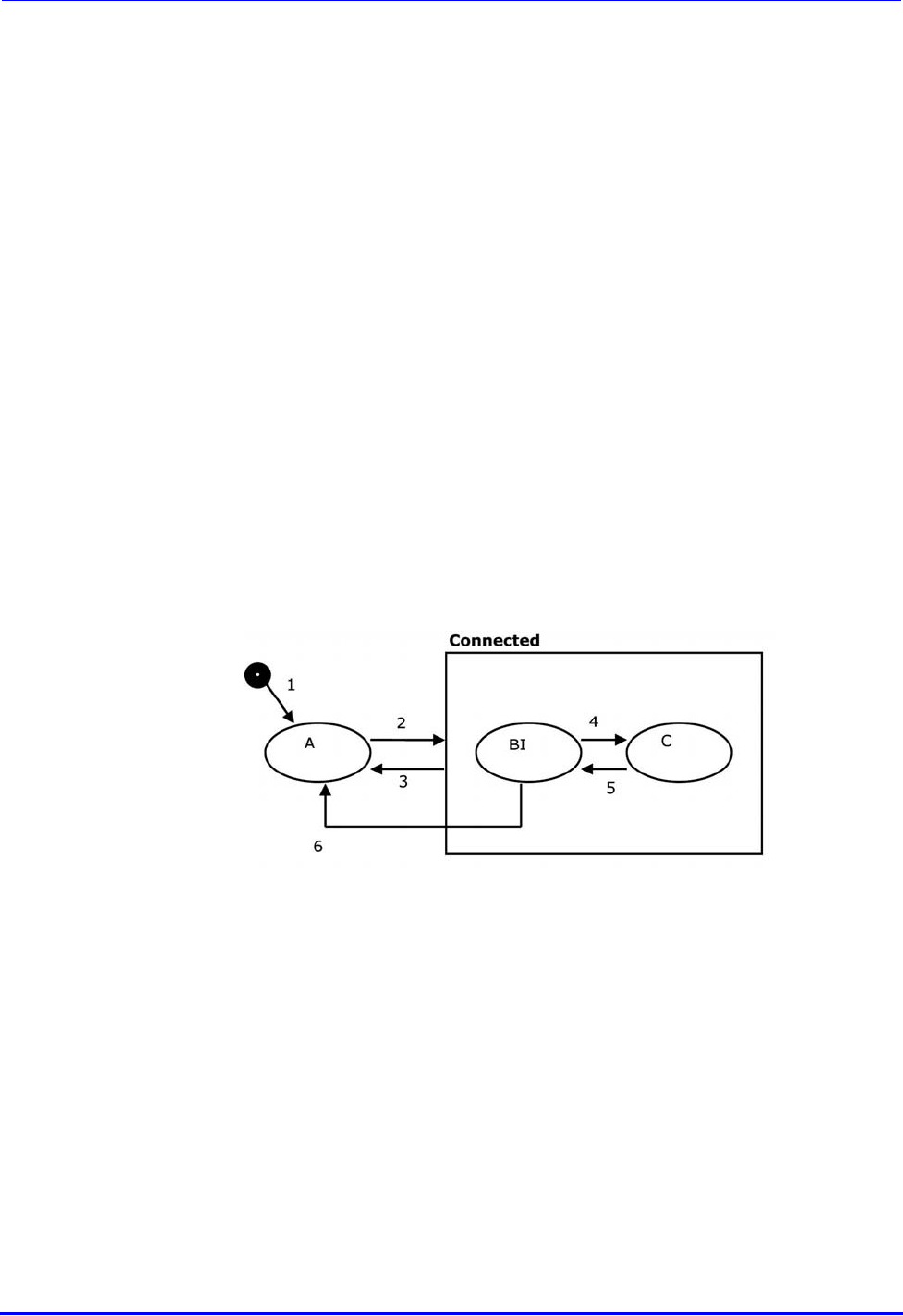
Brooks Automation
68 278580 Revision A
7 Operation LF80C ZeniD RFID Reader
7.3 Operation of SECS Protocol Product Manual
7.3.3 HSMS Option
The hardware version with an Ethernet interface uses the HSMS protocol. It
works as a HSMS server. That means that it waits for a connection inquiry
of any HOST PC.
TCP/IP: IP address xxx.xxx.xxx.xxx Port 3241
If a connection inquiry of any HOST takes place, the reader initializes the
HSMS connection, and the SECS-II messages defined in the message set
are forwarded from the reader to the respective HOST and vice versa.
It is possible to operate all readers connected to the network via one or
several HOST PCs.
But one HSMS reader can only be connected to one HOST at a time.
Use the Brooks Device Discoverer to change the TCP/IP settings.
7.3.4 HSMS Implementation
HSMS defines the procedure for all message exchanges between entities
across the TCP/IP. The HSMS Connection Status Diagram - The HSMS
status machine is illustrated in the diagram below. The behavior described
in this diagram defines the basic requirements of HSMS:
A - NOT CONNECTED
The entity is ready to listen for or to initiate TCP/IP connections, but either
has not yet established any connections or all previously established TCP/IP
connections have been terminated.
CONNECTED
A TCP/IP connection has been established. This status has two sub-
statuses, NOT SELECTED and SELECTED.
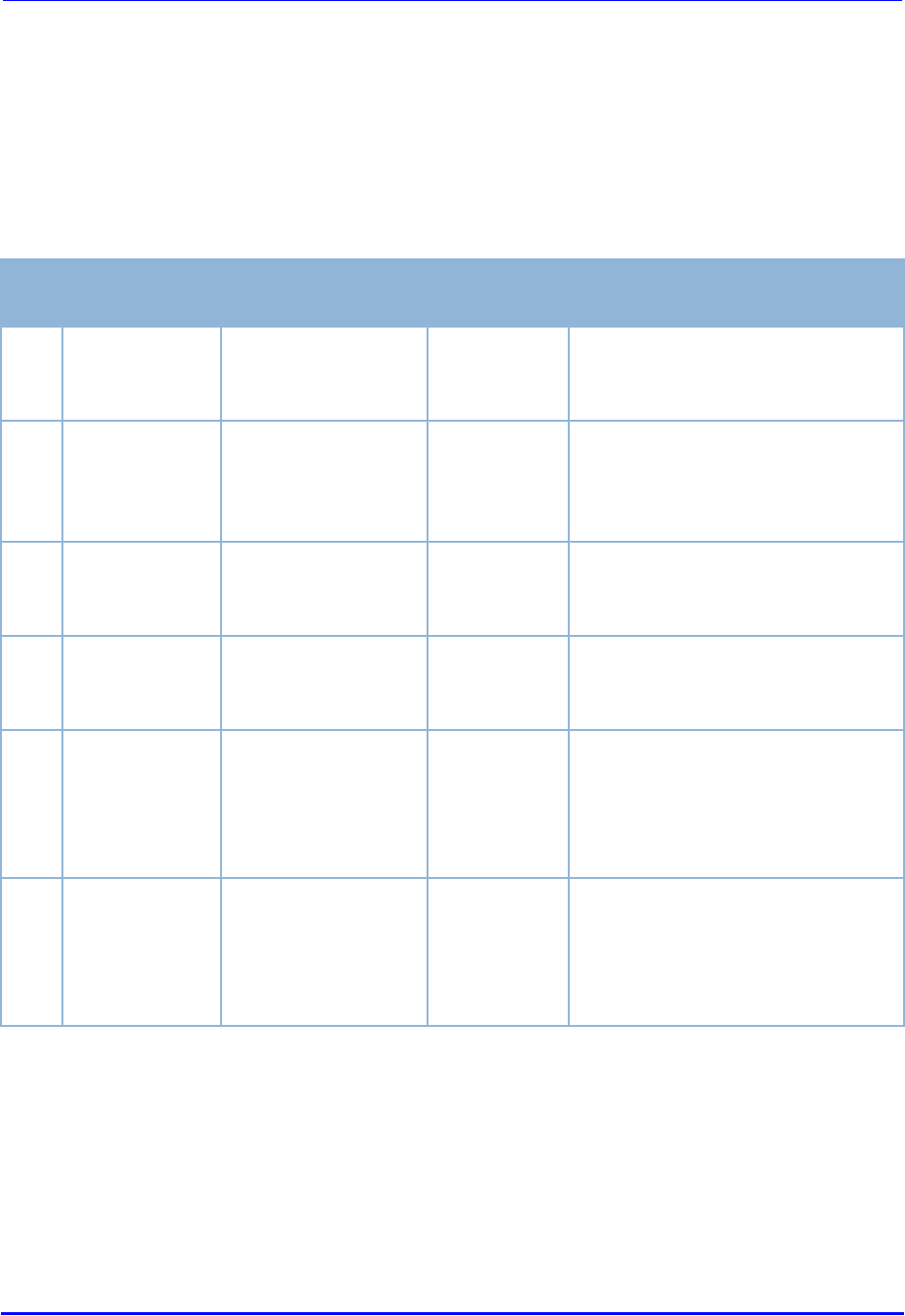
Brooks Automation
278580 Revision A 69
LF80C ZeniD RFID Reader 7 Operation
Product Manual 7.3 Operation of SECS Protocol
B - NOT SELECTED
A sub-status of CONNECTED in which no HSMS session has been
established or any previously established HSMS sessions have ended.
C - SELECTED
A sub-status of CONNECTED in which at least one HSMS session has been
established. This is the normal "operating" status of HSMS: data messages
may be exchanged in this status.
The specification of a required TCP Application Program Interface (API) for
use in implementations is outside the scope of HSMS. An HSMS
implementation may use any TCP/IP API sockets, TLI (Transport Layer
Interface), etc.
#Current
status Trigger New
status Comment
1 ... Local entity-specific
preparation for TCP/
IP communication
Not
connected
Action depends on connection
procedure to be used: active or
passive.
2 Not connected A TCP/IP connection
is established for
HSMS
communication.
Connected -
Not selected
None
3 Connected Breaking of TCP
connection
Not
connected
HSMS only permits termination of
the connection when the connection
is in the Not selected sub-status.
4 Not selected Successful
completion of HSMS
Select procedure.
Selected HSMS communication is now fully
established: data message
exchange is permitted.
5 Selected Successful
completion of HSMS
Deselect or
Separate.
Not selected This transition normally indicates
the end of HSMS communication;
an entity would immediately
proceed to break the TCP/IP
connection.
6 Not selected T7 connection
timeout
Not
connected
There is a time limit on how long an
entity is required to remain in the
Not selected status before either
entering in Selected status or
returning to Not connected status.

Brooks Automation
70 278580 Revision A
7 Operation LF80C ZeniD RFID Reader
7.3 Operation of SECS Protocol Product Manual
HSMS message
exchange procedures
HSMS defines the procedures for all message exchanges between entities
across the TCP/IP connection established according to the procedures in the
previous section. As explained in the overview, once the connection is
established, the two entities establish HSMS communications with the
Select procedure. The data messages may be exchanged in any direction at
any time. When the entities wish to end HSMS communication, the Deselect
or Separate procedure is used to terminate the HSMS communication.
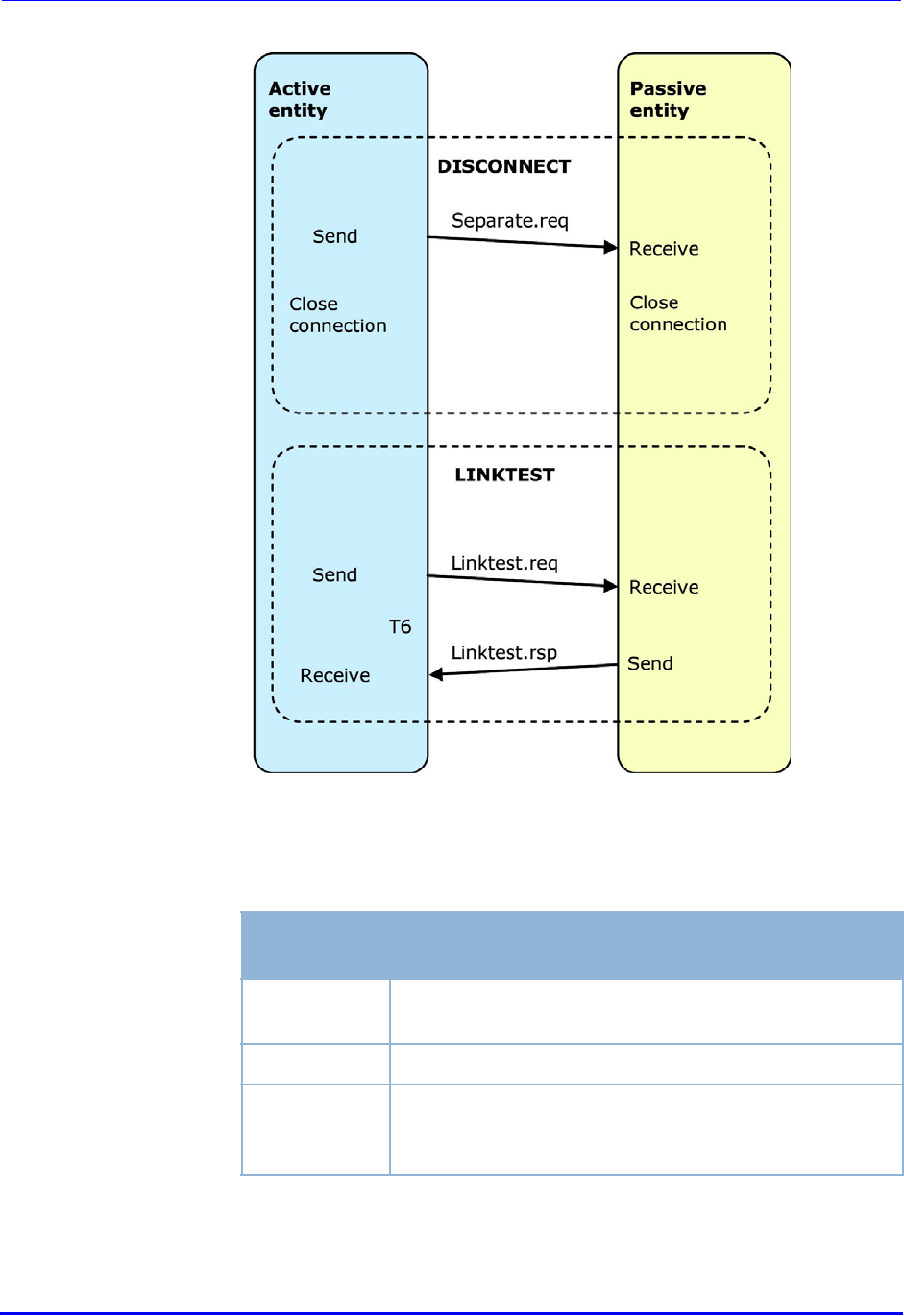
Brooks Automation
278580 Revision A 71
LF80C ZeniD RFID Reader 7 Operation
Product Manual 7.3 Operation of SECS Protocol
HSMS message
format
This section defines the detailed format of the messages used by the
procedures in the previous section. An HSMS message is transmitted as a
single continuous stream of bytes in the following order:
The minimum possible message length is 10 (header only).
The maximum possible message length depends on SECS-I.
Number of
bytes Description
4 bytes Message length. MSB first. Specifies the number of
bytes in the message header plus the message text.
10 bytes Message header
0 - n bytes Message text. Format is further specified by P-type field
of message header. The message text corresponds to
message data by SECS-II encoding.
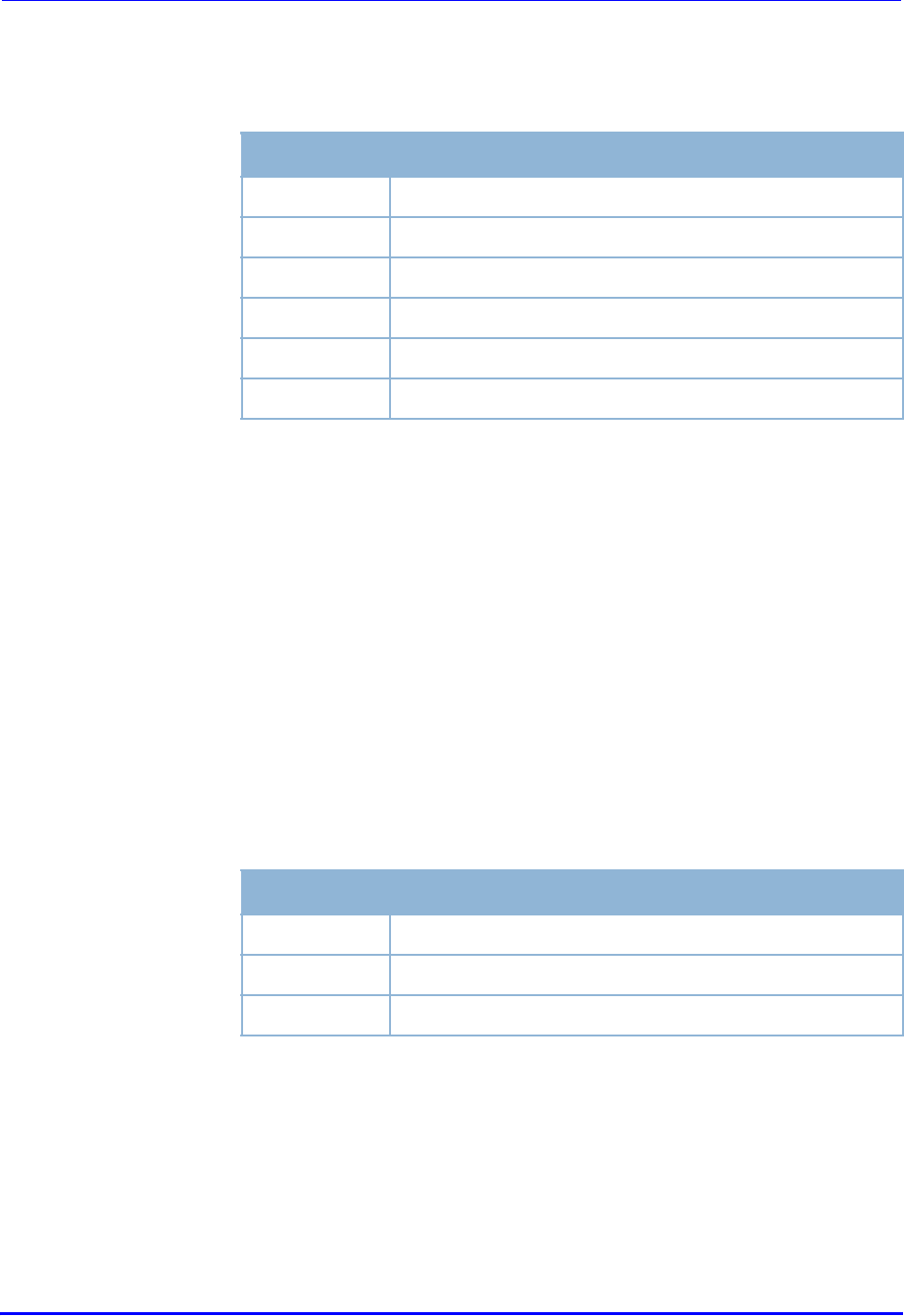
Brooks Automation
72 278580 Revision A
7 Operation LF80C ZeniD RFID Reader
7.3 Operation of SECS Protocol Product Manual
HSMS message
header
The message header is a 10-byte field. The bytes in the header are
numbered from byte 0 (first byte transmitted) to byte 9. The format of the
message header is as follows:
The physical byte order is designed to correspond as closely as possible to
the SECS-I header.
The session ID is a 16-bit unsigned integer value, which occupies bytes 0
and 1 of the header (byte 0 is MSB). Its purpose is to provide an
association by reference between control messages and subsequent
messages.
Header byte 2 is used in different ways for different HSMS messages. For
control messages, it contains 0 or a status code. For a data message, it
contains the W bit and SECS stream.
Header byte 3 contains 0 or a status code for control messages. For data
messages, it contains the SECS function.
P-type is an 8-bit unsigned integer value which occupies byte 4 of the
message header; message header and message text are encoded. Only P-
type = 0 is defined by HSMS to mean SECS-II message encoding. For non-
zero P-type values, see SEMI E37.
S-type (session type) is a 1-byte unsigned integer value which occupies
header byte 5.
Bytes Description
0-1 Session ID (Device ID)
2Header byte 2
3Header byte 3
4P-type
5S-type
6-9 System bytes
Value Description
0 SECS-II Encoding
1 - 127 Reserved for subsidiary standards
128 - 255 Reserved, not used

Brooks Automation
278580 Revision A 73
LF80C ZeniD RFID Reader 7 Operation
Product Manual 7.3 Operation of SECS Protocol
The system bytes are used to uniquely identify a transaction among the set
of open transactions. The system bytes are also defined as SECS-I-specific.
HSMS message
format summary
* Indicates further specification by subsidiary standards
Value Description Value Description
0 Data message 6 Linktest.rsp
1 Select.req 7 Reject.req
2 Select.rsp 8 Not used
3 Deselect.req 9 Separate.req
4 Deselect.req 10 Not used
5 Linktest.req 11-255 Reserved, not used
Message header
Message type bytes 0 - 1
Session ID
byte 2 byte 3 byte 4
P-type
byte 5
S-type
bytes 6 - 9
System bytes
Message
text
Data
message
*
(no R bit)
W bit and
SECS
stream
SECS
Function
0 0 Primary:
Unique Reply:
Same as
primary
Text
Select req*0001UniqueNone
Select.rsp Same
as.req
0 Select
status
0 2 Same as.req None
Deselect.req*0003UniqueNone
Deselect.rsp Same
as.req
0 Deselect
Status
0 4 Same as.req None
Linktest.req 0xFFFF 0 0 0 5 Unique None
Linktest.rsp 0xFFFF 0 0 0 6 Same as.req None
Reject.req Same as
message
being
rejected
P-type or S-
type of
message
being
rejected
Reason
code
0 7 Same as
message
being
rejected
None
Separate.req * 0 0 0 9 Unique None

Brooks Automation
74 278580 Revision A
7 Operation LF80C ZeniD RFID Reader
7.3 Operation of SECS Protocol Product Manual
7.3.5 SECS-II Implementation
Introduction The SEMI Equipment Communication Standard Part 2 (SECS-II) defines
how messages exchanged between intelligent equipment and a host are
interpreted.
It is the intent of this standard to be fully compatible with SEMI Equipment
Communication Standard E4 (SECS-I).
The messages defined in this specification support the typical activities
required for the BROOKS RFID reader.
SECS-II gives form and meaning to messages exchanged between the
equipment and the host using a message transfer protocol, such as SECS-I.
SECS-II defines the method of conveying information between the
equipment and the host in the form of messages.
These messages are organized into categories of activities, called streams,
which contain specific messages, called functions. In SECS-II, messages
are identified by a stream code (0-127, 7 bits) and a function code (0-255,
8 bits). Each combination of stream and function represents a unique
message identification.
SECS-II defines the structure of messages into entities called items and
lists of items. These data structures define the logical divisions of the
message as distinct from the physical division of the message transfer
protocol.
An item is an information packet that has a length and format defined by
the first 2, 3 or 4 bytes of the item. These bytes are called the item header.
The item header consists of the format byte and the length byte as shown
below.
Byte Name Description
0Format and
number of
the length
bytes
The data format is coded in the upper
6 bits.
The two less significant bits
determine the number of the
following length bytes.
1
1-2
1-3
Length bytes The length corresponds to the
number of the bytes of a data
element. In the "List" format, the
length corresponds to the number of
the list elements.
The standard does not require the
minimum possible number of length
bytes for a given data length.
Next <Length> Data Data bytes of a data element or
number of the data elements in case
of the "List" format.

Brooks Automation
278580 Revision A 75
LF80C ZeniD RFID Reader 7 Operation
Product Manual 7.3 Operation of SECS Protocol
A list is an ordered set of elements, whereby an element can be either an
item or a list. The list header has the same form as an item header with
format type 0. However, the length byte refers to the number of elements
in the list rather than to the number of bytes.
Data items The formats represent arrays of types: <type>[number of elements],
whereby <type> is one of the following:
Oct-
code
Hex-
code Format Meaning Example
00 01 List List element with
the number of
the "Length" data
elements
<L2>
<A "Hello">
<B 0x00>
11 25 Boolean 1-byte Boolean
false = 00
true = 01
<Boolean1 0x00>
10 21 Binary Byte sequence
of the length
"Length"
<B1 0x01>
20 41 ASCII Printable ASCII
characters <A "Hello">
31 65 I1 1-byte signed
integer <I1 123>
32 69 I2 2-byte signed
integer <I2 -12345>
34 71 I4 4-byte signed
integer <I4 2147483647>
30 61 I8 8-byte signed
integer
<I8
931372980293834>
51 A5 U1 1-byte unsigned
integer <U1 0>
52 A9 U2 2-byte unsigned
integer <U2 #empty>
54 B1 U4 4-byte unsigned
integer <U4 429489725>
50 A1 U8 8-byte unsigned
integer
<U8
763468676756767>
40 91 F8 8-byte floating
point <F8 1.223 e204>
44 81 F4 4-byte floating
point <F4 -1.23 >

Brooks Automation
76 278580 Revision A
7 Operation LF80C ZeniD RFID Reader
7.3 Operation of SECS Protocol Product Manual
Data item examples
Message set The SECS-II message set used by the LDN reader consists of six different
stream types.
Stream 1: (Equipment status)
S1F1 and S1F2 Are you there request
S1F15 and S1F16 Request offline
S1F17 and S1F18 Request online
Stream 2: (Equipment control)
S
S2F13 and S2F14 Request parameter
S2F15 and S2F16 Set parameter
S2F19 and S2F20 Reset send
Stream 3: (Material status)
S3F5 and S3F6 Cassette found send
S3F7 and S3F8 Cassette lost send
S3F11 and S3F12 Read MID at I/O port
S3F13 and S3F14 Return read MID
S3F65 and S3F66 Write MID at I/O port
S3F67 and S3F68 Return write success
S3F73 and S3F74 Lock MID at I/O port
S3F75 and S3F76 Return lock success
Meaning Format Length
1-byte integer 65 01 xx
4-byte integer 71 04 MSB ... ... LSB
ASCII 41 06 1st
chr
2nd
chr
3rd
chr
4th
chr
5th
chr
6th
chr
Zero-length xx 00
List data item 01 03 1st element 2nd element 3rd element

Brooks Automation
278580 Revision A 77
LF80C ZeniD RFID Reader 7 Operation
Product Manual 7.3 Operation of SECS Protocol
Stream 5: (Exception handling)
S5F1 and S5F2 Alarm report send
Stream 9: (System errors)
S9F1 Unrecognized device ID
S9F3 Unrecognized stream type
S9F5 Unrecognized function type
S9F7 Illegal data
S9F9 Transaction timer timeout
For more information on error codes and the corresponding correcting
actions please refer to
Î
Error Codes.
According to SEMI E99 carrier ID read / writer functional standard for
SECS-I and SECS-II protocol, the RFID Reader LF80C ZeniD supports these
defined stream 18 messages:
Stream 18: (Equipment status)
S18F1 and S18F2 Read attribute request
S18F3 and S18F4 Write attribute request
S18F5 and S18F6 Read request
S18F7 and S18F8 Write request
S18F9 and S18F10 Read ID request
S18F11 and S18F12 Write ID request
S18F13 and S18F14 Subsystem command request

Brooks Automation
78 278580 Revision A
7 Operation LF80C ZeniD RFID Reader
7.3 Operation of SECS Protocol Product Manual
Data item dictionary This section defines the data items used in the standard SECS-II messages
described in
Î
Message Details.
Syntax:
Acknowledge code
0 : Sensor 0 was the initiator
>0 : Error, not accepted
Where used S3F6, S3F8
Acknowledge code
0 : No error
>0 : Error, not accepted
Where used S5F2
Name A unique name for this data item. This name is used in
the message definitions.
Format The permitted item format code which can be used for
this standard data item.
Item format codes are shown in hex and octal, as
described in the chapter
Î
Data items.
The notification "3()" indicates any of the signed integer
formats (30, 31, 32, 34).
Description A description of the data item, with the meanings of
specific values.
Where used The standard messages in which the data item appears.
ACKC3 Format: B[1]
ACKC5 Format: B[1]

Brooks Automation
278580 Revision A 79
LF80C ZeniD RFID Reader 7 Operation
Product Manual 7.3 Operation of SECS Protocol
Description The value of the alarm status refers to the last reading
process. If a read or write error occurs, the alarm status
is set.
A successful read or write resets the alarm status.
When leaving maintenance mode, the alarm status is
also
deleted.
0 ... No alarm
1 ... Alarm
Where used S18F13
Alarm code byte
Only the occurrence of an error is reported. Errors are not generally reset.
bit 8 = 1 Alarm is set
Where used S5F1
Alarm identifier
0 No error
1 Auto read failed, the reader is engaged
2 External read failed, the reader is engaged
3 External write failed, the reader is engaged
4 No tag could be recognized when the sensor was covered or the
carrier had been removed prematurely (sensor uncovered)
5 Invalid command or parameter detected
6 Unknown error
7 Reserved
8 Parity error or checksum error detected
9 Unexpected confirmation was sent
10 Locked page could not be written
11 Reserved
12 Incorrect type of transponder
13 External read or write failed because the sensor is not covered
ALARM STATUS Format: A[1]
ALCD Format: B[1]
ALID Format: B[1]

Brooks Automation
80 278580 Revision A
7 Operation LF80C ZeniD RFID Reader
7.3 Operation of SECS Protocol Product Manual
14 Reserved
15 Reserved
16 Reserved
Where used S5F1
For more information on error codes and the corresponding correcting
actions please refer to
Î
Error Codes.
Alarm text
The length of the alarm text is 0 to 40 characters.
According to the reader version, status information about the sensor or
sensors is also transmitted during a reader error message.
The information should be interpreted as follows:
ALTX[0] Initiator of an error message
“0”: Sensor 0
“1”: Sensor 1 (not available)
“F”: Cannot be assigned
ALTX[1] Status of sensor 0
“0”: Sensor not occupied
“1”: Sensor is occupied
“E”: Sensor status is not available
“F”: Sensor not defined
ALTX[2] Status of sensor 1
"0": Sensor not occupied
"1": Sensor is occupied
"E": Sensor state is not available
"F": Sensor not defined
ALTX[3] ‘:’ a colon separates the alarm text from the sensor statuses
Where used S5F1
ALTX Format:
A[max40]

Brooks Automation
278580 Revision A 81
LF80C ZeniD RFID Reader 7 Operation
Product Manual 7.3 Operation of SECS Protocol
Description: Identifier for an attribute for a specific type of object.
CIDRW attribute definitions:
"Configuration"… Number of heads
"AlarmStatus” Current CIDRW sub-status of ALARM STATUS
"OperationalStatus" Current CIDRW sub-status of OPERATING
STATUS
"SoftwareRevisionLevel" Revision (version) of software - 8-byte
maximum
"CarrierIDOffset" Offset of CID in CID field (MID area)
"CarrierIDLength" Length of CID in CID field (MID area)
"ECID_00" → parameter 0 -
Î
Gateway ID
"ECID_01" → parameter 1 -
Î
Baudrate
"ECID_02" → parameter 2 -
Î
Inter-character timeout T1
"ECID_03" → parameter 3 -
Î
Block protocol timeout T2
"ECID_04" → parameter 4 -
Î
Reply timeout T3
"ECID_05" → parameter 5 -
Î
Inter-block timeout T4
"ECID_06" → parameter 6 -
Î
Retry limit RTY
"ECID_07" → parameter 7 -
Î
TARGETID high byte
"ECID_08" → parameter 8 -
Î
TARGETID low byte
"ECID_09" → parameter 9 -
Î
Heartbeat time1)
"ECID_11" → parameter 11 -
Î
ReaderID
"ECID_12" → parameter 12 -
Î
HeadID
"ECID_20" → parameter 20 -
Î
Sensor delay for presence sensor
"ECID_22" → parameter 22 -
Î
Sensor-triggered action for presence
sensor
"ECID_23" → parameter 23 -
Î
Triggered read frequency
"ECID_24" → parameter 24 -
Î
r/w max repeat
"ECID_25" → parameter 25 -
Î
Transponder type
"ECID_26" → parameter 26 -
Î
Sensor activity
"ECID_27" → parameter 27 -
Î
Watchport for presence sensorr
"ECID_28" → parameter 28 -
Î
Transmitter level (read mode)
"ECID_29" → parameter 29 -
Î
Transponder load duration (read mode)
"ECID_30" → parameter 30 -
Î
r/w synchronize
"ECID_31" → parameter 31 -
Î
Auto-adjust value (read mode)
"ECID_32" → parameter 32 -
Î
Auto-adjust value (write mode)
"ECID_33" → parameter 33 -
Î
Automatic antenna adjustment
"ECID_34" → parameter 34 -
Î
Sensor type for presence sensor
"ECID_35" → parameter 35 -
Î
Special features
"ECID_36" → parameter 36 -
Î
Lock membrane keyboard
"ECID_37" → parameter 37 -
Î
MID area
"ECID_38" → parameter 38 -
Î
Test after software reset
"ECID_39" → parameter 39 -
Î
Transmitter level (write mode)
"ECID_40" → parameter 40 -
Î
Transponder load duration (write mode)
ATTRID Format:
A[max25]

Brooks Automation
82 278580 Revision A
7 Operation LF80C ZeniD RFID Reader
7.3 Operation of SECS Protocol Product Manual
"ECID_41" → parameter 41 -
Î
Delay time between read cycles
"ECID_42" → parameter 42 -
Î
CarrierIDOffset
"ECID_43" → parameter 43 -
Î
CarrierIDLength
"ECID_44" → parameter 44 -
Î
FixedMID
"ECID_45" → parameter 45 -
Î
MIDFormat
"ECID_99" → parameter 99 -
Î
Customer code
Head attribute definitions: *
"HeadStatus" The current status
"HeadID" Head number 00-31 (2 digits)
* With regard to an RFID Reader LF80C ZeniD, the head attribute definition
"HeadStatus" is equal to the "OperationalStatus" of the CIDRW. The
"HeadID" is also 01 and equal to the CIDRW "Configuration" attribute.
Where used S18F1, S18F3
Description: Value of the specified attribute.
CIDRW attribute definitions:
"Configuration” Number of heads "01"
"AlarmStatus” Current CIDRW sub-status of ALARM
STATUS
"0" …NO
"1" …ALARMS
"OperationalStatus" Current CIDRW sub-status of OPERATING
"IDLE” … Reader in IDLE mode
"BUSY” … Reader is busy
"MANT" … Maintenance mode
"SoftwareRevisionLevel" Revision (version) of Software - 8-byte
maximum
ECID_00 to ECID_45 see data item ECV parameters 0 - 45
ATTRVAL Format:
A[max4]

Brooks Automation
278580 Revision A 83
LF80C ZeniD RFID Reader 7 Operation
Product Manual 7.3 Operation of SECS Protocol
Head attribute definitions:
"HeadStatus" The current status
"IDLE" ... Reader in IDLE mode
"BUSY" ... Reader is busy
"NOOP" ... Not operating
"HeadID" Head number 00-31 (2 digits)
"00" ... Reader 0
"31" ... Reader 31
Where used S18F2, S18F3
Description Status request value
"OP" ... Operating status
"MT" ... Maintenance status
Where used S18F13
Description A vector or string of unformatted data.
Multipage transponder DATA area depends on the MID area,
can be page 1 - page 17
Read/write transponder DATA correspond to 8 byte MID
Read/only transponder DATA correspond to 8 byte MID
Where used S18F6, S18F7
Description Total bytes to be sent.
The DATALENGTH corresponds to the quantity of bytes that are to be read
or written.
The valid range depends on the length of the MID area (
Î
Parameter 37
(0x25)).
Where used S18F5, S18F7
CPVAL Format: A[]
DATA Format: A[]
DATALENGTH Format: U2

Brooks Automation
84 278580 Revision A
7 Operation LF80C ZeniD RFID Reader
7.3 Operation of SECS Protocol Product Manual
Description Used to identify the data requested.
The DATASEG corresponds to the page number (PAGEID) of multipage,
read/only and read/write transponders.
"00" First page of any type of transponder or first page of
DATA
area in case of a multipage transponder.
Multipage-transponder (page 1 to page 17):
Start the reading or writing on the following page of a multipage
transponder:
...
"01" page 1 "81" Locked page 1
... ...
"11" page 17 "91" Locked page 17
Read/only transponder "F0" Read only the one page
Read/write transponder "F1" Read or write only the one page
Where used S18F5, S18F7
Acknowledge code for new reader constant
0 ... Parameter was set successfully
1 ... Parameter could not be set
Where used S2F16
Parameter number of reader (see data item ECV)
Where used S2F13, S2F15
Reader parameter definition.
The values are displayed as decimal values, see
Î
Parameters.
DATASEG Format:A[2]
EAC Format: B[1]
ECID Format: U1
ECV Format: U1

Brooks Automation
278580 Revision A 85
LF80C ZeniD RFID Reader 7 Operation
Product Manual 7.3 Operation of SECS Protocol
3 ... external LED
4 ... OK
5 ... Error
6 ... Antenna
7 ... Output
12 ... Read
13 ... Write
14 ... Tuning
Where used S18F13
Description Status request value
"On" Reader is on
"Off" Reader is off
"Flash" LED flashes
Where used S18F13
Equipment model number.
Where used S1F2
Material format code.
20: The material port number corresponds to the sensor number and
status
Where used S3F5, S3F7
SECS message block header associated with message block in error.
Where used S9F1, S9F3, S9F5, S9F7, S9F9
LEDNR Format: A[]
LEDSTATE Format: A[]
MDLN Format: A[6]
MF Format: B[1]
MHEAD Format: B[10]

Brooks Automation
86 278580 Revision A
7 Operation LF80C ZeniD RFID Reader
7.3 Operation of SECS Protocol Product Manual
Description Material ID
Depending on the type of transponder, it is
possible to modify the length of the MID.
Multipage transponder MID can be set from "0" (no MID)
to "10" (MID occupies the first 10
pages (writeable))
Read/write transponder MID corresponds to DATA (writeable)
Read/only transponder MID corresponds to DATA (fix)
Where used S18F10, S18F11
Material ID acknowledge code
0 Material ID acknowledged; the presence sensor was the initiator
1 Not defined
2 Material ID acknowledged - reaction on externally
triggered action; the message cannot be related to any sensor
>2 Material ID not acknowledged
The data item port number PTN indicates the initiator.
Where used S3F14, S3F68
Material ID acknowledge code
2 Acknowledge, will send MID later in S3F13
Where used S3F12
Acknowledge code for OFF-LINE request.
0 OFF-LINE acknowledge (reader is offline)
Where used S1F16
MID Format: A
MIDAC Format: B[1]
MIDRA Format: B[1]
OFLACK Format: B[1]

Brooks Automation
278580 Revision A 87
LF80C ZeniD RFID Reader 7 Operation
Product Manual 7.3 Operation of SECS Protocol
Acknowledge code for ON-LINE request.
0 ON-LINE accepted (reader is online)
Where used S1F18
Page number of multipage, read/only and read/write transponders
0x00 : First page of the data area of a multipage transponder.
Multipage transponder (pages 1 to 17):
If only one page of the multipage transponder is read, note the following:
0x01 : (1) page 1 0x81 : (129) locked page 1
... ...
0x11 : (17) page 17 0x91 : (146) locked page 17
Read-only transponder:
0xF0 : (240) Read one page only
Read/write transponder:
0xF1 : (241) Read or write one page only
Where used S3F11
The transponder data that has been read or will be written. The PAGEDATA
corresponds to the value of a transponder page.
PAGEDATA [0] Corresponds to the page number. The value of the page
number is displayed in the data item "PAGE_ID".
PAGEDATA [1] The 8 bytes (one page) of the transponder ID follow.
PAGEDATA [8]
Where used S3F7, S3F12, S3F13, S3F65
ONLACK Format: B[1]
PAGE_ID Format: B[1]
PAGEDATA Format: B[9]

Brooks Automation
88 278580 Revision A
7 Operation LF80C ZeniD RFID Reader
7.3 Operation of SECS Protocol Product Manual
Description Preventive maintenance information
"NE" … Normal execution
"MR" … Maintenance required
Where used S18F2, S18F4, S18F8, S18F10, S18F12, S18F14
Information about the status of up to two sensors and the initiator of the
message.
The second sensor is not implemented yet.
For special applications, the reading process of the RFID reader is triggered
by two sensors. In this case it is necessary to distinguish between the two
sensors. The initiator represents the number of the sensor that has caused
the message.
Default: Only sensor 0 is defined.
Sensor 0: bit 0 - bit 2
The current status of sensor 0 is described in three bits.
0 Sensor not occupied
1 Sensor occupied
7 Sensor not defined
Sensor 1: bit 3 - bit 5 (defined for future developments)
The current status of sensor 1 is described in three bits.
0 Sensor not occupied
1 Sensor occupied
7 Sensor not defined
Initiator: bit 6 - bit 7
The initiator represents the number of the sensor that has caused the
message.
0Sensor 0
1 Sensor 1 (not implemented yet)
3 Cannot be assigned
Where used S3F5, S3F7, S3F12, S3F13, S3F67
PM Information Format: A[2]
PTN Format: B[1]
Initiator Sensor 1 Sensor 0
Bit 7 ... bit 0
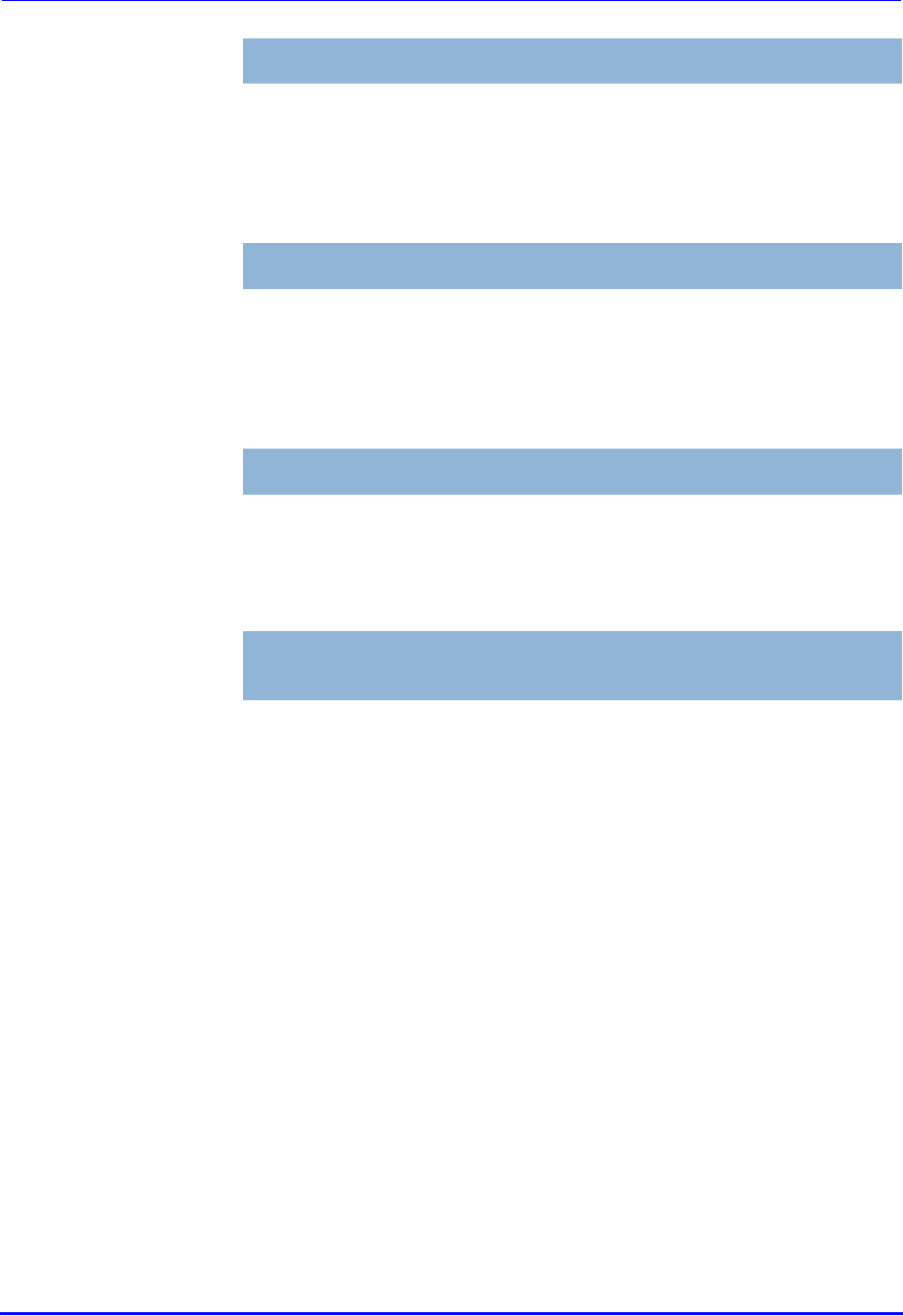
Brooks Automation
278580 Revision A 89
LF80C ZeniD RFID Reader 7 Operation
Product Manual 7.3 Operation of SECS Protocol
Reset acknowledge code
0 … Reset could be done
1 … Reset could not be done
Where used S2F20
Reset code
1… Power-up reset
2 … Software reset
Where used S2F19
Stored SECS message block header. Only the last message is stored, which
must still be confirmed by the host.
Where used S9F9
Software version.
Where used S1F2
RAC Format: B[1]
RIC Format: B[1]
SHEAD Format: B[10]
SOFTREV Format: A[max
6]

Brooks Automation
90 278580 Revision A
7 Operation LF80C ZeniD RFID Reader
7.3 Operation of SECS Protocol Product Manual
Description: Result information on the status of the request concerning the
service request.
"NO" Normal operation
Indicates the success of the requested action.
"EE" Execute error
Cannot read tag data. Cannot read ID sequence.
However, equipment is normal.
"CE" Communication error
Syntax error of message or message format or value.
"HE" Hardware error
ID reader/writer head fault, ID reader/writer head is powered off.
"TE" Tag error
Where used S18F2, S18F4, S18F6, S18F8, S18F10, S18F12, S18F14
Description: Indicates an action to be performed by the subsystem.
Used to differentiate between the different subsystem commands indicated.
"ChangeStatus" … Change status
"GetStatus" … Get status
"Reset" … Reset CIDRW
"PerformDiagnostics"… Perform diagnostics
"DefaultParams" … Reset default parameter*
"FactorySettingParams" … Reset factory settings and default parameter
“ADJUST“ … Automatic antenna calibration (parameter 33)
"SetLED“ … Set LED*
Where used S18F13
SSACK Format: A[2]
SSCMD Format: A[max
18]

Brooks Automation
278580 Revision A 91
LF80C ZeniD RFID Reader 7 Operation
Product Manual 7.3 Operation of SECS Protocol
Description Provides status information of a subsystem component.
Consists of PM Information and the current values of the
CIDRW attributes AlarmStatus, OperatingStatus, and
HeadStatus.
List of a Status
L,4
<PMInformation>
<AlarmStatus>
<OperatingStatus>
<HeadStatus>
For data items OperatingStatus and HeadStatus, see data item ATTRVAL.
Where used S18F2, S18F4, S18F8, S18F10, S18F12, S18F14
Description Identifies where a request for action or data is
to be applied. Alternatively, you can use the HeadID.
See also reader parameter definitions (data
item ECV) parameter 7, 8 and 12.
The 4 ASCII character TARGETID is changeable (only
changeable for LF80C devices), and defined in
parameter 7
and 8 ("ECID_07", "ECICD_08").
The 2 ASCII character HeadID is changeable,
and defined in parameter 12 ('ECID_12').
Where used S18F1, S18F3, S18F5, S18F7, S18F9, S18F11, S18F13
STATUS Format: A[2]
TARGETID Format: A[max
4]
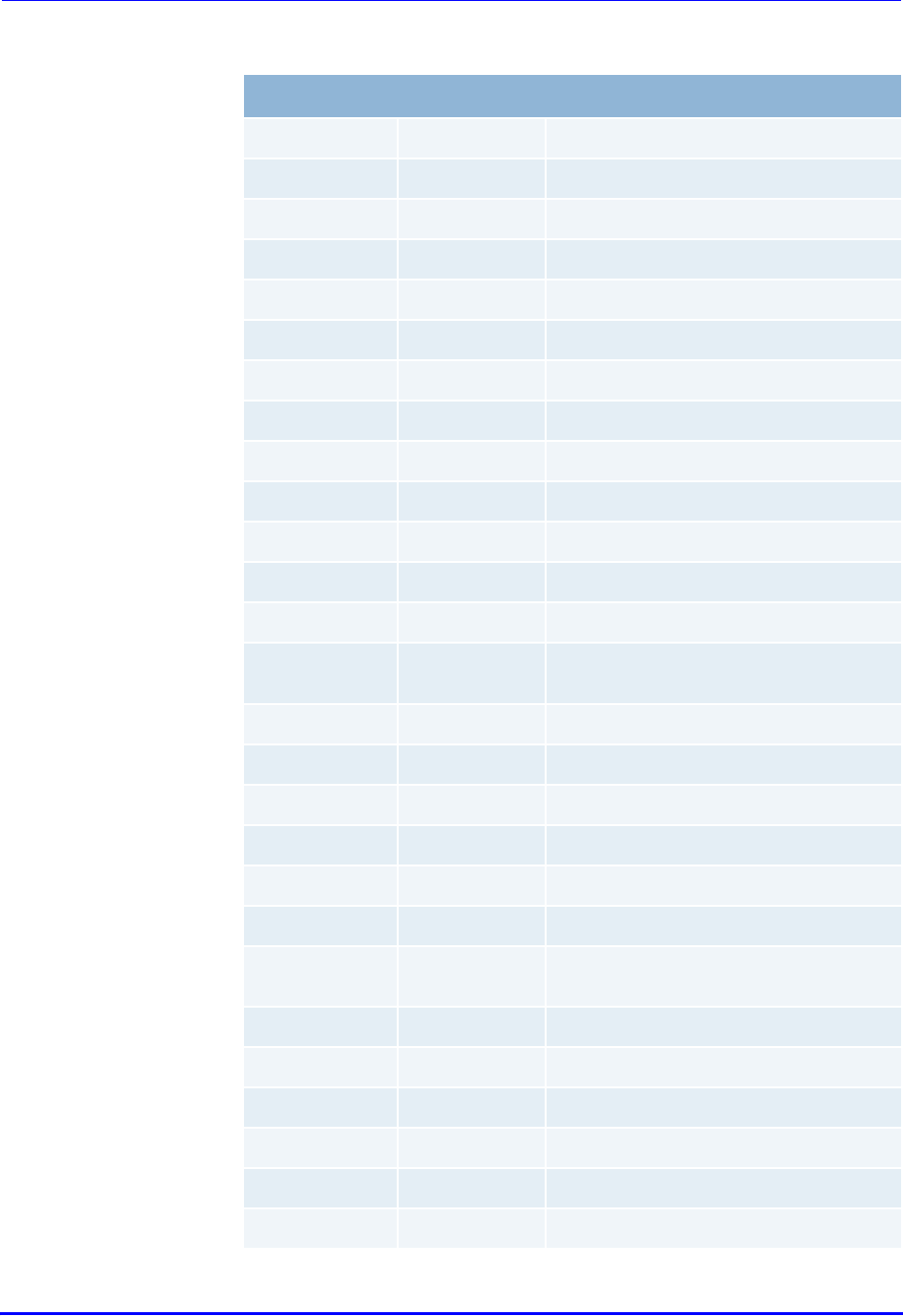
Brooks Automation
92 278580 Revision A
7 Operation LF80C ZeniD RFID Reader
7.3 Operation of SECS Protocol Product Manual
7.3.6 Parameters
No. (dec) No. (hex) Parameter name
00x00
Î
Gateway ID
10x01
Î
Baudrate
20x02
Î
Inter-character timeout T1
30x03
Î
Block protocol timeout T2
40x04
Î
Reply timeout T3
50x05
Î
Inter-block timeout T4
60x06
Î
Retry limit RTY
70x07
Î
TARGETID high byte
80x08
Î
TARGETID low byte
90x09
Î
Heartbeat time
11 0x0B
Î
ReaderID
12 0x0C
Î
HeadID
20 0x14
Î
Sensor delay for presence sensor
22 0x16
Î
Sensor-triggered action for
presence sensor
23 0x17
Î
Triggered read frequency
24 0x18
Î
r/w max repeat
25 0x19
Î
Transponder type
26 0x1A
Î
Sensor activity
27 0x1B
Î
Watchport for presence sensor
28 0x1C
Î
Transmitter level (read mode)
29 0x1D
Î
Transponder load duration (read
mode)
30 0x1E
Î
r/w synchronize
31 0x1F
Î
Auto-adjust value (read mode)
32 0x20
Î
Auto-adjust value (write mode)
33 0x21
Î
Automatic antenna adjustment
34 0x22
Î
Sensor type for presence sensor
35 0x23
Î
Special features
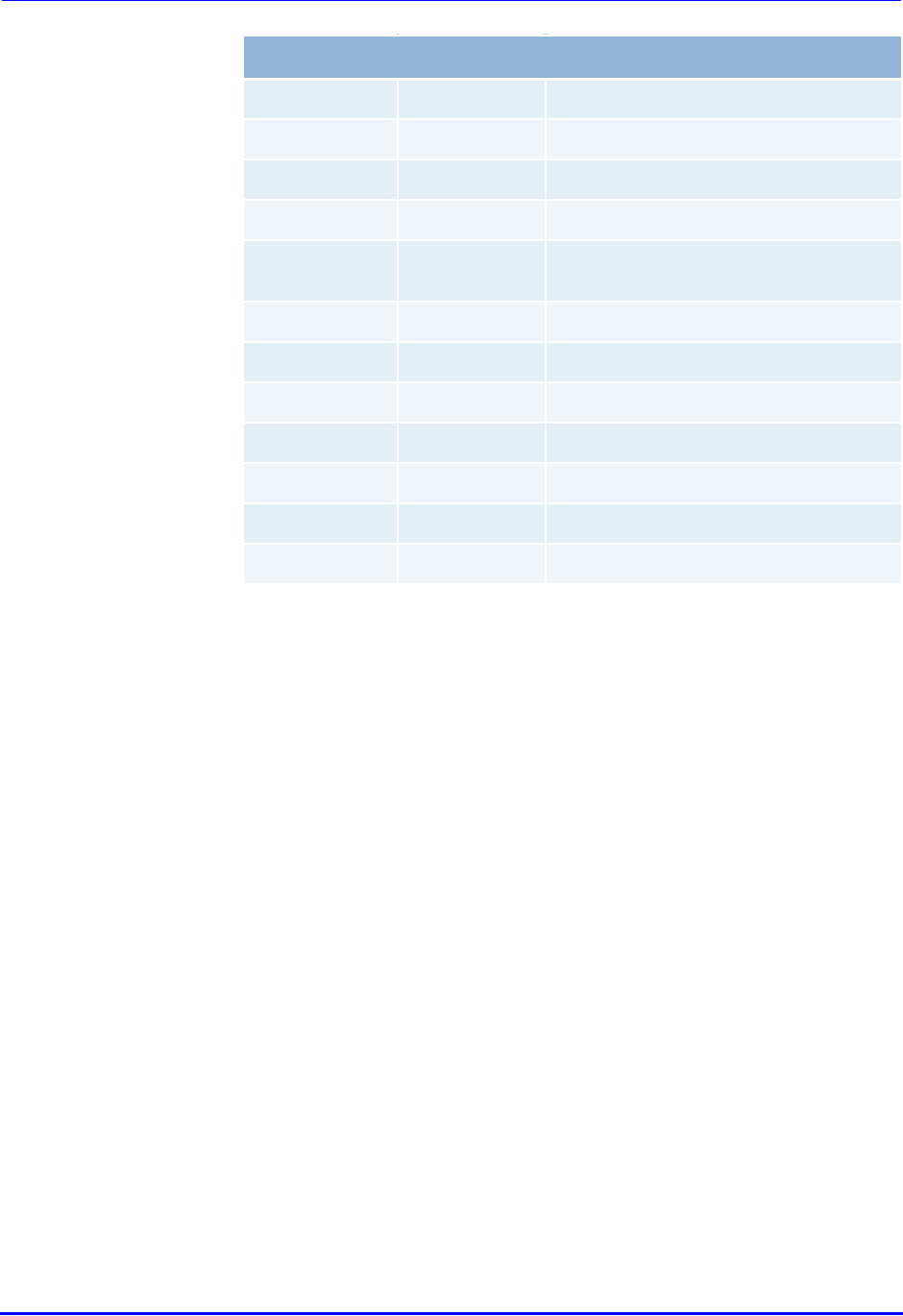
Brooks Automation
278580 Revision A 93
LF80C ZeniD RFID Reader 7 Operation
Product Manual 7.3 Operation of SECS Protocol
Parameter 0 (0x00) Gateway ID
The gateway ID is a part of the device ID. The BROOKS SECS-I reader
works simultaneously as a gateway and as a reader (CIDRW with integrated
head).
It is the "lower message ID" in the message header.
00 .. 255
Default: Last two characters of hex serial number
The default gateway ID corresponds to parameter 8 (TARGETID low byte).
For more details see
Î
Parameter 8 (0x08).
36 0x24
Î
Lock membrane keyboard
37 0x25
Î
MID area
38 0x26
Î
Test after software reset
39 0x27
Î
Transmitter level (write mode)
40 0x28
Î
Transponder load duration (write
mode)
41 0x29
Î
Delay time between read cycles
42 0x2A
Î
CarrierIDOffset
43 0x3B
Î
CarrierIDLength
44 0x2C
Î
FixedMID
45 0x2D
Î
MIDFormat
99 0x63
Î
Customer code
123 0x7B
Î
Fine version
No. (dec) No. (hex) Parameter name

Brooks Automation
94 278580 Revision A
7 Operation LF80C ZeniD RFID Reader
7.3 Operation of SECS Protocol Product Manual
Parameter 1 (0x01) Baudrate
Data transmission rate to the SECS-Host
3: 300 Baud
6: 600 Baud
12: 1,200 Baud
24: 2,400 Baud
48: 4,800 Baud
96: 9,600 Baud
192: 19,200 Baud
200: 38,400 Baud
201: 57,600 Baud
202: 115,200 Baud
Default: (192) 19,200 Baud (see accompanying letter of the reader)
Parameter 2 (0x03) Inter-character timeout T1
1 .. 100 1/10 s
Default: (5) 0.5 s
Parameter 3 (0x03) Block protocol timeout T2
2 .. 250 1/10 s
Default: (10) 1 s
Parameter 4 (0x04) Reply timeout T3
1 .. 120 1 s
Default: (45) 45 s
Parameter 5 (0x05) Inter-block timeout T4
This parameter is ineffective if the used messages are not larger than one
block.
1 .. 120 1 s
Default: (45) 45 s
Parameter 6 (0x06) Retry limit RTY
Number of times a question or message is to be repeated.
0 .. 31
Default: (0)

Brooks Automation
278580 Revision A 95
LF80C ZeniD RFID Reader 7 Operation
Product Manual 7.3 Operation of SECS Protocol
Parameter 7 (0x07) TARGETID high byte
High byte of the predefined TARGETID.
The TARGETID is changeable.
The default value is delivered from the serial number.
The following example shows the relation between serial number and
default TARGETID: serial number „0203MIS04660“
The last 5 characters of the serial number are to be interpreted as a
decimal device counter and they are used for the default TARGETID. In the
example, the decimal number „04660“ can be interpreted as a hexadecimal
value 0x1234. The default value for the TARGETID has the value „1234“
and the parameter 7 has the default value 0x12.
Parameter 8 (0x08) TARGETID low byte
Low byte of the predefined TARGETID.
The TARGETID is changeable.
The default value is delivered from the serial number.
The following example shows the relation between serial number and
default TARGETID: serial number „0203MIS04660“
The last 5 characters of the serial number are to be interpreted as a
decimal device counter and they are used for the default TARGETID. In the
example, the decimal number „04660“ can be interpreted as a hexadecimal
value 0x1234. The default value for the TARGETID has the value „1234“
and the parameter 8 has the default value 0x34.
Parameter 9 (0x09) Heartbeat time
The reader offers the option of generating a regular heartbeat. This means
the reader sends an S1F1 message to the host at the defined interval.
0 … No heartbeat
1 … 255 10 s (10 s - 2,550 s)
Default: 0 no heartbeat

Brooks Automation
96 278580 Revision A
7 Operation LF80C ZeniD RFID Reader
7.3 Operation of SECS Protocol Product Manual
Parameter 11 (0x0B) ReaderID
The reader ID is a part of the device ID. In the message header, it
corresponds to the 7 LSB (last significant bits) of the "upper message ID".
00 .. 127
Default: 0x01
The BROOKS SECS-I reader works simultaneously as a gateway and a
reader (CIDRW with integrated head). Therefore the reader ID is
predefined as 0x01. Of course, the ID can be changed within the valid
scope.
Parameter 12 (0x0C) HeadID
If you use a 2-byte TARGETID, this parameter corresponds to TARGETID.
00 .. 31
Default: 0x01
The head ID is predefined as 0x01. Of course, the ID can be changed within
the valid scope.
Parameter 20 (0c14) Sensor delay for presence sensor
Delay time for sensor signal to start an automatic read.
0 .. 255 1/10 s
Default: (10) 1 s
Parameter 22 (0x16) Sensor-triggered action for presence sensor
0: Read all transponders
1: Read page 1 of a multipage transponder
...
17: Read page 17 of a multipage transponder
240: Read a read/only transponder
241: Read a read/write transponder
Default: (0) read all transponders
Parameter 23 (0x17) Triggered read frequency
If a read/write error occurs, the triggered read frequency defines the time
between two attempts to read or write a transponder; or the read
frequency if there is a triggered read (no polling).
2 .. 10 from 1 s
Default: (5) 500 ms

Brooks Automation
278580 Revision A 97
LF80C ZeniD RFID Reader 7 Operation
Product Manual 7.3 Operation of SECS Protocol
Parameter 24 (0x18) r/w max repeat
If a read/write error occurs, this parameter defines the maximum number
of attempts to read or write a transponder.
0 .. 255
Default: 5
Parameter 25 (0x19) Transponder type
This parameter defines the validity of the read transponder data.
00 ... Read and write TIRIS type
Each transponder page consists of 8 data bytes. The validity of the
data bytes is checked by a 2 byte CRC checksum.
Default: 00
Parameter 26 (0x1A) Sensor activity
The RFID reader offers the option of deactivating the connected sensor.
0 Sensor not activated
1 Sensor activated
Default: 1
Parameter 27 (0x1B) Watchport for presence sensor
Enables a message to the host if a cassette/FOUP is detected on the I/O
port, or if it is removed from the I/O port.
A sensor is required to use this option.
0 Report nothing
1 Report cassette/FOUP is removed
2 Report cassette/FOUP is detected
3 Report cassette/FOUP is detected and cassette is removed
Default: (3) Report cassette/FOUP is detected and removed
Parameter 28 (0x1C) Transmitter level (read mode)
The intensity of the field strength to load a transponder during a read
process.
The default value (1) should not be changed.
0 Reduced field strength
1 Maximum field strength
Default: (1) Maximum field strength
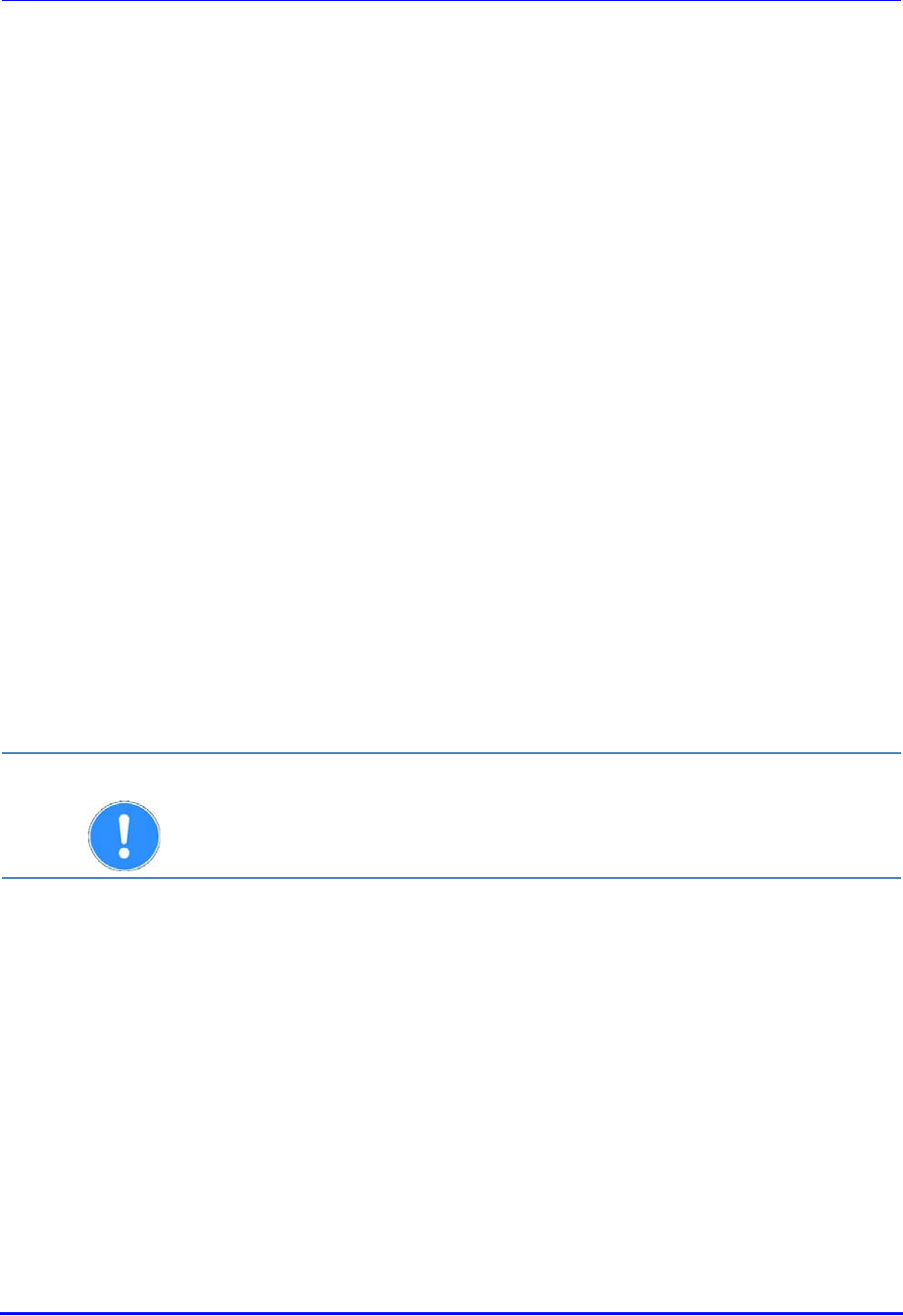
Brooks Automation
98 278580 Revision A
7 Operation LF80C ZeniD RFID Reader
7.3 Operation of SECS Protocol Product Manual
Parameter 29 (0x1D) Transponder load duration (read mode)
The time required to load a transponder during a read process.
The default value (50 ms) should not be changed.
00 .. 255 ms
Default: (50) 50 ms
Parameter 30 (0x1E) r/w synchronize
Enables/disables reader synchronization. If synchronization is enabled, the
reader takes notice of interference or other active readers and synchronizes
the reading cycle.
00 … Synchronization disabled
01 … Synchronization enabled
Default: (01) enabled
Parameter 31 (0x1F) Auto-adjust value (read mode)
The influence of interferences in the environment of the readers can be
minimized by using the automatic adjustment during the operation. If the
parameter is set to defined values (0x00 - 0x40), the reader starts the
adjustment.
In case of automatic adjustment, the reader requires up to two seconds.
During this time the reader cannot receive any serial data.
00 ... 0x3F Range of manual adjustment (read mode only)
0x40 Start automatic adjustment (read and write mode)
Parameter 32 (0x20) Auto-adjust value (write mode)
The influence of interferences in the environment of the readers can be
minimized by using the automatic adjustment during the operation. If the
parameter is set to defined values (0x00 - 0x40), the reader starts the
adjustment.
In the case of automatic adjustment, the reader requires up to two
seconds. During this time the reader cannot receive any serial data.
00 ... 0x3F Range of manual adjustment (write mode only)
0x40 Start automatic adjustment (read and write mode)
IMPORTANT Automatic adjustment changes the adjustment of the read and write
modes (
Î
Parameter 31 (0x1F) and
Î
Parameter 32 (0x20)).

Brooks Automation
278580 Revision A 99
LF80C ZeniD RFID Reader 7 Operation
Product Manual 7.3 Operation of SECS Protocol
Parameter 33 (0x21) Automatic antenna adjustment
The parameter defines the permitted causes for an antenna adjustment.
0 Automatic adjustment is not activated
1 Automatic adjustment only by Tuning button
2 Automatic adjustment only by external command
3 Automatic adjustment by Tuning button or external command
Default: (3) automatic antenna adjustment by Tuning button or external
command
Parameter 34 (0x22) Sensor type for presence sensor
Type of sensor signal to start an automatic read.
0 Automatic read starts if sensor is covered
1 Automatic read starts if sensor is not covered
Default: (0) sensor is covered
Parameter 35 (0x23) Special features
After a hardware reset, the reader offers an automatic read if the presence
sensor is covered.
bit 0: value 0: Execute auto read after reset, if sensor is covered
value 1: Execute no auto read after reset, if sensor is covered
(default)
bit 1: value 0: Execute a sensor triggered auto read (default)
value 1: Execute no sensor triggered auto read
bit 2: without function
bit 3: without function
bit 4: The setting of the LEDs by S18F13 "SetLED" is prioritized
Default: 0x01 (0000 0001)
Parameter 36 (0x24) Lock membrane keyboard
This parameter defines the key statuses of the membrane keyboard. If a bit
is set, it activates the specified button.
xxx0 0001 Tuning button is active in test mode
xxx0 0010 Tuning button is active in normal mode
xxx0 0100 Test button is active
xxx0 1000 Read button is active
xxx1 0000 Write button is active
Default: (0001 1111)

Brooks Automation
100 278580 Revision A
7 Operation LF80C ZeniD RFID Reader
7.3 Operation of SECS Protocol Product Manual
Parameter 37 (0x25) MID area
This parameter defines the range of the MID.
'0' … '10' pages
Default: '2' - MID area = 2 pages = 16 bytes (depends on
Î
Parameter 25
(0x19)).
Parameter 38 (0x26) Test after software reset
This parameter enables/disables the initial test after a software reset.
0 No initial test after software reset
1 Initial test after software reset
Default: (0) No initial test after software reset
Parameter 39 (0x27) Transmitter level (write mode)
The intensity of the field strength to load a transponder during a write
process. The default value (1) should not be changed.
0 Reduced field strength
1 Maximum field strength
Default: (1) Maximum field strength
Parameter 40 (0x28) Transponder load duration (write mode)
The time required to load a transponder during a write process.
The default value (50 ms) should not be changed.
00 .. 255 ms
Default: (50) 50 ms
IMPORTANT See also
Î
Parameter 42 (0x2A) -
Î
Parameter 45 (0x2D) and
Î
Parameter 99 (0x63).
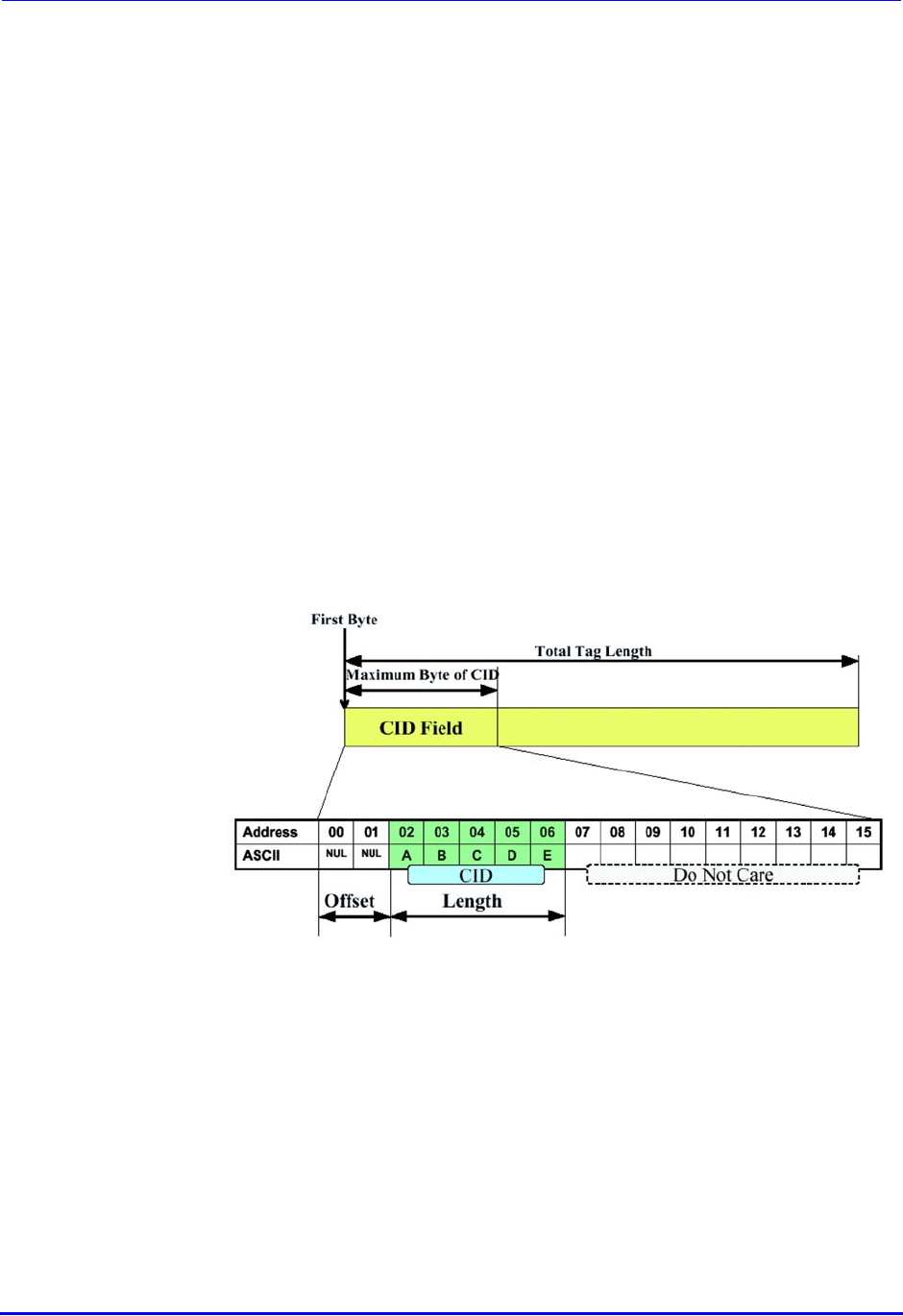
Brooks Automation
278580 Revision A 101
LF80C ZeniD RFID Reader 7 Operation
Product Manual 7.3 Operation of SECS Protocol
Parameter 41 (0x29) Delay time between read cycles
The delay time between two reading cycles. It takes care of the reading
module lifetime.
To increase reading speed, set the delay time to zero. There is no restriction
when using a mini or micro antenna. If you use a frame or rod antenna, the
reading module will approach the boundary conditions. There is no problem
if you read only a few pages or if you have a break between two readings
(all pages). If you want to read all pages continuously without any break,
please use the default value.
00...20 50 ms
Default: (2) 100 ms
Parameter 42 (0x2A) CarrierIDOffset
Defines the offset of the CID within the CID field (MID area -
Î
Parameter
37 (0x25)).
The valid value range depends on the value of the MID area and the value
of the CarrierIDLength.
Valid range 0 … maximum bytes of CID -1
Default: 0
Offset + Length cannot be larger than the length of the CID field.

Brooks Automation
102 278580 Revision A
7 Operation LF80C ZeniD RFID Reader
7.3 Operation of SECS Protocol Product Manual
Parameter 43 (0x2B) CarrierIDLength
Defines the length of the CID within the CID field (MID area -
Î
Parameter
37 (0x25)).
The valid value range depends on the value of the MID area and the value
of the CarrierIDOffset (see
Î
Parameter 42 (0x2A)).
Valid range: 1 … maximum bytes of CID field
Default: 16
Parameter 44 (0x2C) FixedMID
Defines the read, write and error behavior regarding the CarrierIDLength
defined in SEMI E99-0303.
0 Dynamic CID length (to ensure compatibility with older versions).
MID length is variable for writing to the tag.
Reading up to the first non-visible ASCII character.
1 Fixed CID length (to meet the new standard revision).
Length of MID in the tag must be the same as the reader settings.
If
there is a non-visible ASCII character within the CID field, an error
occurs.
Default: 1
Parameter 45 (0x2D) MIDFormat
Defines the physical format of the MID data in the transponder memory.
Affects the messages S18F9/F10 and S18F11/F12.
0 E99 standard format left aligned - meets the
requirement of the SEMI standard E99
1 MID format right aligned – filler byte is ASCII ‘0’ (0x30)
Reading: leading will displayed.
2 MID format right aligned – filler byte is ASCII ‘0’ (0x30)
Reading: leading ‘0’ will not displayed.
Examples: MID string is '123456789ABC'
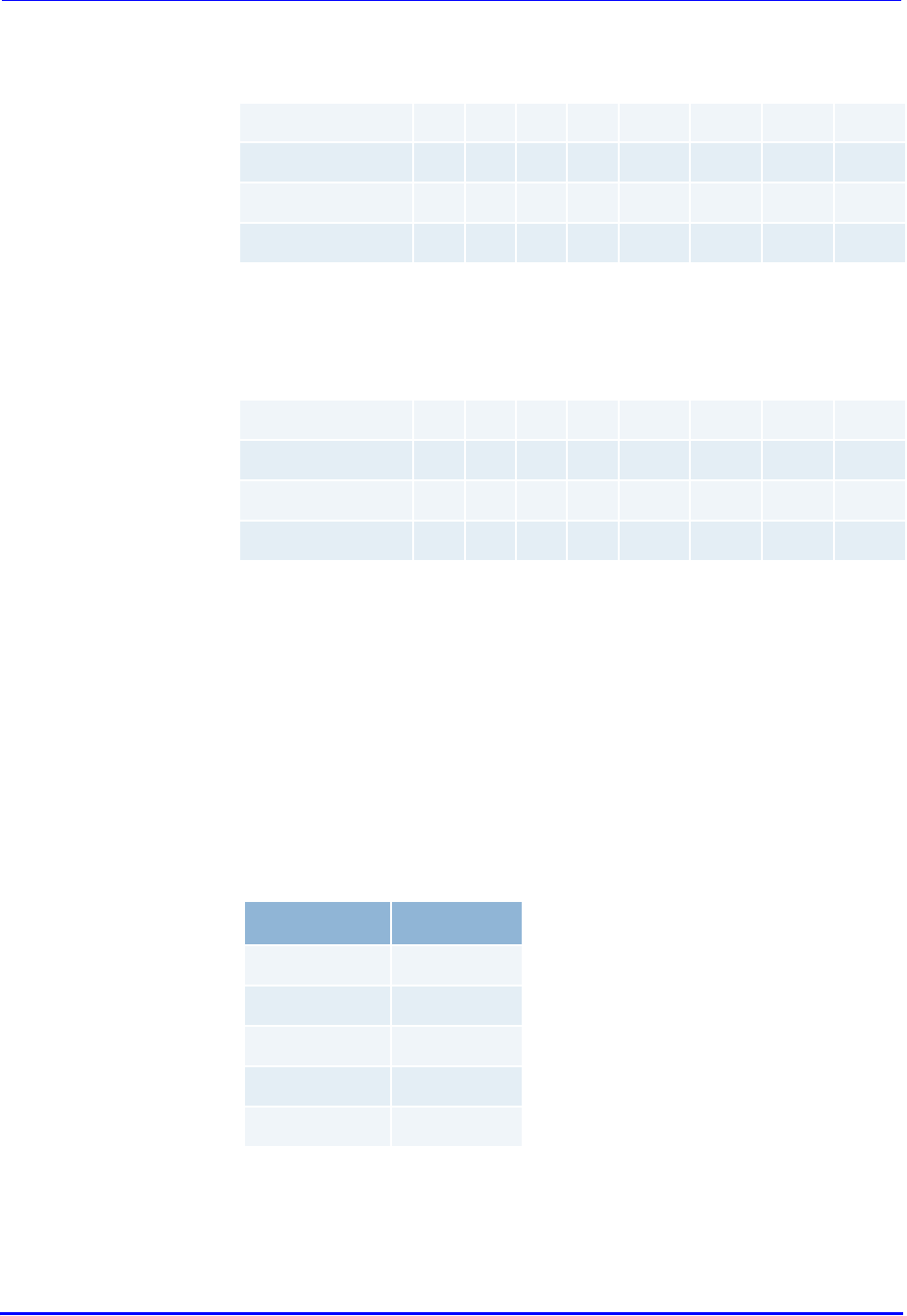
Brooks Automation
278580 Revision A 103
LF80C ZeniD RFID Reader 7 Operation
Product Manual 7.3 Operation of SECS Protocol
Parameter 45 = ’0’
Tag memory:
→ Output string: '123456789ABC'
Parameter 45 = ’1’ or ’2’
Tag memory:
→ Output string (parameter 45 = ‘1’): ‘0000123456789ABC’
→ Output string (parameter 45 = ‘2’): ‘123456789ABC’
Default: 0
Parameter 99 (0x63) Customer code
If the customer requires special parameter settings that deviate from the
default values, a customer code can be assigned by BROOKS to set several
parameter values via one parameter.
The following parameters are defined:
'00' Sets the following parameters:
Reader complies with the last revisions of SEMI E99-0303
'03' Sets the following parameter:
Reader complies with older reader versions before the revision of
SEMI E99-0303.
Page 2 9 A B C 0x00 0x00 0x00 0x00
Memory address 15 14 13 12 11 10 9 8
Page 1 1 2 3 4 5 6 7 8
Memory address 7 6 5 4 3 2 1 0
Page 2 0 0 0 0 1 2 3 4
Memory address 15 14 13 12 11 10 9 8
Page 1 5 6 7 8 9 A B C
Memory address 7 6 5 4 3 2 1 0
Parameter Value
37 2
42 0
43 16
44 1
45 0

Brooks Automation
104 278580 Revision A
7 Operation LF80C ZeniD RFID Reader
7.3 Operation of SECS Protocol Product Manual
Parameter 123
(0x7B)
Fine version
This parameter is used to query the fine version.
7.3.7 SEMI E99
Introduction The purpose of the Carrier ID reader/writer functional standard is to
provide a common specification for concepts, behavior and services
provided by a carrier ID reader/writer to an upstream controller. A standard
interface increases the interchangeability of a carrier ID reader/writer, so
that users and equipment suppliers have a wide choice.
Scope:
The interface standard addresses the functional requirements for a
generic carrier ID reader/writer interface with an upstream
controller.
The specification includes the required behavior and required
communications for a carrier ID reader and writer.
The specification does not require, define or prohibit asynchronous
messages sent by the carrier ID reader or writer.
This standard does not purport to address safety issues, if any,
associated with its use.
Parameter Value
37 1
42 0
43 8
44 0
45 0
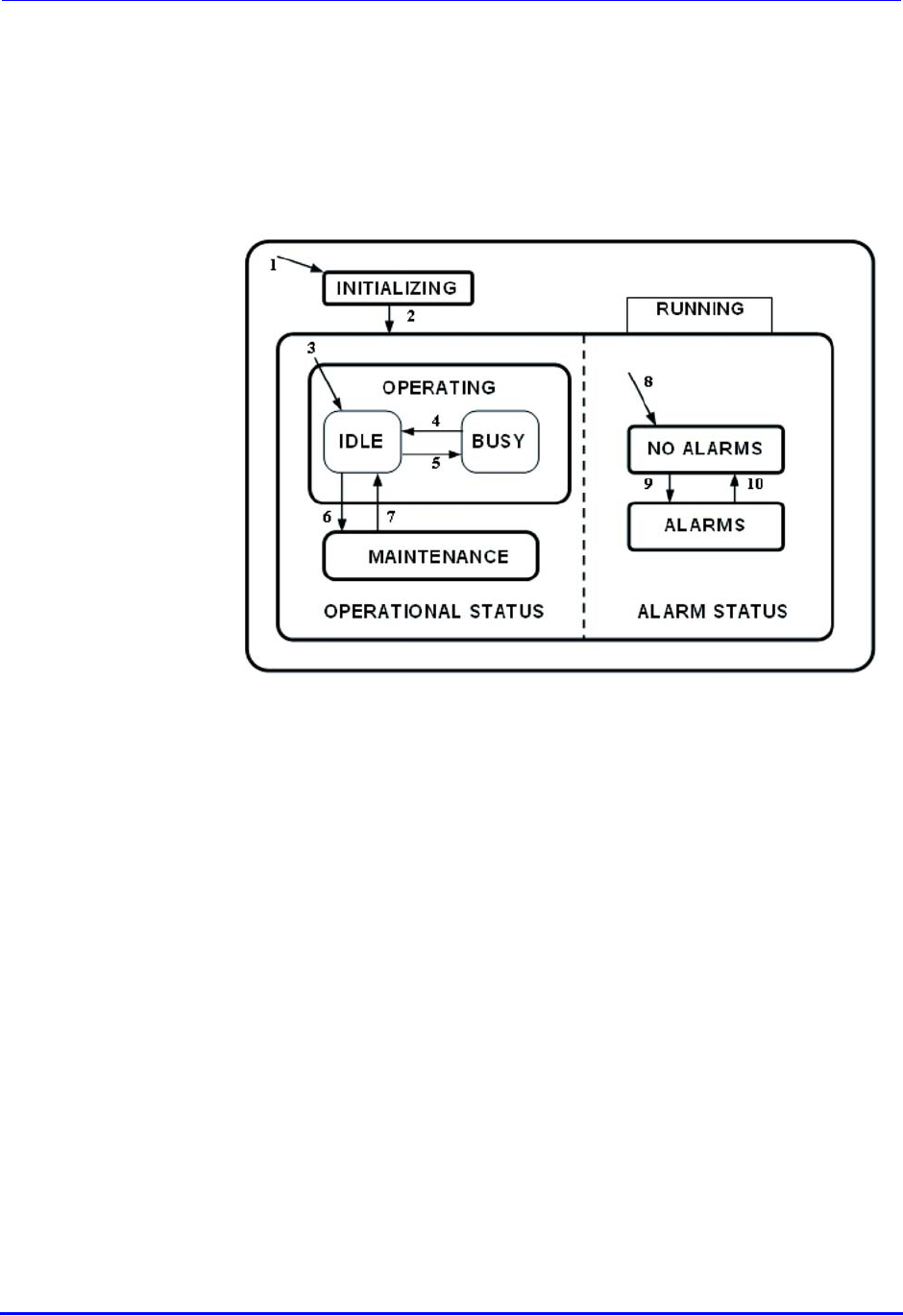
Brooks Automation
278580 Revision A 105
LF80C ZeniD RFID Reader 7 Operation
Product Manual 7.3 Operation of SECS Protocol
Status models To facilitate independent control of the individual heads, there are two
separate status models defined, one for the CIDRW subsystem and one for
each individual head. The BROOKS reader combines the CIDRW subsystem
with the head.
The status model for the BROOKS reader is displayed in the status model
below.

Brooks Automation
106 278580 Revision A
7 Operation LF80C ZeniD RFID Reader
7.3 Operation of SECS Protocol Product Manual
The table below defines the status of the BROOKS RFID reader.
Status Definition
ALARM
STATUS
Displays the presence or absence of alarms.
ALARMS An alarm condition exists.
BUSY A service is being performed that affects the status of
the hardware.
CIDRW Super-status of the CIDRW status model. Always active
when the CIDRW is powered on.
IDLE No service is being performed. All heads are idle.
INITIALIZING The CIDRW is carrying out initialization and a self-
diagnostic. Presence or absence of alarms is initially
determined in this status.
NO ALARMS No alarm condition exists.
OPERATING Normal operating status where reading and/or writing
operations can be performed.
OPERATING
STATUS
The CIDRW is fully capable of performing all services
that it supports.
RUNNING The CIDRW is operational and able to communicate.
MAINTENANCE Internal setup and maintenance activities.
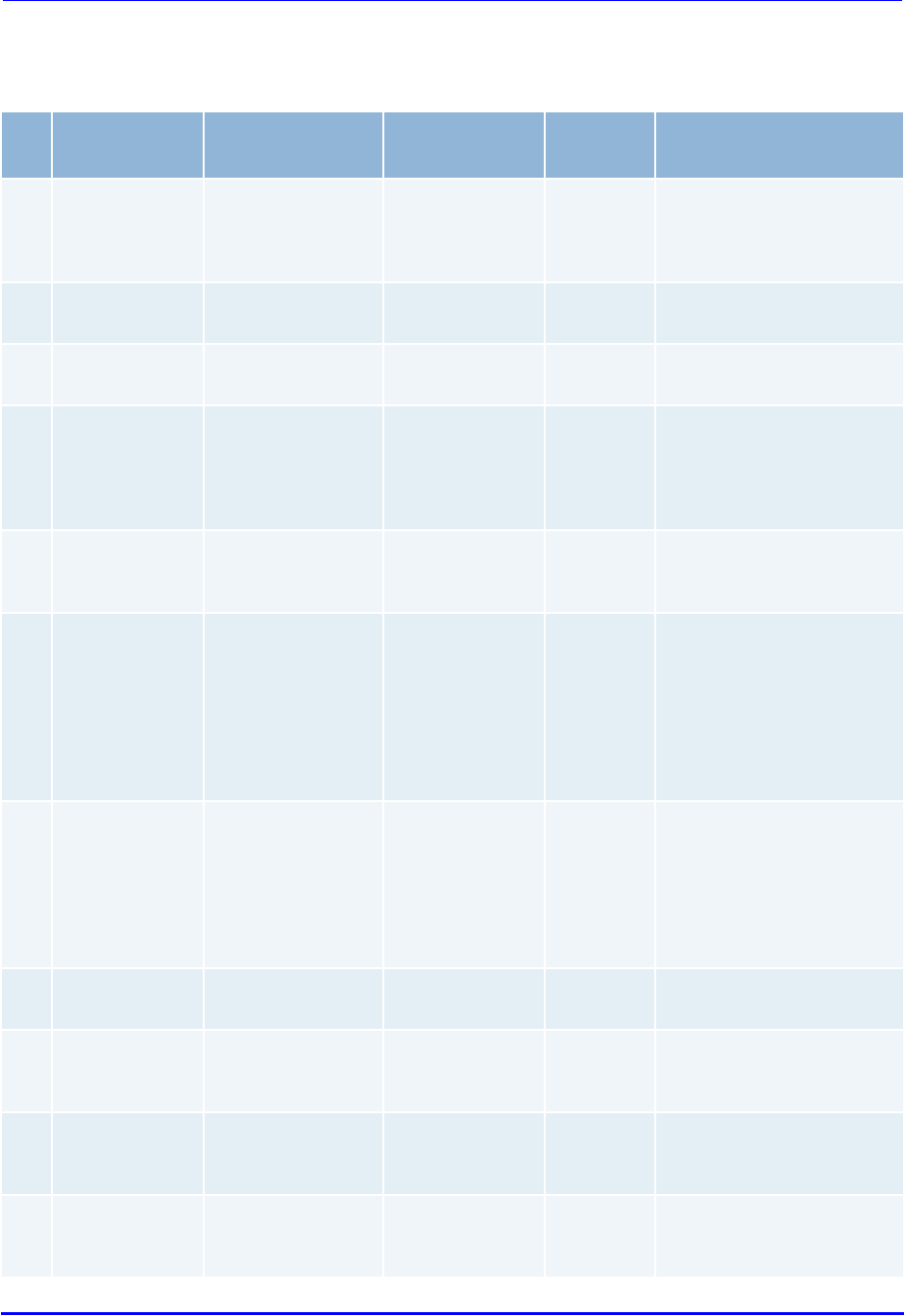
Brooks Automation
278580 Revision A 107
LF80C ZeniD RFID Reader 7 Operation
Product Manual 7.3 Operation of SECS Protocol
The table below defines the transitions of the BROOKS SECS-I status model
of the RFID reader.
#Previous
state Trigger New status Action Comment
1Any Power-up or reset INITIALIZING Initialize
hardware
and
software
Default entry on power-
up
2INITIALIZING Initialization is
complete.
RUNNING None The CIDRW is now able to
communicate.
3INITIALIZING Default entry into
OPERATING
IDLE None Internal
4IDLE A service request
to read or write or
perform
diagnostics is
received.
BUSY None
5BUSY All services
request that
effect
IDLE None
6IDLE A user selects the
MAINTENANCE
status and all
heads are IDLE.
MAINTENANCE None The upstream controller
may send a request or the
operator may set a switch
to select the
MAINTENANCE status.
Maintenance and setup
activities may now be
performed.
7MAINTENANCE A user selects the
OPERATING
status and all
heads are IDLE.
IDLE None The upstream controller
may send a request or the
operator may set a switch
to select the OPERATING
status. Normal operating
activities may now be
performed.
8INITIALIZING Default entry into
ALARM STATUS
ALARMS or NO
ALARMS
None
9NO ALARMS An alarm
condition is
detected.
ALARMS None
10 ALARMS All alarm
conditions have
cleared.
NO ALARMS None
11 Any A reset service
request is
received.
CIDRW None
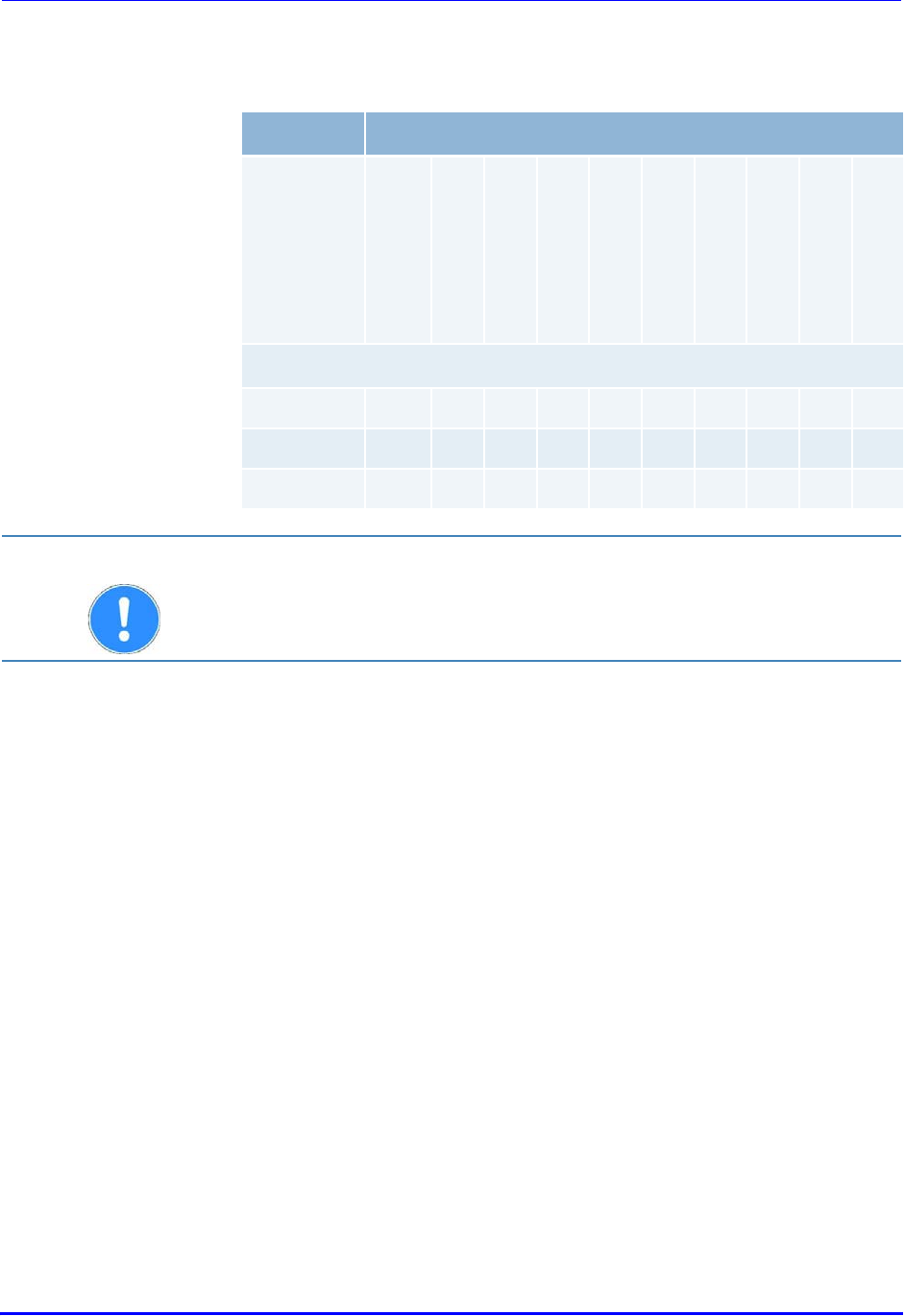
Brooks Automation
108 278580 Revision A
7 Operation LF80C ZeniD RFID Reader
7.3 Operation of SECS Protocol Product Manual
Valid services per
status
The following table shows which of the various services can be performed
by the reader when the reader is in various individual statuses.
Service
Write ID
Write data
Set attributes
Reset
Read ID
Read data
Perform diag.
Request status
Request attributes
Change status
Reader status
INIT
IDLE/BUSY X X X X X X X X X
MANT X X X X X X X X
IMPORTANT Note that the CIDRW may not be able to communicate when in
initializing status after power-up or reset service.

Brooks Automation
278580 Revision A 109
LF80C ZeniD RFID Reader 7 Operation
Product Manual 7.3 Operation of SECS Protocol
7.3.8 Message Details
Equipment status S1F0: ABORT TRANSACTION (reader <-> host)
Used instead of an expected reply to abort a transaction. Function 0 is
defined in every stream and has the same meaning in every stream.
S1F0 W . * Header only
S1F1: ARE YOU THERE REQUEST (reader <-> host, reply)
Establishes if the gateway/reader or host is online.
S1F1 W . * Header only
S1F2: ON-LINE DATA (host -> reader)
The host signals that it is online.
S1F2
<L[2]
<A[6]MDLN >
<A[6]SOFTREV >
>
S1F2: ON-LINE (reader -> host)
The reader signals that it is online.
S1F2
<L[2]
<A[6]MDLN >
<A[6]SOFTREV >
>.
S1F15: REQUEST OFF_LINE (host -> reader, reply)
The reader is requested to change the communication status to offline.
The reader can only be set online again by using message S1F17 (or reset
S2F19); all other messages are aborted by the SxF0 message.
S1F15 W. *Header only
S1F16: OFFLINE ACKNOWLEDGE (reader -> host)
Acknowledge.
S1F16
<B[1]OFLACK>.

Brooks Automation
110 278580 Revision A
7 Operation LF80C ZeniD RFID Reader
7.3 Operation of SECS Protocol Product Manual
S1F17: REQUEST ON_LINE (host -> reader, reply)
The reader is requested to change the communication status to online.
S1F17 W. *Header only
S1F18: ONLINE ACKNOWLEDGE (reader -> host)
Acknowledge.
S1F18
<B[1]ONLACK>.
Equipment control S2F0: ABORT TRANSACTION (reader <-> host)
Used instead of an expected reply to abort a transaction. Function 0 is
defined in every stream and has the same meaning in every stream.
S2F0 W. * Header only
S2F13: EQUIPMENT CONSTANT REQUEST (host -> reader,
reply)
The host requests an attribute from the reader.
S2F13 W
<L[1]
<U1[1] ECID>
>.
S2F14: EQUIPMENT CONSTANT DATA (reader -> host)
The reader sends the requested attribute to the host.
S2F14
<L[1]
<U1[1] ECV>
>.
S2F15: NEW EQUIPMENT CONSTANT SENT (host -> reader,
reply)
The host changes a reader attribute.
S2F15 W
<L[1]
<L[2]
<U1[1] ECID>
<U1[1] ECV>
>
>.

Brooks Automation
278580 Revision A 111
LF80C ZeniD RFID Reader 7 Operation
Product Manual 7.3 Operation of SECS Protocol
S2F16: NEW EQUIPMENT CONSTANT ACKNOWLEDGE (reader -
> host)
The reader acknowledges the setting of the reader parameter.
S2F16
<B[1] EAC>.
S2F19: RESET SENT (host -> reader, reply)
The host requests the reader to reset the hardware and software.
If a heartbeat time is set (
Î
Parameter 9 (0x09)), the reader sends an
S1F1 message when the reset is finished.
The power-up reset requires a few seconds.
S2F19 W
<B[1] RIC>.
S2F20: RESET ACKNOWLEDGE (reader -> host)
The reader acknowledges the reset.
This message is only displayed in case of a power-up reset (RIC=2).
S2F20
<B[1] RAC>.
Material status S3F0: ABORT TRANSACTION (reader <-> host)
Used instead of an expected reply to abort a transaction. Function 0 is
defined in every stream and has the same meaning in every stream.
S3F0 W. * Header Only
S3F5: CASSETTE FOUND SENT (reader -> host, reply)
The reader sends the information that a cassette was detected by the
presence sensor.
This message is sent only if a sensor is connected and activated (see
Î
Parameter 27 (0x1B) and
Î
Parameter 26 (0x1A)).
S3F5 W.
<L[2]
<B[1] MF>
<B[1] PTN>
>.
S3F6: CASSETTE FOUND ACKNOWLEDGE (host -> reader)
The host acknowledges the cassette found message.
S3F6
<B[1] ACKC3>.

Brooks Automation
112 278580 Revision A
7 Operation LF80C ZeniD RFID Reader
7.3 Operation of SECS Protocol Product Manual
S3F7: CASSETTE LOST SEND (reader -> host, reply)
The reader sends the information that the cassette was removed from the
I/O port (presence sensor).
This message is sent only if a sensor is connected and activated (see
Î
Parameter 27 (0x1B)' and
Î
Parameter 26 (0x1A)). The PAGEDATA can be
given only if the PAGEDATA that was read last is still available.
S3F7 W.
<L[3]
<B[1] MF >
<B[1] PTN >
<B[9] PAGEDATA >*
>.
* a zero-length PAGEDATA indicates that no PAGEDATA is available (case of
error)
S3F8: CASSETTE LOST ACKNOWLEDGE (host -> reader)
The host acknowledges the cassette lost message.
S3F8
<B[1] ACKC3>.
S3F11: READ MID AT I/O PORT (host -> reader, reply)
The host requests the reader to read the PAGEDATA of the given PAGE_ID.
S3F11 W
<B[1] PAGE_ID>.
S3F12: READ ACKNOWLEDGE (reader -> host)
The reader only acknowledges the receipt of the reading command.
The PAGEDATA is sent later.
S3F12
<L[3]
<B[1] PTN>*
<B[1] MIDRA>
<B[9] PAGEDATA>**
>.
* a zero-length PTN indicates that no PTN is available
** a zero-length PAGEDATA indicates that no DATA is available

Brooks Automation
278580 Revision A 113
LF80C ZeniD RFID Reader 7 Operation
Product Manual 7.3 Operation of SECS Protocol
S3F13: RETURN READ MID (reader -> host, reply)
The reader sends the ID of the cassette at the I/O port to the host.
S3F13 W
<L[2]
<B[1] PTN>
<B[9] PAGEDATA >
>.
S3F14: MID ACKNOWLEDGE (host -> reader)
The host acknowledges the received data.
S3F14
<B[1] MIDAC>.
S3F65: WRITE MID AT I/O PORT (host -> reader, reply)
The host requests that the reader write the PAGEDATA.
S3F65 W
<B[9] PAGEDATA >
S3F66: WRITE ACKNOWLEDGE (reader -> host)
The reader only acknowledges the receipt of the write command.
The write acknowledge is sent later.
S3F66
<L[2]
<B[1] MIDRA>
<B[9] PAGEDATA >
>.
S3F67: RETURN WRITE SUCCESS (reader -> host, reply)
The reader reports the successful writing of the transponder. The reader
sends information about the presence sensor.
S3F67 W
<B[1] PTN>.
S3F68: WRITE SUCCESS ACKNOWLEDGE (host -> reader)
The host acknowledges the received data.
S3F68
<B[1] MIDAC>.

Brooks Automation
114 278580 Revision A
7 Operation LF80C ZeniD RFID Reader
7.3 Operation of SECS Protocol Product Manual
S3F73: LOCK MID AT I/O PORT (host -> reader, reply)
The host requests the reader to lock the requested page.
S3F73 W
<B[1] PAGE_ID>.
S3F74: LOCK ACKNOWLEDGE (reader -> host)
The reader acknowledges the receipt of the locking command only.
The locking acknowledgment is sent later.
S3F74
<L[2]
<B[1] MIDRA>
<B[9] PAGEDATA >
>.
S3F75: RETURN LOCK SUCCESS (reader -> host, reply)
The reader reports the successful locking of the given page. The reader
sends information about the presence sensor.
S3F75 W
<B[1] PTN>.
S3F76: LOCK SUCCESS ACKNOWLEDGE (host -> reader)
The host acknowledges the receipt of the lock success message (S3F75).
S3F76
<B[1] MIDAC>.
ATTENTION Locking a transponder page is permanent.
You cannot unlock a transponder page.

Brooks Automation
278580 Revision A 115
LF80C ZeniD RFID Reader 7 Operation
Product Manual 7.3 Operation of SECS Protocol
Exception handling S5F0: ABORT TRANSACTION (reader <-> host)
Used instead of an expected reply to abort a transaction. Function 0 is
defined in every stream and has the same meaning in every stream.
S5F0 W . * Header only
S5F1: GATEWAY READER ALARM REPORT SEND (reader ->
host, reply)
The reader reports all errors to the host.
S5F1 W
<L[3]
<B[1] ALCD > * alarm code byte
<B[1] ALID > * alarm ID
<A[MAX 40] ALTX > * alarm text
>.
S5F2: ALARM REPORT ACKNOWLEDGE (host -> reader)
The host acknowledges an alarm.
S5F2
<B[1] ACKC5>.
System errors S9F1: UNRECOGNIZED DEVICE ID (reader -> host)
The device ID in the message block header does not correspond to
expected device ID.
S9F1
<B[10] MHEAD > .
S9F3: UNRECOGNIZED STREAM TYPE (reader -> host)
The reader does not recognize the stream type in the message block
header.
S9F3
< B[10] MHEAD > .
S9F5: UNRECOGNIZED FUNCTION TYPE (reader -> host)
The reader does not recognize the function number in the message block
header.
S9F5
< B[10] MHEAD > .
S9F7: ILLEGAL DATA (reader -> host)
The reader does not recognize the data in the message.
S9F7
< B[10] MHEAD > .

Brooks Automation
116 278580 Revision A
7 Operation LF80C ZeniD RFID Reader
7.3 Operation of SECS Protocol Product Manual
S9F9: TRANSACTION TIMER TIMEOUT (reader -> host)
This message indicates that a transaction timer has timed out and that the
corresponding transaction was aborted. Only the last sent message (which
must be confirmed by the host) is stored and its confirmation is temporally
controlled.
S9F9
< B[10] SHEAD > .
For more information on error codes and the corresponding correcting
actions please refer to .
Subsystem control
and data
S18F1: READ ATTRIBUTE REQUEST (RAR) (host -> reader,
reply)
This message requests the current values of specific attributes of the
subsystem component indicated in the TARGETID.
S18F1 W
L,2
1. <TARGETID>
2. L,n
1. <ATTRID1>
…
n. <ATTRIDn>
S18F2: READ ATTRIBUTE DATA (RAD) (reader -> host)
This message returns the current values of the requested attributes and the
current status of the requested component indicated in the TARGETID.
S18F2
L,4
1. <TARGETID>
2. <SSACK>
3. L,n
1. <ATTRVAL1>
…
n. <ATTRVALn>
4. L,1
L,s
1. <STATUS1>
…
s. <STATUSs>
If the ATTRID of the S18F1 message is unknown, the corresponding
ATTRVAL has the value <nothing>.

Brooks Automation
278580 Revision A 117
LF80C ZeniD RFID Reader 7 Operation
Product Manual 7.3 Operation of SECS Protocol
S18F3: WRITE ATTRIBUTE REQUEST (WAR) (host -> reader,
reply)
This message requests the subsystem to set the value of the read/write
attributes of the component specified in the TARGETID.
S18F3 ,W
L,2
1. <TARGETID>
2. L,n
1. L,2
1. <ATTRID1>
2. <ATTRVAL1>
n. L,2
1. <ATTRIDn>
2. <ATTRVALn>
S18F4: WRITE ATTRIBUTE ACKNOWLEDGE (WAA) (reader ->
host)
This message acknowledges the success or reports the error of the request
to write attribute data to the subsystem indicated in the TARGETID.
S18F4
L,3
1. <TARGETID>
2. <SSACK>
3. L,1
L,s
1. <STATUS1>
…
s. <STATUSs>
If the ATTRID of the S18F3 message is unknown, a communication error
(CE) occurs.

Brooks Automation
118 278580 Revision A
7 Operation LF80C ZeniD RFID Reader
7.3 Operation of SECS Protocol Product Manual
S18F5: READ REQUEST (RR) (host -> reader, reply)
The host requests the subsystem indicated in the TARGETID to read
information. DATASEG may be used to indicate a specific section of data to
be read. DATALENGTH is used to limit the amount of data for that section.
S18F5 W
L,3
1. <TARGETID>
2. <DATASEG>
3. <DATALENGTH>
If DATASEG and DATALENGTH are both omitted (zero length items), then all
pages of the data area are requested. If only DATALENGTH is omitted, all
data within the indicated section is requested.
S18F6: READ DATA (RD) (reader -> host)
This message is used to return requested information from the subsystem
indicated in the TARGETID or to acknowledge the result of the request.
S18F6
L,3
1. <TARGETID>
2. <SSACK>
3. <DATA>
If the TARGETID is unknown, a communication error (CE) occurs.
S18F7: WRITE DATA REQUEST (WAR) (host -> reader, reply)
This message requests to write data to the subsystem component indicated
in the TARGETID. DATASEG may be used to indicate a specific section of the
data area to be written or overwritten.
S18F7 W
L,4
1. <TARGETID>
2. <DATASEG>
3. <DATALENGTH
4. <DATA>
If DATASEG and DATALENGTH are both omitted (zero length items), then all
data in the data area are to be overwritten. If only DATALENGTH is omitted
or if DATALENGTH has a value of zero, then all data within the indicated
section are to be written.
If DATASEG is omitted (zero length items), the value of DATALENGTH sets
the length of data that is to be written. If the length of the data that is to be
written is longer than the value of DATALENGTH, a communication error
(CE) occurs.

Brooks Automation
278580 Revision A 119
LF80C ZeniD RFID Reader 7 Operation
Product Manual 7.3 Operation of SECS Protocol
S18F8: WRITE DATA ACKNOWLEDGE (WDA) (reader -> host)
This message acknowledges the success or failure of writing data to the
subsystem indicated in the TARGETID.
S18F8
L,3
1. <TARGETID>
2. <SSACK>
3. L,1
L,s
1. <STATUS1>
…
s. <STATUSs>
If the TARGETID is unknown, a communication error (CE) occurs.
S18F9: READ ID REQUEST (RIR) (host -> reader, reply)
This message is used to request the subsystem indicated by the TARGETID
to read the MID.
S18F9,W
<TARGETID>
S18F10: READ ID DATA (RID) (reader -> host)
This message returns a requested material identifier MID as read by the
subsystem indicated in the TARGETID.
S18F10
L,4
1. <TARGETID>
2. <SSACK>
3. <MID>
4. L,1
L,s
1. <STATUS1>
…
s. <STATUSs>

Brooks Automation
120 278580 Revision A
7 Operation LF80C ZeniD RFID Reader
7.3 Operation of SECS Protocol Product Manual
S18F11: WRITE ID REQUEST (WIR) (host -> reader, reply)
This message is used to request the subsystem indicated by the TARGETID
to write the MID.
S18F11 W
L,2
1. <TARGETID>
2. <MID>
S18F12: WRITE ID ACKNOWLEDGE (WIA) (reader -> host)
This message acknowledges the success or error of writing the MID to the
subsystem indicated in the TARGETID.
S18F12
L,3
1. <TARGETID>
2. <SSACK>
3. L,1
L,s
1. <STATUS1>
…
s. <STATUSs>
If the TARGETID is unknown, a communication error (CE) occurs.
S18F13: SUBSYSTEM COMMAND REQUEST (SCR) (host ->
reader, reply)
This message is used to request the subsystem indicated in the TARGETID
to perform a specific action.
S18F13 W
L,3
1. <TARGETID>
2. <SSCMD>
3. L,n
1. <CPVAL>
…
n. <CPVALn>
ATTENTION The reader must be in maintenance mode to write the MID with message
S18F11.

Brooks Automation
278580 Revision A 121
LF80C ZeniD RFID Reader 7 Operation
Product Manual 7.3 Operation of SECS Protocol
S18F14: SUBSYSTEM COMMAND ACKNOWLEDGE (SCA) (reader
-> host)
This message reports the result from the subsystem specified in the
TARGETID for the requested action.
S18F14
L,3
1. <TARGETID>
2. <SSACK>
3. L,1
L,s
1. <STATUS1>
…
s. <STATUSs>
If the TARGETID is unknown, a communication error (CE) occurs.
7.3.9 HSMS Message Examples
Starting routine of the HSMS protocol
Outgoing: Length byte ( 00 00 00 0A )
Outgoing: Select.req ( FF FF 00 00 00 01 80 00 00 01 )
Incoming: Length byte ( 00 00 00 0A )
Incoming: Select.rsp ( FF FF 00 00 00 02 80 00 00 01 )
Outgoing: Length byte ( 00 00 00 0A )
Outgoing: Linktest.req ( FF FF 00 00 00 05 80 00 00 02 )
Incoming: Length byte ( 00 00 00 0A )
Incoming: Linktest.req ( FF FF 00 00 00 05 80 00 00 01 )
Outgoing: Length byte ( 00 00 00 0A )
Outgoing: Linktest.rsp ( FF FF 00 00 00 06 80 00 00 01 )
Incoming: Length byte ( 00 00 00 0A )
Incoming: Linktest.rsp ( FF FF 00 00 00 06 80 00 00 02 )
Link test
Incoming: Length byte ( 00 00 00 0A )
Incoming: Linktest.req ( FF FF 00 00 00 05 80 00 00 1C )
Outgoing: Length byte ( 00 00 00 0A )
Outgoing: Linktest.rsp ( FF FF 00 00 00 06 80 00 00 1C )
Separate request
Incoming: Length byte ( 00 00 00 0A )
Incoming: Separate.req ( FF FF 00 00 00 09 80 00 00 03 )

Brooks Automation
122 278580 Revision A
7 Operation LF80C ZeniD RFID Reader
7.3 Operation of SECS Protocol Product Manual
7.3.10 SECS-I Message Examples
All examples are produced with the default gateway-ID 255 (decimal) or
0x00FF (hexadecimal)!
S1F1 Message from the reader to the host
Reader to Host: S1F1
10:30:47 Incoming: ENQ ( 05 )
10:30:47 Outgoing: EOT ( 04 )
10:30:47 Incoming: Length Byte ( 0A )
10:30:47 Incoming: Header ( 81 FF 81 01 80 01 00 01 00 01 )
10:30:47 Incoming: Checksum ( 02 85 )
10:30:47 Outgoing: ACK ( 06 )
Host to Reader: S1F2
10:30:47 Outgoing: ENQ ( 05 )
10:30:47 Incoming: EOT ( 04 )
10:30:47 Outgoing: Length Byte ( 10 )
10:30:47 Outgoing: Header ( 01 FF 01 02 80 01 00 01 00 01 )
10:30:47 Outgoing: Data ( 01 02 41 00 41 00 )
10:30:47 Outgoing: Checksum ( 0B 02 )
10:30:47 Incoming: ACK ( 06 )
S1F1 Message from the host to the reader
Host to Reader: S1F1
10:29:00 Outgoing: ENQ ( 05 )
10:29:00 Incoming: EOT ( 04 )
10:29:00 Outgoing: Length Byte ( 0A )
10:29:00 Outgoing: Header ( 01 FF 81 01 80 01 00 00 00 01 )
10:29:00 Outgoing: Checksum ( 04 02 )
10:29:00 Incoming: ACK ( 06 )
Reader to Host: S1F2
10:29:00 Incoming: ENQ ( 05 )
10:29:00 Outgoing: EOT ( 04 )
10:29:00 Incoming: Length Byte ( 1C )
10:29:00 Incoming: Header ( 81 FF 01 02 80 01 00 00 00 01 )
10:29:00 Incoming: Data ( 01 02 41 06 52 53 72 64 30 31 41 06 56 )
10:29:00 Incoming: Data ( 31 2E 30 2E 30 )
10:29:00 Incoming: Checksum ( 05 B5 )
10:29:00 Outgoing: ACK ( 06 )

Brooks Automation
278580 Revision A 123
LF80C ZeniD RFID Reader 7 Operation
Product Manual 7.3 Operation of SECS Protocol
Message S1F15 sets the reader offline
Host to Reader: S1F15
10:32:53 Outgoing: ENQ ( 05 )
10:32:53 Incoming: EOT ( 04 )
10:32:54 Outgoing: Length Byte ( 0A )
10:32:54 Outgoing: Header ( 01 FF 81 0F 80 01 00 00 00 02 )
10:32:54 Outgoing: Checksum ( 13 02 )
10:32:54 Incoming: ACK ( 06 )
Reader to Host: S1F16
10:32:54 Incoming: ENQ ( 05 )
10:32:54 Outgoing: EOT ( 04 )
10:32:54 Incoming: Length Byte ( 0D )
10:32:54 Incoming: Header ( 81 FF 01 10 80 01 00 00 00 02 )
10:32:54 Incoming: Data ( 21 01 00 )
10:32:54 Incoming: Checksum ( 02 36 )
10:32:54 Outgoing: ACK ( 06 )
Message S1F17 sets the reader online
Host to Reader: S1F17
10:33:24 Outgoing: ENQ ( 05 )
10:33:24 Incoming: EOT ( 04 )
10:33:24 Outgoing: Length Byte ( 0A )
10:33:24 Outgoing: Header ( 01 FF 81 11 80 01 00 00 00 04 )
10:33:24 Outgoing: Checksum ( 17 02 )
10:33:24 Incoming: ACK ( 06 )
Reader to Host: S1F18
10:33:24 Incoming: ENQ ( 05 )
10:33:24 Outgoing: EOT ( 04 )
10:33:24 Incoming: Length Byte ( 0D )
10:33:24 Incoming: Header ( 81 FF 01 12 80 01 00 00 00 04 )
10:33:24 Incoming: Data ( 21 01 00 )
10:33:24 Incoming: Checksum ( 02 3A )
10:33:24 Outgoing: ACK ( 06 )

Brooks Automation
124 278580 Revision A
7 Operation LF80C ZeniD RFID Reader
7.3 Operation of SECS Protocol Product Manual
Request reader attribute with message S2F13
Host to Reader (Gateway): S2F13
10:34:01 Outgoing: ENQ ( 05 )
10:34:01 Incoming: EOT ( 04 )
10:34:01 Outgoing: Length Byte ( 0F )
10:34:01 Outgoing: Header ( 01 FF 82 0D 80 01 00 00 00 05 )
10:34:01 Outgoing: Data ( 01 01 21 01 01 ) → Parameter 1
10:34:01 Outgoing: Checksum ( 3A 02 )
10:34:01 Incoming: ACK ( 06 )
Reader to Host: S2F14
10:34:01 Incoming: ENQ ( 05 )
10:34:01 Outgoing: EOT ( 04 )
10:34:01 Incoming: Length Byte ( 0F )
10:34:01 Incoming: Header ( 81 FF 02 0E 80 01 00 00 00 05 )
10:34:01 Incoming: Data ( 01 01 A5 01 C0 ) → Value 192
10:34:01 Incoming: Checksum ( 03 7E )
10:34:01 Outgoing: ACK ( 06 )
The host requests the reader parameter "1" (transmission rate).
The reader sends the value "C0" (192) that confirms the 19200 baud.
New Reader attribute send with S2F15
Host to Reader: S2F15
10:39:32 Outgoing: ENQ ( 05 )
10:39:32 Incoming: EOT ( 04 )
10:39:32 Outgoing: Length Byte ( 14 )
10:39:32 Outgoing: Header ( 01 FF 82 0F 80 01 00 00 00 07 )
10:39:32 Outgoing: Data
01 01
01 02
A5 01 14 → Parameter 20
A5 01 05 → Value 5
10:39:32 Outgoing: Checksum ( 83 02 )
10:39:32 Incoming: ACK ( 06 )
Reader to Host: S2F16
10:39:32 Incoming: ENQ ( 05 )
10:39:32 Outgoing: EOT ( 04 )
10:39:32 Incoming: Length Byte ( 0D )
10:39:32 Incoming: Header ( 81 FF 02 10 80 01 00 00 00 07 )
10:39:32 Incoming: Data ( 21 01 00 ) → ECV 0
10:39:32 Incoming: Checksum ( 02 3C )
10:39:32 Outgoing: ACK ( 06 )
The Host sets the reader parameter "20" (Sensor delay for presence
sensor) to the value "5".
The reader acknowledges the new constant with ECV = 0.

Brooks Automation
278580 Revision A 125
LF80C ZeniD RFID Reader 7 Operation
Product Manual 7.3 Operation of SECS Protocol
Host requests a software reset with S2F19
Host to Reader: S2F19
11:26:48 Outgoing: ENQ ( 05 )
11:26:48 Incoming: EOT ( 04 )
11:26:48 Outgoing: Length Byte ( 0D )
11:26:48 Outgoing: Header ( 01 FF 82 13 80 01 00 00 00 1C )
11:26:48 Outgoing: Data ( 21 01 02 ) → Software reset
11:26:48 Outgoing: Checksum ( 56 02 )
11:26:48 Incoming: ACK ( 06 )
Reader to Host: S2F20
11:26:48 Incoming: ENQ ( 05 )
11:26:48 Outgoing: EOT ( 04 )
11:26:48 Incoming: Length Byte ( 0D )
11:26:48 Incoming: Header ( 81 FF 02 14 80 01 00 00 00 1C )
11:26:48 Incoming: Data ( 21 01 00 ) → RAC
11:26:48 Incoming: Checksum ( 02 55 )
11:26:48 Outgoing: ACK ( 06 )
The reader sends the message S3F5 after the sensor detects a
cassette
Reader to Host: S3F5
15:51:45 Incoming: ENQ ( 05 )
15:51:46 Outgoing: EOT ( 04 )
15:51:46 Incoming: Length Byte ( 12 )
15:51:46 Incoming: Header ( 81 FF 83 05 80 01 00 03 00 04 )
15:51:46 Incoming: Data
01 02
21 01 20 → MF 0x20
21 01 39 → Initiator=0, Sensor 0=1
15:51:46 Incoming: Checksum ( 03 30 )
15:51:46 Outgoing: ACK ( 06 )
Host to Reader: S3F6
15:51:46 Outgoing: ENQ ( 05 )
15:51:46 Incoming: EOT ( 04 )
15:51:46 Outgoing: Length Byte ( 0D )
15:51:46 Outgoing: Header ( 01 FF 03 06 80 01 00 03 00 04 )
15:51:46 Outgoing: Data ( 21 01 00 ) → ACKC3
15:51:46 Outgoing: Checksum ( B4 01 )
15:51:46 Incoming: ACK ( 06 )

Brooks Automation
126 278580 Revision A
7 Operation LF80C ZeniD RFID Reader
7.3 Operation of SECS Protocol Product Manual
The reader sends the message S3F13 after the sensor was
detected and the transponder could be read
Reader to Host: S3F13
15:51:46 Incoming: ENQ ( 05 )
15:51:46 Outgoing: EOT ( 04 )
15:51:46 Incoming: Length Byte ( 1A )
15:51:46 Incoming: Header ( 81 FF 83 0D 80 01 00 03 00 05 )
15:51:46 Incoming: Data
01 02
21 01 39 → Initiator=0, Sensor 0=1
21 09 81 11 11 11 11 10 00 00 00 → PAGEDATA
15:51:46 Incoming: Checksum ( 03 F6 )
15:51:46 Outgoing: ACK ( 06 )
Host to Reader: S3F14
15:51:46 Outgoing: ENQ ( 05 )
15:51:46 Incoming: EOT ( 04 )
15:51:46 Outgoing: Length Byte ( 0D )
15:51:46 Outgoing: Header ( 01 FF 03 0E 80 01 00 03 00 05 )
15:51:46 Outgoing: Data ( 21 01 00 ) → ACKC3
15:51:46 Outgoing: Checksum ( BD 01 )
15:51:46 Incoming: ACK ( 06 )
The material ID acknowledgment MIDAC depends on the sensor state PTN.
The initiator was the sensor 0 and the host acknowledges with "0".
The reader sends the message S3F7 after the cassette was
removed from the sensor.
Reader to Host: S3F7
15:51:52 Incoming: ENQ ( 05 )
15:51:52 Outgoing: EOT ( 04 )
15:51:52 Incoming: Length Byte ( 1D )
15:51:52 Incoming: Header ( 81 FF 83 07 80 01 00 03 00 06 )
15:51:52 Incoming: Data
01 03
21 01 20 → MF 0x20
21 01 39 → Initiator=0, Sensor 0=1
21 09 81 11 11 11 11 10 00 00 00 Last read PAGEDATA
15:51:52 Incoming: Checksum ( 04 34 )
15:51:52 Outgoing: ACK ( 06 )
Host to Reader: S3F8
15:51:52 Outgoing: ENQ ( 05 )
15:51:52 Incoming: EOT ( 04 )
15:51:52 Outgoing: Length Byte ( 0D )
15:51:52 Outgoing: Header ( 01 FF 03 08 80 01 00 03 00 06 )
15:51:52 Outgoing: Data ( 21 01 00 ) → ACKC3
15:51:52 Outgoing: Checksum ( B8 01 )
15:51:52 Incoming: ACK ( 06 )

Brooks Automation
278580 Revision A 127
LF80C ZeniD RFID Reader 7 Operation
Product Manual 7.3 Operation of SECS Protocol
The reader detects an unrecognized device ID and sends the
message S9F1.
Host to Reader: S1F1
16:42:58 Outgoing: ENQ ( 05 )
16:42:58 Incoming: EOT ( 04 )
16:42:58 Outgoing: Length Byte ( 0A )
16:42:58 Outgoing: Header ( 02 FF 81 01 80 01 00 00 00 31 )
16:42:58 Outgoing: Checksum ( 35 02 )
16:42:58 Incoming: ACK ( 06 )
Reader to Host: S9F1
16:42:58 Incoming: ENQ ( 05 )
16:42:58 Outgoing: EOT ( 04 )
16:42:58 Incoming: Length Byte ( 16 )
16:42:58 Incoming: Header ( 81 FF 09 01 80 01 00 07 00 18 )
16:42:58 Incoming: Data
21 0A 02 FF 81 01 80 01 00 00 00 31 → MHEAD error message
16:42:58 Incoming: Checksum ( 04 8A )
16:42:58 Outgoing: ACK ( 06 )
The device ID in the message block header does not correspond to the
device ID in the reader detecting the error.
The reader detects a wrong stream number and sends the
S9F3 message
Host to Reader: S4F1
20:03:20 Outgoing: ENQ ( 05 )
20:03:20 Incoming: EOT ( 04 )
20:03:20 Outgoing: Length Byte ( 0A )
20:03:20 Outgoing: Header ( 01 FF 84 01 80 01 00 00 00 08 )
20:03:20 Outgoing: Checksum ( 0E 02 )
20:03:20 Incoming: ACK ( 06 )
Reader to Host: S9F3
20:03:20 Incoming: ENQ ( 05 )
20:03:20 Outgoing: EOT ( 04 )
20:03:20 Incoming: Length Byte ( 16 )
20:03:20 Incoming: Header ( 81 FF 09 03 80 01 00 00 00 09 )
20:03:20 Incoming: Data ( 21 0A 01 FF 84 ) =>The wrong message
header
20:03:20 Incoming: Data ( 01 80 01 00 00 00 08 )
20:03:20 Incoming: Checksum ( 04 4F )
20:03:20 Outgoing: ACK ( 06 )
The stream "4" is not part of the BROOKS SECS-II message set, so a S9F3
error message will appear.

Brooks Automation
128 278580 Revision A
7 Operation LF80C ZeniD RFID Reader
7.3 Operation of SECS Protocol Product Manual
The reader detects an unrecognized function and sends the
message S9F5.
Host to Reader: S1F3
19:54:43 Outgoing: ENQ ( 05 )
19:54:43 Incoming: EOT ( 04 )
19:54:43 Outgoing: Length Byte ( 0A )
19:54:43 Outgoing: Header ( 01 FF 81 03 80 01 00 00 00 06 )
19:54:43 Outgoing: Checksum ( 0B 02 )
19:54:43 Incoming: ACK ( 06 )
Reader to Host: S9F5
19:54:43 Incoming: ENQ ( 05 )
19:54:43 Outgoing: EOT ( 04 )
19:54:43 Incoming: Length Byte ( 16 )
19:54:43 Incoming: Header ( 81 FF 09 05 80 01 00 00 00 07 )
19:54:43 Incoming: Data ( 21 0A 01 FF 81 ) =>The wrong message
header
19:54:43 Incoming: Data ( 03 80 01 00 00 00 06 )
19:54:43 Incoming: Checksum ( 04 4C )
19:54:43 Outgoing: ACK ( 06 )
The function "3" is not part of the SECSII message set, so a S9F5 error
message will appear.

Brooks Automation
278580 Revision A 129
LF80C ZeniD RFID Reader 7 Operation
Product Manual 7.3 Operation of SECS Protocol
The reader detects wrong data and sends the S9F7 message
Host to Reader: S2F13
16:49:00 Outgoing: ENQ ( 05 )
16:49:00 Incoming: EOT ( 04 )
16:49:00 Outgoing: Length Byte ( 0F )
16:49:00 Outgoing: Header ( 01 FF 82 0D 80 01 00 00 00 36 )
16:49:00 Outgoing: Data ( 01 01 21 01 0F )
16:49:00 Outgoing: Checksum ( 79 02 )
16:49:00 Incoming: ACK ( 06 )
Reader to Host: S2F14
16:49:00 Incoming: ENQ ( 05 )
16:49:00 Outgoing: EOT ( 04 )
16:49:00 Incoming: Length Byte ( 0E )
16:49:00 Incoming: Header ( 81 FF 02 0E 80 01 00 00 00 36 )
16:49:00 Incoming: Data ( 01 01 A5 00 )
16:49:00 Incoming: Checksum ( 02 EE )
16:49:00 Outgoing: ACK ( 06 )
Reader to Host: S9F7:
16:49:00 Incoming: ENQ ( 05 )
16:49:00 Outgoing: EOT ( 04 )
16:49:00 Incoming: Length Byte ( 16 )
16:49:00 Incoming: Header ( 81 FF 09 07 80 01 00 07 00 1F )
16:49:00 Incoming: Data ( 21 0A 01 FF 82 )
16:49:00 Incoming: Data ( 0D 80 01 00 00 00 36 )
16:49:00 Incoming: Checksum ( 04 A8 )
16:49:00 Outgoing: ACK ( 06 )
The reader replies to the S2F13 equipment constant request message
without data, because the parameter was invalid. Additionally, the reader
sends the S9F7 illegal data message.

Brooks Automation
130 278580 Revision A
7 Operation LF80C ZeniD RFID Reader
7.3 Operation of SECS Protocol Product Manual
The secondary message fails and the reader sends the S9F9
message
Reader to Host: S1F1
20:07:16 Incoming: ENQ ( 05 )
20:07:16 Outgoing: EOT ( 04 )
20:07:16 Incoming: Length Byte ( 0A )
20:07:16 Incoming: Header ( 81 FF 81 01 80 01 00 00 00 01 )
20:07:16 Incoming: Checksum ( 02 84 )
20:07:16 Outgoing: ACK ( 06 )
Host to Reader: S9F9
20:08:01 Incoming: ENQ ( 05 )
20:08:01 Outgoing: EOT ( 04 )
20:08:01 Incoming: Length Byte ( 16 )
20:08:01 Incoming: Header ( 81 FF 09 09 80 01 00 00 00 02 )
20:08:01 Incoming: Data ( 21 0A 81 FF 81 ) =>The stored header
20:08:01 Incoming: Data ( 01 80 01 00 00 00 01 )
20:08:01 Incoming: Checksum ( 04 C3 )
20:08:01 Outgoing: ACK ( 06 )
After sending the S1F1 message, the reader waits for an answer from the
host.
If the secondary message does not appear, a transaction timeout occurs
and the reader sends the S9F9 message.

Brooks Automation
278580 Revision A 131
LF80C ZeniD RFID Reader 7 Operation
Product Manual 7.3 Operation of SECS Protocol
Host requests reader attributes with S18F1
Host to Reader: S18F1
15:19:31 Outgoing: ENQ ( 05 )
15:19:31 Incoming: EOT ( 04 )
15:19:31 Outgoing: Length Byte ( 5A )
15:19:31 Outgoing: Header ( 01 FF 92 01 80 01 00 00 00 03 )
15:19:31 Outgoing: Data (
01 02
41 04 31 32 33 34
01 04
41 0D 43 6F 6E 66 69 67 75 72 61 74 69 6F 6E
41 0B 41 6C 61 72 6D 53 74 61 74 75 73
41 11 4F 70 65 72 61 74 69 6F 6E 61 6C 53 74 61 74 75 73
41 15 53 6F 66 74 77 61 72 65 52 65 76 69 73 69 6F 6E 4C 65 76
65 6C )
15:19:31 Outgoing: Checksum ( CD 02 )
15:19:31 Incoming: ACK ( 06 )
Reader to Host: S18F2
15:19:31 Incoming: ENQ ( 05 )
15:19:31 Outgoing: EOT ( 04 )
15:19:31 Incoming: Length Byte ( 44 )
15:19:31 Incoming: Header ( 81 FF 12 02 80 01 00 00 00 03 )
15:19:31 Incoming: Data
01 04
41 04 31 32 33 34 → TARGETID "1234"
41 02 4E 4F → SSACK "NO"
01 04
41 02 30 31 → Configuration "01"
41 01 30 → Alarmstatus "0"
41 04 49 44 4C 45' → OperationalStatus "IDLE"
41 06 56 31 2E 30 2E 30 → SoftwareRevision Level
01 04 → STATUS <L4>
41 02 4E 45 → PMInformation "NE"
41 01 30 → Alarmstatus "0"
41 04 49 44 4C 45 → OperationalStatus "IDLE"
41 04 49 44 4C 45 → HeadStatus "IDLE"
15:19:31 Incoming: Checksum ( 0C 29 )
15:19:31 Outgoing: ACK ( 06 )
The host requests all fundamental CIDRW attributes defined in ATTRID.
The reader answers with the actual attribute values.

Brooks Automation
132 278580 Revision A
7 Operation LF80C ZeniD RFID Reader
7.3 Operation of SECS Protocol Product Manual
Host writes new reader attributes with S18F3
Host to Reader: S18F3
17:11:07 Outgoing: ENQ ( 05 )
17:11:07 Incoming: EOT ( 04 )
17:11:07 Outgoing: Length Byte ( 77 )
17:11:07 Outgoing: Header ( 01 FF 92 03 80 01 00 00 00 04 )
17:11:07 Outgoing: Data
01 02
41 04 31 32 33 34
01 04
01 02 → Configuration "01"
41 0D 43 6F 6E 66 69 67 75 72 61 74 69 6F 6E
41 02 30 31
01 02 → Alarmstatus "0"
41 0B 41 6C 61 72 6D 53 74 61 74 75 73
41 01 31
01 02 → OperationalStatus "IDLE"
41 11 4F 70 65 72 61 74 69 6F 6E 61 6C 53 74 61 74 75 73
41 04 4D 41 4E 54
01 02 → SoftwareRevisionLevel "V1.0.0"
41 15 53 6F 66 74 77 61 72 65 52 65 76 69 73 69 6F 6E 4C 65
76 65 6C
41 06 56 31 2E 30 2E 30
17:11:07 Outgoing: Checksum ( F2 02 )
17:11:07 Incoming: ACK ( 06 )
Reader to Host: S18F4
17:11:07 Incoming: ENQ ( 05 )
17:11:07 Outgoing: EOT ( 04 )
17:11:07 Incoming: Length Byte ( 2D )
17:11:07 Incoming: Header ( 81 FF 12 04 80 01 00 00 00 04 )
17:11:07 Incoming: Data
01 03
41 04 31 32 33 34 → TARGETID "1234"
41 02 4E 4F → SSACK "NO"
01 01
01 04 → STATUS <L4>
41 02 4E 45 → PMInformation "NE"
41 01 31 → Alarmstatus "1"
41 04 4D 41 4E 54 → OperationalStatus "MANT"
41 04 4E 4F 4F 50 → HeadStatus "NOOP"
17:11:07 Incoming: Checksum ( 08 54 )
17:11:07 Outgoing: ACK ( 06 )
The host writes all fundamental CIDRW attributes defined in ATTRID.
The reader answers with the actual attribute values.

Brooks Automation
278580 Revision A 133
LF80C ZeniD RFID Reader 7 Operation
Product Manual 7.3 Operation of SECS Protocol
Host reads data on page 8 of a multipage transponder with
S18F5
Host to Reader: S18F5
17:52:17 Outgoing: ENQ ( 05 )
17:52:17 Incoming: EOT ( 04 )
17:52:17 Outgoing: Length Byte ( 1A )
17:52:17 Outgoing: Header ( 01 FF 92 05 80 01 00 00 00 08 )
17:52:17 Outgoing: Data
01 03
41 04 31 32 33 34 → TARGETID "1234"
41 02 30 38 → DATASEG "08"
A9 02 00 08 → DATALENGTH 0x08
17:52:17 Outgoing: Checksum ( 91 02 )
17:52:17 Incoming: ACK ( 06 )
Reader to Host: S18F6
17:52:17 Incoming: ENQ ( 05 )
17:52:17 Outgoing: EOT ( 04 )
17:52:17 Incoming: Length Byte ( 20 )
17:52:17 Incoming: Header ( 81 FF 12 06 80 01 00 00 00 08 )
17:52:17 Incoming: Data
01 03
41 04 31 32 33 34 → TARGETID "1234"
41 02 4E 4F → SSACK "NO"
41 08 30 31 32 33 34 35 36 37 → DATA "01234567"
17:52:17 Incoming: Checksum ( 05 F9 )
17:52:17 Outgoing: ACK ( 06 )
The host reads 8 bytes on page 8 of a multipage transponder. The reader
shows the success of the operation with SSACK "NO" (normal operation)
and with the read values.

Brooks Automation
134 278580 Revision A
7 Operation LF80C ZeniD RFID Reader
7.3 Operation of SECS Protocol Product Manual
Host writes data on page 10 with S18F7
Host to Reader: S18F7
13:14:15 Outgoing: ENQ ( 05 )
13:14:15 Incoming: EOT ( 04 )
13:14:15 Outgoing: Length Byte ( 24 )
13:14:15 Outgoing: Header ( 01 FF 92 07 80 01 00 00 00 18 )
13:14:15 Outgoing: Data
01 04
41 04 31 32 33 34 → TARGETID "1234"
41 02 30 41 → DATASEG "0A"
A9 02 00 08 → DATALENGTH 0x08
41 08 41 42 43 44 45 46 47 48 → DATA "ABCDEFGH"
13:14:15 Outgoing: Checksum ( 1A 02 )
13:14:15 Incoming: ACK ( 06 )
Reader to Host: S18F8
13:14:16 Incoming: ENQ ( 05 )
13:14:16 Outgoing: EOT ( 04 )
13:14:16 Incoming: Length Byte ( 2D )
13:14:16 Incoming: Header ( 81 FF 12 08 80 01 00 00 00 18 )
13:14:16 Incoming: Data
01 03
41 04 31 32 33 34 → TARGETID "1234"
41 02 4E 4F → SSACK "NO"
01 01
01 04 → STATUS <L4>
41 02 4E 45 → PMInformation "NE"
41 01 30 → Alarmstatus "0"
41 04 49 44 4C 45 → OperationalStatus "IDLE"
41 04 49 44 4C 45 → HeadStatus "IDLE"
13:14:16 Incoming: Checksum ( 08 3B )
13:14:16 Outgoing: ACK ( 06 )
The host writes the ASCII string "ABCDEFGH" to page 10. The reader
confirms the write command with SSACK "NO" in the S18F8 message.

Brooks Automation
278580 Revision A 135
LF80C ZeniD RFID Reader 7 Operation
Product Manual 7.3 Operation of SECS Protocol
Host reads material ID of a multipage transponder with S18F9
Host to Reader: S18F9
14:31:32 Outgoing: ENQ ( 05 )
14:31:32 Incoming: EOT ( 04 )
14:31:32 Outgoing: Length Byte ( 10 )
14:31:32 Outgoing: Header ( 01 FF 92 09 80 01 00 00 00 2D )
14:31:32 Outgoing: Data
41 04 31 32 33 34 → TARGETID "1234"
14:31:32 Outgoing: Checksum ( 58 02 )
14:31:32 Incoming: ACK ( 06 )
Reader to Host: S18F10
14:31:32 Incoming: ENQ ( 05 )
14:31:32 Outgoing: EOT ( 04 )
14:31:32 Incoming: Length Byte ( 37 )
14:31:32 Incoming: Header ( 81 FF 12 0A 80 01 00 00 00 2D )
14:31:32 Incoming: Data
01 04
41 04 31 32 33 34 → TARGETID "1234"
41 02 4E 4F → SSACK "NO"
41 08 4E 72 2E 30 30 31 32 33 → MID "Nr.00123"
01 01
01 04 → STATUS <L4>
41 02 4E 45 → PMInformation "NE"
41 01 30 → Alarmstatus "0"
41 04 49 44 4C 45 → OperationalStatus "IDLE"
41 04 49 44 4C 45 → HeadStatus "IDLE"
14:31:32 Incoming: Checksum ( 0A 80 )
14:31:32 Outgoing: ACK ( 06 )
The host wants to read the material ID of any transponder. The reader
confirms the success of the read command with SSACK "NO" and returns
the material ID "No.00123" (see
Î
Data items).

Brooks Automation
136 278580 Revision A
7 Operation LF80C ZeniD RFID Reader
7.3 Operation of SECS Protocol Product Manual
Host writes material ID of a multipage transponder with
S18F11
Host to Reader: S18F11
16:46:22 Outgoing: ENQ ( 05 )
16:46:22 Incoming: EOT ( 04 )
16:46:22 Outgoing: Length Byte ( 1C )
16:46:22 Outgoing: Header ( 01 FF 92 0B 80 01 00 00 00 66 )
16:46:22 Outgoing: Data
01 02
41 04 31 32 33 34 → TARGETID "1234"
41 08 4E 72 2E 30 30 41 42 43 → MID "Nr.00ABC"
16:46:22 Outgoing: Checksum ( F3 02 )
16:46:22 Incoming: ACK ( 06 )
Reader to Host: S18F12
16:46:23 Incoming: ENQ ( 05 )
16:46:23 Outgoing: EOT ( 04 )
16:46:23 Incoming: Length Byte ( 2D )
16:46:23 Incoming: Header ( 81 FF 12 0C 80 01 00 00 00 66 )
16:46:23 Incoming: Data
01 03
41 04 31 32 33 34 → TARGETID "1234"
41 02 4E 4F → SSACK "NO"
01 01
01 04 → STATUS <L4>
41 02 4E 45 → PMInformation "NE"
41 01 30 → Alarmstatus "0"
41 04 4D 41 4E 54 → OperationalStatus "MANT"
41 04 4E 4F 4F 50 → HeadStatus "NOOP"
16:46:23 Incoming: Checksum ( 08 BD )
16:46:23 Outgoing: ACK ( 06 )
The host wants to write a new material ID to any transponder. The reader
confirms the success of the write MID command with SSACK "NO". Note:
the material ID can be changed only if the reader is in the maintenance
state (MANT).
If the reader remains in the IDLE state, the command fails and the reader
answers with SSACK "EE" (execute error).

Brooks Automation
278580 Revision A 137
LF80C ZeniD RFID Reader 7 Operation
Product Manual 7.3 Operation of SECS Protocol
Host changes the reader state from IDLE to MANT with S18F13
Host to Reader: S18F13
17:12:29 Outgoing: ENQ ( 05 )
17:12:29 Incoming: EOT ( 04 )
17:12:29 Outgoing: Length Byte ( 25 )
17:12:29 Outgoing: Header ( 01 FF 92 0D 80 01 00 00 00 67 )
17:12:29 Outgoing: Data
01 03
41 04 31 32 33 34 → TARGETID "1234"
41 0B 43 68 61 6E 67 65 53 74 61 74 65
→ SSCMD "ChangeState"
01 01
41 02 4D 54 → CPVAL1 "MT"
17:12:29 Outgoing: Checksum ( 13 02 )
17:12:29 Incoming: ACK ( 06 )
Reader to Host: S18F14
17:12:29 Incoming: ENQ ( 05 )
17:12:29 Outgoing: EOT ( 04 )
17:12:29 Incoming: Length Byte ( 2D )
17:12:29 Incoming: Header ( 81 FF 12 0E 80 01 00 00 00 67 )
17:12:29 Incoming: Data
01 03
41 04 31 32 33 34 → TARGETID "1234"
41 02 4E 4F → SSACK "NO"
01 01
01 04 → STATUS <L4>
41 02 4E 45 → PMInformation "NE"
41 01 30 → Alarmstatus "0"
41 04 4D 41 4E 54 → OperationalStatus "MANT"
41 04 4E 4F 4F 50 → HeadStatus "NOOP"
17:12:29 Incoming: Checksum ( 08 C0 )
17:12:29 Outgoing: ACK ( 06 )
ChangeState is an optional service that requests the CIDRW to change its
operational sub state to MAINTENANCE ("MT") or to OPERATING ("OP").
In the MAINTENANCE state, the reader could not read (S18F5) or write
(S18F7) any DATA in the defined DATASEG.

Brooks Automation
138 278580 Revision A
7 Operation LF80C ZeniD RFID Reader
7.3 Operation of SECS Protocol Product Manual
Host requests a reset with S18F13
Host to Reader: S18F13
11:45:34 Outgoing: ENQ ( 05 )
11:45:34 Incoming: EOT ( 04 )
11:45:34 Outgoing: Length Byte ( 1F )
11:45:34 Outgoing: Header ( 01 FF 92 0D 80 01 00 00 00 3F )
11:45:34 Outgoing: Data
01 03
41 04 31 32 33 34 → TARGETID "1234"
41 05 52 65 73 65 74 → SSCMD "Reset"
01 01
41 02 4D 54 → CPVAL1 "MT"
11:45:34 Outgoing: Checksum ( A1 02 )
11:45:34 Incoming: ACK ( 06 )
Reader to Host: S18F14
11:45:34 Incoming: ENQ ( 05 )
11:45:34 Outgoing: EOT ( 04 )
11:45:34 Incoming: Length Byte ( 2D )
11:45:34 Incoming: Header ( 81 FF 12 0E 80 01 00 00 00 3F )
11:45:34 Incoming: Data
01 03
41 04 31 32 33 34 → TARGETID "1234"
41 02 4E 4F → SSACK "NO"
01 01
01 04 → STATUS <L4>
41 02 4E 45 → PMInformation "NE"
41 01 30 → Alarmstatus "0"
41 04 49 44 4C 45 → OperationalStatus "IDLE"
41 04 49 44 4C 45 → HeadStatus "IDLE"
11:45:34 Incoming: Checksum ( 08 68 )
11:45:34 Outgoing: ACK ( 06 )
Reset is an optional service used to reinitialize the reader. If reader
parameter 9 is unequal to 0x00, the reset causes a S1F1 "Are you there"
message from the reader.

Brooks Automation
278580 Revision A 139
LF80C ZeniD RFID Reader 7 Operation
Product Manual 7.3 Operation of SECS Protocol
The reader detects a wrong TARGETID
Host to Reader: S18F5
13:44:33 Outgoing: ENQ ( 05 )
13:44:33 Incoming: EOT ( 04 )
13:44:33 Outgoing: Length Byte ( 1A )
13:44:33 Outgoing: Header ( 01 FF 92 05 80 01 00 00 00 40 )
13:44:33 Outgoing: Data
01 03
41 04 30 30 30 30 → TARGETID "0000"
41 02 30 31 → DATASEG "01"
A9 02 00 08 → DATALENGTH 0x08
13:44:33 Outgoing: Checksum ( B8 02 )
13:44:33 Incoming: ACK ( 06 )
Reader to Host: S18F6
13:44:33 Incoming: ENQ ( 05 )
13:44:33 Outgoing: EOT ( 04 )
13:44:33 Incoming: Length Byte ( 18 )
13:44:33 Incoming: Header ( 81 FF 12 06 80 01 00 00 00 40 )
13:44:33 Incoming: Data
01 03
41 04 31 32 33 34 → TARGETID "1234"
41 02 43 45 → SSACK "CE"
41 00 → DATA ""
13:44:33 Incoming: Checksum ( 04 78 )
13:44:33 Outgoing: ACK ( 06 )
The TARGETID in the S18F5 message does not correspond to the TARGETID
in the reader detecting the error. The reader therefore answers with a
communication error "CE".

Brooks Automation
140 278580 Revision A
7 Operation LF80C ZeniD RFID Reader
7.3 Operation of SECS Protocol Product Manual
The reader detects no tag
Host to Reader: S18F5
17:29:25 Outgoing: ENQ ( 05 )
17:29:25 Incoming: EOT ( 04 )
17:29:25 Outgoing: Length Byte ( 1A )
17:29:25 Outgoing: Header ( 01 FF 92 05 80 01 00 00 00 43 )
17:29:25 Outgoing: Data
01 03
41 04 31 32 33 34 → TARGETID "1234"
41 02 30 31 → DATASEG "01"
A9 02 00 08 → DATALENGTH 0x08
17:29:25 Outgoing: Checksum ( C5 02 )
17:29:25 Incoming: ACK ( 06 )
Reader to Host: S18F6
17:29:27 Incoming: ENQ ( 05 )
17:29:27 Outgoing: EOT ( 04 )
17:29:27 Incoming: Length Byte ( 18 )
17:29:27 Incoming: Header ( 81 FF 12 06 80 01 00 00 00 43 )
17:29:27 Incoming: Data
01 03
41 04 31 32 33 34 → TARGETID "1234"
41 02 54 45 → SSACK "TE"
41 00 → DATA ""
17:29:27 Incoming: Checksum ( 04 8C )
17:29:27 Outgoing: ACK ( 06 )
The reader receives a valid S18F5 message.
If there is no tag in the reading (writing) range of the antenna, the reader
answers with a tag error "TE".
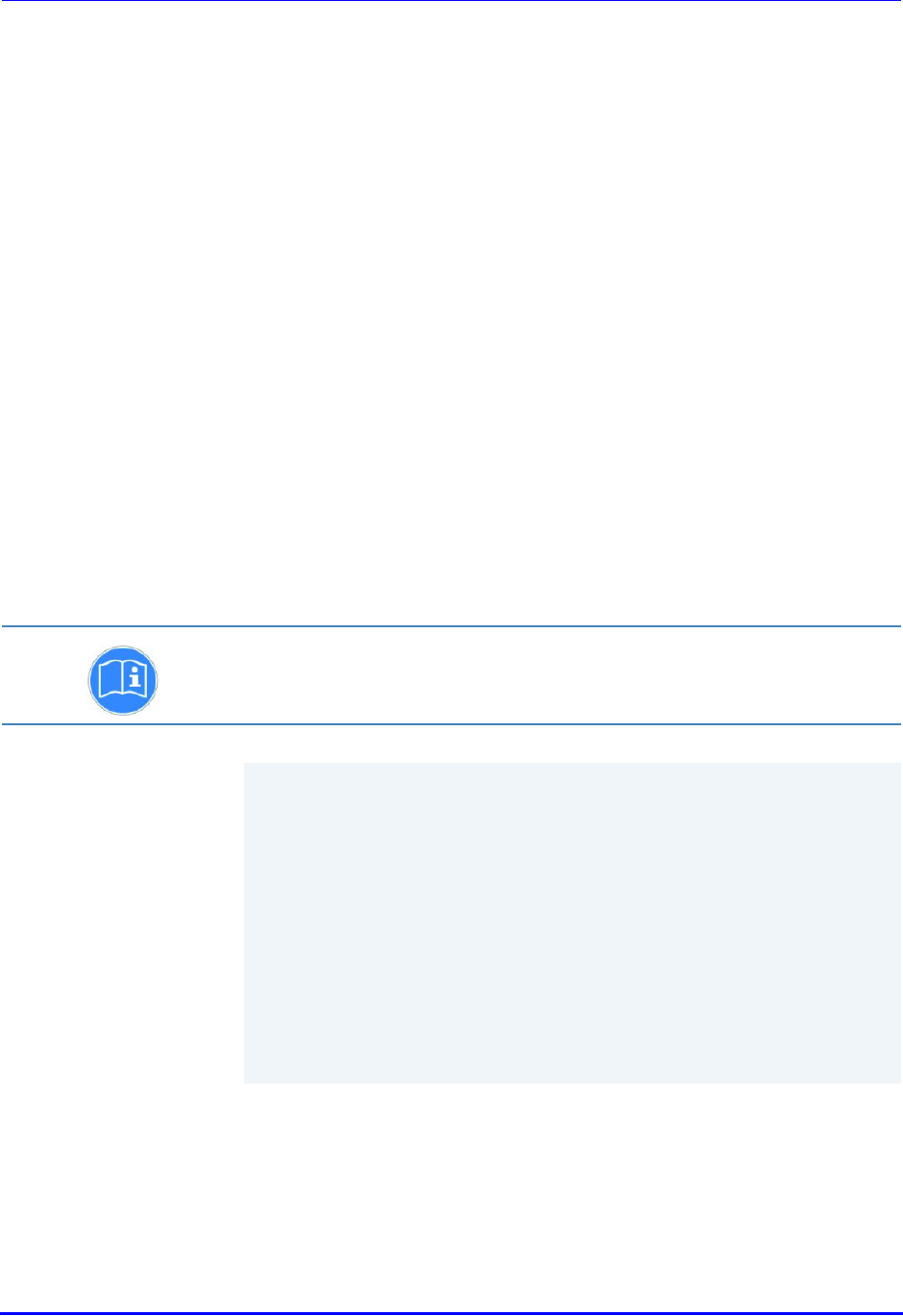
Brooks Automation
278580 Revision A 141
LF80C ZeniD RFID Reader 8 Service and Troubleshooting
Product Manual 8.1 General
8 Service and Troubleshooting
This chapter gives you an overview of the following topics:
Î
General
Î
Qualified Troubleshooting Personnel
Î
Safety Instructions
Î
Error Codes
Î
Error Display with LED
Î
Reader Does Not Respond
Î
Reset
Î
Power Cut
Î
Protocol Switching
Î
Software Releases
Î
Customer Service
8.1 General
Follow the instructions specified in the safety chapter
Follow the general safety information in the chapter
Î
Safety
Instructions.
ÂThe RFID reader and its components must be serviced by the
manufacturer only!
ÂIf errors occur, follow the instructions in this section. Do not
carry out any error eliminating measures other than the ones
described in this section!
ÂIf you are uncertain about errors and their handling, contact
the manufacturer, see
Î
Visit us online: www.brooks.com.
Have the serial number of the RFID reader ready as shown on
the label (see
Î
Device Label) when contacting the
manufacturer!
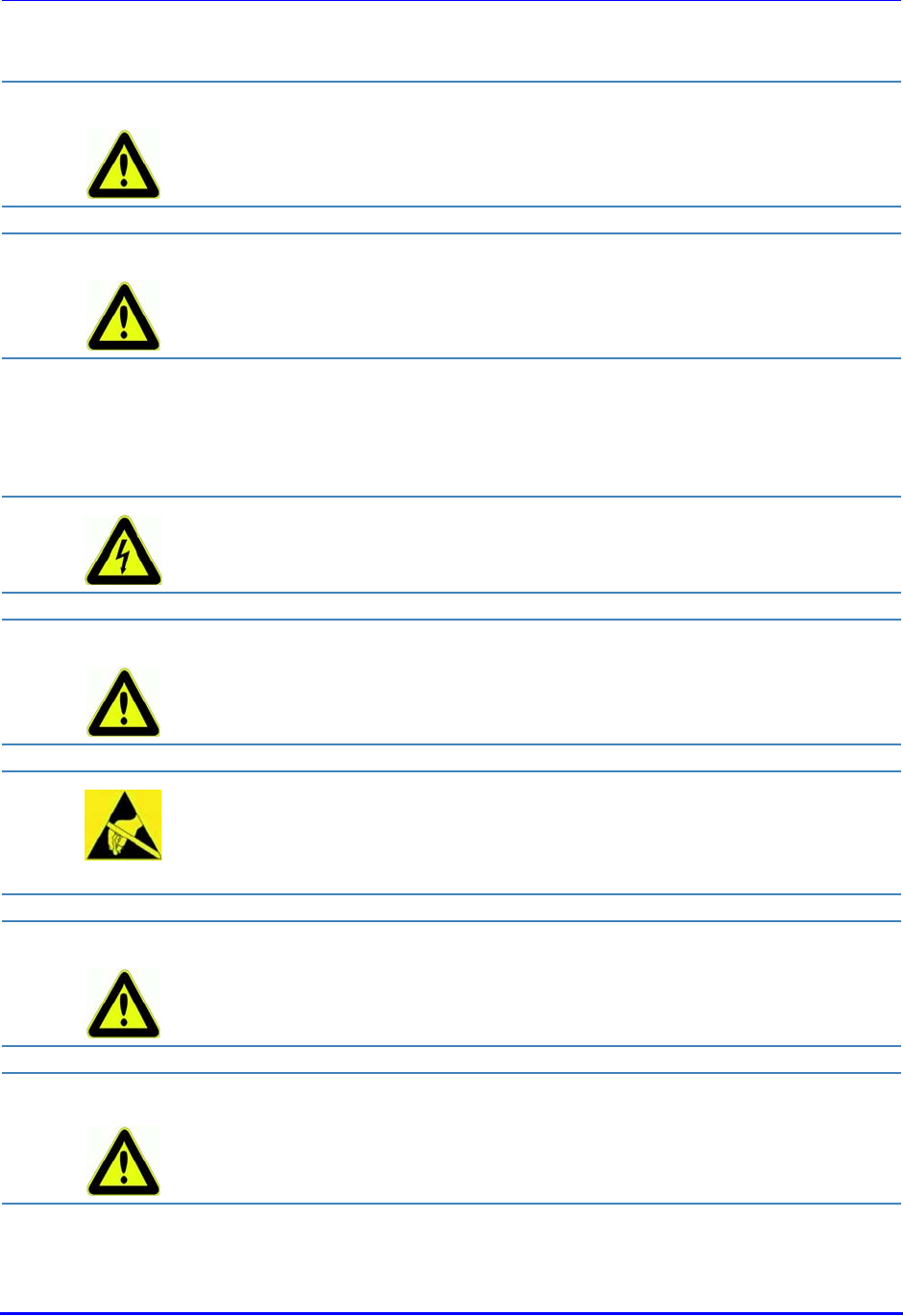
Brooks Automation
142 278580 Revision A
8 Service and Troubleshooting LF80C ZeniD RFID Reader
8.2 Qualified Troubleshooting Personnel Product Manual
8.2 Qualified Troubleshooting Personnel
8.3 Safety Instructions
CAUTION Error handling shall be carried out by specially trained personnel only. If
you are uncertain about the qualifications that are required, contact the
manufacturer.
CAUTION Error handling the device without the special skills required and
unqualified interference with the device can result in personal injury and
damage to the reader and/or connected devices.
All antenna resonant circuit components carry high voltages.
WARNING When spare parts are required, use only manufacturer-specified parts.
Unauthorized substitution of parts can result in fire, electric shock or
other hazards.
Electrostatic charges can damage electronic components within the
device.
ESD protective measures must be applied when opening the device (
Î
ESD Instructions).
CAUTION Never short-circuit the fuse! This may result in fire or damage to the
device.
Only use fuses specified by the manufacturer.
CAUTION When removing the housing lid, note that the housing lid is connected to
the case with a cable.
Remove the lid carefully to prevent damage - do not pull it! Do not
operate the device when the housing lid is removed!
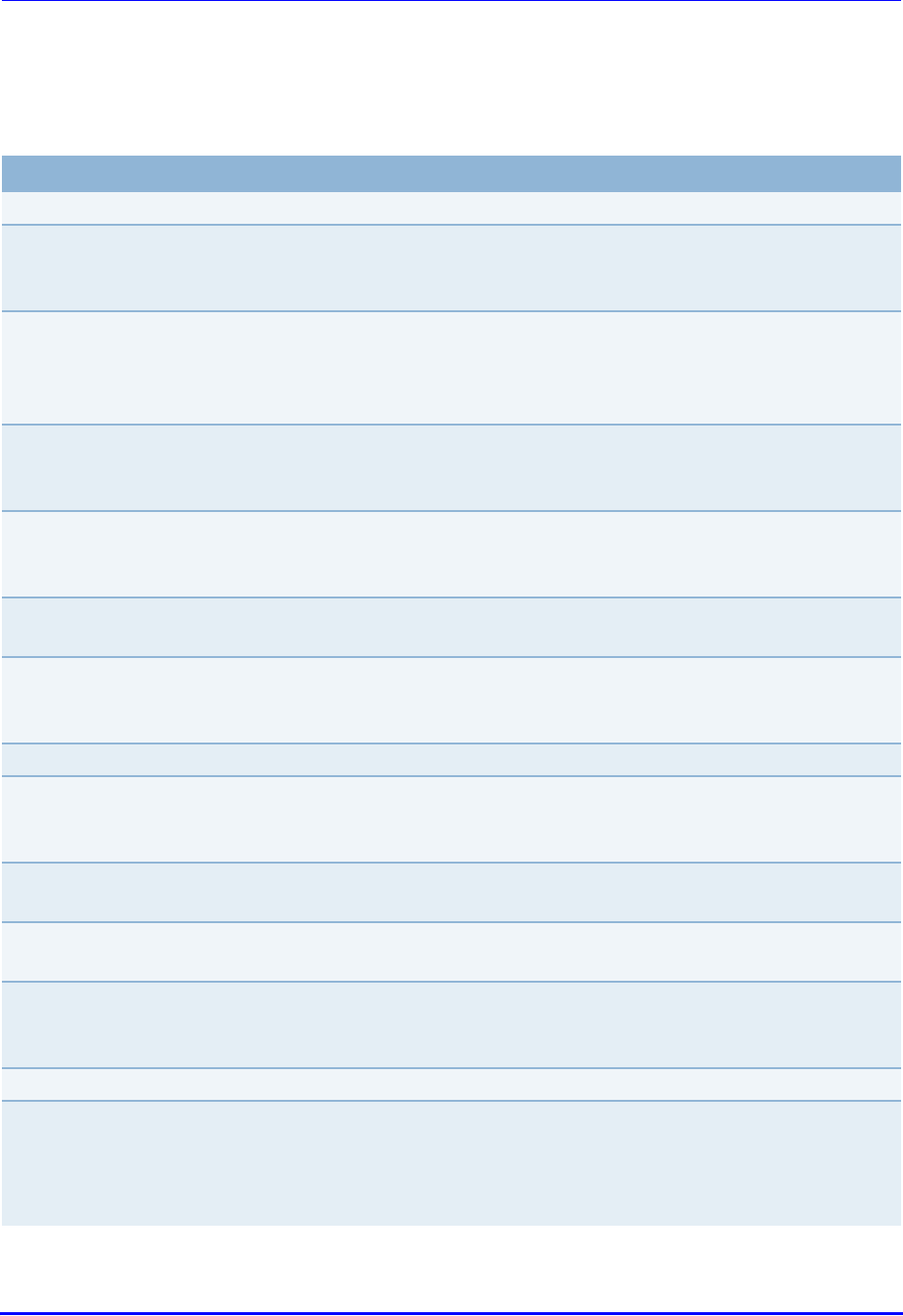
Brooks Automation
278580 Revision A 143
LF80C ZeniD RFID Reader 8 Service and Troubleshooting
Product Manual 8.4 Error Codes
8.4 Error Codes
8.4.1 Error ID and Alarm ID
ID Name Description Possible cause Correcting action
0none no error not used no
1auto fail automatic reading is
not possible *
reader is still busy
with a former read or
write request
wait until the former request is
done
2ex fail read or write initiated
from the host and/or
other actions cannot be
carried out *
reader is still busy
with a former read or
write request
wait until the former request is
done
3write fail data transfer to the
transponder not possi-
ble *
reader is still busy
with a former read or
write request
wait until the former request is
done
4no tag no transponder or
antenna is installed
no readable tag within
the reading range
put a transponder into the
antenna range, verify type and
function of the transponder
antenna is not
connected correctly
check antenna connection
antenna and
transponder are in a
bad orientation
check orientation between
antenna and transponder (see
Î
Antenna Installation)
antenna is not tuned perform an antenna tuning
disturbing field at
transmitting
frequency
check antenna surroundings for
possible disturbing sources
(monitors, servo motors, ...)
antenna is damaged
or too close to metal
exchange antenna, verify
antenna installation
5invalid invalid parameter or
data
data sent with a
command are wrong
check syntax and data of
command
sent parameter is not
implemented or is out
of range
check syntax and value of
parameter
6unknown unknown error not used no
7unconfig the device is not
configured
wrong reader address
is sent
check syntax of message,
check parameter F „Reader
address“
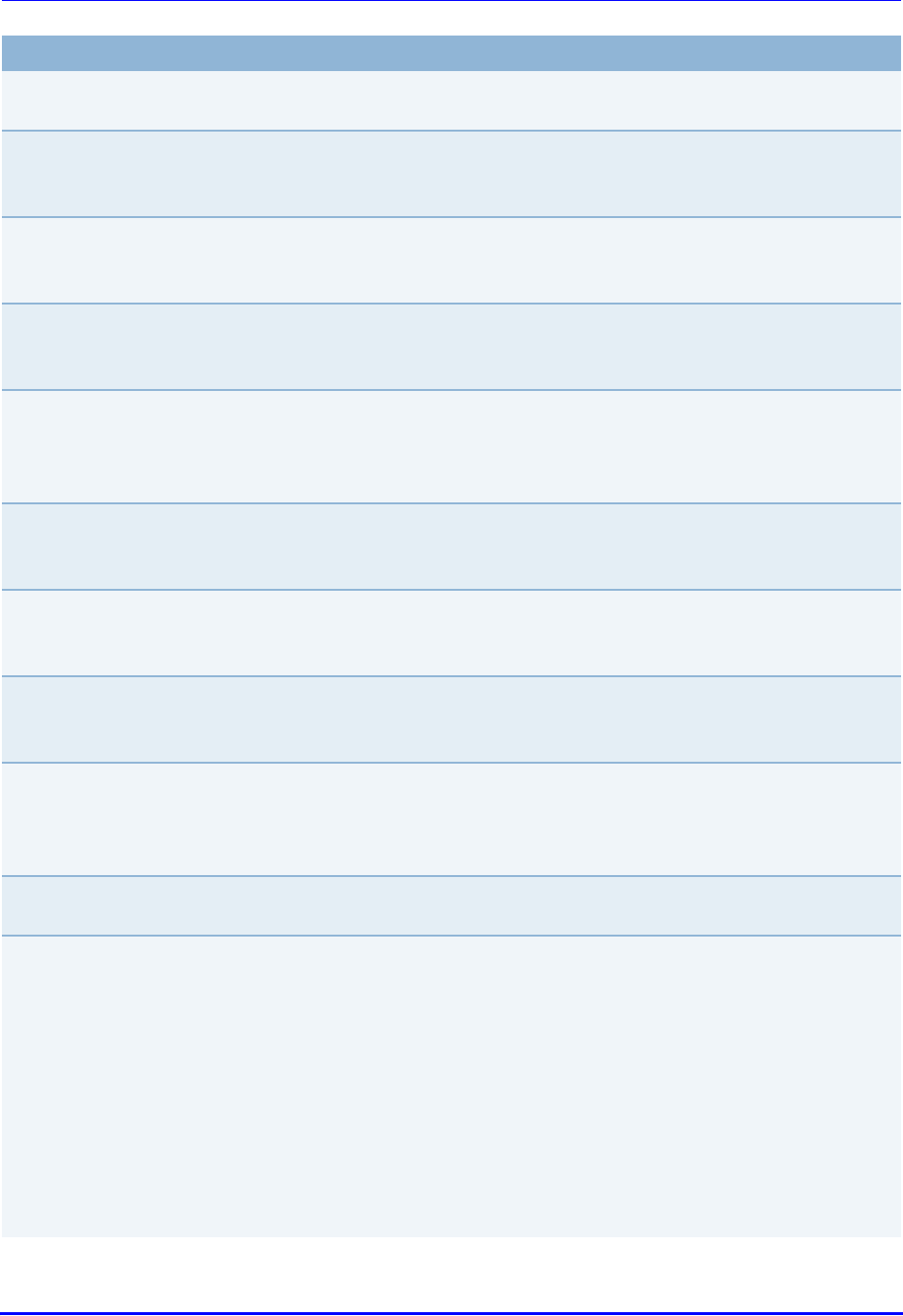
Brooks Automation
144 278580 Revision A
8 Service and Troubleshooting LF80C ZeniD RFID Reader
8.4 Error Codes Product Manual
8check parity and/or checksum
error
wrong baud rate is set check baud rate of serial
interface (COM port)
transmission errors on
serial communication
check RS232 cable and
connectors, check disturbing
sources at RS232
9void ackn
no valid acknowledge
(unexpected
acknowledge)
double or wrong
acknowledgment
check host communication
settings
serial communication
is interrupted
check RS232 cable and
connectors, check disturbing
sources at RS232
Ethernet communica-
tion is interrupted
check Ethernet cable and con-
nectors, check the Link LED
and the Traffic LED, verify IP
address settings
A (10) locked locked page cannot be
written
page to be written is
locked (permanently
write protected)
check page number to write,
replace tag with new one
:msg len
message too long or
too short or message is
not received completely
length of message is
longer than shown at
the length byte
check message length, check
length byte
no valid end sign of
message (end sign
0xD) detected
check syntax of message
not all characters are
transmitted
(Intercharacter
timeout)
check syntax of messages,
check RS232 or Ethernet
connection
;invalid invalid command unknown command
was sent
check syntax of command
B (11) no ackn the message which has
to be confirmed has
been sent the
maximum number of
times (RS232
maxrepeat) and has
not been confirmed by
the terminal within the
defined time frame
(see
Î
Parameter 5
(0x05))
host system does not
acknowledge the
message
check availability of the host
system (terminal), check
RS232 cables and connectors,
check Ethernet cable and
connectors, check the Connect
LED and the Traffic LED, verify
IP address settings
ID Name Description Possible cause Correcting action
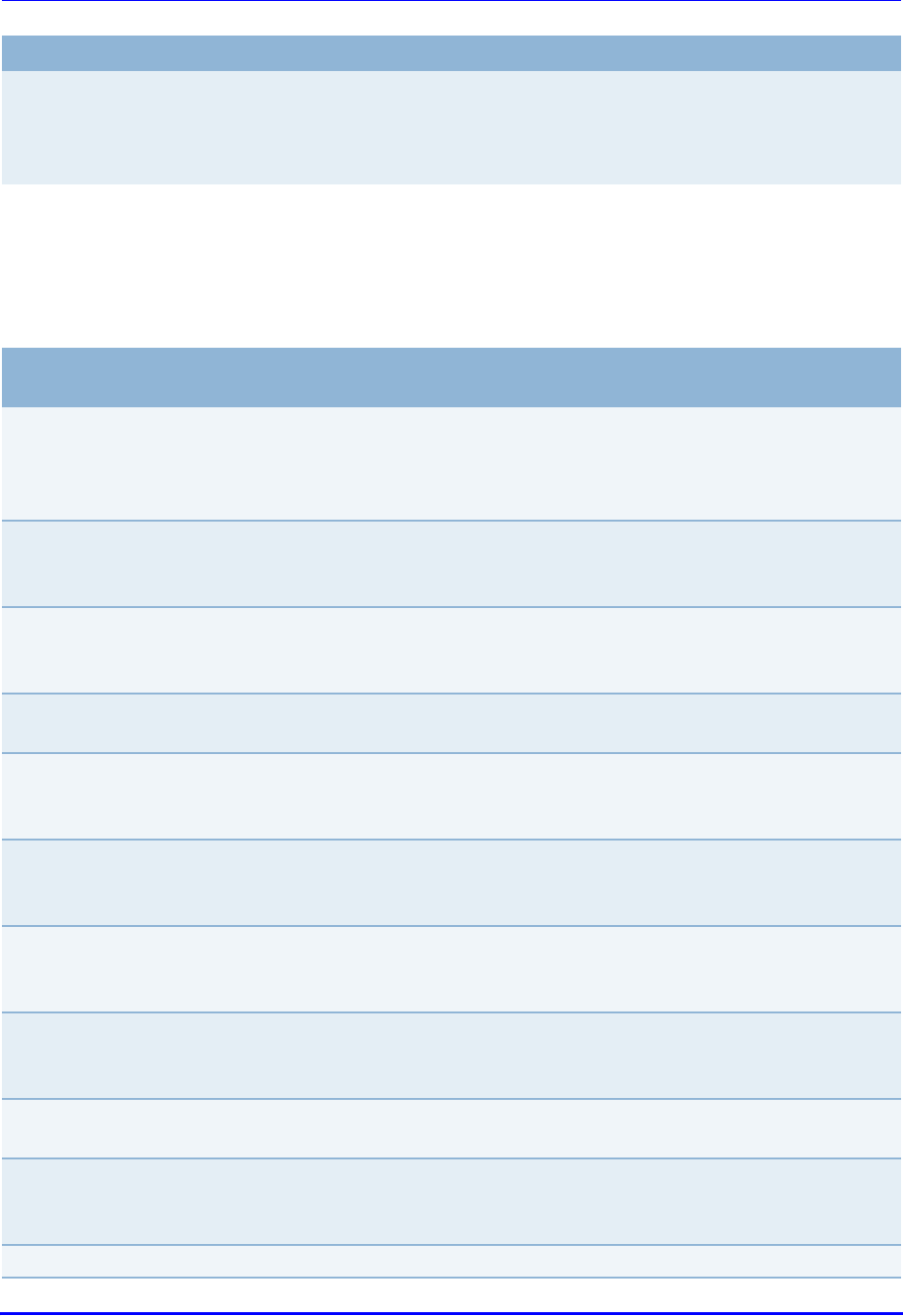
Brooks Automation
278580 Revision A 145
LF80C ZeniD RFID Reader 8 Service and Troubleshooting
Product Manual 8.4 Error Codes
* because the device is still busy or because a message has not been
confirmed by the previous read up to now
8.4.2 SSACK
C (12) bad type incorrect transponder
type
incorrect transponder
type is used (read
only or read/write
instead of Multipage)
check transponder type and
replace it
ID Name Description Possible cause Correcting action
SSAC
KName Description Possible cause Correcting action
EE Execute
error
transponder data and
read ID sequence can-
not be read
transponder has no or
too less valid ASCII
characters on MID
area
program transponder with valid
ASCII characters on MID area
parameters for MID
area are not match-
ing transponder data
set reader parameters for MID
area corresponding to tran-
sponder data area for the MID
reader is still busy
with a former read or
write request
wait until the former request is
done
incorrect reader mode
for operation
switch to correct mode (MANT
for writing MID)
CE
Communi-
cation
error
syntax error of mes-
sage ore message for-
mat or incorrect value
data sent with a com-
mand are wrong
check syntax and data of com-
mand
list format, amount of
lists or data type is
wrong
check syntax of SECS message
sent parameter is not
implemented or not
within the range
check syntax and parameter
value
TE Tag error no transponder or
antenna installed
no readable tag within
the reading range
put a transponder into the
antenna range, verify type and
function of the transponder
antenna is not
connected correctly
check antenna connection
antenna and
transponder are in a
bad orientation
check orientation between
antenna and transponder (see
Î
Antenna Installation)
antenna is not tuned perform an antenna tuning
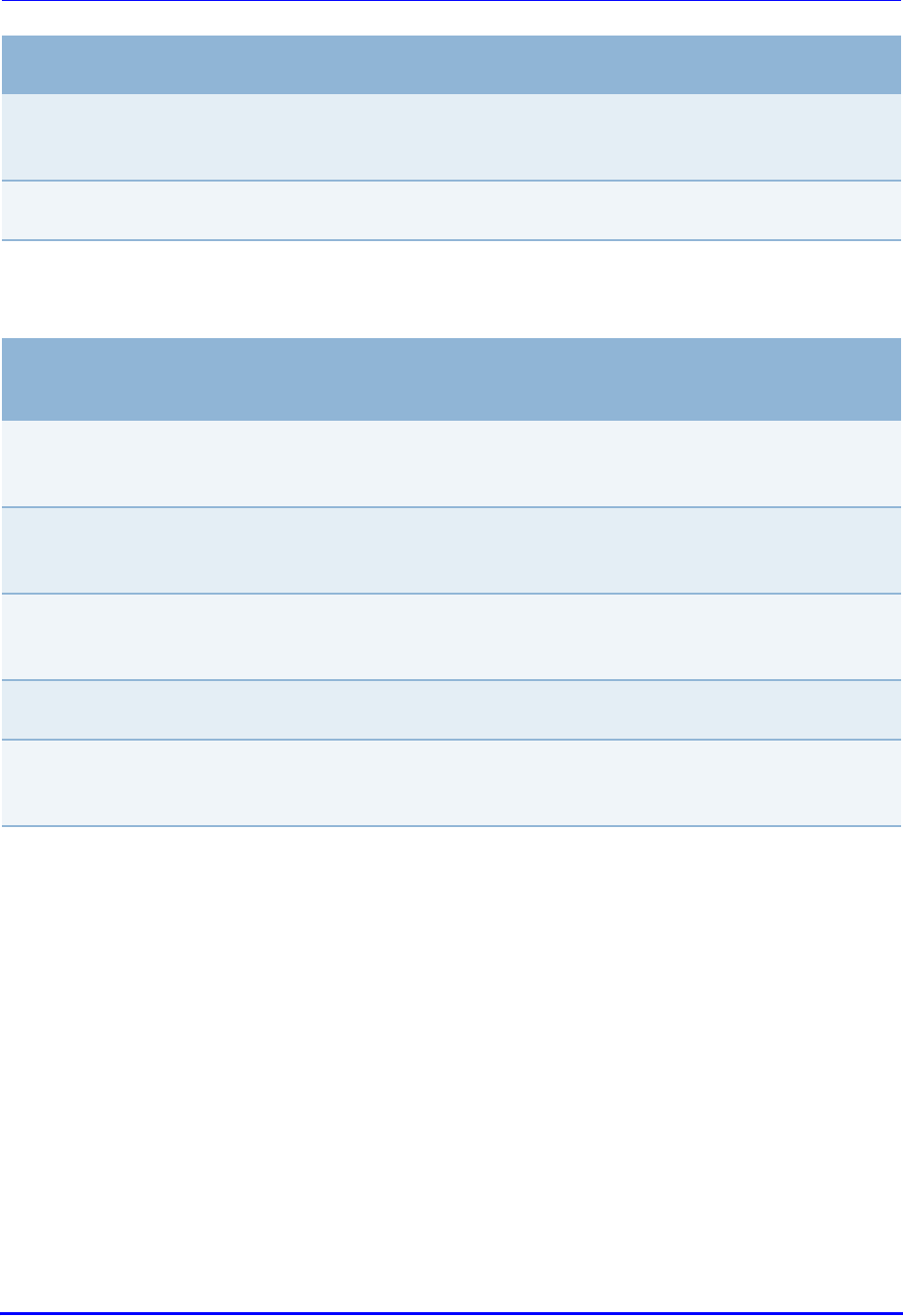
Brooks Automation
146 278580 Revision A
8 Service and Troubleshooting LF80C ZeniD RFID Reader
8.4 Error Codes Product Manual
8.4.3 Stream Function
disturbing field at
transmitting
frequency
check antenna surroundings for
possible disturbing sources
(monitors, servo motors, ...)
antenna is damaged
or too close to metal
exchange antenna, verify
antenna installation
SSAC
KName Description Possible cause Correcting action
Stream
Functio
n
Description Possible cause Correcting action
S9F1 unrecognized DeviceID
message with wrong Devi-
ceID was sent to the
reader
send a message with the correct
DeviceID (can be taken from the
S9F1 message)
S9F3 unrecognized stream type
message with a unknown
stream type was sent to
the reader
check stream function syntax of
the message
S9F5 unrecognized function type
message with a unknown
function type was sent to
the reader
check stream function syntax of
the message
S9F7 illegal data wrong RIC at reset mes-
sage
check RIC value
S9F9 Transaction Timer Timeout
host system does not
acknowledge the mes-
sage or sends no answer

Brooks Automation
278580 Revision A 147
LF80C ZeniD RFID Reader 8 Service and Troubleshooting
Product Manual 8.5 Error Display with LED
8.5 Error Display with LED
8.5.1 Power LED Does Not Light Up
8.5.2 Error LED Lights Up (in Test Mode)
ÂCheck the power supply and the connection cables!
ÂRemove the housing lid as described in
Î
Housing Without
Mounts, and check if the power LED inside the reader is lit up
(see
Î
Indicating and Operating Elements)!
ÂIf the LED does not light up, disconnect the device from the
power supply and carefully remove the fuse (see
Î
Inside
View). Test the fuse. If it is defective, replace it with a fuse
specified by the manufacturer!
ÂIf the above measures do not solve the problem, leave the
reader disconnected and contact the manufacturer!
ÂPress the tuning button.
ÂIf the OK LED does not light up, the transponder is not within
the reading/writing range of the antenna. Install the antenna
closer to the transponder (see individual antenna ranges:
www.brooks-rfid.com). If this does not solve the problem,
contact the manufacturer!
If the tuning LED flashes:
ÂCheck if the antenna is located too near to a strong metallic
environment. Relocate the antenna with more distance!
ÂPress the Tuning button for antenna tuning.
ÂCheck if the antenna and the antenna cable are connected
correctly. Use another antenna cable if available!
ÂIf these measures do not solve the problem, contact the
manufacturer!

Brooks Automation
148 278580 Revision A
8 Service and Troubleshooting LF80C ZeniD RFID Reader
8.6 Reader Does Not Respond Product Manual
8.6 Reader Does Not Respond
8.7 Reset
8.8 Power Cut
After a power cut, the reader performs a reset with self-test. The self-test
can take up to five seconds. In the first step of these self-tests, all LEDs of
the membrane keyboard light up. In the second step, the reader displays
the key statuses of the membrane keyboard.
If a LED is on, the specified button is active. The input LED signalizes the
ASCII protocol and the output LED signalizes the SECS protocol. If the test
was successful, all LEDs - except for the power LED - go off.
ÂCheck if the interface connection cable is undamaged and
correctly connected to both reader and host!
ÂCheck the status as indicated by the LED!
ÂDownload the test software from the Internet
www.brooks.com
→
Service
→
Download. Follow the
instructions!
ÂIf these measures do not solve the problem, contact the
manufacturer!
ÂIn the case of a malfunction, a hardware reset can be
performed by switching the power supply off and on!
ÂAfter the reset, the reader performs a self-test. The self-test
can take up to five seconds. As the first step in these self-
tests, all LEDs of the membrane keyboard light up. At the
second step, the reader displays the key statuses of the
membrane keyboard. If a LED is on, the specified button is
active. The input LED signalizes the ASCII protocol and the
output LED signalizes the SECS protocol. If the test was
successful, all LEDs - except for the power LED - go off.
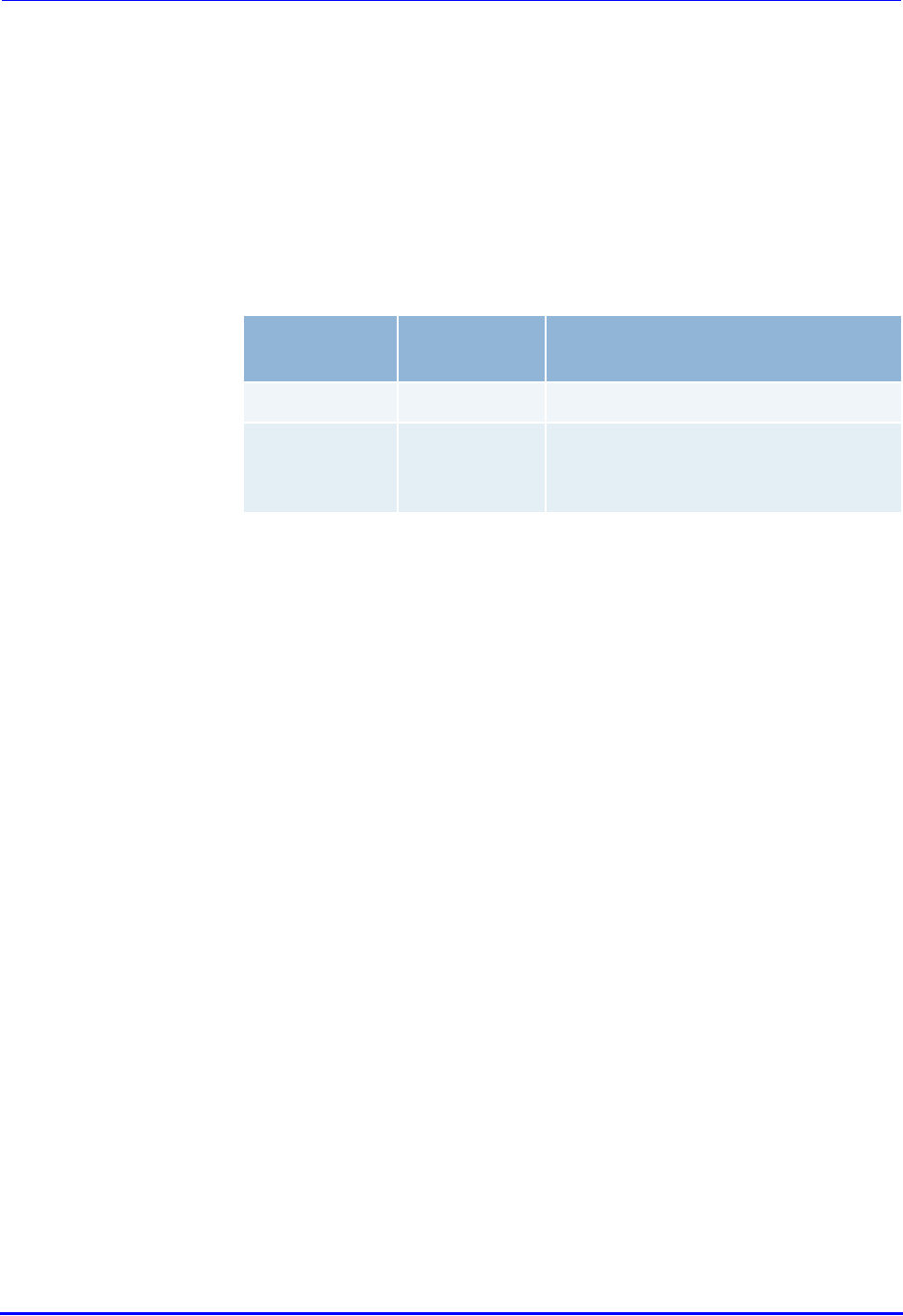
Brooks Automation
278580 Revision A 149
LF80C ZeniD RFID Reader 8 Service and Troubleshooting
Product Manual 8.9 Protocol Switching
8.9 Protocol Switching
It is possible to change the type of protocol on a power-up reset. If the read
and the write buttons are pressed at the time of power-up reset, the reader
changes the protocol type from SECS to ASCII or ASCII to SECS. Wait until
the Input or Output LED does not change and light up. Release the buttons
to start the reader with the new protocol type.
8.10 Software Releases
8.11 Customer Service
For Technical Support:
Location GUTS® Contact Number
North America +1-800-FOR-GUTS (1-800-367-4887)
+1-978-262-2900
Europe +49-1804-CALL-GUTS (+49-1804-2255-4887)
Japan +81-45-477-5980
China +86-21-5131-7066
Taiwan +886-3-5525225
Korea +82-31-288-2500
Singapore +65-6464-1481
Visit us online: www.brooks.com
Release
Date Version Description
June 2011 RIV5.0 Basic version
March 2013 RIV5.1.3/
RS2V51
Hardware version up to 25
characters, factory settings by serial
UDP message

Brooks Automation
150 278580 Revision A
8 Service and Troubleshooting LF80C ZeniD RFID Reader
8.11 Customer Service Product Manual
This page intentionally left blank

Brooks Automation
278580 Revision A 151
LF80C ZeniD RFID Reader 9 Dismantling and Storage
Product Manual 9.1 Dismantling
9 Dismantling and Storage
This chapter gives you an overview of the following topics:
Î
Dismantling
Î
Storage
9.1 Dismantling
9.2 Storage
Store the reader and its components in a clean and dry environment with
the power supply disconnected.
Make sure the contacts remain clean. Observe the necessary storage
conditions.
ÂRemove the power supply device!
ÂRemove all cables!
ÂLoosen and remove the mounting screws!
ÂRemove the device from the installation area!

Brooks Automation
152 278580 Revision A
9 Dismantling and Storage LF80C ZeniD RFID Reader
9.2 Storage Product Manual
This page intentionally left blank
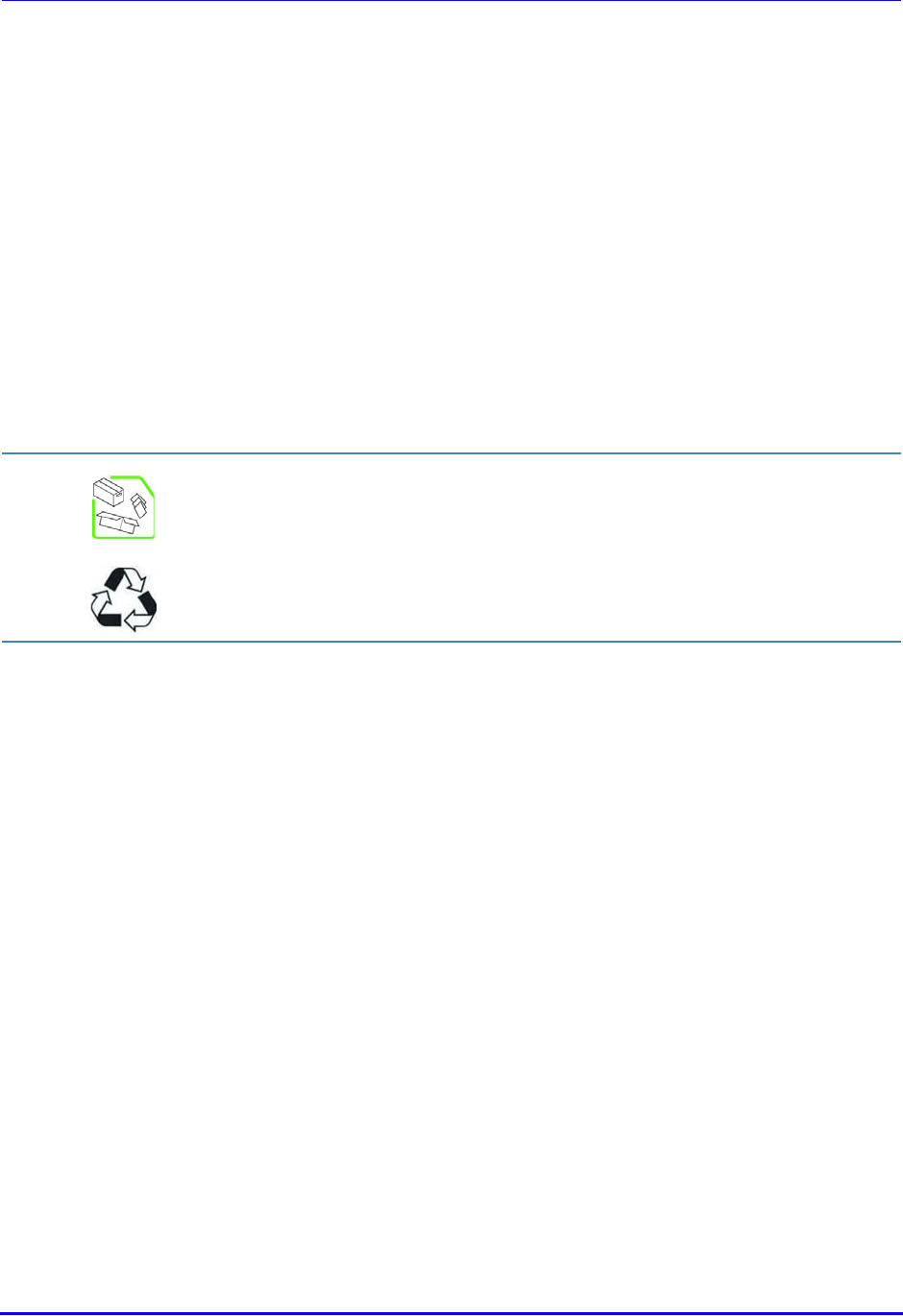
Brooks Automation
278580 Revision A 153
LF80C ZeniD RFID Reader 10 Transport and Disposal
Product Manual 10.1 Transport
10 Transport and Disposal
This chapter gives you an overview of the following topics:
Î
Transport
Î
Disposal
10.1 Transport
For transportation purposes such as mailing, use a firm cardboard box. Use
adequate padding material to protect the device on all sides.
10.2 Disposal
Disconnect the electronic components from the case and dispose of them as
follows:
the case as plastic trash
the electronic components, antennas and cables as electronic
waste
The device and its components are made of various materials.
Dispose of these materials separately, and observing the legal
regulations of your country.
Do not dispose of the device in regular household waste.

Brooks Automation
154 278580 Revision A
10 Transport and Disposal LF80C ZeniD RFID Reader
10.2 Disposal Product Manual
This page intentionally left blank
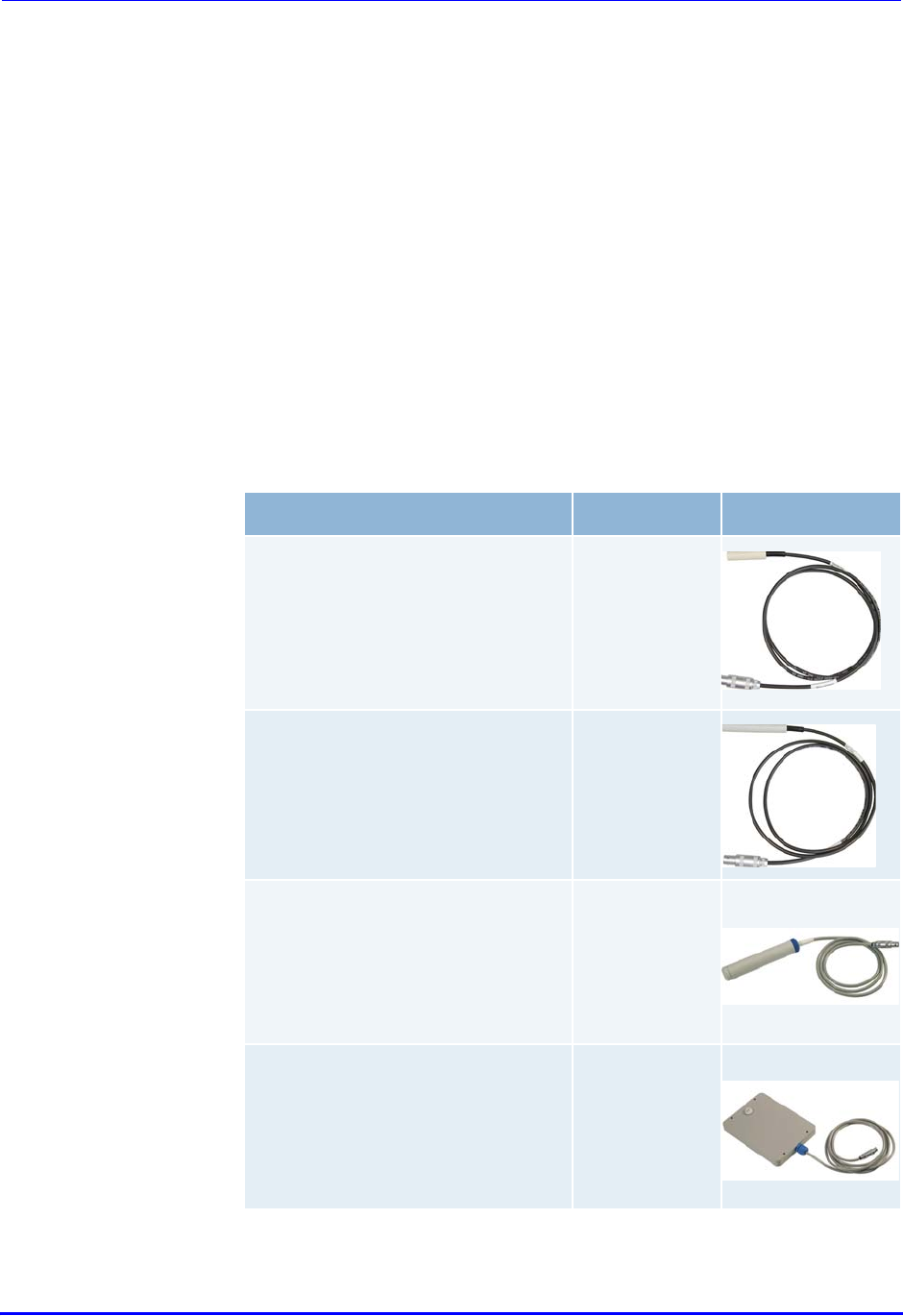
Brooks Automation
278580 Revision A 155
LF80C ZeniD RFID Reader 11 Accessories
Product Manual 11.1 Antennas
11 Accessories
This chapter gives you an overview of the following topics:
Î
Antennas
Î
Plugs
Î
Cables
Î
Mounting Brackets
Î
Mounting Brackets
11.1 Antennas
11.1.1 Available Types
xx = cable length
Type Part-No. Picture
Micro antenna (ANT-1Mxx) ANT-1Mxx
Mini antenna (ANT-1Kxx) ANT-1Kxx
Rod antenna (ANT-1Sxx) ANT-1Sxx
Frame antenna (ANT-1Rxx) ANT-1Rxx
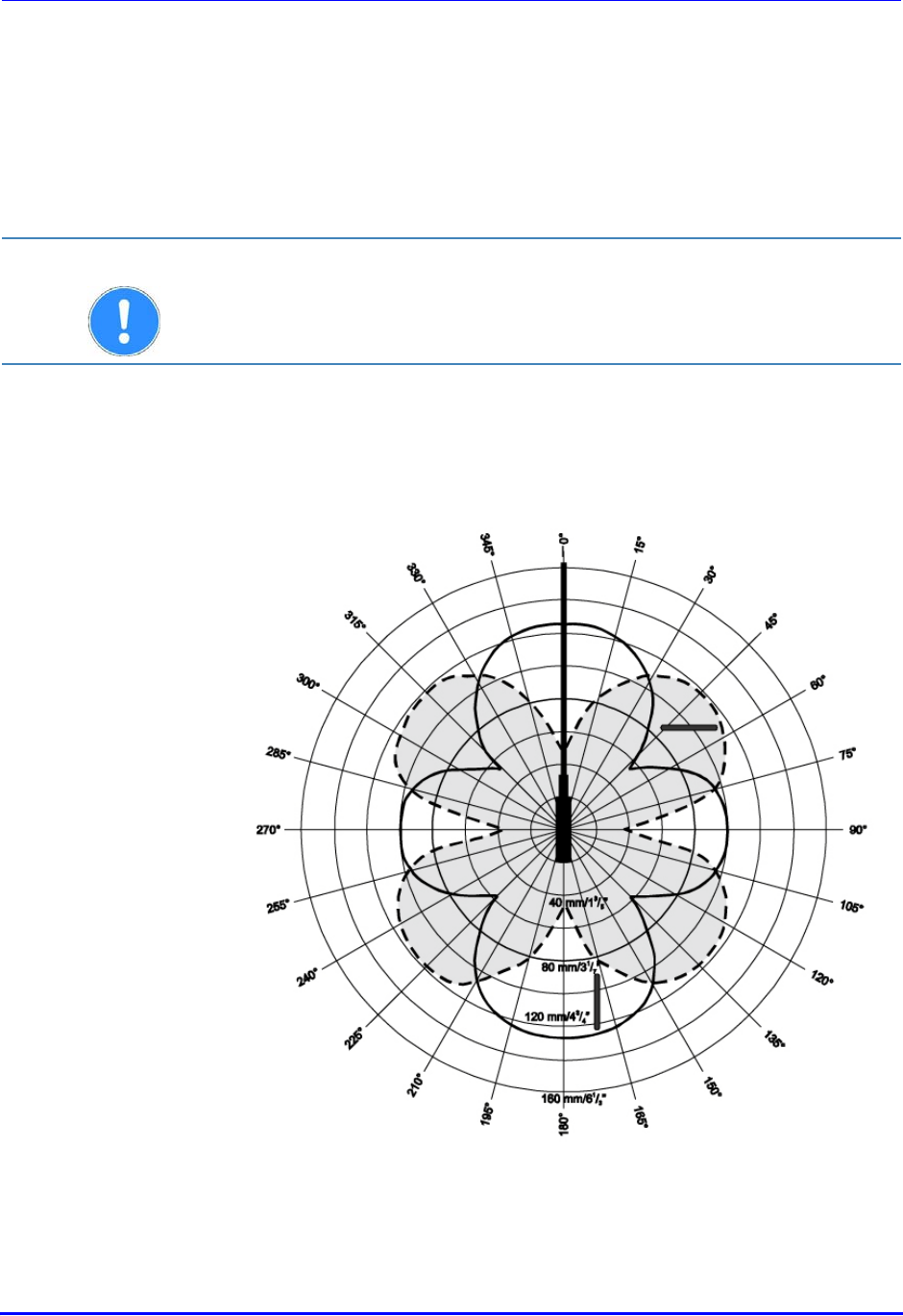
Brooks Automation
156 278580 Revision A
11 Accessories LF80C ZeniD RFID Reader
11.1 Antennas Product Manual
03 → 300 mm
05 → 500 mm
10 → 1,000 mm
15 → 1,500 mm
11.1.2 Reading and Writing Ranges
The following reading/writing ranges are measured with a 32 mm glass
transponder (read only, read/write, multipage). If you use a multipage
transponder, the diagrams are only valid for page 1 of the multipage
transponder.
Reading range micro
antenna
________ Transponder parallel to antenna
- - - - - - - Transponder vertical to antenna
ATTENTION If the transponder is very close to the antenna the transponder may be
de-tuned by the metal of the antenna and reading/writing is not
possible. We recommend keeping a minimum distance between
transponder and antenna of about 10 mm.
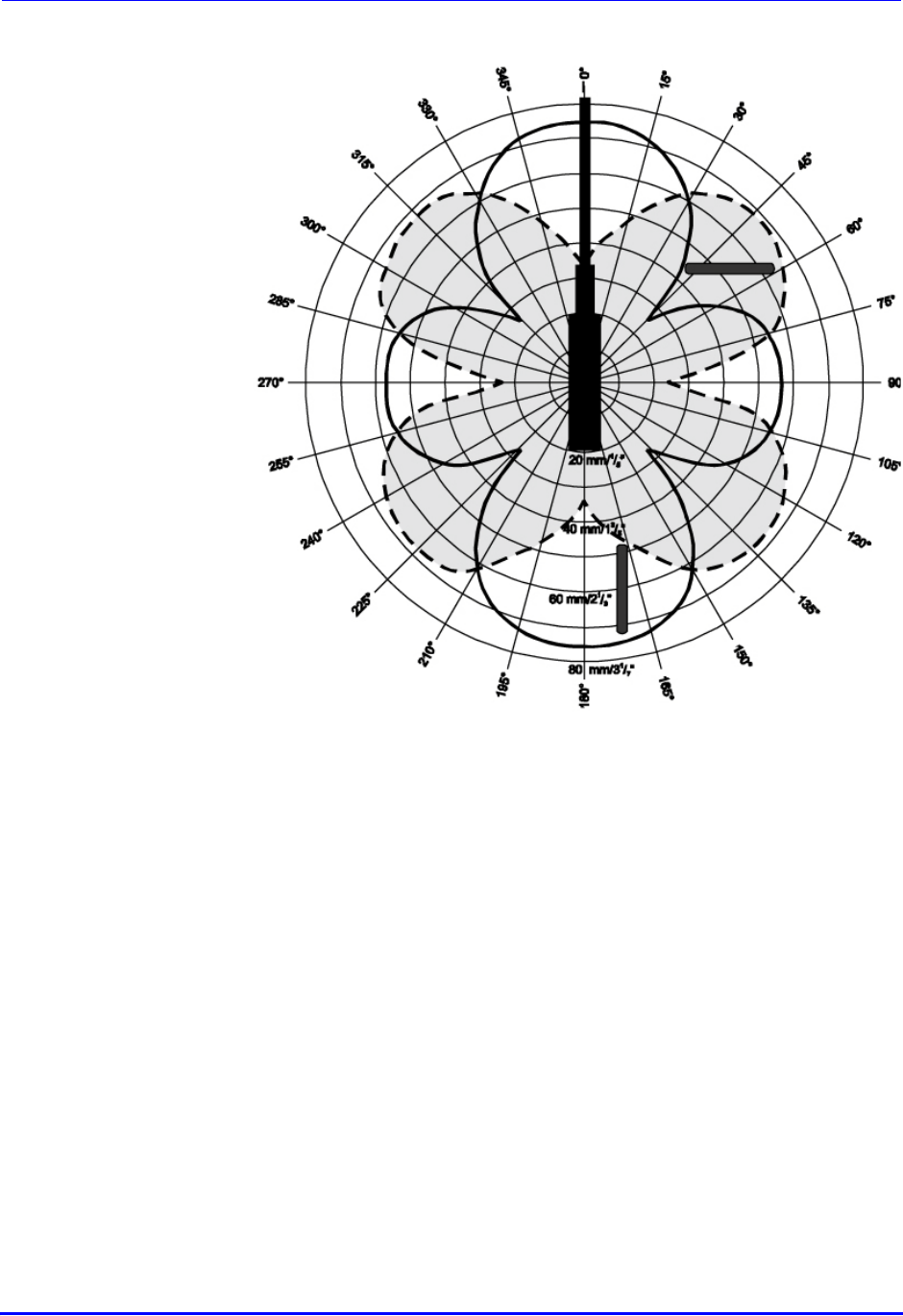
Brooks Automation
278580 Revision A 157
LF80C ZeniD RFID Reader 11 Accessories
Product Manual 11.1 Antennas
Writing range micro
antenna
________ Transponder parallel to antenna
- - - - - - - Transponder vertical to antenna
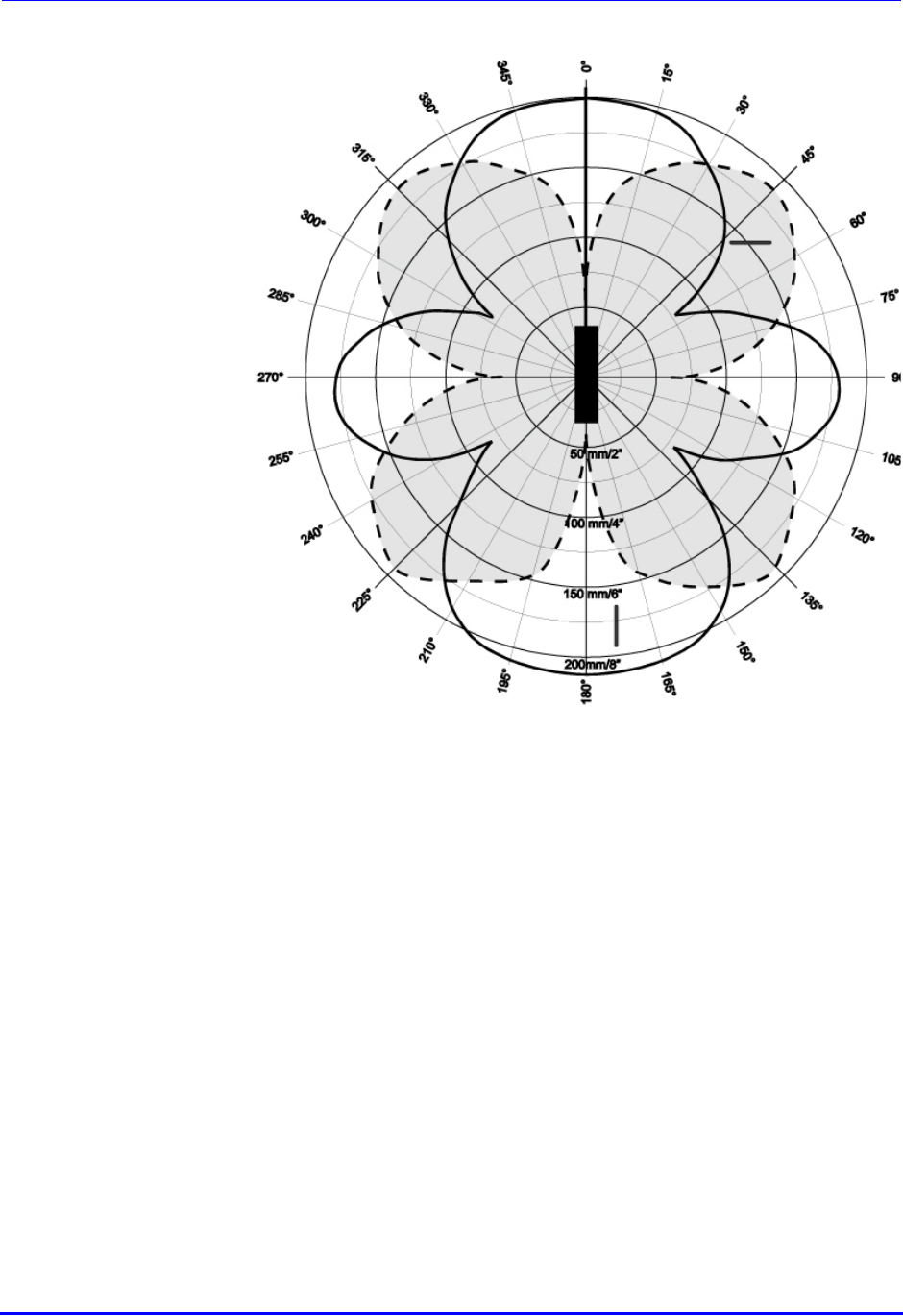
Brooks Automation
158 278580 Revision A
11 Accessories LF80C ZeniD RFID Reader
11.1 Antennas Product Manual
Reading range mini
antenna
________ Transponder parallel to antenna
- - - - - - - Transponder vertical to antenna
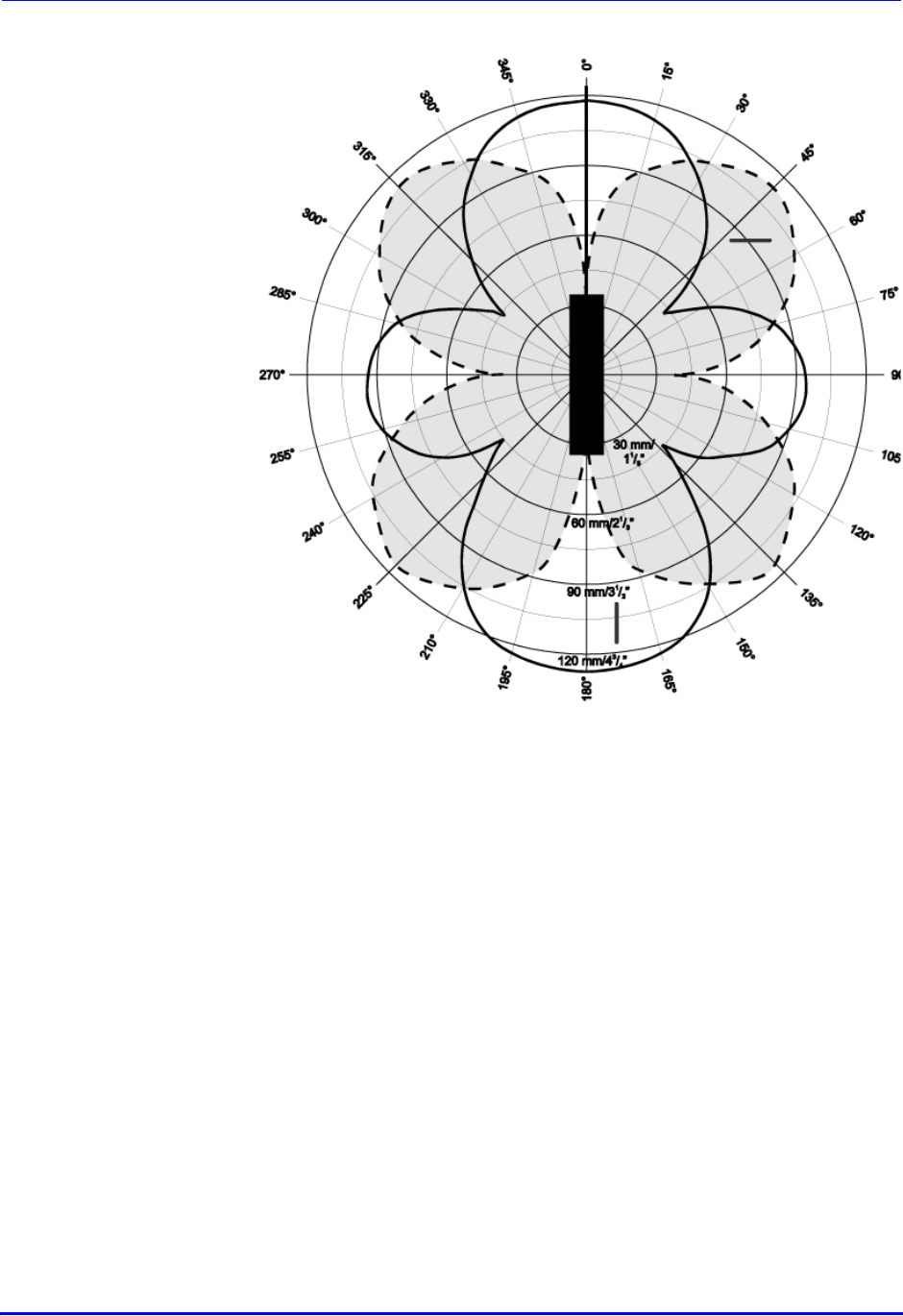
Brooks Automation
278580 Revision A 159
LF80C ZeniD RFID Reader 11 Accessories
Product Manual 11.1 Antennas
Writing range mini
antenna
________ Transponder parallel to antenna
- - - - - - - Transponder vertical to antenna
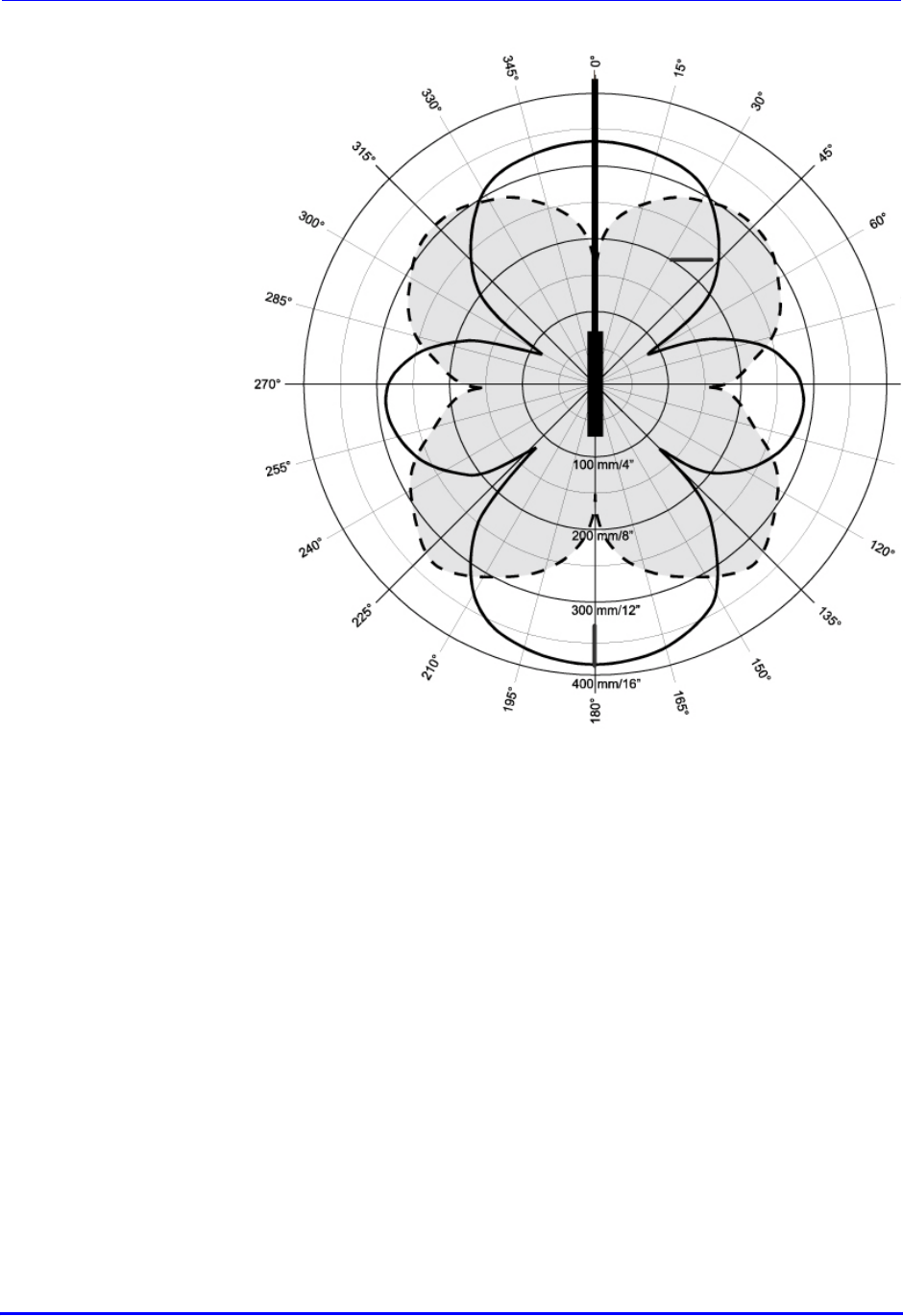
Brooks Automation
160 278580 Revision A
11 Accessories LF80C ZeniD RFID Reader
11.1 Antennas Product Manual
Reading range rod
antenna
________ Transponder parallel to antenna
- - - - - - - Transponder vertical to antenna
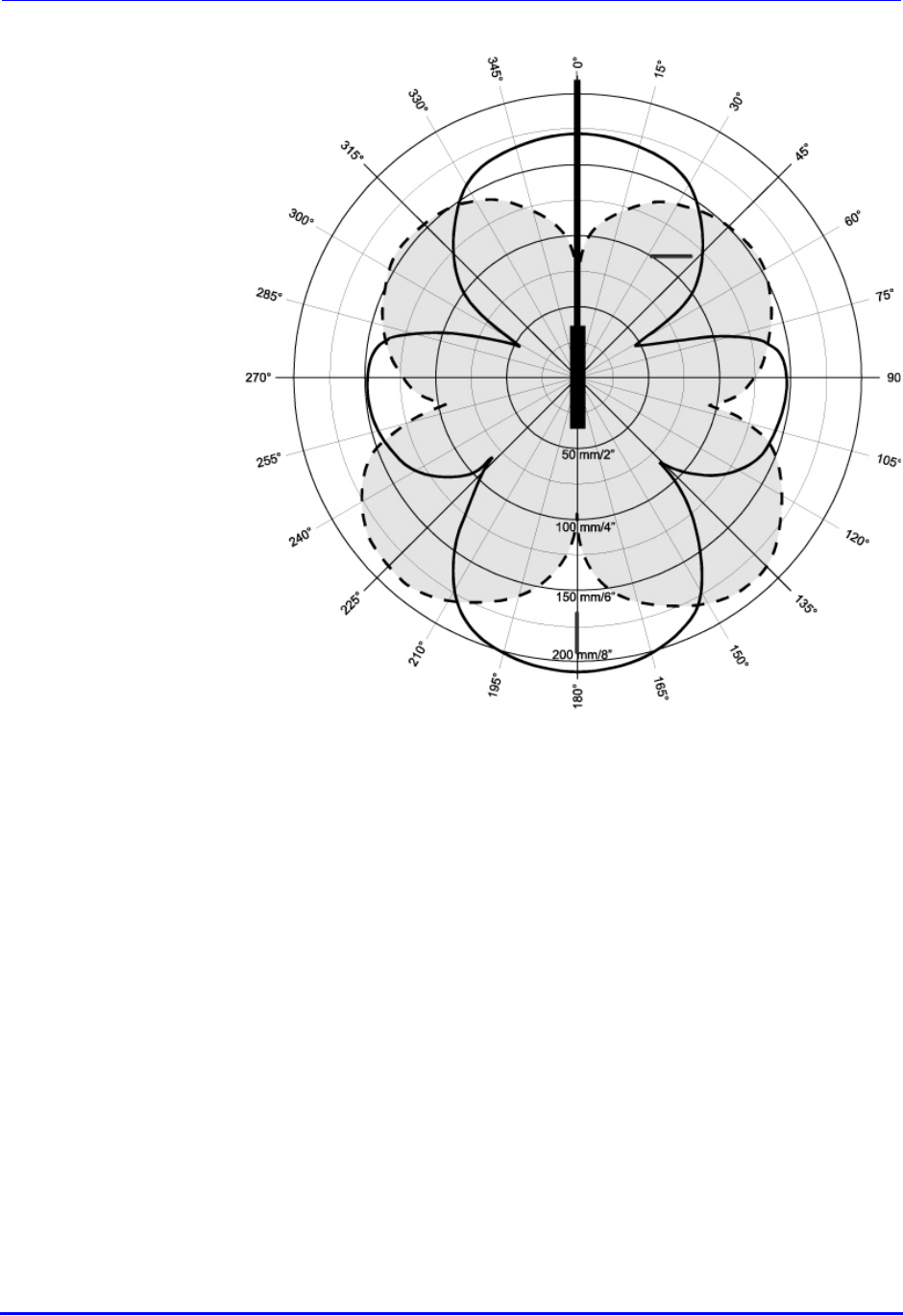
Brooks Automation
278580 Revision A 161
LF80C ZeniD RFID Reader 11 Accessories
Product Manual 11.1 Antennas
Writing range rod
antenna
________ Transponder parallel to antenna
- - - - - - - Transponder vertical to antenna
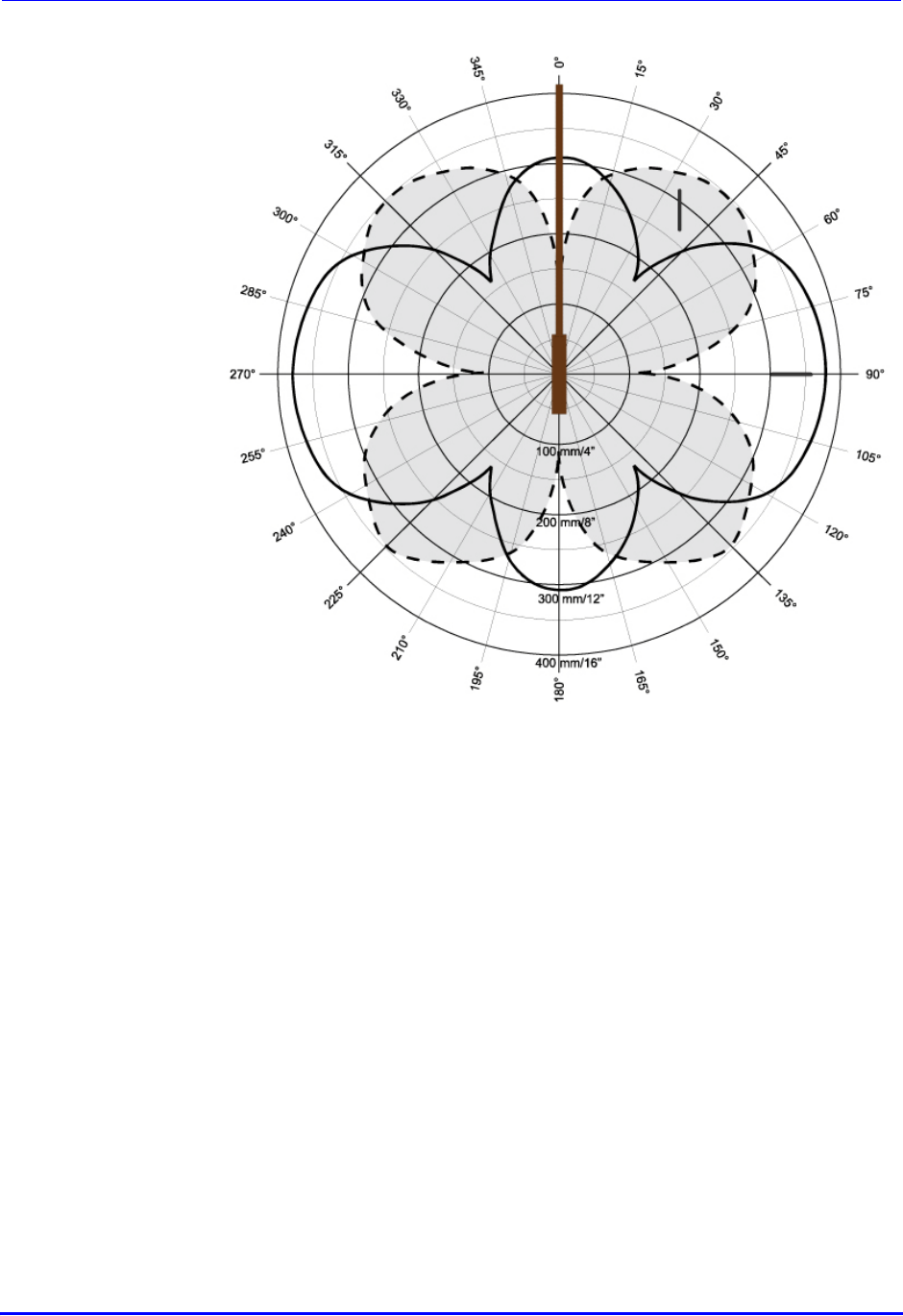
Brooks Automation
162 278580 Revision A
11 Accessories LF80C ZeniD RFID Reader
11.1 Antennas Product Manual
Reading range frame
antenna
________ Transponder parallel to antenna
- - - - - - - Transponder vertical to antenna
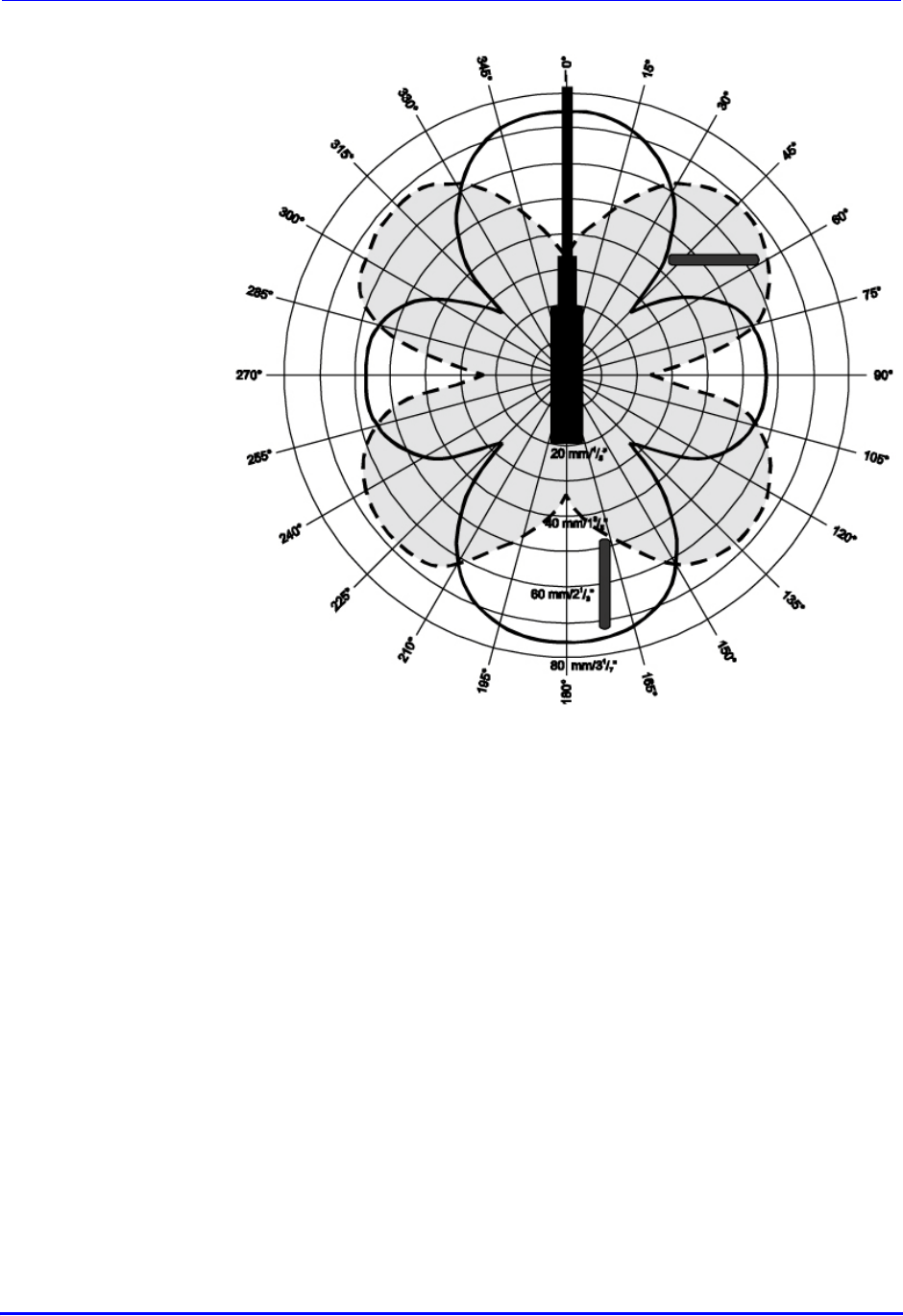
Brooks Automation
278580 Revision A 163
LF80C ZeniD RFID Reader 11 Accessories
Product Manual 11.1 Antennas
Writing range frame
antenna
________ Transponder parallel to antenna
- - - - - - - Transponder vertical to antenna
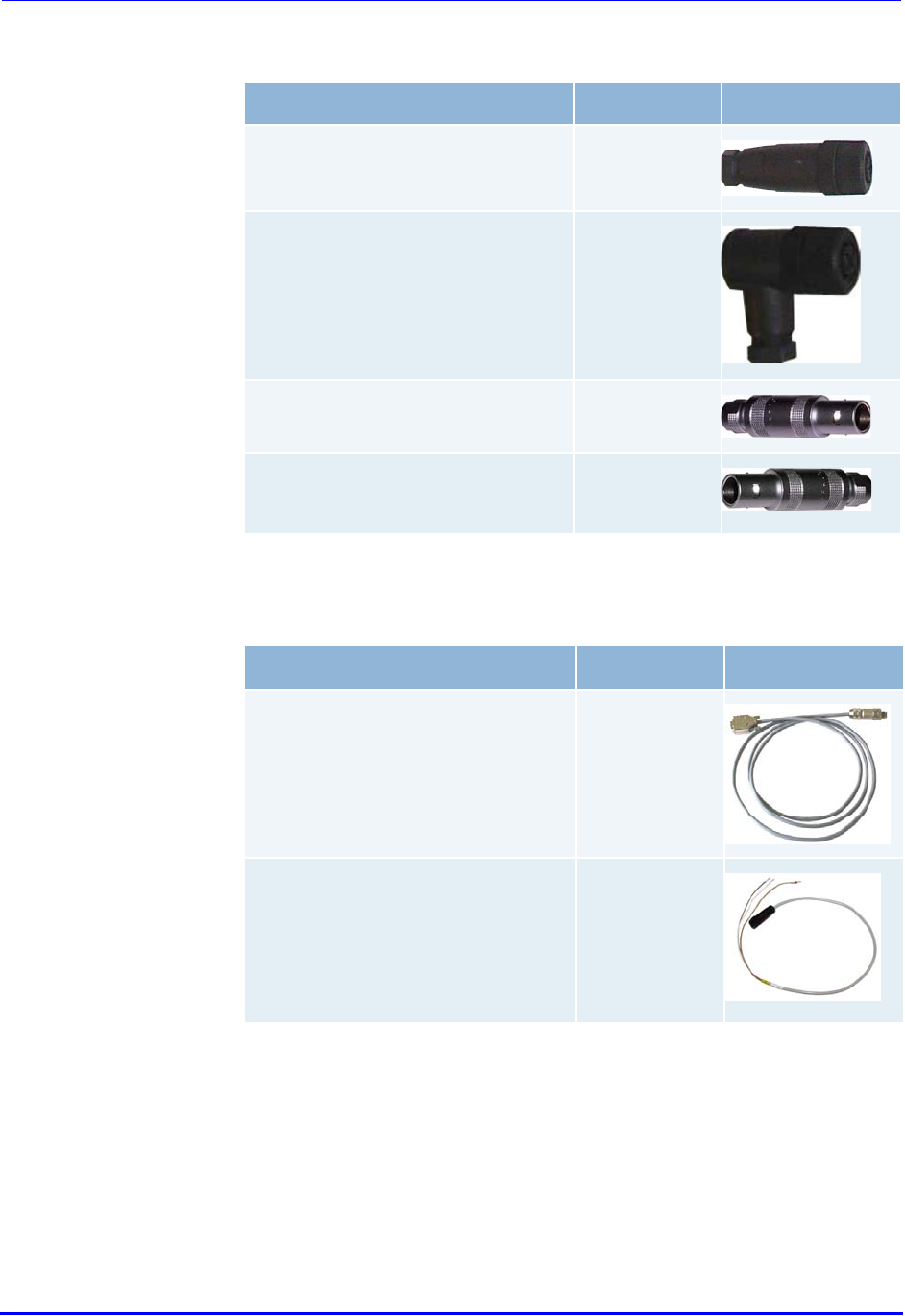
Brooks Automation
164 278580 Revision A
11 Accessories LF80C ZeniD RFID Reader
11.2 Plugs Product Manual
11.2 Plugs
11.3 Cables
Type Part No. Picture
Female power plug, straight KBV-GK
Female power plug, angled KBV-WK
Cable plug, ext. sensor, metal KS-SENS1
Cable plug, ext. output, metal KS-LED1
Type Part No. Picture
RS 232 serial communication cable
RSK9-10 = 1,000 mm
RSK9-20 = 2,000 mm
RSK9-60 = 6,000 mm
RSK9-10
RSK9-20
RSK9-60
Power supply cable
KBV24-05 = 500 mm
KBV24-10 = 1,000 mm
KBV24-20 = 2,000 mm
KBV24-30 = 3,000 mm
KBV24-60 = 6,000 mm
KBV24-05
KBV24-10
KBV24-20
KBV24-30
KBV24-60

Brooks Automation
278580 Revision A 165
LF80C ZeniD RFID Reader 11 Accessories
Product Manual 11.4 Mounting Brackets
11.4 Mounting Brackets
Type Part No. Picture
Mounting set for standard housing RMS-01

Brooks Automation
166 278580 Revision A
11 Accessories LF80C ZeniD RFID Reader
11.4 Mounting Brackets Product Manual
This page intentionally left blank

Brooks Automation
278580 Revision A I
LF80C ZeniD RFID Reader
Product Manual
Index
A
A - Sensor event 58
ACKC3 78
ACKC5 78
ALARM STATUS 79
ALCD 79
ALID 79
ALTRID 81
ALTX 80
Antenna 33
Antenna cable 22
ATTRVAL 82
Automatic tuning 56
C
Carrier ID 104
CE conformity 4
Checksum 62, 66
CIDRW 105
Commissioning 40
CPVAL 83
D
DATA 83
DATALENGTH 83
DATASEG 84
DC power 36
Detuned 32
Device ID 65
DHCP-Server 38
Dimensions 28
E
E - Error message 53
EAC 84
ECID 84
ECV 84, 85
EIA RS-232-C 64
Electronic Industries Association Standards 64
Error message 47
Ethernet 38
External sensor 19
F
FCC Rules 3
Floating contact 39
Frame antenna 22, 35
G
G - Request parameter value 50
H
H - Heartbeat 53
High byte 42
Housing without mounts 30
HSMS message format 71
HSMS message format summary 73
Humidity 25
I
IP address 38
J
J - Request tuning 57
L
L - Lock a page of the transponder 55
Low byte 42
M
MDLN 85
Message 41
Message block structure 64
Message set 76
MF 85
MHEAD 85
Micro antenna 22, 35
MID 86
MIDAC 86
MIDRA 86
Mini antenna 22, 34
N
N - Reset 59
No tag 47
NOTAG 48
O
OFLACK 86
ONLACK 86
P
P - Set parameter 51
PAGEDATA 87
PAGE_ID 87
Parameter 45
Parameter 0 - Gateway ID 93
Parameter 0 - Sensor delay 60
Parameter 1 - Baudrate 94
Parameter 1 - Read mode 60
Parameter 11 - ReaderID 96
Parameter 12 - HeadID 96

Brooks Automation
II 278580 Revision A
LF80C ZeniD RFID Reader
Product Manual
Parameter 2 - Inter-character timeout T1 94
Parameter 2 - Read page 60
Parameter 20 - Sensor delay for presence sensor
96
Parameter 22 - Sensor-triggered action for
presence sensor 96
Parameter 23 - Triggered read frequency 96
Parameter 24 - r/w max repeat 96
Parameter 25 - Transponder type 97
Parameter 26 - Sensor activity 97
Parameter 27 - Watchport for presence sensor 97
Parameter 28 - Transmitter level (read mode) 97
Parameter 29 - Transponder load duration (read
mode) 98
Parameter 3 - Block protocol timeout T2 94
Parameter 3 - r/w repeat time 60
Parameter 30 - Read/write synchronization 98
Parameter 31 - Auto-adjust value (read mode) 98
Parameter 32 - Auto-adjust value (write mode) 98
Parameter 33 - Automatic environment
adjustment 99
Parameter 34 - Sensor type for presence sensor
99
Parameter 35 - Special features 99
Parameter 36, Lock membrane keyword 99
Parameter 37, MID area 100
Parameter 38, Test after software reset 100
Parameter 39, Transmitter level (write mode) 100
Parameter 4 - r/w max repeat 61
Parameter 4 - Reply timeout T3 94
Parameter 40, Transponder load duration (write
mode) 100
Parameter 41, Delay time between read cycles
101
Parameter 42, CarrierIDOffset 101
Parameter 43, CarrierIDLength 102
Parameter 44, FixedMID 102
Parameter 45, MIDFormat 102
Parameter 5 - Inter-block timeout T4 94
Parameter 5 - RS232 repeat time 61
Parameter 6 - Retry limit RTY 94
Parameter 6 - RS232 max repeat 61
Parameter 7 - TARGETID high byte 95
Parameter 7 - Watchport 61
Parameter 8 - TARGETID low byte 95
Parameter 9 - Heartbeat time 95
Parameter 99, Customer code 103
Parameter F - Reader address 62
PM Information 88
Power supply 21, 36
Prohibition symbols 9
PTN 88
R
R - Automatic read 49
RAC 88
Relative humidity 25
RIC 89
Rod antenna 22, 34
S
Safety Instructions 7
Safety symbols 8
SECS-I 63
SECS-I message examples 121
SECS-II 63, 74
SEMI E4 67
SEMI Equipment Communication Standard 63, 74
SHEAD 89
SOFTREV 89
SSACK 90
SSCMD 90
Standard housing 29
STATUS 91
Sub-D female plug 37
T
TARGETID 91
Temperature 25
Test mode 19
Tuning 18, 56
V
V - Query software version 54
W
W - Write data 48
Warning symbols 9
Warranty 5
X
X - Read data 47